

Classic EBC Trek
- EBC + Gokyo Trek
- Jiri to EBC
- 3 Passes Trek to EBC
- Island Peak and EBC
- Acclimatisation
- Packing List
Get a Trek Quote
Three passes trek to everest base camp .
This guide covers the clockwise variation of the Three Passes Trek circuit by providing a detailed itinerary, route maps as well as answering questions on cost, packing, best times to trek and more.
The Three Passes Trek to Everest Base Camp is arguably the most complete trek in Nepal as it covers most of the Everest region on its circular route. The trek is more challenging than the classic Everest Base Camp Trek and its other variations as it involves traversing the three high passes that lend the trek its name – Renjo La, Cho La and Kongma La – each over 5,000m.
The trek begins in the popular starting point of Lukla before heading north along the classic trek to Namche Bazaar. Here, the route veers west as it splits from the main trek and heads up the Dudh Koshi valley, where you will encounter the first of the Three Passes – Renjo La (5,370m). After reaching the high point, the trail descends to the idyllic Gokyo Lakes and further on to the village of Gokyo .
The route then turns east as you make your way to Everest Base Camp by crossing the second pass called Cho La Pass (5,420m). After the second pass you will have the opportunity to explore the intricacies of Everest Base Camp life as well as soaking up some of the best views of Everest and the surrounding peaks when you climb the iconic viewpoint of Kala Patthar .
The inwards leg of the trek involves traversing the final of the Three Passes – Kongma La Pass (5,545m) – to join up with the classic Everest Base Camp Trek route that will take you down to Lukla, where the trek ends.
We do not sell tours, we simply provide impartial advice . If you would like an exact quote from our recommended tour operator click Get a Quote.
[adinserter block="2"]
Three Passes Trek
Regional map.
The Three Passes Trek is situated in the Everest or Khumbu region of Nepal as indicated by the orange block on the map below. Your journey will begin with a flight into the international airport in Kathmandu, the capital city, followed by a domestic flight to Lukla where the actual trekking begins.

Instead of flying to Lukla – an experience itself – you can trek the Jiri to Everest Base Camp variation . This involves taking a bus from Kathmandu to Jiri where you trek through the Solu Khumbu Valley up to Lukla before re-joining the main trek. This variation can be used for any trek that starts in Lukla, but will add at least 6 days onto the trek.
[adinserter block="3"]
Trekking Map
This simplified map below shows the Three Passes Circuit and the major towns and villages it goes through. Both the clockwise and anticlockwise variations of the trek start with the 2-day trek to Namche Bazaar where you will spend a day exploring to acclimatise to the high altitude .
The clockwise variation, detailed in this guide, follows the route north-west through the Dudh Koshi valley and the village of Thame before reaching the first pass – Renjo La. You will pass through Gokyo as you move east towards the second pass of Cho La, which takes you to the town of Lobuche. From Lobuche you will trek north to Gorak Shep – your base while you visit Everest Base Camp and Kala Patthar viewpoint.
The trek back to Lukla crosses the third and final pass of Kongma La, reaching Chhukung before joining up with the classic route back to Lukla. The last few days of the trek involve the relatively easy descent back to Lukla where your flight will be waiting to take you back to Kathmandu.
[adinserter block="4"]
Recommended Guidebooks
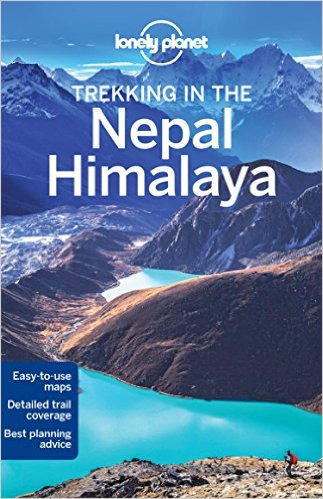
The Three Passes Trek is quite challenging as it involves traversing very high passes over 19 days of trekking. For this reason, we do not recommend trekking solo or without a guide who will have extensive knowledge and experience of trekking in the region.
A good guide book with a map, however, can be very useful when wanting to learn more about the area or when searching activities to do on your rest or acclimatization days.
The Lonely Planet Trekking in Nepal Himalaya guide is a regularly updated and informative guide that will include maps and sightseeing opportunities for a variety of treks in the region.
In terms of a map we recommend Nepa Maps – Three Passes and Everest Region map.
Detailed Itinerary
As with all treks, your journey to trek the Three Passes will start with an international flight into Kathmandu. A short flight to Lukla will precede the start of the trek that takes you through the Dudh Koshi valley before looping around through Gokyo and heading to Everest Base Camp. The inwards leg will take you east over your final pass and back to Lukla.
Most tour operators will list the Three Passes Trek as an 18/19-day trek. Of these days, usually 15 will be spent trekking with a further 1 or 2 acclimatization days, meaning 14 days of actual trekking can be expected.
Day 1: Arrive in Kathmandu
Arrive in the capital of Kathmandu after what is sure to be a long flight from home. Make your way to the hotel where you can relax for a bit before setting out to explore some of the vibrant city.
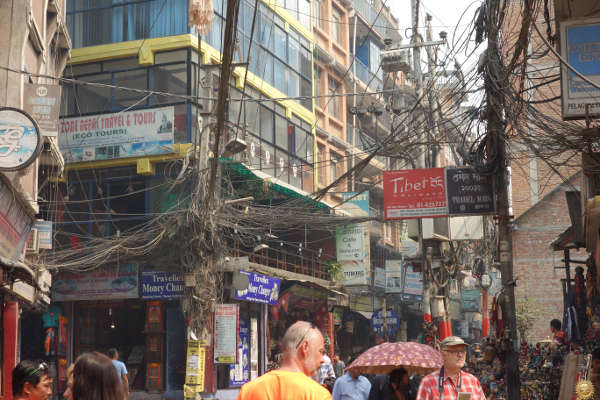
Vibrant streets of Thamel, Kathmandu
Day 2: Fly from Kathmandu to Lukla. Trek to Pkadking
An early morning flight will take you to Lukla, the starting point of the trek. Despite being only 35 minutes, the flight is a memorable one! Try to sit on the right-hand side of the plane for the best views of Everest as you approach Lukla.
The trek starts with fairly short descent to Phadking, where you will pass stone walls decorated with prayer inscriptions – called Mani in the local language. You will spend the night in Phadking.
Day 3: Trek to Namche Bazaar
The trek to Namche Bazaar will see you enter the Sagarmatha National Park , a UNESCO World Heritage Site. The village of Namche Bazaar is the central trading post of the region and is always bustling with life.
Day 4: Acclimatisation Day
Day 4 is an acclimatisation day spent in Namche Bazaar. Explore the village, stock up on some much-needed snacks for the trek ahead and be sure to check out the bakery – one of the best! The market on a Saturday is also a major attraction.
Day 5: Namche to Thame
The trail now splits from the popular base camp route and heads north-west through the small Sherpa village of Thamo before reaching Thame, where you will be staying the night. Take some time to learn a bit about the local traditions and their intrinsic connection with the mountain on which you are standing.
Day 6: Thame to Lumde
4-5 hours of trekking will see you cross the Bhote Koshi river before heading up the valley to Lumde. As you start to gain altitude you should get some great views of the snow-capped peaks in the region.
Day 7: Lumde over Renjo La to Gokyo
Today you will encounter your first of the Three Passes – Renjo La. The route starts off easy but will soon turn into a hard day of hiking as you near the end of the ascent of Renjo La. Try to think of the magnificent views you will get at the top to motivate you!
After the pass, you will descend to the third of the Gokyo Lakes and then trek onto the village of Gokyo for the night. After some rest you can even climb up the ridge to get some amazing views of the lakes, the highest freshwater lake system in the world.
[adinserter block="5"]
Day 8: Gokyo Ri (Acclimatisation Day)
Today you climb your first peak Gokyo Ri for fabulous views of Cho Oyu. You will do this climb early and then have the rest of the day to rest.
Day 9: Gokyo to Thaknak
Cross the Ngozumpa Glacier – the largest glacier in Nepal – over the course of an easy day’s trekking. Once again, keep your camera close as you trek through this beautiful part of Nepal!
You will reach Thaknak where you will go on a small acclimatization hike before lodging for the night.
Day 10: Over Cho La to Zungla
Often considered the hardest day of the trek, today involves traversing the second pass of Cho La. At over 5,300m, reaching the top will require some effort.
You will spot the famous prayer flags as you near the top of the pass, after which you descend over the other side of the pass to reach Zungla.
Day 11: Zungla to Gorak Shep
Start the day with an easy downhill portion to reach Lobuche, one of the major stops on the classic Everest Base Camp Trek. Join up with the crowds of trekkers as you make your way to Gorak Shep.
You will be afforded great views of the famous Khumbu Glacier as well as the peaks of Everest, Lhotse and Nuptse. Spend the night in the busy Gorak Shep.
Day 12: Gorak Shep to EBC and back
A short trek following the ridge of the Khumbu Glacier will take you to the Everest Base Camp. Make the most of your time here, as trekking groups are not typically allowed to stay overnight at the base camp.
Feel the buzz and excitement of the place, packed with potential future summiteers of Everest! Descend later that day down the same ridge back to Gorak Shep for some much-earned rest and sleep.
Day 13: Kala Patthar hike and then onto Lobuche
An early morning start is needed to summit the trekking peak of Kala Patthar – the iconic viewpoint of Everest. After snapping some pics, head back to Gorak Shep for a quick meal before descending further to Lobuche for the night.

View of Everest, EBC and Khumbu Glacier from Kala Pattar
Day 14: Kongma La Pass and onto Chukkung
You leave the classic base camp route today as you head east through the Khumbu Glacier to reach the third and final pass of the trip – Kongma La Pass. At 4,700m the pass is the highest of the three and lacks any shops or tea houses along the way.
After a tiring ascent to the top, descend into the Chukkung Valley and eventually to the village of Chukkung where you will stay in the lodge overnight.
Day 15: Chukkung Ri and then to Dingboche
Today you will climb Chukkung Ri (5,550m) and trek to Dingboche (4,410m)This peak is the hardest of the three you can attempt on this treks and involves some easy scrambling near the summit. The views from the top down the Khumbu Valley are superb. You descend to Dingboche where you will stay in a lodge overnight
Day 16: Dingboche to Namche Bazaar
A downhill trekking day will take you through the verdant fields and rhododendron covered hillside on your way to Namche Bazaar. Pass through the village of Khumjung where you can eat lunch before completing the descent to Namche Bazaar where you will stay overnight.
Day 17: Namche to Phakding
You continue through Namche Bazaar, descend Namche Hill and cross the Dudh Koshi. You are now sauntering back along familiar paths to Phakding. Overnight lodge.
Day 18: Phakding to Lukla
The last day of trekking will take you through some lovely pine scented forests before reaching Lukla where a cold drink and a hot meal await you!
Day 19: Fly back from Lukla to Kathmandu
Weather permitting, catch the morning flight back to Kathmandu to end off what is sure to be the trip of a lifetime.
Day 20: Depart Nepal
After your last night in Nepal, make your way to the airport to hop onto your flight back home, where you can tell all your friends and family about the time you had!
Altitude Profile
The altitude chart below shows the typical progression of the Three Passes Hike through the major stopping points along the way. The three spikes of the passes are clearly visible along with the spike of Kala Patthar – the iconic viewpoint.
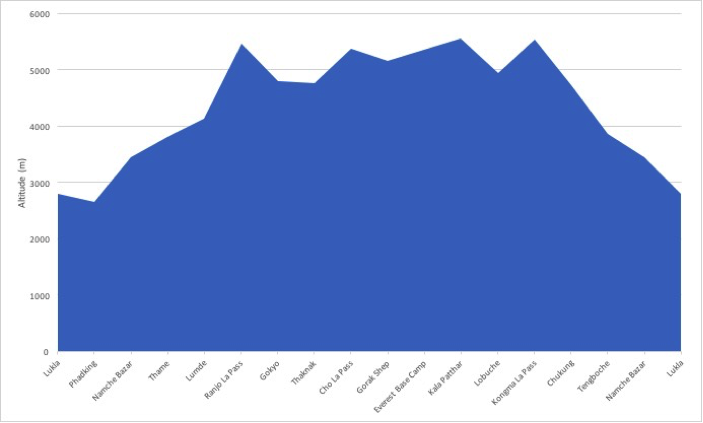
The ascent profile of this trek is slightly harder than the classic Everest Base Camp trek because it involves rapid ascents of the passes.
Three Passes Trek FAQ
How much does the three passes trek cost.
Tour operators will charge in the region of £1,200 to £2,500 for a guided Three Passes Trek. We definitely recommend using a tour operator for a trek of this difficulty and length – preferably a western tour operator whose guides and equipment will be of a higher standard.
The cost will include all board and lodging for the 18 days, all domestic travel and domestic flights, meals, shared equipment and knowledgeable guides. For a detailed breakdown of costs on the classic Everest Base Camp Trek, read our article here .
When is the best time to trek the Three Passes?
As with all treks in the Everest region, it is advisable to avoid the winter months as well as the peak summer months during the monsoon season. The shoulder months of February-May and September-October provide the most stable and dry weather conditions for trekking.
Our detailed article on the best time to trek in the Everest region will give a much more in-depth analysis of the conditions faced in different months.
How difficult is the trek?
The Three Passes Trek is considerably harder than the classic Everest Base Camp Trek so we recommend you have a good fitness level before embarking. Ascending the high passes involves long days of strenuous trekking that would not be encountered on the classic base camp trek and other variations.
6/7 hours of trekking per day is to be expected and altitudes of up to 5,500m are reached on the trek. That being said, the trek is still very popular among people wanting a bit more of a challenge. Read our training article to get an idea of how much you should prepare for a trek in Nepal.
Will I get altitude sickness?
Despite crossing some very high passes, the trek has been designed to follow the principle of trek high, sleep low. That means that you will not be spending extended periods of time at altitudes above 5,000m. The itinerary also has acclimatisation days as well as nights spent at lower altitudes to help the acclimatisation progress. If you follow the guide you should not have a problem.
That being said, altitude sickness can affect anyone regardless of age or level of fitness so we recommend doing some preparation reading. Our detailed article on altitude sickness and acclimatisation is a good starting point.
What gear should I pack for the Three Passes Trek?
The packing list for a trek of this length can look quite long! For this reason, we have dedicated an article to help you tackle the challenge that is packing. In our Everest Base Camp Trek packing list we provide list of clothing and equipment that you should bring, as well as some brands that we recommend based on our experience of using them.
What insurance do I need?
The short answer is yes. Trekking in Nepal at high altitudes comes along with various risks that are not covered by typical travel insurance. We recommend taking out insurance that covers trekking to altitudes up to 6,000m as well as medical evacuation from the mountain.
We have a detailed article to help to find the best policy that will suit your needs. Alternatively, use the quote calculator below from our recommended partner, World Nomads. They offer insurance that covers guided hikes up to 6000m and include a premium for Helicopter Evacuation in Nepal.
Route Variations
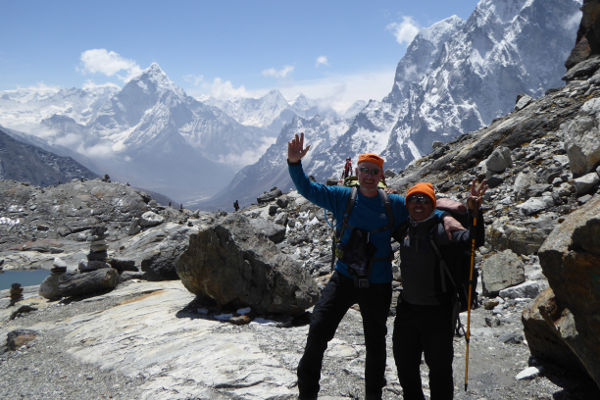
One of the more popular variations of the Everest Base Camp Trek , the Gokyo Lakes Trek, also starts at Lukla and follows the classic base camp trek to Namche Bazar where it forks north-west.
The trek proceeds through the towns of Dole and Machhermo before reaching the stunning Gokyo Lakes. From there you ascend to the peak of Gokyo Ri in the north, before traversing Cho La Pass and re-joining the classic trek at Lobuche.
The detour adds 2/3 days onto the trek but provides the wonderful opportunity to summit a peak while also avoiding some of the busier parts of the trek.
Gokyo Lakes Trek
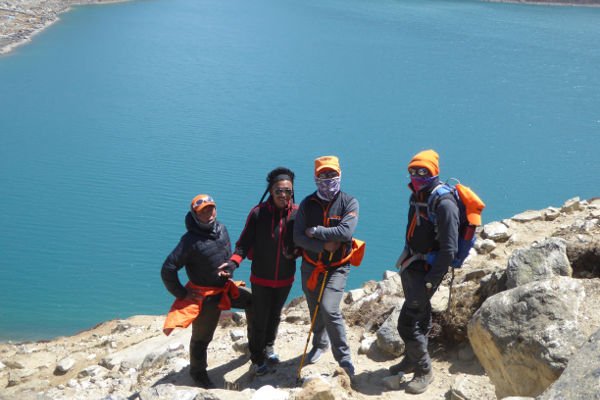
One of the more popular variations of the Everest Base Camp Trek, the Gokyo Lakes Trek, also starts at Lukla and follows the classic base camp trek to Namche Bazar where it forks north-west.
Jiri to Everest Base Camp

This variation of the classic trek offers an alternative to flying into to Lukla from Kathmandu to start the trek. The Jiri variation starts with an 8-hour bus ride from Kathmandu to Jiri, where the trek begins.
The variation adds an extra 5/6 days onto the trip as you trek through the Solu-Khumbu region and make your way past Lukla, where the trek then follows the same route as the classic Everest Base Camp Trek.
It involves a scenic, yet very long, bus ride as well as a lot more exposure to the Tibetan and Sherpa cultures. Expect to trek through more forests and streams as you start at the relatively low altitude of 1,800m and work your way up to Lukla and beyond.
Island Peak Climb

The variation trek that involves summiting Island Peak is significantly harder than the classic Everest Base Camp Trek. The climb to the peak is somewhat technical although and requires basic knowledge of using crampons and ice axes. Standing at just under 6,200m, however, altitude can be the real challenge.
Most climbers of Island Peak use the traditional base camp trek as a means of acclimatising before heading to the Island Peak Base Camp via Dingboche on the main trail, or by traversing the Chongma La pass. Summiting from the base camp typically takes two days and the whole variation will add around 4 days onto the classic trek.
Mark Whitman
Hi, I'm Mark! Welcome to EBC Trek Guide - the Web's No.1 Trekking Guide to Everest Base Camp. I have trekked all over Nepal, but the Everest region remains my favourite. I hope you find all the answers you are looking for on this site. If you have any questions don't hesitate to drop a comment below! Happy Trekking!
Leave a Reply
Your email address will not be published. Required fields are marked
Thank you. How slippery or rocky is the terrain on cho la pass? I don’t feel comfortable boulder hopping or walking on slippery terrain. You can train for uphill or distances but being able to balance on icy or scree surfaces is something else. We are looking at going in october . Any comments would be most welcome.
Hi Brigitte, the Cho La Pass consists of mix terrain that can vary quite considerably depending on prevailing weather conditions during the week you go. In general through you can expect mixed rock / scree terrain with areas that can be a little slippery with black / blue ice. Careful footing throughout is important. Show cover is quite likely too so it is worth taking basic yak tracks just in case you need additional grip. Hope this helps!
Is the path traveled and visible? Are there cairns, that Point the pass? Are there some kind of signs along the path? Is it easy to get accommodation for the night? Thank you
Hi Francisco, the three passes trek does follow a well defined route but it is not very well signposted. I would recommended taking a guide and / or getting a detailed map of the region. Accommodation throughout the route is not a problem, there are many small villages on the route and all have teahouse accommodation for trekkers. All the best!
What do you do for food along the route? The 3 peak pass in particular. Do you buy food for the day at every tea house? Thanks
Hi Frank, there are lots of teahouses along the Three Passes trek. In terms of lunch you can usually find a teahouse to stop at half way through your daily trek, or take a snack with you and only stop for dinner.
Thanks for the reply Mark!
Thanks for the useful information. Is this trek possible late December-early January? I did ACC last year late Dec-early Jan (including Tilicho), and it was wonderful, although desperately cold at higher altitudes. I assume this trek is colder as I would spend more time at higher elevation. I also appreciated that although less crowded that time of the year, there was good company in the higher teahouses and passes. Although I have no problem trekking alone, I would not feel completely comfortable spending days around 5000m completely alone. So my question would be, is this trek less crowded generally and colder than Annapurna Circuit?
Hi Daniel, I would say this trek will be colder than the Annapurna Circuit in Dec/Jan as you spend a lot more time at high altitude. The passes are also prone to closing in the winter if the weather is bad and there has been a lot of snow fall. I would definitely recommend taking a guide if you plan to trek the three passes.
I am planning for three pass trek in the first week of may. I have 15 days Itinerary. Is it possible to get it done including island peak. I am fit and I have plan to walk 9 hours per day. Plz let me know.
Thanks & Regards, Gopal
Hi Gopal, it’s possible to complete the 3 passes trek in 15 days, but the risk of altitude sickness (unless you are pre-acclimatised) is pretty high. Adding in Island Peak in addition would be a big ask, but doable if you are super fit and deal with the altitude well on the passes trek.
Hello there. I’m planning on attempting the 3 passes trek November 20-Dec 9 of this year. Is there a reason that you suggest clockwise? Most of the other places I have seen are suggesting counterclockwise. Any info would be greatly appreciated. Thanks!
Hi Murphy, thanks for getting in touch. I have no strong preference for either format. The reason why I suggest the clockwise route is because this is the I followed when completing the 3 Passes. The counterclockwise is equally as valid though.
Hi Mark, I am thinking about doing the Three Passes Trek. I have done Kilimanjaro one year before and further I do sport (mostly running, climbing, cycling) 3-4 times a week. However, I have never trekked for 19 days at high altitude and I don’t do a lot of trekking in my free time. Neither do I live in a place where my body is accustomed to higher altitude. I wonder if this is a trek I could do? Thank you in advance for your thoughts.
Hi Elene, you definitely sound fit enough to complete the 3 Passes. The key is to pace yourself, build in enough acclimatisation days to get accustomed to the high altitude, and make sure to look after your health with a good diet throughout. If you completed Kilimanjaro, you can definitely do the Three Passes. All the best!
Hi Mark thanks for all your useful information. I’m hoping to complete the Three Passes soon. I have years of experience. When would you suggest is the earliest I can expect to safely complete it. Mid-February OK?
Hi Rick, mid Feb can still be quite snowy and the passes may be closed. If you can push your dates a little bit further out – to mid March – then the probability of closed passes reduces (obviously there are no guarantees though). All the best!
Get a quote from the best local trek operator in Nepal!
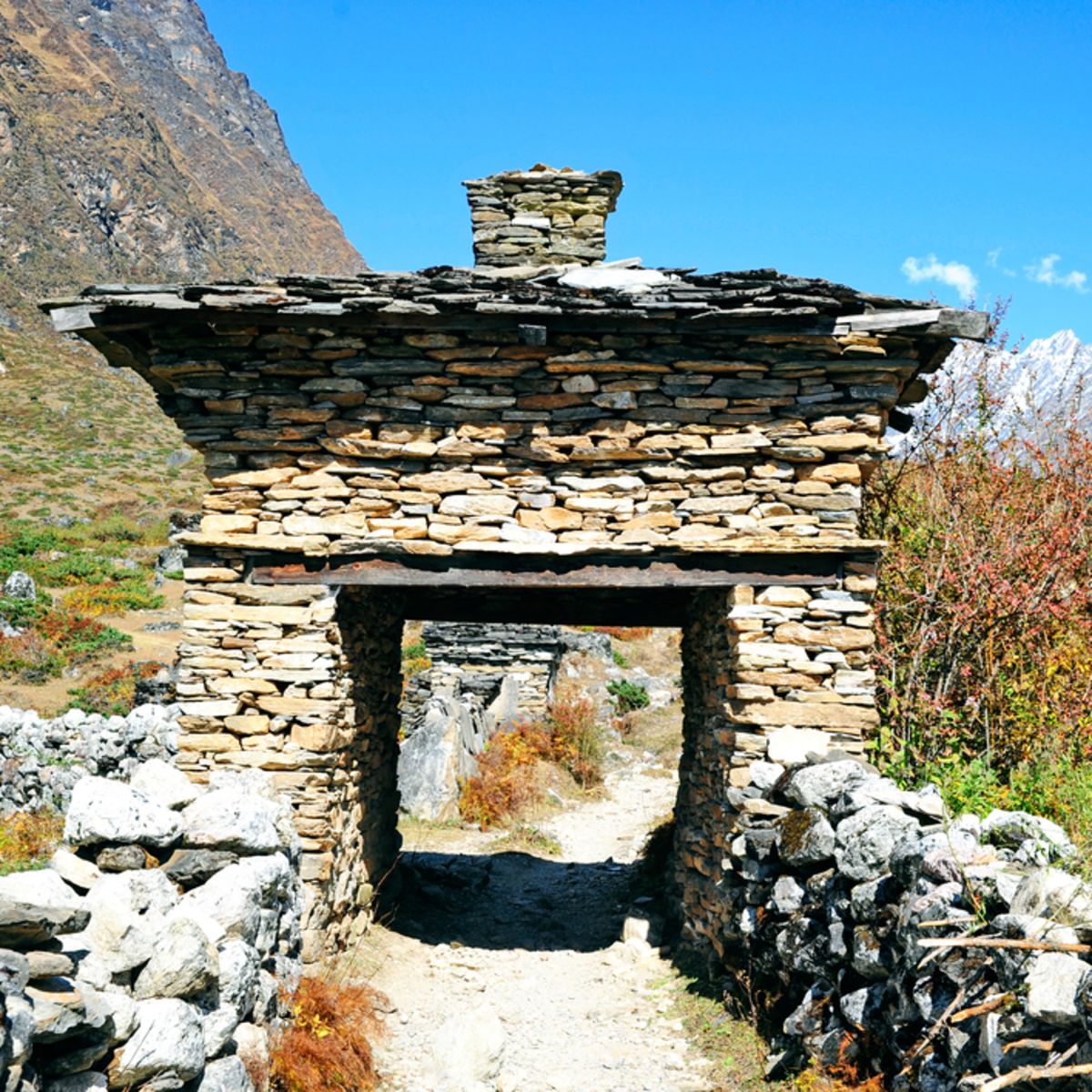
Everest Base Camp and Three Passes trek route
The Everest Base Camp and Three Passes trek winds through many beautiful and diverse sections of Sagarmatha National Park. Importantly, it takes you to the world's most famous base camp, but also up and over three incredible mountain passes.
EBC and Three Passes itinerary
As is the case with many multiday treks, the Everest Base Camp and Three Passes trek allows some flexibility in how you approach it. For instance, you can:
- walk the middle section in a clockwise or counterclockwise direction
- choose between different villages for your overnight stays
- decide how many acclimatisation and rest days you take
In this post we describe the EBC and Three Passes trek route itinerary that we use at Follow Alice. It's a trail of 124 km (77 miles), not counting the optional roundtrip hikes on the three acclimatisation and rest days.
Map of the EBC and Three Passes trek
Map of the EBC and Three Passes trek route
From the map above you can see that we walk the route in an anticlockwise direction. This is the ideal choice as it gives you enough acclimatisation time. Also, you climb the passes in the mornings with the sun on your back, which is nicely warming.
We also include three rest and acclimatisation days, which are really important for your health.
So let's tuck into all the juicy details of the trip ...
Day 1 – Arrive in Kathmandu
- Arrival: Tribhuvan International Airport
- Overnight: Thamel, Kathmandu
- Drive: Airport to Thamel (30 min)
- Accommodation: Arushi Boutique Hotel (or similar)
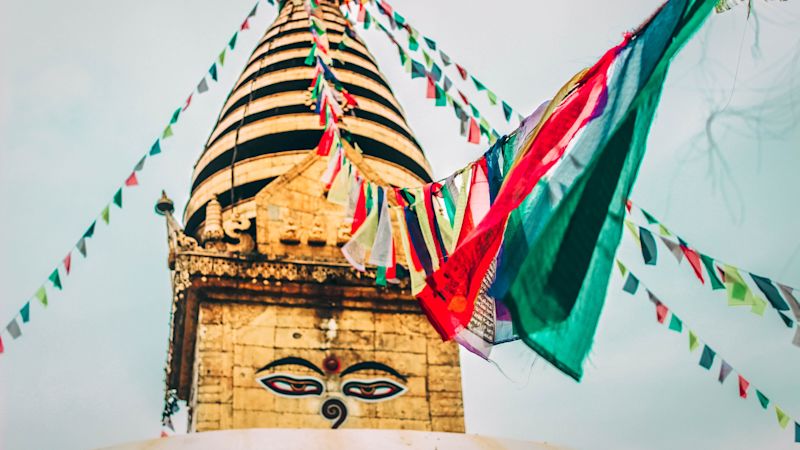
Kathmandu is chockfull of stupas and other religious monuments
Today we fetch you from Tribhuvan International Airport and drive you for about twenty minutes to the hotel in Thamel, a busy and vibey district of Kathmandu.
If you're not too tired from your trip, we encourage you to spend some time exploring Kathmandu. Even just walking the streets of Thamel – observing the architecture, mixing with the locals and trying some of the local cuisine – is a grand experience. The narrow lanes in the core of Thamel are only for pedestrians and are great for leisurely explores.
If you've forgotten anything for your trek, or want to hire something, Thamel has a wide range of trekking gear shops, so you're sorted on that front. You can also buy a cheap SIM card for your time in Nepal.
If you feel like the Nepali equivalent of a bus-top tour, we recommend hopping on a rickshaw for a fun way to see the sights of Thamel. Or if you'd like to visit somewhere a little less busy, $2 gets you entrance into the Edwardian-style Garden of Dreams . Wander around and admire the pavilions, pergolas, sculptures, fountains and lily pads, verandahs and birdhouses, or just chill with a book and a drink on the grass. If you've forgotten to bring along some reading material, Thamel actually has quite a few bookstores that stock English literature.
Tonight we enjoy dinner together as a group and chat about what to expect in the upcoming days.
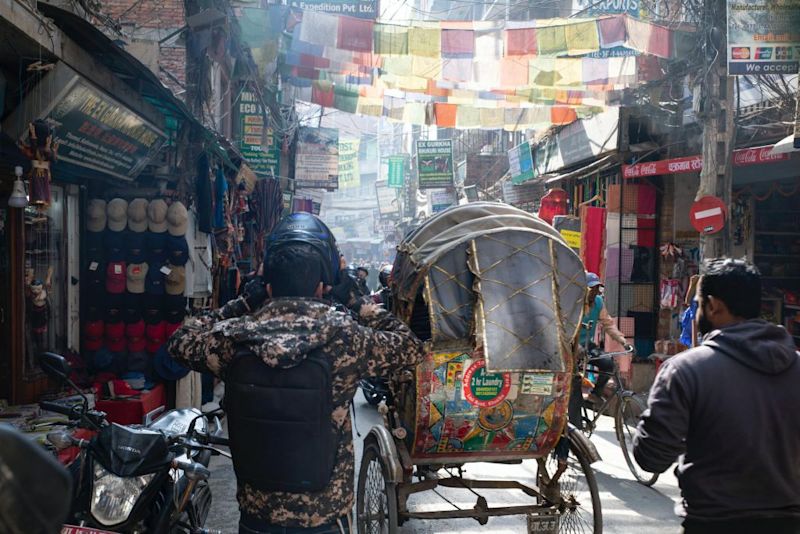
Kathmandu is a busy and humming city, night and day
Day 2 – Drive to Manthali
- Drive: Kathmandu to Manthali (5 hr)
- Overnight: Manthali
- Accommodation: TBD
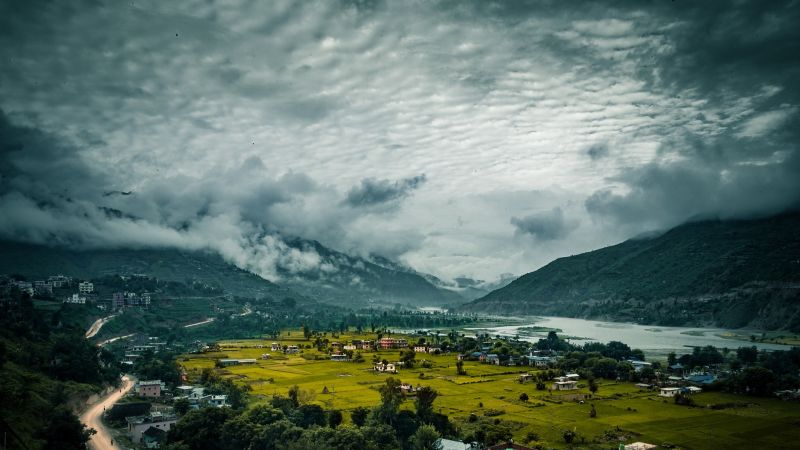
A lovely view of the district of Ramechhap as snapped by S. Pradhan
This morning we drive southeast in our private vehicle to reach the pretty district of Ramechhap so that we can catch a flight from Manthali Airport tomorrow to Lukla, the start of the EBC trek.
We can't unfortunately fly straight to Lukla from Kathmandu, as Tribhuvan International Airport is currently undergoing major construction that doesn't allow for domestic flights to take off and land there. This is why we've had to add another two days to this itinerary, to allow time to reach Manthali Airport in Ramechhap.
Day 3 – Trek to Phakding
- Flight: Ramechhap to Lukla (15 min)
- Starting point: Lukla (2,860 m / 9,383 ft)
- Overnight: Phakding (2,610 m / 8,562 ft)
- Accommodation: Teahouse
- Distance trekked: 8.2 km / 5.1 mi
- Hours trekking: 3 hours
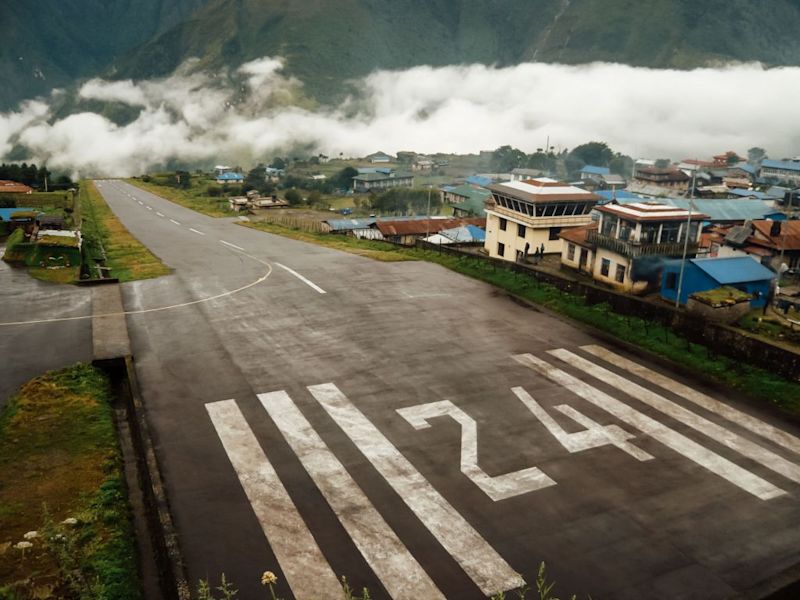
We fly from Kathmandu to Lukla Airport, shown above
This morning we take a short and exhilarating flight east from Raemchhap in a small aircraft to the mountainside town of Lukla. The flight is a moment in itself, offering incredible views of the mountains. And landing at Tenzing-Hillary Airport is not something you sleep through – this short runway perched on the side of a mountain demands just the right weather conditions and a skilled pilot!
Flight done and dusted, we then hand over our duffel bags for transport via yaks, put on our daypacks, and get walking. 😀 We head northwest out of Lukla on the start of the famous EBC trail! Whoop whoop! The route today isn't that tough or long, and we follow a nicely worn footpath through Sherpa countryside.
This section of the trek is incredibly pretty. We soon enter the lush and forested Dhudh Kosi river valley and wind our way up the valley, with the river staying on our left. En route we pass by picturesque Sherpa settlements, like Surke (shown below).
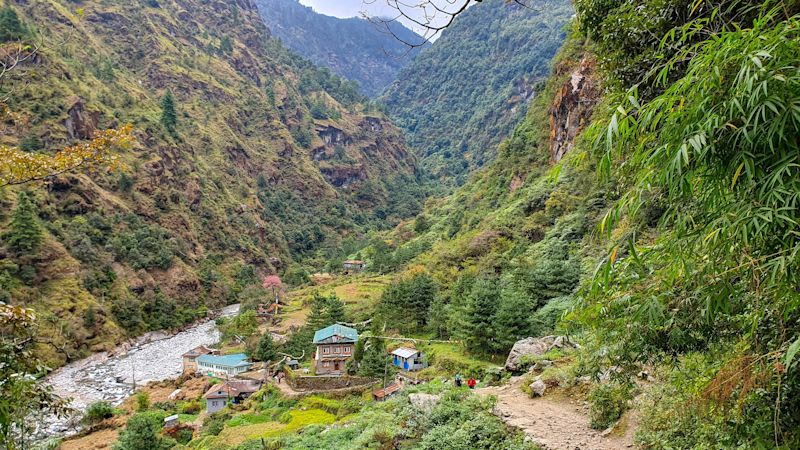
The village of Surke near the river Dudh Kosi
What some might not realise is that the Everest Base Camp trek route is not a hikers-only path. Rather, the route followed by trekkers is the long-established 'highway' used everyday by locals. There's no road or larger route connecting the various towns and villages of the Sherpas – the EBC trek route is the main thoroughfare. So expect to share the path with tourists and Sherpas alike, as well as yaks, horses and mules.
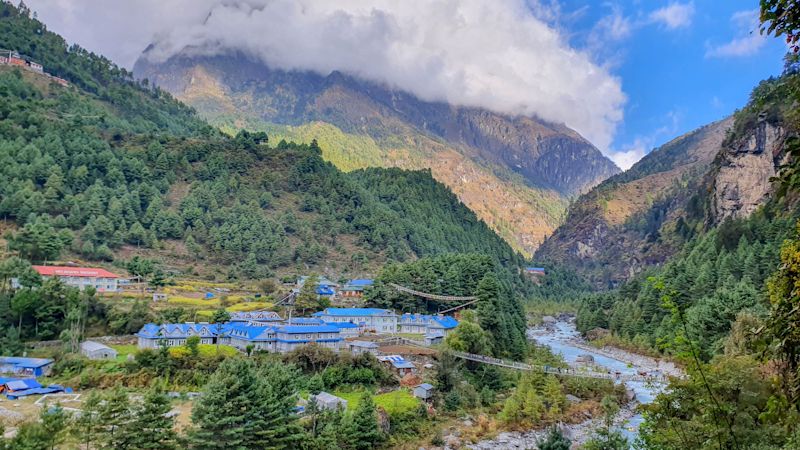
The prettily situated village of Phakding
We spend our first night on the trail in the pretty riverside village of Phakding. Phakding is actually at a lower elevation to Lukla, so your body won't be challenged by an altitude increase just yet.
Day 4 – Trek to Namche Bazaar
- Starting point: Phakding (2,610 m / 8,562 ft)
- Overnight: Namche Bazaar (3,440 m / 11,286 ft)
- Distance trekked: 9.4 km / 5.6 mi
- Hours trekking: 6-7 hours
- Highlight: Cross the Hillary Suspension Bridge
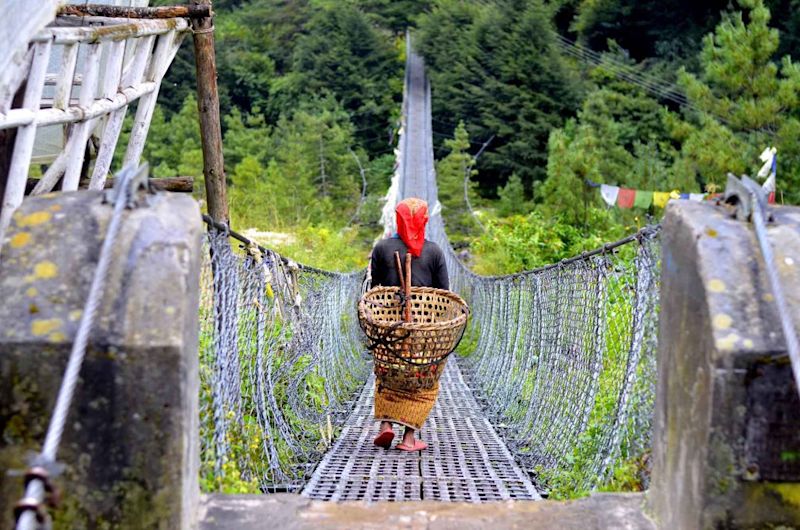
Today is a day of multiple suspension bridge crossings
Today's trek continues up the Dhudh Kosi Valley. During today's hike we enter Sagarmatha National Park, a UNESCO World Heritage Site. We pass the lovely Toktok Waterfall near the park's entrance, and it's a great location for a little rest stop.
What's especially fun and noteworthy today are all the bridges we must use as we crisscross the river! The suspension bridges are draped in multicoloured prayer flags and are often high above the river. We share them with yaks and mules. The Edmund Hillary Suspension Bridge is the biggest showstopper: it sits 125 m (410 ft) above the river and is 140 m (459 ft) long – quite the daunting prospect if you struggle with heights!
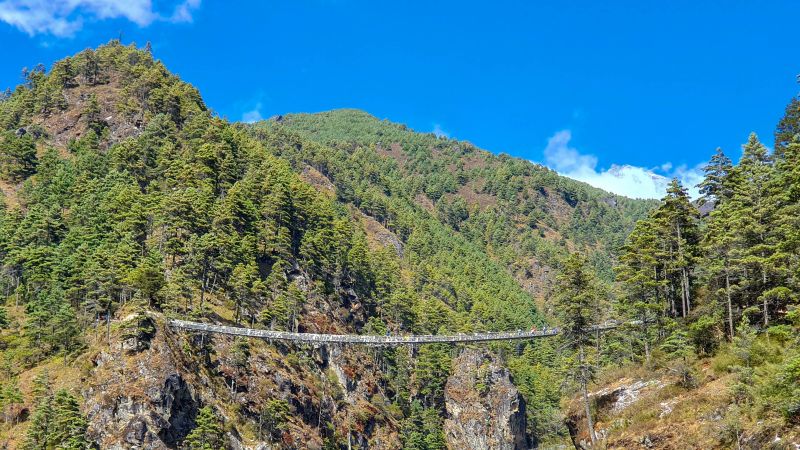
We cross the Edmund Hillary Bridge en route to Namche Bazaar
Pro tip: Don't enter a suspension bridge if there are yaks or mules busy crossing it, as they could well knock you over.
After this bridge it's a steep and taxing climb up to Namche Bazaar, which sits on a high outcrop at the confluence of the Dhudh Khosi and its tributary the Bhote Khosi. Today is when the change in altitude can really be felt (we climb nearly a vertical kilometre!), and so taking a rest tomorrow is paramount.
Namche has so much to offer the curious trekker, though most are tired from the trek and leave the exploration for tomorrow. A great treat after arriving is afternoon tea at one of the cafés. For many, the German Bakery is a great choice as it offers a comforting taste of home in the form of cappuccinos and dark chocolate cake.
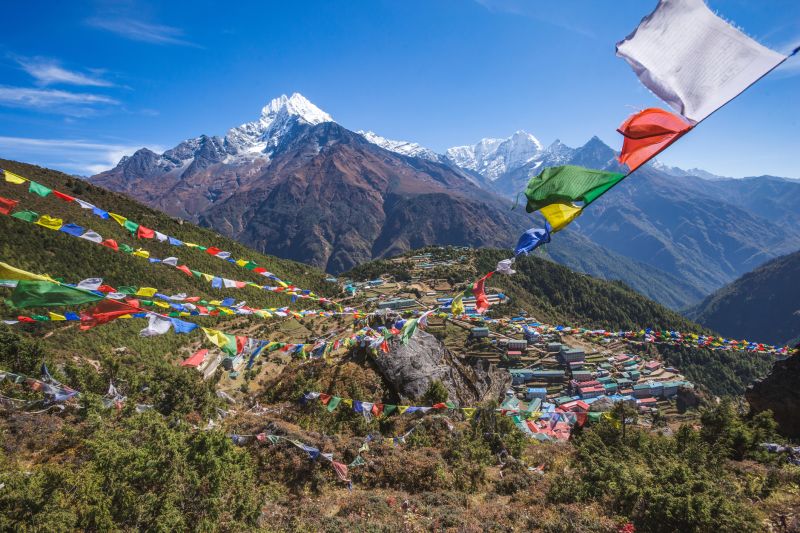
Namche Bazaar is a regional hub and the largest Sherpa town
Day 5 – Acclimatisation and Hotel Everest View hike
- Highlight: Hike to Hotel Everest View for tea
- Hotel Everest View elevation: 3,880 m / 2,730 ft
- Hike distance: 5.4 km / 3.4 mi
- Hiking time: 3 hours
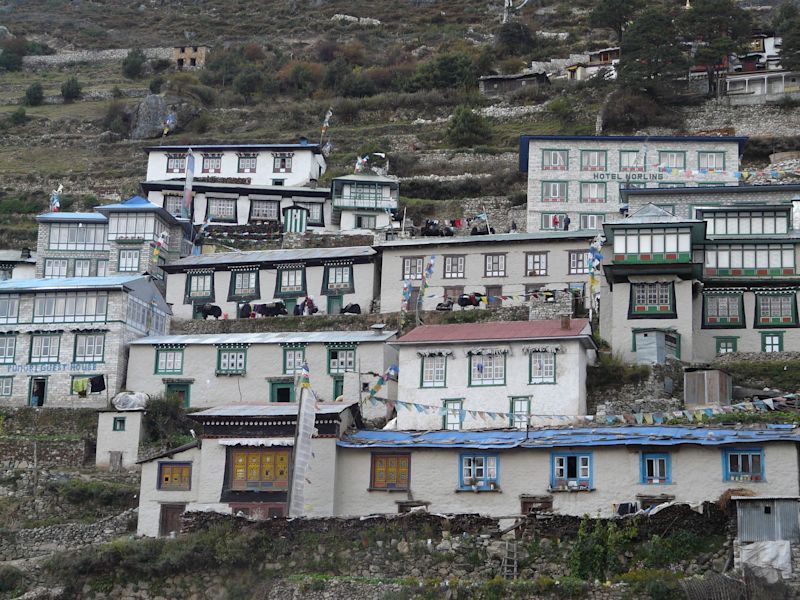
Namche Bazaar is a town of steeply terraced buildings, so most of the buildings offer great views!
It's important to give your body time to adjust to the higher altitude, so today we stay put in Namche. That said, there's lots you can choose to do, like visit the Sherpa Museum or local monastery, or do a beautiful day hike to Everest View Hotel for a drink and snack.
There are plenty of shops in Namche Bazaar for stocking up on snacks and any other trekking whatnots you might need. There are a couple of ATMs in town, but they don't accept all cards and we wouldn't rely on them in case they're not working. The better option is bringing enough rupees with you, or exchanging dollars or euros at the local bank in Namche.
Some like to do a day roundtrip hike to Hotel Everest View , the famous hotel that opened in 1971. From here you can have drinks or a bite to eat while enjoying panoramic views that do, of course, include Mt Everest!
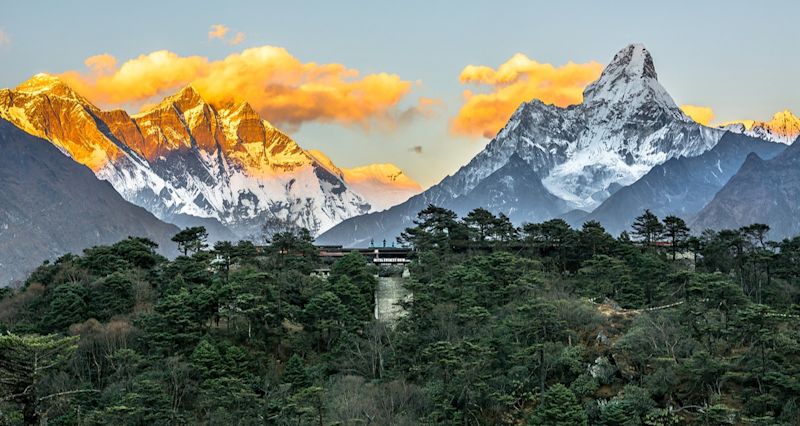
Hotel Everest View was built in the 60s and is one of the world's highest hotels
Day 6 – Trek to Tengboche
- Starting point: Namche Bazaar (3,440 m / 11,286 ft)
- Overnight: Tengboche (3,870 m / 12,696 ft)
- Distance trekked: 9.6 km / 6 mi
- Hours trekking: 5-6 hours
- Highlight: Visit Tengboche Monastery
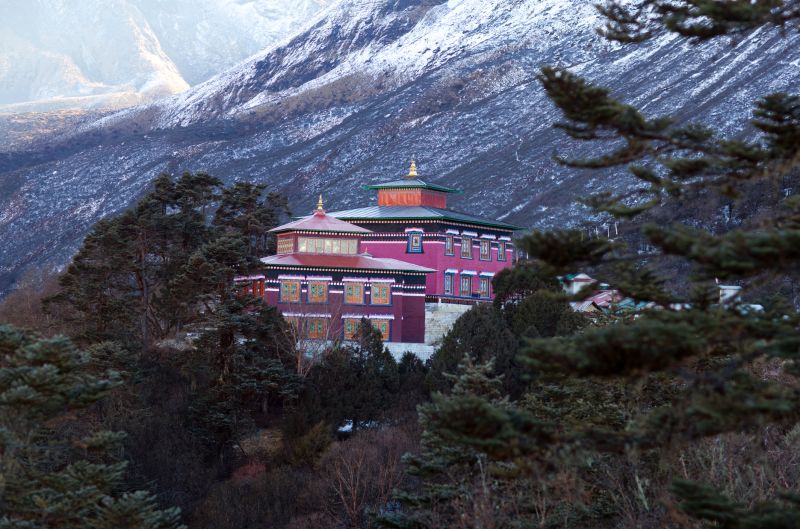
Tengboche Monastery is the largest in the Khumbu region
Today we head in a northeasterly direction up the Pheriche Valley to reach the village of Tengboche. We walk a pretty smooth and flat contour path for a long way. Eventually the trail descends to the valley floor. And then, to reach Tengboche (or Thyanboche), which sits on a hill at the confluence of the Dudh Kosi and the Imja Khola, there's a big climb.
The views on today's hike of Lhotse, Everest and Ama Dablam are unforgettable!
Given its high position on a hill, Tengboche offers visitors a view of some amazing peaks, which include Tawache, Everest, Nuptse, Lhotse, Ama Dablam, and Thamserku. When viewed from Tengboche, Ama Dablam looks like a mother with outstretched arms. The mountain's name literally means 'mother's necklace'. It's a favourite among many who trek in the region for its striking shape and beauty. It also can be seen on many days of the EBC trek, almost like a mother keeping an eye on things!

Local Sherpas use the EBC trek route as their primary means for getting around the region
Tengboche Monastery – also known as Dawa Choling Gompa – is a Tibetan Buddhist monastery. It's the largest in the whole Khumbu region, and is most definitely worth a visit! It contains a 20-foot Buddha sculpture, as well as detailed wall hangings, clothes and musical instruments. Visitors can also observe a prayer ceremony.
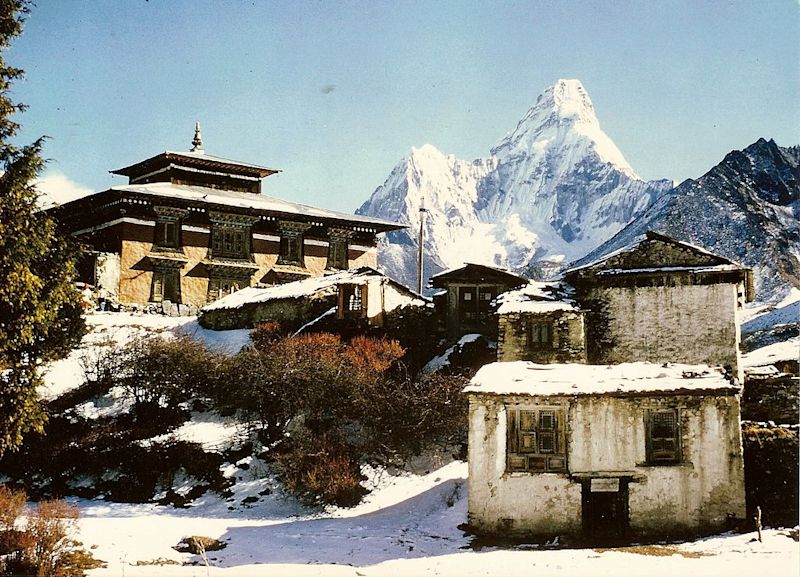
Here you can see Ama Dablam behind Tengboche in a 1974 photo by clemensmarabu
Day 7 – Trek to Dingboche
- Starting point: Tengboche (3,870 m / 12,696 ft)
- Overnight: Dingboche (4,360 m / 14,304 ft)
- Distance trekked: 10.5 km / 6.5 mi
- Hours trekking: 6 hours
- Highlight: The view from Nangkartshang Peak
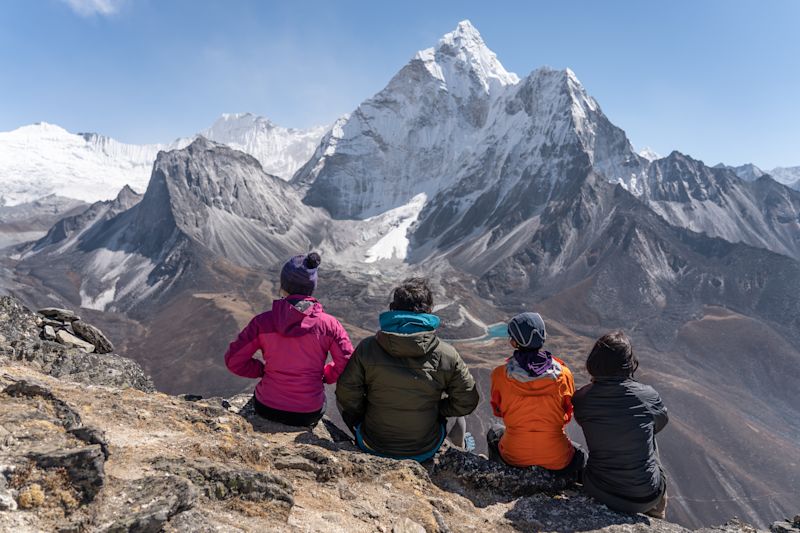
View of the beautiful Ama Dablam from Nangkartshang Peak above Dingboche
We climb up the Imja Khola valley, walking through woods and enjoying increasingly spectacular views of the snow-capped peaks towering around us. Ama Dablam and Island Peak in particular are breathtaking.
Three kilometres out of Tengboche, we pass by Pangboche (3,985 m), the highest year-round settlement in the valley. This green-roofed village is the base camp for trekkers climbing nearby Ama Dablam. Its monastery is the oldest in the region, and famed for its supposed yeti scalp.
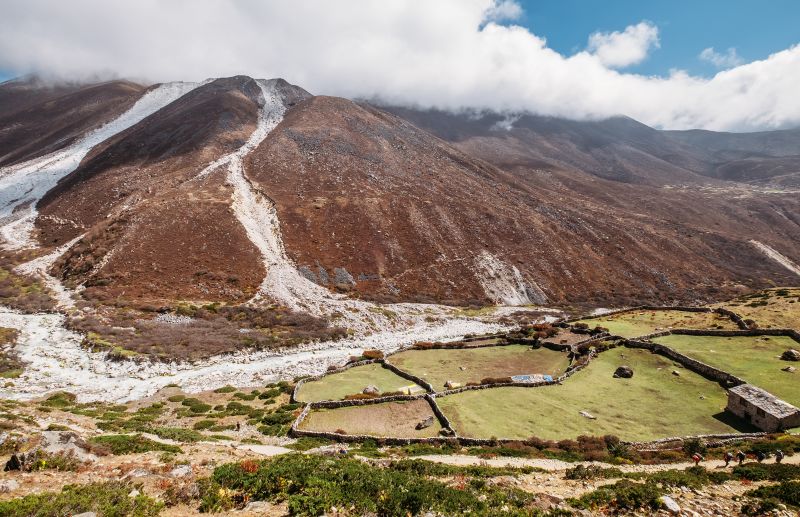
Glaciers, moraines, the village of Pangboche and the Imja Khola river
A little way before Dingboche there's a fork in the road: those following the classic EBC trek keep left and head towards the village of Pheriche. We keep right, however, and soon cross a bridge, after which we tackle a steep climb up to Dingboche.
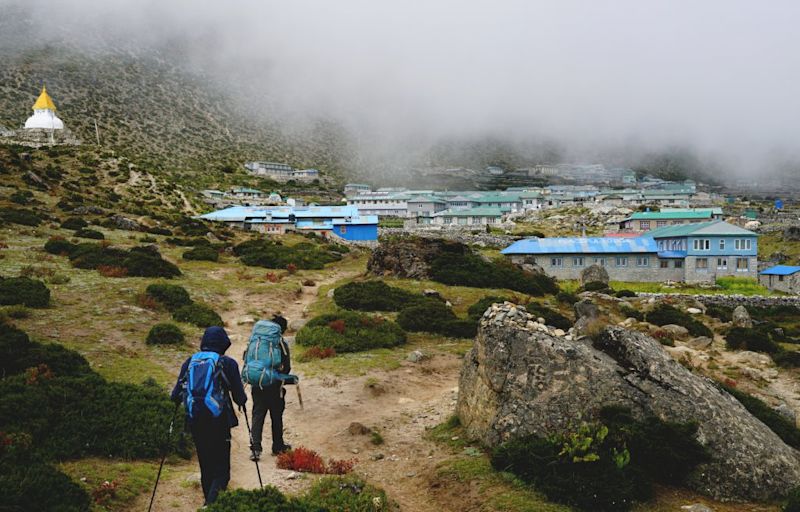
Welcome to Dingboche!
If you're a strong trekker who has made good time in reaching Dingboche, then we recommend taking on the additional climb to Nangkartshang Peak (which is a bit of misnomer, as it's more a sub-peak of a higher ridge). From here you have an incredible and rewarding vantage point of the surrounding mountains; you can see various beauties like Ama Dablam, Kangtega, Nuptse, Lhotse, Makalu, Cho Oyu and Taboche.
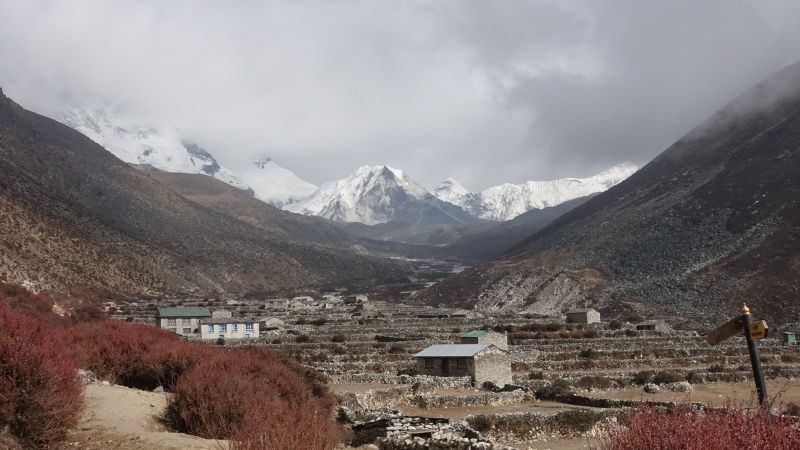
Dingboche with Island Peak in the centre distance
Day 8 – Trek to Chhukung
- Starting point: Dingboche (4,360 m / 14,304 ft)
- Overnight: Chhukung (4,730m / 14,334ft)
- Distance trekked: 5 km / 3.1 mi
- Hours trekking: 2-3 hours
- Highlight: Hiking the beautiful and quiet Imja Khola valley

Looking back on the trek route from Dingboche to Chhukung
Today we have an easier trek on our hands, walking a relatively gentle incline up the Imja Khola valley floor to the village of Chhukung (or Chukhung). This is a much quieter part of Sagarmatha National Park, and so the trail won't be as busy as it was until around Tengboche. We pass by stone-walled fields and eventually enter into moraine territory just before reaching Chhukung.
Chhukung developed as a teahouse (lodge) village to service those on their way to trek over Kongma La as well as climb Island Peak.
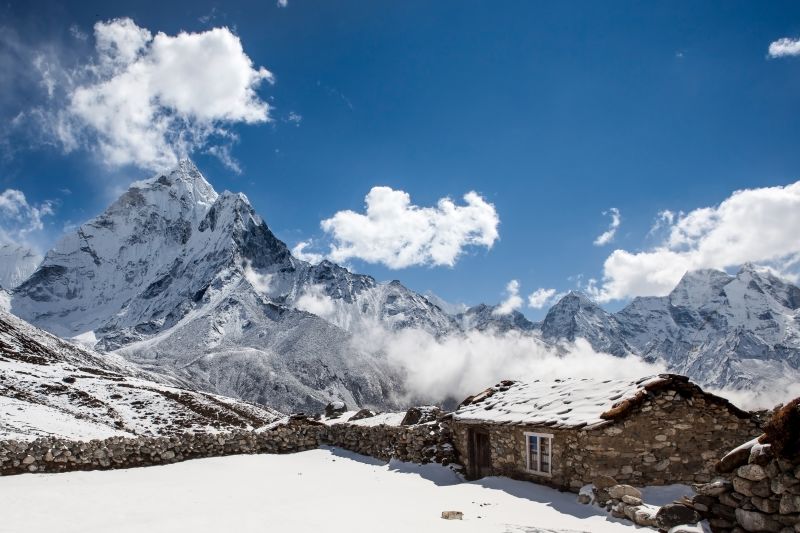
A view of Chhukung in winter with Ama Dablam looming above all
Day 9 – Acclimatisation and hike
- Starting point: Chhukung (4,730 m / 14,334 ft)
- Overnight: Chhukung (4,730 m / 14,334 ft)
- Highlight: Climb Chhukung Ri or visit Island Peak Base Camp
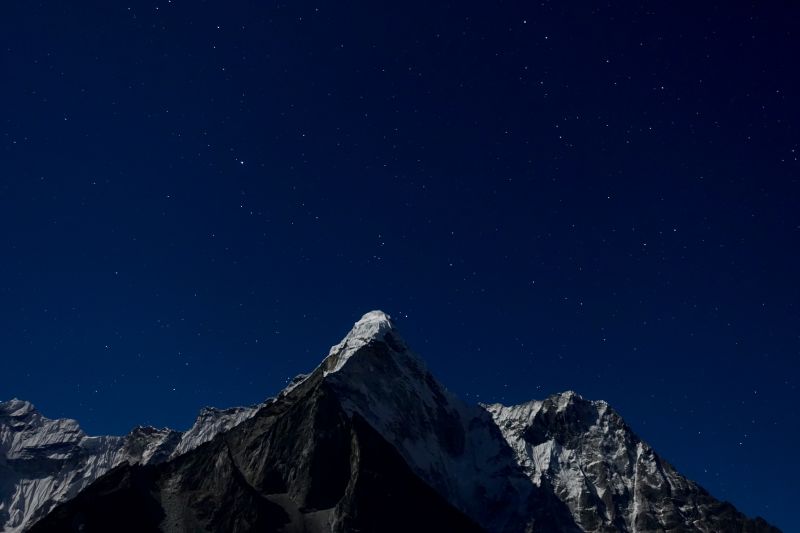
A night-time sky and Ama Dablam as seen from Chhukung
We stay put today and spend another night in Chhukung to help our bodies acclimatise to the ever-increasing altitude.
There are some options on the table: relax at the lodge with a good book and good companions, or head on out and do a day hike. Then, if we choose the hike, we can either climb Chhukung Ri or visit Island Peak Base Camp.
Chhukung Ri (5,550 m / 18,208 ft) is a taxing roundtrip of about four hours. It's great for helping the body to acclimatise, but you want to weigh that benefit against the possible need for a day of complete rest. Trekking fatigue is real. If you do choose to do the hike, the view from the top is simply incredible, letting you see Island Peak, Ama Dablam, Makalu and Nuptse, among other peaks.
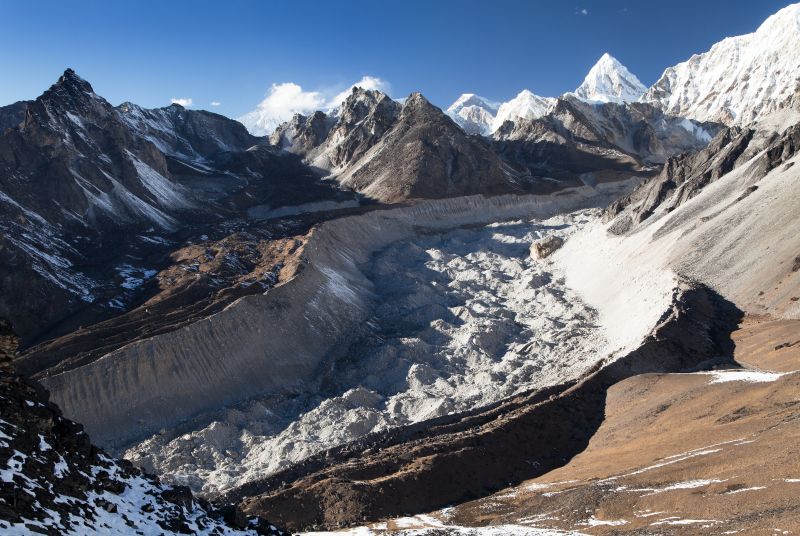
The breathtaking view from Chhukung Ri
Island Peak is a whopping mountain at 6,160 m (20,210 ft). It earned its name in 1953 from an expedition team (which included Tenzing Norgay and Edmund Hillary) because they thought it looks like an island in a sea of ice when seen from Dingboche. In 1983 it was renamed Imja Tse, but many still refer to it as Island Peak. A great day hike of around eight hours is visiting Island Peak Base Camp (5,100 m / 16,732 ft) on the southern slope of the mountain. We pass Imja Tse lake en route.
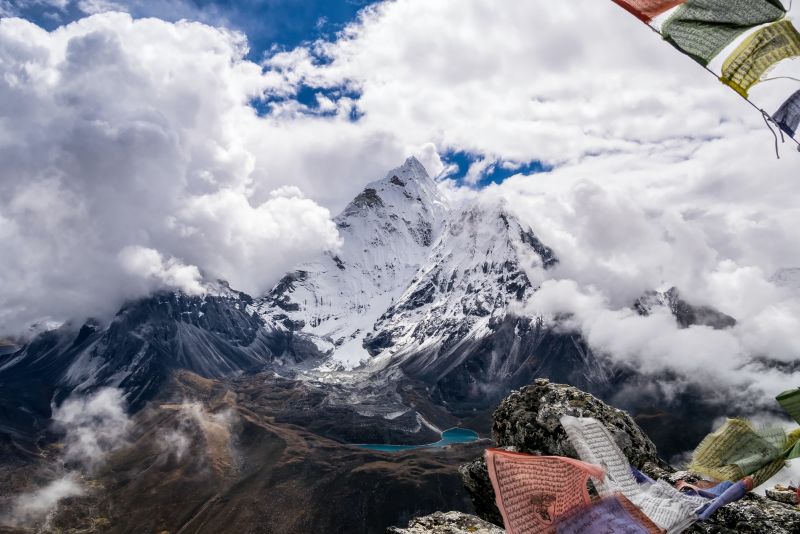
Another amazing view from Chhukung Ri
Day 10 – Summit Kongma La
- Overnight: Lobuche (4,940 m / 16,210 ft)
- Kongma La elevation: 5,535m/18,154ft
- Distance trekked: 10.6 km / 6.6 mi
- Hours trekking: 9-10 hours
- Highlight: Views from the top, and crossing Khumbu Glacier
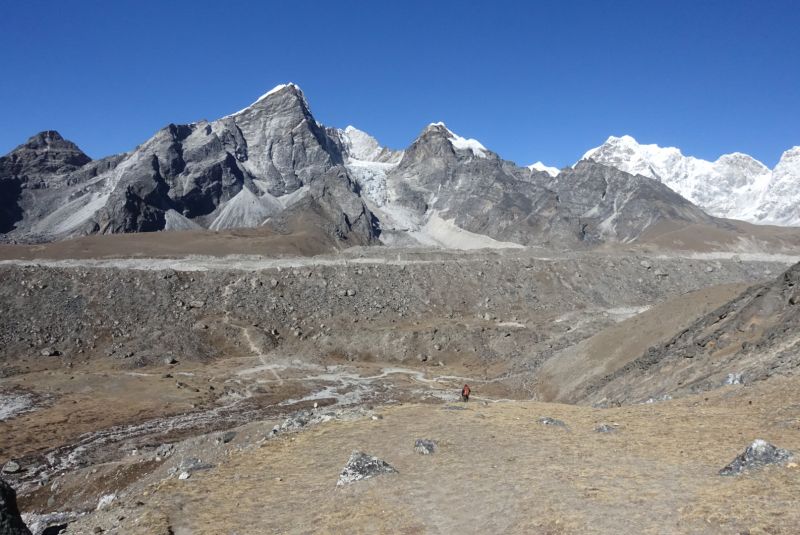
A November view while descending Kongma La
Today we tackle our first pass! Kongma La is a challenging mountain pass that's actually higher in elevation than Everest Base Camp. It's also the easternmost and highest of the three passes that make up the EBC and Three Passes trek.
With all that in mind, today is a very good day for concentration, crampons and trekking poles, as much of the route is rocky and uneven. But there are also some beautifully smooth sections of trail on the ascent.
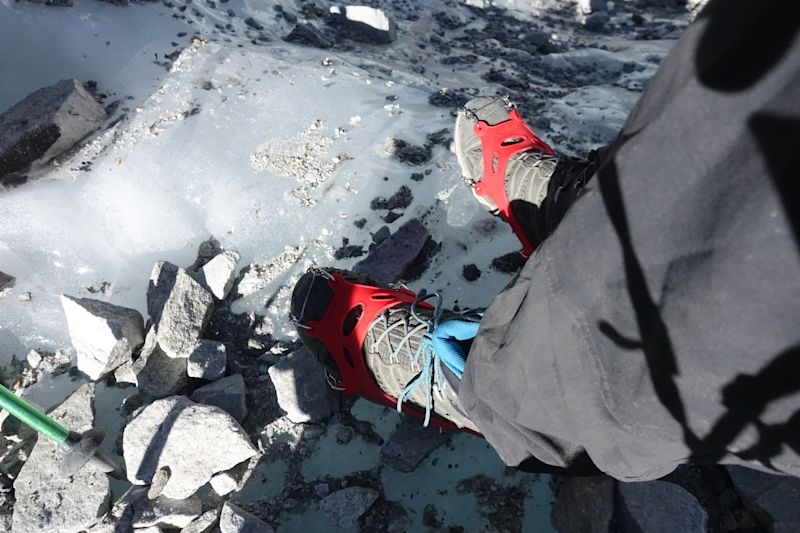
Crampons are sometimes needed to help you navigate the passes
When you reach the top, you're rewarded with breathtaking views to the east and west. These make the climb worth every bit of effort! The descent is trickier than the ascent, as it's much steeper. So it's just about taking it slowly and at your own pace. There's no rush.

Celebrating having conquered Kongma La!
Near the bottom of the pass we cross over Khumbu Glacier, which of course is the same glacier that famously flanks Everest! It's also the largest glacier in Nepal. Having crossed Khumbu Glacier, we head to Lobuche for the night. And by doing so, link back up with the classic EBC trail.
Excitingly, we cross Khumbu Glacier during our descent from Kongma La.
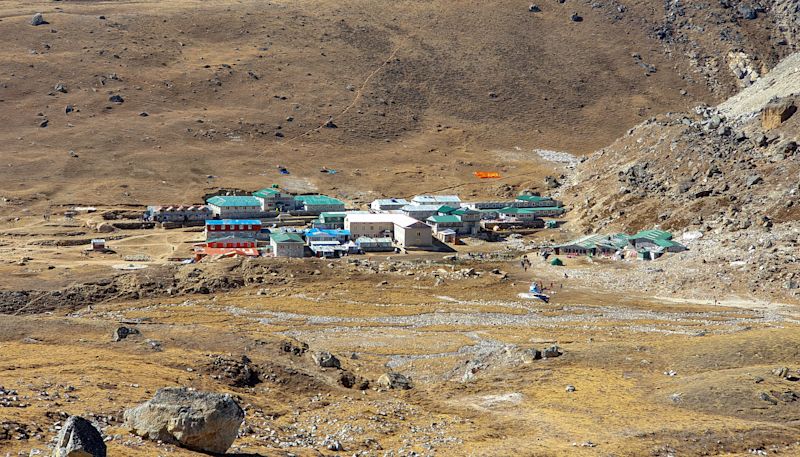
Tonight we stay at the village of Lobuche
Day 11 – Visit Everest Base Camp!
- Starting point: Lobuche (4,940 m / 16,210 ft)
- Overnight: Gorakshep (5,164 m / 16,942 ft)
- Everest Base Camp elevation: 5,364 m / 17,598 ft
- Distance trekked: 10.8 km / 6.7 mi
- Hours trekking: ~ 4 hours
- Highlight: It's finally EBC time!

Everest Base Camp – in the quiet season, the prayer flags mark the spot!
Today is the BIG DAY! We head northeast after breakfast along a well-worn path to reach Everest Base Camp. Bring. It. On.
The climb season for Everest is spring (April to early June), so this is the time to plan your EBC and Three Passes trek if you really want to see the base camp in action. At other times of the year, the camp is deserted. Prayer flags and a large, spray-painted rock (that you can climb atop for a photo) indicate you've reached the internationally renowned spot.
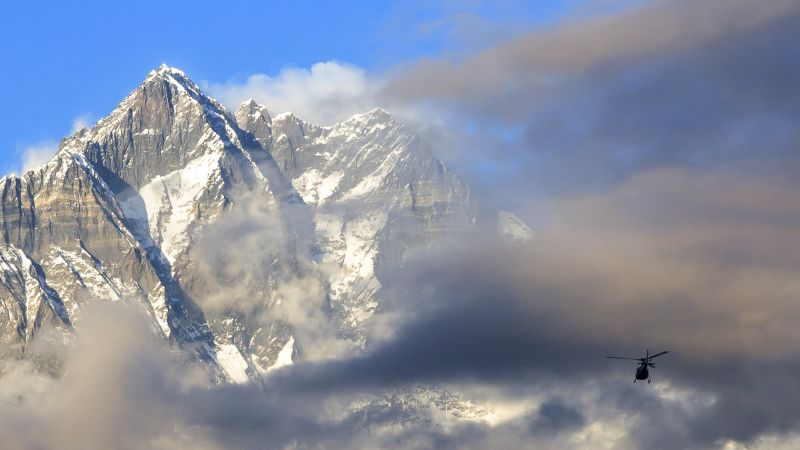
A helicopter is a tiny speck against the enormity of Lhotse
Depending on the time of year, EBC will be pretty deserted, or a bustling hive of activity!
You can't actually see the peak of Everest from base camp. But you're standing amidst some incredible mountains, and you're also up close and personal with Khumbu Glacier, the world's highest glacier!
Having visited EBC, we travel the short distance back to the settlement of Gorakshep, where we spend the night. Gorakshep was actually the original EBC – it was used by Swiss mountain climbers in 1952 in their attempt to summit Everest.

An aerial view of Gorakshep
Day 12 – Climb Kala Patthar
- Starting point: Gorakshep (5,164 m / 16,942 ft)
- Overnight: Dzongla (4,830 m / 15,850 ft)
- Kala Patthar elevation: 5,645 m / 18,519 ft
- Distance trekked: 10.4 km / 6.2 mi
- Hours trekking: 8-10 hr
- Highlight: Epic view of Everest from Kala Patthar
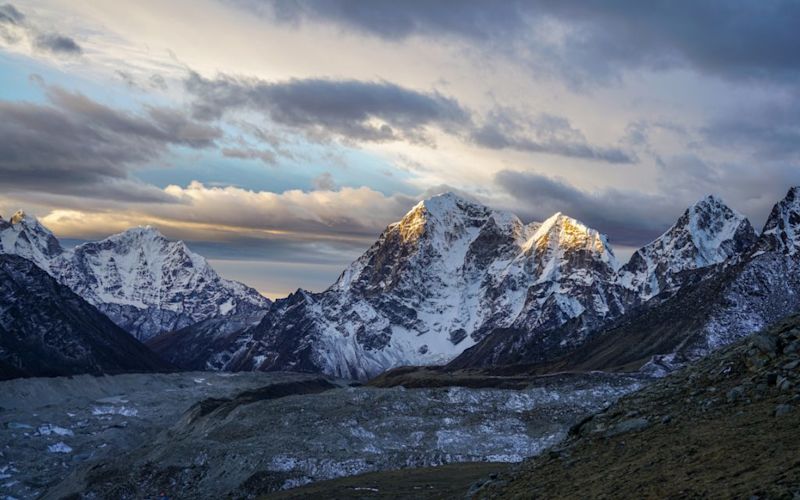
The view from Kala Patthar in the direction of Lobuche
We head first to Kala Patthar, a tough climb with a massive reward: an unobstructed view of Mt Everest!
Kala Patthar means 'black rock' in Nepali, and you'll find it looks similar to a black sand dune.
Kala Patthar is on everyone's itinerary as it offers a fantastic 'full frontal' of Everest. So after breakfast today, we head north to tackle Kala Patthar. While it's not a massive climb, it's tiring, given the altitude, and so fresh morning legs are helpful here.
Having taken in the view of Everest and its mates like Lhotse, Makalu and Cho Oyu from Kala Patthar, we head back south along the classic Everest Base Camp trek route. We pass through Lobuche, and then later on, when the trail nears the head of the Imja Khola river, we veer west away from the main route and head towards the village of Dzongla (or Dzonglha).

'Touching' the tippy top of Mt Everest while standing on Kala Patthar!
The path we walk to Dzongla is well-defined and offers simply incredible views of the surrounding mountains – it's the stuff of day dreams. We can see peaks like Arakam Tse, Cholatse and Taboche, and also pass the lake Chola Tsho. There's a fair bit of up and down along the route, and a final ascent to the blue- and green-roofed buildings of Dzongla.
Day 13 – Summit Cho La
- Starting point: Dzongla (4,830 m / 15,850 ft)
- Overnight: Gokyo (4,750 m / 15,584 ft)
- Cho La elevation: 5,420 m / 17,782 ft
- Distance trekked: 12.5 km / 7.5 mi
- Highlight: View from Cho La of mountain, glaciers and lakes
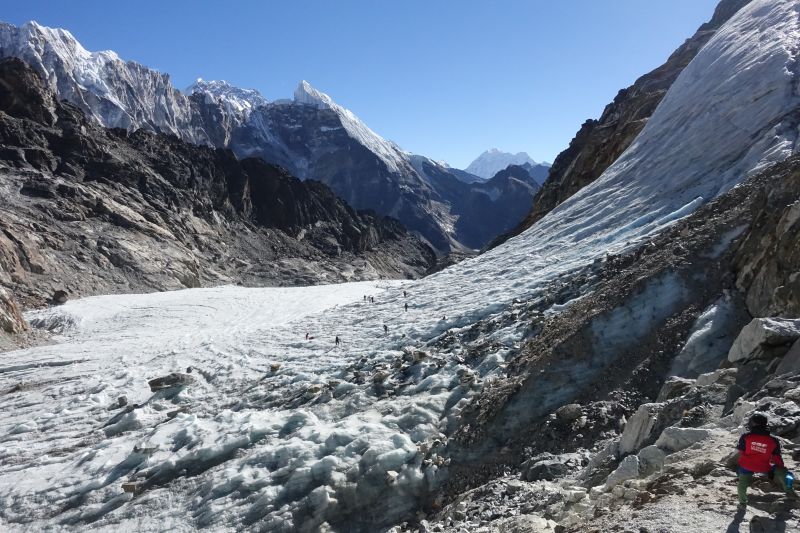
These hikers tackling the glacier on Cho La look like mere ants
It's time now to tackle our second pass! This is a relatively difficult pass, as we cross Cho La Glacier on the ascent. The top of the pass rewards us with magnificent views to both the east and west. The descent is once again steeper than the ascent.
After conquering the pass, we trek through the small village of Thangnak (4,680 m / 15,350 ft) near its base. This is a remote and gorgeous section of Sagarmatha National Park that many don't get to see.
We then strike out for our night-time destination of Gokyo, a small village with an outsized boast:
- It sits in the shadow of Cho Oyu (8,150 m / 26,739 ft), the world's sixth highest mountain.
- Directly above the village is Ngozumpa Glacier, the longest glacier in the Himalayas at 36 km (22 mi).
- It's also on the shore of one of the Gokyo Lakes, the world's highest fresh water lake system.
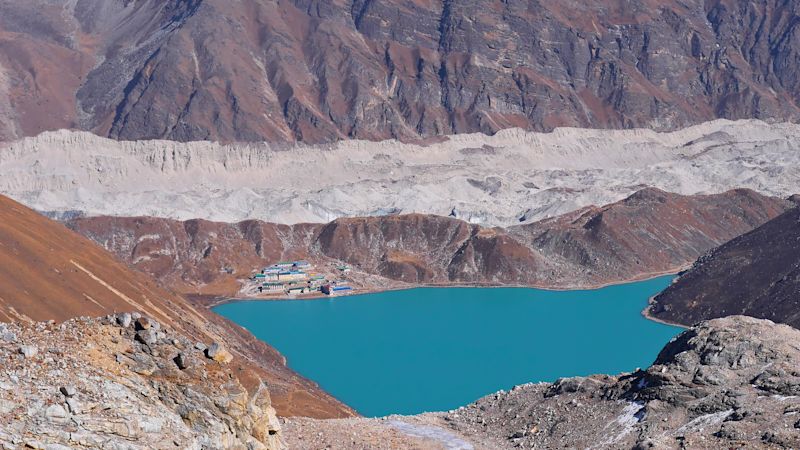
The village of Gokyo can be seen here below Ngozumpa Glacier and on the shore of Gokyo Cho
The Gokyo Lakes are sacred to both Buddhists and Hindus. In fact, every August around 500 Hindus make a pilgrimage there to bathe in their waters. The most well-known lake is the one alongside the village of Gokyo, and is called Gokyo Cho (or Dudh Pokhari).
To reach Gokyo, we cross Ngozumpa Glacier, so you'll get to see this renowned glacier all up close and personal.
Day 14 – Acclimatisation and Gokyo Ri hike
- Starting point: Gokyo (4,800 m / 15,580 ft)
- Overnight: Gokyo (4,800 m / 15,580 ft)
- Gokyo Ri elevation: 5,357 m / 17,575 ft
- Hike distance: 4 km / 2.4 mi
- Hiking time: 3-4 hours
- Highlight: 360° view from Gokyo Ri
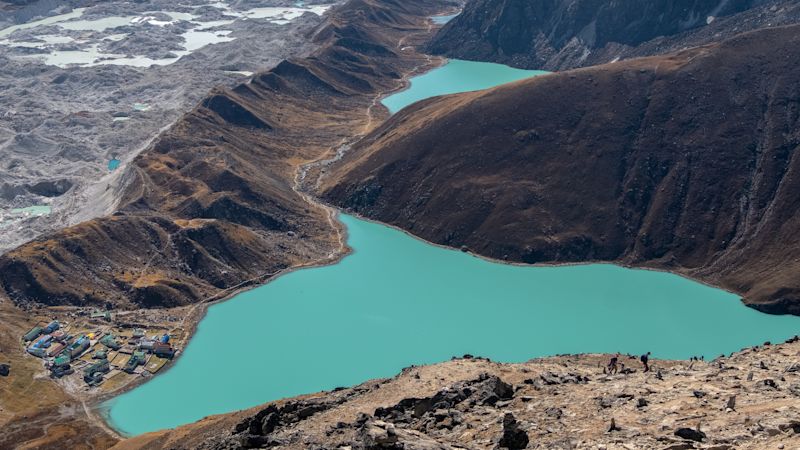
View of Gokyo, Ngozumpa Glacier, Gokyo Cho and more from the top of Gokyo Ri
Today is a special day as we're going to hike to the top of Gokyo Ri (Peak) for some sublime views! For the hike, we follow a roughly linear path to the peak and back.
Standing on Gokyo Ri, we can gaze down to the north on the largest of the Gokyo Lakes, called Gokyo IV (or Tonak Pokhari). To the southwest we can see Renjo La, which we cross tomorrow. And further afield to the north and east we have a seemingly endless line of famous peaks, including four that rise above the 8,000 m mark: Everest, Lhotse, Makalu and Cho Oyu!
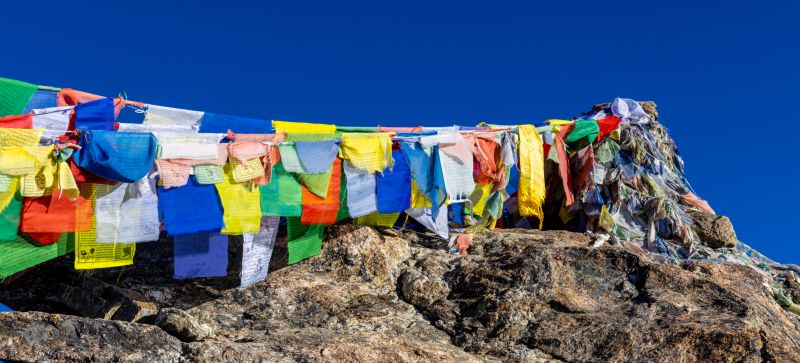
Prayer flags atop Gokyo Ri
Day 15 – Summit Renjo La
- Overnight: Marulung (4,210 m / 13,810 ft)
- Renjo La elevation: 5,360 m / 17,560 ft
- Distance trekked: 9.5 km / 5.6 mi
- Hours trekking: 8-9 hours
- Highlight: View of Everest and other peaks from Renjo La
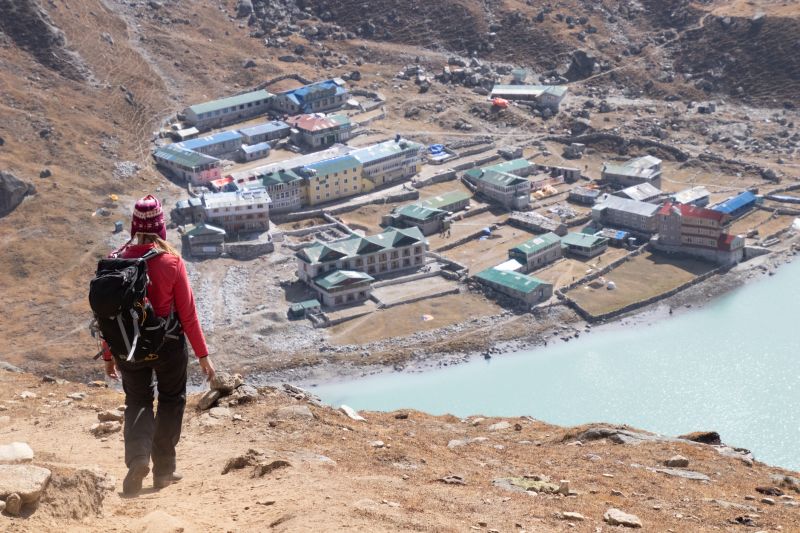
Looking back down towards Gokyo village
Today we tackle the third and final of the passes on our trek route! Renjo La (5,360 m) is not as high as the other two passes, and you might even see some locals with their yaks using the path. It's a very quiet pass in terms of trekkers.
To start, we leave Gokyo behind as we head west by walking along the northern shore of the lake. As we begin our climb up the pass, the view back to Gokyo and Ngozumpa Glacier is gorgeous, and just gets better the higher we climb. The terrain up Renjo La is rocky and uneven, making it another good day for trekking poles.

View of Everest from Renjo La
Needless to say, the views to both the east and the west upon summiting Renjo La are incredibly rewarding!
Descending the western side of the pass is a much steeper affair than its ascent. We head to Marulung for the night. This is one of relatively few settlements in this neck of the woods, as we're now trekking through a more sparsely populated section of Sagarmatha.
Day 16 – Trek to Namche Bazaar
- Starting point: Marulung (4,210 m / 13,810 ft)
- Hours trekking: 7-8 hours
- Highlight: Passing through Thame
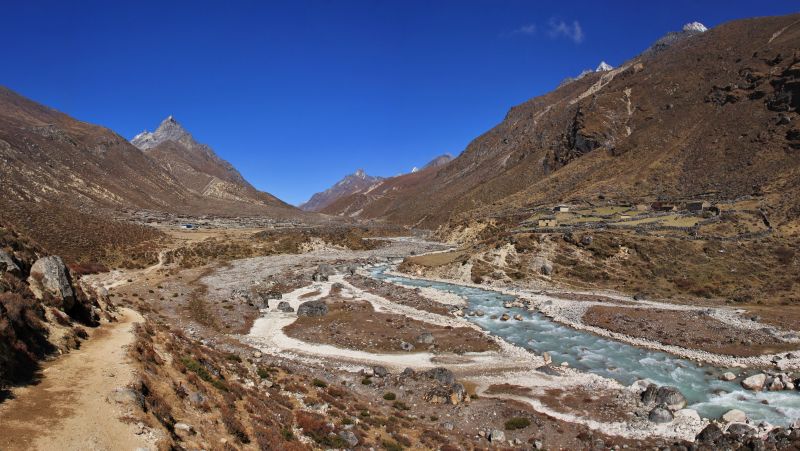
We spend much of today walking alongside the Bhote Kosi
Today we trek alongside the Bhote Kosi. The valley starts out very steep and then widens further on. It's a quiet valley that's not as affected by tourism as some of the others in the region.
We pass through the pretty village of Thame, which was once home to the famous Sherpa mountaineers Tenzing Norgay and Apa Sherpa. Thame Monastery above the village is a must-see if there's time.
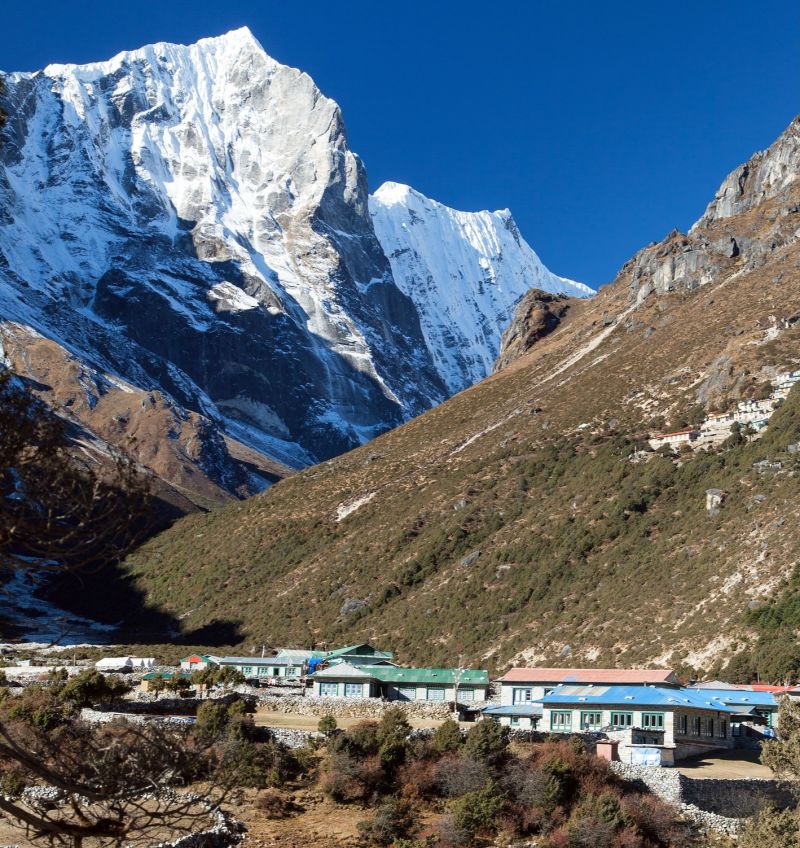
The village of Thame
We head back to Namche Bazaar, approaching it from the other direction to which we left it. The scenery is beautiful, as we walk a contour path along the northern bank of the Bhote Khosi, a tributary of the Dudh Khosi. Those who are lucky enough to be in Namche on a Saturday, can pay a visit to its market.
Day 17 – Trek to Lukla
- Overnight: Lukla (2,860 m / 9,383 ft)
- Distance trekked: 17.6 km / 10.7 mi
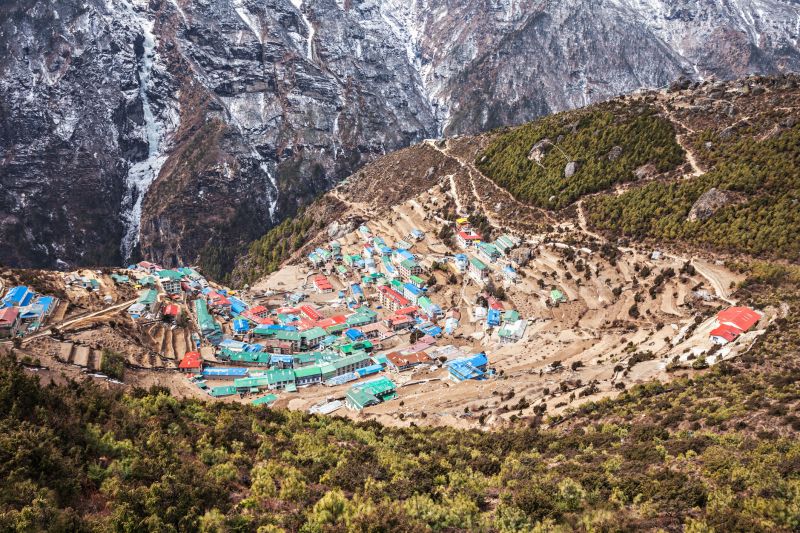
Namche Bazaar feels almost like a metropolis after the past few days' adventure
On the outward journey we travelled from Lukla to Namche Bazaar over two days, stopping over in Phakding for a night. On the return route, we cover the same distance in one day, our lungs drinking in all that oxygen-rich air!
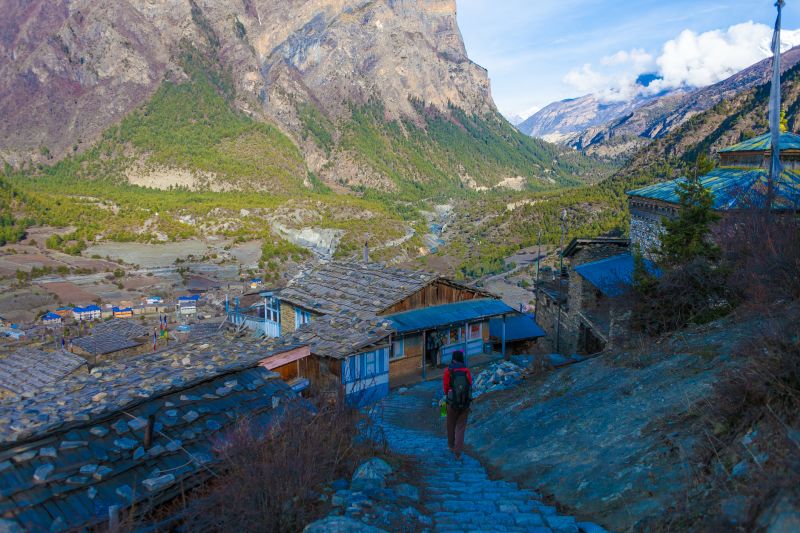
It's time to descend in altitude
Day 18 – Transfer to Kathmandu
- Flight: Lukla to Manthali Aiport (15 min)
- Drive: Ramechhap to Kathmandu (5 hr)
- Overnight: Thamel district, Kathmandu
This morning we fly to Manthali Airport. You can expect beautiful scenery en route! It's just possible on the odd occasion that we can get a flight straight to Kathmandu's Tribhuvan International Airport. But given the major construction going on at that airport at present, it's highly unlikely.
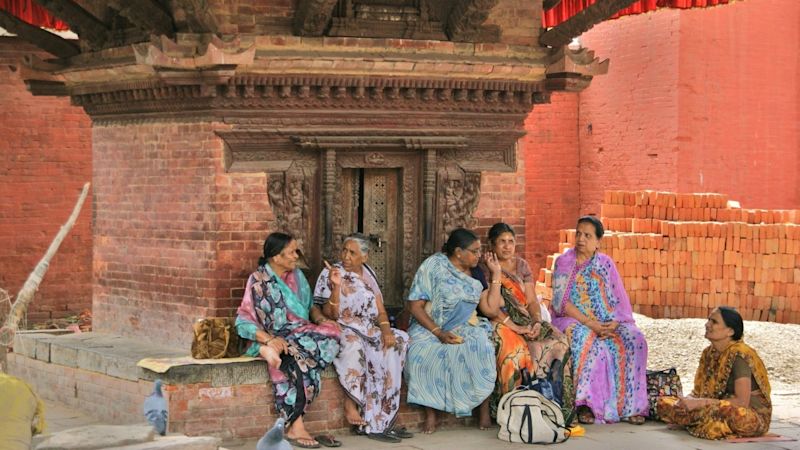
Women sitting in the shade of a shrine in Kathmandu
From Manthali in Ramechhap we drive to Kathmandu in our private vehicle, returning to the vibrant Thamel district.
Day 19 – Depart Kathmandu
Today is adieu and, hopefully, see you soon! We'll drive you to the airport, so no worries about logistics there.
That said, depending on your flight time, you could have a large chunk of the day to explore some more of Kathmandu – yay!
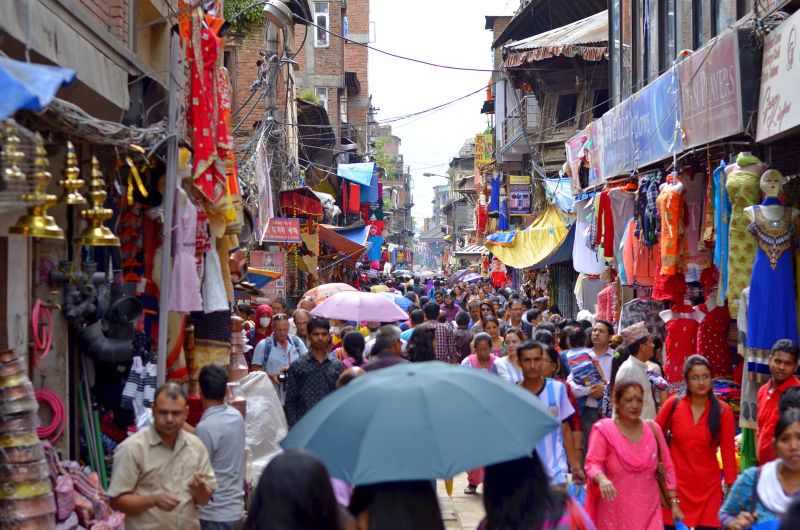
The streets of Thamel are a world away from the quiet and solitude of Sagarmatha!
One idea if you have time today before your flight is to go on the heritage walk from Thamel that takes you to places tourists don't always see, like old streets, temples and markets. You can also visit Kathmandu Durbar Square, which is a UNESCO site for its historic temples, palaces and palace courtyards.
You might also like to pay a visit to Swayambhunath (also referred to as Monkey Temple), just west of the city on a hilltop. This ancient religious complex is an extremely important pilgrimage site for Tibetan Buddhists. It contains a large stupa, several shrines and temples, a monastery, and a museum. The name swayambhunath means 'sublime trees', and yes, there are a variety of lovely trees all over the complex to enjoy.
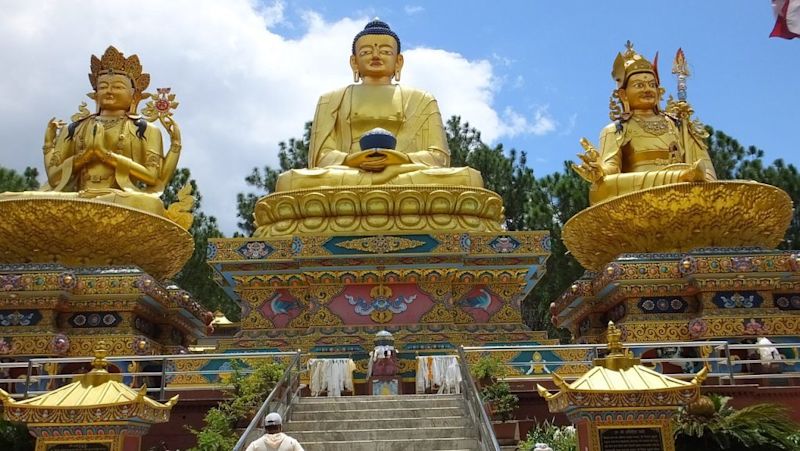
Three of the statues at the religious hilltop complex Swayambhunath
Something else you might like to consider is taking a cooking class at Nepal Cooking School . How awesome to go home and know how to reproduce a taste of the yummy Nepali food you've no doubt grown to love this past fortnight!
And that's the itinerary, folks!
If you loved reading about the Everest Base Camp and Three Passes trek but are a little uncertain about your own fitness to tackle it right now, why not take a look at the Annapurna Circuit ? It's a similarly spectacular multiday trek in Nepal, but just not quite as long and arduous. It could even be the perfect 'tester' for the EBC trek.
All that said, if you are feeling up to the challenge of the EBC and Three Passes trek, we'd love to chat and see if we can help you to make it happen! Just click on the contact button and drop us a line. 😀

EVEREST THREE PASSES TREK

EVEREST THREE PASSES

Pin Tweet Share WhatsApp
THE ESSENTIAL GUIDE
In this guide we cover everything you need to know about the Everest Three Passes Trek in Nepal. This includes a suggested itinerary and practical information about accommodation, costs, what to pack, independent vs. guided treks, transport, and more. We also offer a route map with GPX download for use on the trek. Along with this written guide, we share a ‘silent hiking’ film of the trail. And for detailed trail notes and information about services available along the route, check out our Everest Three Passes Trekking Route Guide .
The Three Passes is one of the most adventurous trekking routes in Nepal. The scenery is spectacular, and the trek itself is challenging and rewarding in equal measure. It pays to be physically well prepared for this demanding route, and as always when trekking at very high altitude, proper acclimatisation is key.
It’s worth noting that a Three Passes itinerary includes Everest Base Camp and Gokyo Lake, so if you’re thinking about one of these treks, you might consider incorporating all or part of this route into your own plans. Read on to discover more and start planning your own Everest Three Passes trek.
Use the links below to jump to each section of this guide
TREK OVERVIEW THREE PASSES FILM MAP & GPX DOWNLOAD ELEVATION PROFILE & 3D MAP SUGGESTED ITINERARY ALTERNATIVE ROUTE OPTIONS BUFFER DAYS CLOCKWISE OR ANTI-CLOCKWISE? BEST TREKKING SEASONS HOW TO GET TO LUKLA GET TO LUKLA WITHOUT FLYING EVEREST TREK PERMITS & FEES TREKKING INDEPENDENTLY TREKKING WITH A GUIDE
RECOMMENDED TREK AGENCY ACCOMMODATION ON THE TREK FOOD ON THREE PASSES TREK SAFE DRINKING WATER WIFI/PHONE SIGNAL/CHARGING THREE PASSES TREK COST MONEY & ATMs ON THE TREK WHAT TO PACK FOR THE TREK ALTITUDE AWARENESS TRAVEL INSURANCE GETTING TO NEPAL NEPAL TOURIST VISAS WHERE TO STAY IN KATHMANDU MAPS, GUIDEBOOKS & APPS
TREK OVERVIEW THREE PASSES FILM MAP & GPX DOWNLOAD ELEVATION PROFILE & 3D MAP SUGGESTED ITINERARY ALTERNATIVE ROUTE OPTIONS INCLUDING BUFFER DAYS CLOCKWISE OR ANTICLOCKWISE? BEST TREKKING SEASONS HOW TO GET TO LUKLA GET TO LUKLA WITHOUT FLYING EVEREST TREK PERMITS & FEES TREKKING INDEPENDENTLY TREKKING WITH A GUIDE RECOMMENDED TREK AGENCY ACCOMMODATION ON THE TREK FOOD ON THREE PASSES TREK SAFE DRINKING WATER WIFI/PHONE SIGNAL/CHARGING THREE PASSES TREK COST MONEY & ATMs ON THE TREK WHAT TO PACK FOR THE TREK ALTITUDE AWARENESS TRAVEL INSURANCE GETTING TO NEPAL NEPAL TOURIST VISAS WHERE TO STAY IN KATHMANDU MAPS, GUIDEBOOKS & APPS
*Some of the links in this post are affiliate links – if you purchase a product or service via these links, we may earn a small commission at no extra cost to you . This helps offset the cost of running this blog and keeps us travelling so that we can continue to produce great content for you. We greatly appreciate your support!*
EVEREST THREE PASSES TREK OVERVIEW
- DISTANCE | Approx 160 km (incl. acclimatisation/day hikes)
- DURATION | 17 – 22 days (incl. flying to/from Lukla)
- START/END | Lukla
- PERMITS REQUIRED | Khumbu Trek Card 2000 NPR; Sagarmatha National Park Fee 3000 NPR (SAARC nationals 1500 NPR / Nepali nationals 100 NPR)
- TREKKING SEASON | Best Seasons: April to Mid-May , October to Mid-November ; Shoulder Seasons: March, Late May, September, Mid-November to December ; Avoid: June to August, January to February
- TREK DIFFICULTY | Challenging
- ELEVATION GAIN/LOSS | +/- approx 13500 metres (incl. acclimatisation/day hikes)
- MAX ALTITUDE | 5611 m (Kala Patthar) or 5514 m (Kongma La)
- GUIDE MANDATORY? | Khumbu Pasanglhamu Rural Municipality has stated that it is NOT mandatory to trek with a guide in the Khumbu region
- ACCOMMODATION | Teahouses/Guesthouses in villages along the trail
- TREK COST | $34 – $140 USD per person, per day (budget independent trekker to fully inclusive package)
- RECOMMENDED TREKKING AGENCY | Himalayan Masters , Quote HOGG5 for 5% discount
DISTANCE Approx 160 km (incl. acclimatisation/day hikes)
DURATION 17 – 22 days (incl. flying to/from Lukla)
START/END Lukla
PERMITS REQUIRED Khumbu Trek Card 2000 NPR Sagarmatha National Park Fee 3000 NPR (SAARC nationals 1500 NPR, Nepali nationals 100 NPR)
TREKKING SEASON Best Season April to Mid-May October to Mid-November Shoulder Seasons March, Late May, September Mid-November to December Months To Avoid June, July, August January and February
TREK DIFFICULTY Challenging
ELEVATION GAIN/LOSS +/- approx 13500 metres (incl. acclimatisation/day hikes)
MAX ALTITUDE 5611 m (Kala Patthar) or 5514 m (Kongma La)
GUIDE MANDATORY? Khumbu Pasanglhamu Rural Municipality has stated that it is NOT mandatory to trek with a guide in the Khumbu region
ACCOMMODATION Teahouses/Guesthouses in villages along the trail
TREK COST $34 – $140 USD per person, per day (budget independent trekker to fully inclusive package)
OUR RECOMMENDED TREKKING AGENCY Himalayan Masters , Quote HOGG5 for 5% discount
EVEREST THREE PASSES TREKKING FILM
Get a sense of the Everest Three Passes trekking route in our ‘silent hiking’ style ambient film.
Watch the behind the scenes version of our Everest Three Passes trek on Instagram stories
Watch the behind the scenes version of our three passes trek on instagram stories .
Everest Three Passes Trek Stories
EVEREST THREE PASSES TREK MAP & GPX DOWNLOAD
Everest three passes trek //.
MAP & GPX DOWNLOAD
We have created a detailed Everest Three Passes digital trekking map to accompany this guide. The full trekking route is marked, including Everest Base Camp and Gokyo Lakes, along with day hikes around Namche Bazaar and Gokyo, and to Nangkartshang, Chukhung Ri, Kala Patthar, and Gokyo Ri. Alternative routes avoiding the passes are also marked, as is the overland route between Salleri and Lukla.
Detailed stats and an elevation profile are included for each route section. Guesthouse settlements and tea shops are also marked, as well as key sights and practical info such as checkpoints, hospitals, and transport hubs. Guesthouses as per our own trek itinerary are marked, including info about prices and services, phone numbers (where possible), and a copy of the menu. Photos are included with almost every pin.
You can use the digital map online, or download it for offline use with a mapping app such as Organic Maps, Maps.me or Gaia GPS. This is very helpful for navigation assistance on the trail. It allows you to quickly pinpoint key places and services along the way and calculate distances and elevation differences between destinations.
Note that while we’ve tried to be as accurate as possible when recording and mapping the route, changes on the ground are inevitable (especially on routes crossing glaciers) and this map should not be solely relied upon for navigation.
EVEREST THREE PASSES TREK ELEVATION PROFILE
ELEVATION PROFILE
The image below shows the elevation profile of the Everest Three Passes trek, starting and ending in Lukla and going in an anti-clockwise direction, crossing Kongma La first, Cho La second, and Renjo La third. The route shown here includes the various acclimatisation and side hikes as outlined in our Three Passes Route Guide . Elevation is displayed in metres and distance in kilometres.

3D ROUTE MAP
Watch our 3D relief map video of the route to visualise the landscape and get a sense of the Everest Three Passes trek.
EVEREST THREE PASSES TREK ITINERARY
We have outlined what we feel is an ideal Everest Three Passes trekking itinerary in the table below. This is a 19 day itinerary which includes flying to and from Lukla, and although not mentioned in the table, we assume that you will fly to Lukla on the morning of Day 1 (see this section for details). We have noted the trekking distance and an approximate trekking time for each day (excluding lunch stops, breaks, etc), as well as stats on elevation gain/loss and sleeping altitude. Below the table, we have outlined a few alternative route options which you may wish to consider for your own itinerary.
Note that this itinerary outlines an anti-clockwise trekking route, crossing Kongma La first, and Renjo La last. You can read more about our thoughts on why this is the best direction to trek the Everest Three Passes route in the ‘Is it best to do the Everest Three Passes trek clockwise or anti-clockwise?’ section below.
If viewing on a mobile device or tablet, scroll to the right to see the full table or flip your screen to landscape mode
*It is common to sleep two nights in Namche Bazaar to allow for proper acclimatisation. There are some different options for acclimatisation day hikes around the area ( outlined here in our Everest Three Passes Route Guide ) that you can choose to suit your own interests, fitness and energy levels.
**There are two viewpoints on the Chukhung Ri acclimatisation hike, the lower one (5380 m) which most people visit and the higher one (5516 m) which involves a tough and steep climb towards the end (both are outlined here in our Three Passes Route Guide )
***On days 10 and 11 the standard itinerary that most people follow is to visit EBC after lunch at Gorak Shep, then hike up Kala Patthar in the dark for sunrise the next morning (when it is bitterly cold). If you swap these two around as per the above suggested itinerary, you are guaranteed to have a less busy experience at both EBC and on the trail up Kala Patthar. As the skies are usually clearer in the morning you are also likely to have better views at EBC, however it is possible that the views from Kala Patthar will be obscured by afternoon clouds. If you’re lucky and have clear afternoon skies, then you will be treated to a fiery sunset glow on Everest and the surrounding mountains. If you hike up Kala Patthar in the morning, your mountain views will be brief as the sun rises directly behind Everest and you’ll soon be looking directly into the sun.
ALTERNATIVE ROUTE OPTIONS
While the Everest Three Passes trek itinerary outlined above is an ideal option to follow, we do have some alternative route suggestions which you may wish to consider. Your speed, level of acclimatisation, timeframe, and numerous other factors will determine whether these alternatives might be suitable for you. Note that these suggestions are by no means an exhaustive list of route options – there are many villages and/or small teahouse settlements where you can stay instead of those suggested above or outlined below. Our map has all of the possible locations marked, and our Everest Three Passes Trekking Route Guide has info about the services available at each.
Khumjung (3770 m) is a sizeable local village with a secondary school and gompa, situated about 1.5 hours walk north of Namche Bazaar. There are a number of guesthouses in the village and the views are wonderful. If you would prefer to stay somewhere quieter than Namche Bazaar, and you are well acclimatised already, then continuing to Khumjung on Day 2 is a good option. Alternatively, you could opt to spend one night in Namche Bazaar on Day 2, then continue to Khumjung on Day 3. From Khumjung you can rejoin the trail at Sanasa on Day 4, so there is no need to return to Namche. Adding a night at Khumjung towards the end of your Everest Three Passes trek is also a possibility.
AMA DABLAM BASE CAMP
It’s essential to acclimatise properly prior to crossing your first pass, which is why acclimatisation hikes are built into every Everest Three Passes trek itinerary. This involves sleeping at the same altitude for two nights while climbing to a higher altitude during the day. You’ll do this at Namche Bazaar, and twice more before crossing Kongma La. Usually this is at Dingboche (climbing to Nangkartshang and back), and at Chukhung (climbing to Chukhung Ri and back).
If you would like to add an additional acclimatisation hike into your itinerary, a day hike to Ama Dablam Base Camp while spending two nights at Pangboche is a good option. You’ll trek to around 4580 m (~ 6 hours return trekking time) before returning to sleep at Pangboche (3950 m) and continuing to Dingboche (4300 m) the following day. You could continue to Dingboche the same day, but only if you are prepared to trek for around 9 hours that day.

Morning view of Ama Dablam (6812 m) from Pangboche (3950 m), moments before sunrise

HOW TO CUT ONE DAY OFF THIS ITINERARY
If you are on a tight schedule and want to cut a day off this itinerary, the best option is to combine Days 11 and 12, continuing to Dzonglha on Day 11 instead of overnighting at Lobuche for a second time. The section between Lobuche and Dzonglha is not too far and the elevation gain/loss is quite minimal, only adding around 2.5 hours trekking time to your day.
Just be aware that it can be quite tiring to continue all the way to Dzonglha after a big couple of days with early starts at high altitude, plus you will have less time to explore Everest Base Camp in the morning, which is why we suggest splitting this section over two days. This was our original plan, however we did end up walking all the way to Dzonglha in order to cross Cho La a day earlier than planned due to forecasted snow.
Another option is to combine Days 13 and 14, continuing all the way to Gokyo after crossing Cho La, instead of overnighting at Dragnag (Thagnak/Thangnak). While the distance isn’t great (only 3.7 km) it takes around 3 hours as you must cross the Ngozumpa Glacier, with plenty of up and down, and some steep sections as you descend to and ascend from the glacier. Many people plan to continue to Gokyo but find they don’t have the energy or time once reaching Dragnag. This is why we suggest tackling the Dzonglha to Gokyo section over two days instead of one, but it’s good to know the option is there should energy levels and conditions on the day allow you to continue all the way to Gokyo.

It’s a short distance between Dragnag and Gokyo but you must cross Ngozumpa Glacier, made more tricky after fresh snowfall

EXTRA NIGHT AT GOKYO
If you are not too constrained by time, it’s a great idea to add an extra night at Gokyo, staying 3 nights instead of 2. The setting is beautiful, and you have the option of doing a couple of different side hikes, to Gokyo 4th and 5th lakes and beyond as far as Cho Oyu Base Camp, as well as the usual climb to Gokyo Ri. Adding an additional night at Gokyo will give you plenty of time to do the various hikes in the morning (when the weather is usually clearest) and plenty of rest time in the afternoon.

There is wide selection of guesthouses at Gokyo and the setting is beautiful

ALTERNATIVE ITINERARY AFTER RENJO LA
It’s common to stop for the night at Lungden after crossing Renjo La, however in this itinerary we suggest continuing down the valley to Thame, which is a further 9.7 km and takes around 2.5 – 3 hours, although it’s mostly downhill.
We suggest this for a few reasons. Firstly, Thame is a very attractive village with some comfortable guesthouses and is a nice place to spend the night. Lungden, by comparison, is a much smaller teahouse settlement with just a couple of basic guesthouses. Also, after 11+ days spent at altitudes over 4000 m, it is a great feeling to drop down to Thame (3790 m) instead of remaining at Lungden (4366 m). It is warmer, you can breathe easier and be surrounded by trees again, and the guesthouses at Thame offer better facilities like hot showers. Continuing onto Thame also makes the last couple of days a bit shorter, allowing you to avoid two back-to-back 18 km days with a significant amount of up and down.

First sight of Thame (3800 m), a most welcome one after so many days trekking at altitudes above 4000 m

If the distance, trekking time, and energy required is too much for you, it’s certainly possible to stop at Lungden for the night instead. This would mean trekking from Lungden to Namche Bazaar (17.8 km) on Day 17 and from Namche Bazaar to Lukla (18 km) on Day 18, or adding in an extra night somewhere of your choice to break up the distance over 3 days instead of 2.
THE IMPORTANCE OF BUFFER DAYS
Building in buffer days to your Everest Three Passes itinerary is highly recommended, especially if you plan on flying to/from Lukla. Flights are regularly cancelled due to poor weather conditions, sometimes for a number of days. If everything runs smoothly, it takes half a day or less to get to/from Lukla at the start/end of your trek. However, if flights are not operating, it can take up to 3 days to travel overland from Kathmandu to Lukla, using a mixture of buses and jeeps, and by trekking too. Therefore, it’s wise to have at least 3 or 4 days between the end of your planned trek itinerary and any international flight. This would allow you time to get from Lukla to Kathmandu overland if necessary.
Of course, a delay could also happen at the start of your trek while trying to get to Lukla, and this might leave you struggling to catch up with your original itinerary. Having a couple of buffer days built in will mean you don’t have to drastically alter your itinerary, avoiding the need to walk extra long distances to save a day or skipping places because you don’t have time.
Buffer days also allow you to alter your itinerary on the go more easily. For example, if you get sick and need to spend an extra night somewhere, or the weather is bad and it’s safer to wait a day before crossing one of the high passes, then you have the extra days on hand.

Having buffer days built in to your itinerary gives you the opportunity to avoid trekking in weather like this

It’s worth knowing that should everything go to plan and you don’t need to use any buffer days during your trek, it’s straightforward for a trekking agency to change the date of your flight, bringing it forward a few days for example. However, this is not so easy if you have booked your flight online, independently.
On our own Everest Three Passes trek we allowed for up to 22 days, from Kathmandu back to Kathmandu, but in the end our itinerary was just 17 days.
OUR RECOMMENDED TREKKING AGENCY
We partnered with Himalayan Masters for our Langtang Valley, Gosainkunda, and Everest Three Passes treks, and found them to be very professional and committed to a high level of service
To enquire about booking your own trek, get in touch via email at [email protected] and mention the code HOGG5 to get a 5% discount off the cost of your trip
TREK THE EVEREST THREE PASSES CLOCKWISE OR ANTI-CLOCKWISE?
CLOCKWISE OR ANTI-CLOCKWISE?
The Everest Three Passes trek is a lollipop-shaped trek. The ‘stick’ is the section between Lukla and Namche Bazaar (which you will hike at both the start and end of the trek), while the ‘lolli’ is the loop from Namche to Namche, crossing the three passes and forming the main part of the trek. It is possible to trek this loop section clockwise (crossing Renjo La first) or anti-clockwise/counter-clockwise (crossing Kongma La first). We would highly recommend trekking the Everest Three Passes route anti-clockwise , for the reasons outlined below.
ACCLIMATISATION
The primary reason for tackling the Three Passes trek in an anti-clockwise direction is to allow for proper acclimatisation . By aiming to cross Kongma La first, you can ascend to high altitude at a sensible rate and incorporate at least two acclimatisation hikes into your itinerary. This greatly minimises your chance of suffering from Acute Mountain Sickness (AMS, also known as altitude sickness), or developing the life-threatening conditions of HACE or HAPE.
Trekking the Everest Three Passes route in a clockwise direction, crossing Renjo La first, offers limited opportunities for acclimatisation hikes and requires a much bigger jump in elevation over a shorter period of time. This puts you at much greater risk of developing AMS (or worse, HACE or HAPE), and as such your chances of successfully and safely completing the trek are lower.
We cover more about acclimatisation, safe ascent rates, and AMS in the ‘Altitude Awareness and AMS’ section below.

Doing the acclimatisation hike on Nangkartshang is one of the benefits of trekking the Three Passes in an anti-clockwise direction

ELEVATION GAIN
In addition to the huge benefits of proper acclimatisation, tackling the Everest Three Passes trek in an anti-clockwise direction is easier with regards to elevation gain. Put simply, you will have to climb less when crossing Cho La and Renjo La if trekking anti-clockwise rather than clockwise, making it easier. You will have to climb 130 metres more when crossing Kongma La anti-clockwise, however this ascent is on a good trail for most of the way to the pass, whereas the ascent to Kongma La from Lobuche, although having less elevation to climb, is steep, rocky, and energy sapping.
Crossing Renjo La in a clockwise direction is especially strenuous, requiring you to climb an additional 400 metres as compared to crossing it in an anti-clockwise direction, from Gokyo.

People trekking clockwise climb steeply on the final section before Cho La (5368 m)

CONTINGENCY PLANS
Another reason to trek the Three Passes in an anti-clockwise direction is that there is a better ‘Plan B’ option should you be unable to cross Renjo La (due to heavy snow for example). If you approach Renjo La in a clockwise direction (aiming to cross this pass first) but find that you can’t, it’s a big detour all the way back down to Namche and then up the Dudh Koshi Nadi Valley to rejoin the route at Gokyo (approx 2.5 days trekking). However, if you find you are unable to cross Renjo La while trekking in an anti-clockwise direction, you would just skip the pass and trek down the Dudh Koshi Nadi Valley to Namche (1 day), then continue on to end at Lukla.
For Cho La and Kongma La, in terms of contingency plans it doesn’t make a big difference whether you are trekking clockwise or anti-clockwise, as the alternative routes are similar either way.
THE BEST VIEWS
We’ve heard a few people say and read various comments online suggesting that it’s best to trek the Everest Three Passes route in a clockwise direction, because that way you’ll have the best views. Personally, we wouldn’t consider this a good enough reason to opt for trekking the route clockwise. We feel that the views are incredible looking either way, and of course, you’re always free to stop and look around. And you won’t be enjoying any views at all if you are struggling with AMS because your chosen route hasn’t allowed for proper acclimatisation, a very real concern if trekking clockwise.
SEE MORE FROM NEPAL

Everest Base Camp Trek: The Essential Guide

Everest Three Passes Trekking Route Guide

Everest Three Passes Trek: The Essential Guide

Gosainkunda Helambu Trekking Route Guide

Gosainkunda Trek: The Essential Guide

Langtang Valley Trekking Route Guide

Langtang Valley Trek: The Essential Guide

What To Pack For Trekking In Nepal

Upper Mustang Trek: The Essential Guide

Upper Mustang Trek Itinerary: A Day By Day Account

Annapurna Circuit Trek: The Essential Guide

Annapurna Circuit Trek Itinerary: A Day By Day Account

Manaslu Circuit Trek: The Essential Guide

Manaslu Circuit Trek Itinerary: A Day By Day Account
Everest three passes trekking season.
TREKKING SEASON
Like many treks in Nepal , the peak seasons for trekking the Everest Three Passes route are April to mid-May and October to mid-November . These months typically offer the best chance of both clear skies and warmer temperatures, although weather patterns are becoming increasingly unpredictable in Nepal and across the world, so you should still be prepared for snow and colder temperatures during these periods.
The spring trekking season coincides with the Everest climbing season , so the Khumbu region is very busy with helicopters and yaks transporting supplies to Everest Base Camp . If trekking at this time, you will have the chance to see base camp fully set up with all the tents, and there is a great buzz about the place. Outside of the climbing season, there are no tents or any other infrastructure at EBC.

A spring morning at Everest Base Camp, the place fully set up for the climbing season

In autumn, expect less wind and higher temperatures than in spring, while in late March and April, blooming rhododendrons and other spring flowers are a beautiful sight at some lower elevations.
The shoulder seasons are March, May, September and mid-November to December. During these times it can be much quieter on the trail. There is typically cold weather in March and December. In March there is a high chance of lingering or fresh snow. December typically has sunny weather and clear skies throughout the day. In late May and early September there is a higher chance of early or lingering monsoon rains and cloudy skies.
The winter months of January and February are considered too cold by most to trek and many guesthouses are closed.
PLAN A TREK IN THE LANGTANG VALLEY

PLAN YOUR LANGTANG VALLEY TREK WITH OUR COMPLETE GUIDE

DETAILED TRAIL NOTES AND OTHER INFO FOR THE LANGTANG TREK
HOW TO GET TO LUKLA
Lukla is the gateway for all treks in the Khumbu region, including Everest Three Passes, Everest Base Camp , and Gokyo Lakes. Nestled in the mountains at 2855 m, the closest dirt-road access is approximately 1 day’s walk away, with a tarmac road 3+ days’ walk away. The majority of people arrive in Lukla by air, landing at the small runway or helicopter pad at Tenzing-Hillary Airport (LUA). If you prefer not to fly, it’s possible to get to Lukla overland in 3+ days, by taking a bus/jeep then trekking on foot.
FLYING TO LUKLA
Flights to Lukla operate year-round from either Kathmandu or Ramechhap/Manthali (approx 4 hours’ drive from Kathmandu), although cancellations and delays are common as flights can only run in favourable weather conditions. The flight time is 30 minutes from Kathmandu, and 15 minutes from Ramechhap/Manthali. The Lukla runway is just 527 metres long and is sloped at an 11.7% gradient, making taking off and landing challenging for pilots and a little daunting for passengers.
Flights are operated by Tara (Yeti) Air , Summit Air , and Sita Air , with each company using small 15 seater twin propeller planes . Flights usually only operate in the morning, when the skies are clearer and there is less wind. There is a weight limit of 10 kg checked baggage + 5 kg hand baggage . The cabin is not pressurised and it’s very noisy. There are no assigned seats. For the best mountain views, try to sit on the left while flying to Lukla and the right on the return flight.
During peak trekking and climbing seasons , Lukla flights operate to and from Ramechhap/Manthali in order to ease congestion at Kathmandu Airport. The dates change annually, but this is roughly April 1st – May 20th and September 20th – November 20th . See below for how to get from Kathmandu to Ramechhap/Manthali.

The runway at the Tenzing-Hillary Airport in Lukla, sloped at an 11.7% gradient and just 527 metres long

The runway at Tenzing-Hillary Airport in Lukla, on an 11.7% gradient and just 527 metres long
Flight tickets cost $180 one way from Kathmandu and $152 one way from Ramechhap/Manthali . You can book online directly with the airline, or via an agency in Kathmandu. If you are booking an inclusive trekking package, for example with our recommended local trekking agency Himalayan Masters , your flight will be organised for you. Booking the earliest possible flight time is best as clouds tend to move in and the wind picks up through the morning, with later flights more likely to be cancelled. Note that agencies sometimes have access to earlier flights than are available to book online.
It is free of charge to change your flight date (in advance by calling the airline or in person at the airport) and it’s a good idea to reconfirm the day before you fly to avoid being bumped onto a later flight. Again, if you have booked through a trekking agency, they can take care of any flight changes and reconfirmations for you. This makes the whole process much more straightforward than if you have booked independently (especially if you’re trying to make changes while trekking with limited phone service or internet connection).
Be aware that it can be a bit chaotic at the airport and being bumped onto a different flight time and/or standing around confused about what’s happening is pretty normal. The situation is certainly easier to manage if you are with a guide, who will be used to the process, speaks the local language, and will take care of everything for you.
FLYING TO PHAPLU/SALLERI
Sometimes when flights can’t depart for Lukla, there is an option to fly to Phaplu (2 km north of Salleri) instead. From Phaplu it’s possible to trek to Lukla in about 3 days, or you can take a jeep as far as Thamdada (subject to road conditions) and trek the remaining distance to Lukla in 1 day.
See stages 2 and 3 in the ‘how to get to Lukla without flying’ section below for more details.
HOW TO GET FROM KATHMANDU TO RAMECHHAP AIRPORT (MANTHALI)
You can get from Kathmandu to Ramechhap Airport (RHP) (also known as Manthali) by public bus, shuttle bus, or private car. The journey takes around 4 hours.
Public buses depart between approx 0600 – 1100 from Ratna Park (also known as Old Bus Park) near Thamel, costing approx 600 NPR ($4.50 USD). The journey takes around 4 – 5 hours. You will need to spend one night at a guesthouse in Manthali before flying to Lukla the following morning. There are guesthouses within walking distance of Ramechhap Airport. You can just show up and buy a bus ticket on the day. Buses arrive at the Manthali Bus Park .
Shuttle buses depart from the Thamel area of Kathmandu at 0130 and 0200, allowing you to fly to Lukla the same morning. They also depart at 1100, if you prefer to travel during the day and spend one night in Manthali before flying to Lukla. The journey takes about 4 hours. You must make a reservation in advance. You can do this via a local agency, ask staff at your accommodation to help, or book online via Viator or Get Your Guide . Tickets cost up to $30 USD.
A private car costs approx 14000 NPR ($100 USD), which can be shared by up to 4 passengers. The road condition does not require a jeep/4×4 vehicle. The journey takes about 4 hours, with door-to-door service. You can book a private car via a local agency or ask staff at your accommodation to help organise it.
For the return journey from Ramechhap/Manthali to Kathmandu you must pre-arrange your shuttle transfer or private car transfer. If travelling back to Kathmandu by public bus, you should be able to get one from the Manthali Bus Park after arriving on the flight from Lukla.
HELICOPTER TO LUKLA
It is also possible to fly from Kathmandu to Lukla by helicopter. Helicopters can often fly in weather conditions that would ground twin propellor planes, they are generally considered safer, and they operate out of Kathmandu Airport year-round (unlike planes which only depart from Ramechhap/Manthali during peak season). Flying by helicopter is considerably more expensive though, costing around $500 USD one way per person (assuming there are enough people to fill five seats). You can book via a local travel or trekking agency, or book online in advance via Viator .

Morning mountain vistas on the helicopter ride

HOW TO GET TO LUKLA WITHOUT FLYING
It’s possible to get to Lukla without flying by using a combination of bus and/or jeep and trekking. This takes 3 – 5 days. Eventually there will be a road built all the way to Lukla, but for now the closest you can possibly get by jeep on a dirt road is Thamdada (1 day walk to Lukla), and by bus or jeep on a sealed road is Salleri/Phaplu (3 – 4 days’ walk to Lukla). Buses and jeeps stop for food and toilet breaks along the way. As the road between Salleri/Phaplu and Thamdada is unsealed, its condition can vary greatly depending on how much rain there has been. Sometimes it’s not possible to drive all the way to Thamdada, and you may only be able to reach Bupsa, Kharikhola, or Adderi.
Although it may be possible to get all the way from Kathmandu to Thamdada in one day, we do not recommend this as it means travelling on a dirt road with challenging hairpin bends and steep sections in the dark. Instead, it’s advisable to spend one night in Salleri where there are lots of guesthouses and travel to Thamdada the following day. At Thamdada, there is a guesthouse (Kare Hotel) at the jeep stop and two more approximately 25 minutes’ walk from the jeep stop. Additionally, there are many more guesthouses at Paiyu, which is around 2 hours’ walk away. It’s also possible to stop shortly before Thamdada to stay at a guesthouse in Kare (approx 1 hours’ walk to Thamdada).
The trekking route from Salleri to Lukla goes via Ringmu, Nunthala, Kharikhola, Bupsa, Kari La (Thamdada), Paiyu and Surke. Common overnight stops are at Nunthala, Bupsa, and Surke, after which you join the classic Lukla (or Cheplung) to Namche Bazaar route. There is a lot of elevation gain and loss on the Salleri to Lukla trekking route, so expect plenty of tiring up and down. The driving route from Salleri to Thamdada goes via Adderi and joins the trekking route shortly before Kharikhola.
KATHMANDU TO LUKLA OVERLAND STAGES
Step 1 // drive kathmandu to salleri/phaplu.
9 – 12 hours travel time (mostly sealed road); Phaplu is about 2 km north of Salleri
B us is approx 1700 NPR ($13 USD); departs from Chabahil Chowk (approx 0430) or from Koteshwor Chowk (approx 0500); no advance booking required
Shared Jeep is approx 2600 NPR ($20 USD) per person; d eparts from Chabahil Chowk and Koteshwor Chowk ( approx 0500); b est to reserve seat in advance (ask local travel agency or accommodation staff)
Private Jeep is approx $280 (can be shared between up to 7 people); d oor-to-door service, depart any time in morning; b ook via a local travel/trekking agency
STEP 2 // DRIVE SALLERI/PHAPLU TO THAMDADA (or Bupsa, Kharikhola, Adderi or elsewhere depending on road condition)
6 – 7 hours travel time (unsealed road)
Shared Jeep is approx 2600 NPR ($20 USD) per person; d eparts approx 0600; b est to reserve seat in advance; (ask your accommodation owner to book when you arrive in Salleri)
Private Jeep is approx $235 (can be shared between up to 7 people); d oor-to-door service, depart any time in the morning; b ook in advance in Kathmandu via a local travel/trekking agency
STEP 3 // TREK THAMDADA TO LUKLA OR CHEPLUNG
You can bypass Lukla itself and join the trail to Namche at Cheplung instead (you can get your Khumbu Trek Card from the checkpoint at Toc Toc as you will not pass the checkpoint at Lukla). There is a lot of up and down on this section. It is possible to cover the distance over two days if you prefer, staying at a guesthouse along the way (for example at Chheubas or Surke). The route and villages/guesthouses along the way are marked on our map .
To Lukla: 13.3 km | approx 7 hours trekking time | +1870 m / – 1744 m
To Cheplung: 13.9 km | approx 7 hours trekking time | +1785 m / – 1825 m
EVEREST THREE PASSES TREK PERMIT AND FEES
PERMIT AND FEES
For the Everest Three Passes trek, including Everest Base Camp and Gokyo Lakes, you need two permits. Both are issued locally in the Khumbu region so you don’t need to organise permits in advance in Kathmandu. You will need your passport and the fee in cash in Nepalese rupees.
Keep your permits in a safe place as you will need to show them at various checkpoints during the trek.
KHUMBU TREK CARD
Issued at checkpoint (Lukla or Toc Toc)
C an register in advance online (not mandatory)
SAGARMATHA NATIONAL PARK FEE
(1500 NPR SAARC nationals/ 100 NPR Nepali nationals)
Pay at checkpoint in Lukla or NP entrance beyond Monjo
TREKKING EVEREST THREE PASSES INDEPENDENTLY
TREKKING INDEPENDENTLY
The Nepal Tourism Board announced on March 9th 2023 that as of April 1st 2023, all international trekkers in Nepal are required to hire a licenced trekking guide and obtain the TIMS card through an authorised trekking agency registered with the government of Nepal.
However, the Khumbu Pasanglhamu Rural Municipality has confirmed that it is NOT mandatory to trek with a guide in the Khumbu region. This means that you do not need to have a guide for the Everest Three Passes trek , or for the treks to Everest Base Camp and Gokyo Lakes. We have included copies of the official press release from April 2nd 2023 and an info card from September 2023 stating that a guide is not mandatory in the Khumbu region. You can check the Khumbu Pasanglhamu Rural Municipality Facebook page for any further updates.

SHOULD YOU DO THE THREE PASSES TREK WITHOUT A GUIDE?
While trekking with a guide in the Khumbu region is not mandatory, this does not mean that doing the Everest Three Passes trek independently is the right decision for you. It is one of the most challenging treks in Nepal with multiple days spent at very high altitude . It passes through some remote areas with significant distances between teahouses, and crosses three high mountain passes above 5350 m.
In our opinion, you should only consider tackling the Everest Three Passes trek without a guide if you are an experienced high altitude hiker . If you plan to trek solo, it is wise to join with other trekkers you meet on the trail for any particularly challenging sections, such as crossing each of the three passes. We would also recommend carrying an emergency communication device such as a Garmin inReach .
PROS AND CONS OF INDEPENDENT TREKKING
If you are thinking about doing the Everest Three Passes trek without a guide, here are a few thoughts on the pros and cons of independent trekking in Nepal.
This is the cheapest way to trek the Everest Three Passes. You won’t have to pay for anything extra beyond your daily food and accommodation costs, permit fee, and transport to/from the trailhead.
You have complete freedom and flexibility. You can choose how long to trek for each day, what route to take and where to stay. If you like somewhere, you can choose to stay an extra day without having to consult anyone else or consider their needs.
It is easier to enjoy a bit of ‘alone time’ on the trail. If you are trekking with a guide or group it can be harder or more awkward to branch out and enjoy walking alone with your thoughts.
You’ll likely have more interaction with locals. If you are trekking with a guide it is common practice for them to deal with everything at your guesthouse and act as a go-between. It’s normal for your guide to take your order, bring out your food, and settle up the bill on your behalf, which means you may have little interaction with the owner or staff yourself. But, you’ll be doing all that by yourself if you trek independently.
With freedom and flexibility comes more responsibility and the need to do more research, preparation and daily planning. You will need to spend time organising things both on and off the trail. You will need to sort out all the logistics like your permit, transport, and accommodation by yourself, and be confident in your route planning and navigation.
You are more vulnerable in an emergency situation or if you get sick. This is especially true if you are trekking solo. You should prepare as best you can with a comprehensive medical kit, emergency contact numbers at the ready, and ideally an emergency communication device like the Garmin inReach . You should link up with other trekkers for particularly challenging and remote sections, such as crossing each of the high passes.
In peak trekking season you may find it harder to get a room. Many guesthouses prefer bigger groups with organised companies and will give preference to them over independent solo trekkers or those in small groups. Guides with existing local contacts often call ahead to book rooms, something which isn’t as easy for independent trekkers with no personal contacts.
You miss out on all the insights a knowledgeable, English speaking guide can offer. Your understanding of the region, and Nepal in general, is likely to be much broader after spending nearly three weeks in the company of a Nepali guide rather than going it alone.
This is the cheapest way to trek the Everest Three Passes. You won’t have to pay for anything extra beyond your daily food and accommodation costs, permit fee, and transport to/from the trailhead.
You have complete freedom and flexibility. You can choose how long to trek for each day, what route to take and where to stay. If you like somewhere, you can choose to stay an extra day without having to consult anyone else or consider their needs.
It is easier to enjoy a bit of ‘alone time’ on the trail. If you are trekking with a guide or group it can be harder or more awkward to branch out and enjoy walking alone with your thoughts.
You are more vulnerable in an emergency situation or if you get sick. This is especially true if you are trekking solo. You should prepare as best you can with a comprehensive medical kit, emergency contact numbers at the ready, and ideally an emergency communication device like the Garmin inReach . You should link up with other trekkers for particularly challenging and remote sections, such as crossing each of the high passes.
TREKKING EVEREST THREE PASSES WITH A GUIDE (AND PORTER)
TREKKING WITH A GUIDE (AND PORTER)
Although not mandatory, many people choose to do the Everest Three Passes trek with a guide, and often with a porter too. If you are an inexperienced high altitude trekker we would absolutely recommend hiring a guide for this trek, but even if you are experienced, trekking with a guide is a great option. Not only can a guide be invaluable when it comes to your safety, a guide can also enrich your experience on the trail, giving you the opportunity to learn more about the history, culture, and geography of the land. Hiring a porter to carry your bag will put less strain on your body, making your trek much easier and perhaps allowing you to better enjoy the surroundings. Hiring a guide and/or porter also provides jobs and supports the trekking tourism economy.
One guide can accompany a maximum of five trekkers. A porter shouldn’t be asked to carry more than 25 kg, ideally no more than 20 kg. If you pack appropriately, one porter can carry two trekkers’ bags. Ensure that your guide and porter have appropriate clothing and equipment for the trail, including warm clothing for high altitudes (a down jacket, hat, gloves), boots, sunglasses, and waterproofs.
WHAT TO EXPECT WHEN TREKKING WITH A GUIDE
If you are doing the Everest Three Passes trek with a guide you may meet them in either Kathmandu or Lukla. If you meet in Kathmandu, you will travel to the trailhead together and return to Kathmandu together at the end. Professional guides in Nepal are both licenced and insured, and will speak English (sometimes other languages too).
During your trek a guide will walk with you on the trail, suggest the best spots to stop for lunch, and take you to their recommended overnight accommodation. At busy times, they may call ahead and pre-book a room for you. They will act as your go-between at each guesthouse, arranging your room, taking your food orders, and settling the bill. It’s normal for a guide to run through the following day’s itinerary each evening, giving you an overview of the trail, trekking time, and any other relevant information.

A guide can help with many practical things, provide insight into local culture, and be a good companion on the trail

A guide can help with many practical things, provide insight into local culture, and be a good companion on the trekking trail
Your guide will always be around at your guesthouse, but they won’t stick by you constantly. You will have plenty of freedom to hang out in your room or the dining room, read your book, chat with other guests, play cards, etc. Guides sleep and eat in the same guesthouse as you, always in a separate room. A guide’s meals and accommodation are usually provided free of charge by guesthouses in exchange for their trekking clients’ custom. If a guesthouse is busy, your guide may share a room with other guides or be obliged to sleep in the dining room.
WHAT TO EXPECT WHEN TREKKING WITH A PORTER
If you’re trekking the Everest Three Passes route with a porter, you will usually meet them locally at the start of your trek. It is not common for porters to travel with you from Kathmandu due to the expense of getting to/from the Khumbu region. Trekking agencies usually have a pool of porters that they work with regularly and can arrange a porter as part of any trekking package. As porters usually do not speak English, your guide will communicate and organise the day-to-day logistics with your porter during the trek.
Porters often go at their own pace so you won’t always trek with them. It’s common to pack your bag and have it ready for them before breakfast, and for your bag to already be in your room when you arrive at your guesthouse for the evening.

A porter arriving in Dingboche

CONDITIONS FOR PORTERS IN THE KHUMBU REGION
Conditions for trekking porters across Nepal are far from ideal, however they are particularly poor in the Khumbu region. Unlike in other trekking regions, guesthouse owners in the Khumbu do not permit porters to sleep or eat in their guesthouses alongside trekkers and guides (with the exception of a rare few based on our own experience). Instead, porters sleep and eat at designated Nepali hotels or porter shelters in each village or teahouse settlement in the Khumbu region. Also, unlike in other regions, porters in the Khumbu must pay for their meals, with a large proportion of their daily wage being spent on food.
The conditions in which porters sleep, often in one dormitory-style room with up to 100 or more porters, are much more basic than those experienced by trekkers and guides in guesthouses. Sometimes porter accommodation is full, and porters must walk to a different village to find available accommodation, returning to meet their trekking clients in the morning. This is especially common at Lobuche and Gorak Shep, where limited accommodation means that porters often have to walk for hours, back to Thukla or Pheriche to spend the night before returning early the next morning.
You can read more in the informative paper ‘ Uphill Struggle: Impediments and Facilitators to Porter Health in the Khumbu Region ’ by Nate Barott (2018).
HOW TO ORGANISE AN EVEREST THREE PASSES TREKKING GUIDE (AND PORTER)
The easiest way to arrange a trekking guide is via a trekking agency . You can book an inclusive Everest Three Passes trekking package which covers your transport, entrance fees, guide (and porter), accommodation costs, and three meals a day. Alternatively, you can pay for a guide (and porter) only, and then pay-as-you-go for your accommodation, food, transport, and entrance fees (although this involves more day-to-day hassle than opting for an inclusive package).
Choosing a trekking agency is often the trickiest part as there are thousands of registered agencies in Nepal and the quality of service can vary greatly between them. Many trekkers will choose a guide or agency based on a trusted recommendation from a friend or fellow trekker, and this is a good approach. An alternative option is to visit a number of trekking agencies in person when you arrive in Thamel (Kathmandu) to get a feel for a company that you like, or to contact agencies online in advance.
Having trekked with three different agencies and three different guides on three visits to Nepal, our best experience has been with Himalayan Masters . We partnered with them for our Langtang , Gosainkunda Helambu , and Everest Three Passes treks, and found them to be professional, committed to a high level of service, and competitively priced.
We really appreciate the fact that Sandip, the agency owner, is super flexible when it comes to itinerary amendments that don’t just follow the norm. He’s also a problem solver and what we’d call a real ‘go-getter’, a trait that’s highly valuable to his clients, whether he’s retrieving a swallowed bank card from a Thamel ATM in record time, or fixing logistical issues when things go wrong last minute at 2am (both real life examples experienced by us or fellow Himalayan Masters clients we met on the trail!).
We’d also highly recommend our Himalayan Masters guide, Govinda Rai, who we spent over a month trekking with in Nepal. He is very professional, taking care of everything you would expect from a guide, but also tailoring his suggestions and advice specifically to his clients, resulting in a more enjoyable trekking experience overall. We quickly came to trust his choices for lunch stops and accommodation as we felt they were always among the best options available. His knowledge of the trail was excellent, and his advice on trekking times for each day (based on our own pace) was spot-on, making it easier for us to plan our itinerary and make on-the-go changes as we saw fit. And on a personal level, we found Govinda to be easy-going, friendly, and an all-round great person to spend time with.

Govinda, o ur Himalayan Masters guide

Govinda, our Himalayan Masters guide
We also met a number of other Himalayan Masters guides while out on the trail, including Dipak who we chatted with lots, as our Langtang Valley trek itinerary coincided for three nights at the same guesthouses. From our interactions with Dipak, and positive feedback shared over dining room chats with his two trekking clients, we’re confident that Himalayan Masters are working with great guides across the board.
In addition to our guide, Govinda, we’d also highly recommend our porter, Prakas Tamang, organised last minute for us by Himalayan Masters. He knows the trail inside out, portering on the Everest Three Passes route multiple times a season. We felt he went above and beyond his role as a trekking porter, especially when breaking trail for us in snowy conditions while crossing Ngozumpa Glacier and Renjo La.
To discuss your Everest Three Passes trek, get in touch with Himalayan Masters at [email protected] , and you’ll get a 5% discount off your trip cost by using our code HOGG5 .
HOW ABOUT TACKLING THE MANASLU CIRCUIT?

DAY BY DAY ACCOUNT
ACCOMMODATION ON THE EVEREST THREE PASSES TREK
Accommodation.
Accommodation on the Everest Three Passes trek is in the form of guesthouses, also known as teahouses or lodges. These can be found regularly along the trail in local villages (such as Namche Bazaar and Dingboche) or in guesthouse-only settlements (such as Lobuche and Lungden). In general, the standard of accommodation is decent on the Three Passes trek, but it becomes more basic at higher altitude, with accommodation at Gorak Shep (5160 m) the most basic (and the toilets the most unpleasant) of the whole trek.

The morning sun lights up Pangboche, a village on the Everest Three Passes route that has plenty of guesthouses

The morning sun reaches Pangboche, a village on the Three Passes route with plenty of guesthouses
Guesthouses provide both accommodation and meals, and you are expected to eat dinner and breakfast at the guesthouse you sleep at. Lunch is usually at a different guesthouse along the trail, unless you arrive early at your destination for the day.
Rooms are basic, but comfortable. They usually have two single beds, although some places will have rooms sleeping three, or just one. Beds always have a sheet-covered mattress, a pillow with a pillowcase, and a blanket. We have seen plenty of bedding hanging out to dry which would suggest sheets, pillowcases, and blankets do get washed, however there is no guarantee that they will be freshly laundered for each guest. Personally, we always trek with our own sleeping bag and silk liner, using the blanket over our sleeping bag for extra warmth at higher altitudes.
There is always a light in the room, powered by mains electricity or solar. Often there is a small table, some hooks on the wall, and a bin, and there is almost always a window with curtains. Some guesthouses will have charging sockets in the room, but this is not always the case. There is no heating in guesthouse rooms, only ever in the main dining room.
DINING ROOM
Every guesthouse has a dining room where you can eat your meals, drink tea, and hang out. There are usually tables and benches around the perimeter of the room, with plenty of plastic chairs for huddling around the central stove. Expect to see a display cabinet of snacks and sundries for sale (eg. chocolate bars, biscuits, Pringles, toilet paper, soft drinks), and often a Buddhist prayer altar, too. The dining room is the only room with a stove. This is usually lit in the late afternoon or early evening as the sun goes down and it starts to get cold, making it nice and cosy.

Breakfast being served in the dining room of Mountain Paradise Lodge in Dragnag/Thangnak

TOILETS AND SHOWERS
There are usually rooms with attached bathrooms (ensuite) available as far as Dingboche. After Dingboche, rooms with shared (common) bathrooms are generally all that is available. If you have an attached bathroom this will usually have a toilet, sink (not always), and shower. Shared bathroom facilities normally consist of separate toilets and shower rooms, with a sink outside, although sometimes there is no dedicated sink and you’ll need to wash your hands/brush your teeth at an outdoor tap.
Toilets may be sit-down or squat style. Toilet paper is never provided , so you’ll need to pack your own and buy more as you go. Do not flush toilet paper down the toilet, always put it in the bin next to the toilet (this may be an old tin can, a cardboard box, a plastic container, or such like.) Sit-down toilets will likely have an automatic flush, although at higher altitudes in cold weather, the pipes can freeze and you may need to flush the toilet using a bucket of water. Squat toilets never have an automatic flush; you always need to flush using the scoop and bucket of water provided.
A gas shower is usually available although sometimes the water is solar heated. If neither are available, guesthouses can provide a bucket of hot water which you can use to wash. You can expect to pay up to 800 NPR for any kind of hot water shower at guesthouses between Namche Bazaar and Thame. There are no shower facilities at Gorak Shep.
COME JOIN US ON INSTAGRAM

FOOD ON THE EVEREST THREE PASSES TREK
FOOD AND DRINK
Every guesthouse serves meals and you are expected to eat dinner and breakfast at the guesthouse you are sleeping at, otherwise the cost of the room will be much higher. There are also a few bakeries, coffee shops, and tea shops along the route where you can pop in for treats.
Every guesthouse has a menu, and the options for breakfast, lunch, and dinner are very similar at each. Prices increase the higher you go as food and fuel needs to be transported further via porters or pack animals, resulting in additional costs. Meat is on the menu at most guesthouses (usually buffalo, yak, or chicken), but it’s advisable to stick to vegetarian food; meat is not usually fresh or kept refrigerated so the chance of an upset stomach is greater if you eat it.
EVEREST THREE PASSES TREK MENU
Three passes trek menu.
Click into the slider to see a typical example of a menu on the Everest Three Passes trek. This menu is from Dingboche, where prices are more expensive than at lower altitudes but fairly representative of prices above 4000 m.
We have included photos of the menu from every guesthouse that we stayed at on the Everest Three Passes trek in our accompanying map .

Breakfast dishes include porridge, muesli, eggs, Tibetan bread (a kind of fried dough), chapati (flat, unleavened bread), and pancakes . Honey, jam, peanut butter, apples, chocolate sauce, and yak cheese are common accompaniments on offer.
Breakfast options are generally priced between 300 – 1200 NPR (approx $2 – $9 USD), depending on location and item.
LUNCH AND DINNER
Dal Bhat is a ubiquitous Nepali meal , eaten twice a day by many locals. It consists of plain rice, a lentil soup, veggie curry, papad (poppadom), and some sort of pickle. Depending on the veggies available, you may also get saag (spinach) or something similar. Everything is served on a big plate, and you can get free refills of each item (apart from the papad!).

There are always free refills of rice, dal and curry with Dal Bhat , giving rise to the familiar catchphrase ‘Dal Bhat power 24 hour’

With Dal Bhat , t here are always free refills of at least the rice, dal and curry, giving rise to the familiar catchphrase, ‘Dal Bhat power 24 hour’
Other options include various soups (some fresh, some from a packet), basic pasta dishes (usually fried), fried rice, fried noodles, boiled or fried potatoes, and momos (steamed or fried dumplings). Ingredients more or less revolve around eggs, cheese, potatoes, carrots, cabbage, onion, garlic, and tinned tuna.
Lunch and dinner options are generally priced between 350 – 1200 NPR (approx $2.5 – $9 USD), depending on location and item.
Various hot drinks include black/green/milk/masala/mint/ginger lemon honey tea, instant coffee, and hot chocolate . You can order a single cup or a small/medium/large thermos (called ‘pots’). Cups or pots of hot water are also available.
Soft drinks like Coke, Fanta, and Sprite are available to buy at each guesthouse shop, along with bottled water (although we recommend purifying tap water to drink instead of buying bottled water). You can also buy beer (bottles/cans) and small bottles of Khukuri rum , however it’s best to avoid alcohol at higher altitudes as this dehydrates you and makes acclimatisation more difficult.
Hot drinks are on average about 80 – 350 NPR per cup ($0.60 – $2.60 USD), or up to 800 – 3000 NPR per large pot ($6 – $22 USD). Soft drinks are about 300 – 600 NPR ($2.30 – $4.50 USD), bottled water is about 100 – 500 NPR ($0.75 – $3.80 USD), and beer is about 800 – 1200 NPR ($6 – $9 USD).
SNACKS AND DESSERTS
You can buy chocolate bars, biscuits, and Pringles at most guesthouse shops. Other snacks like popcorn, papad, prawn crackers, yak cheese, or french fries are often available on the menu, and you can usually get desserts like apple, Snickers, or Mars spring rolls/fritters/pies/momos.

A typical example of what’s on sale in guesthouses

A fairly typical example of what’s on sale
Prices for Snickers/Mars start from 300 NPR ($2.30 USD), packets of biscuits start from 100 NPR ($.75 USD), and Pringles start from 600 NPR ($4.5 USD). Desserts range from 350 – 900 NPR ($2.70 – $6.80 USD).
BAKERIES AND COFFEE SHOPS
You’ll find bakeries and coffee shops (some with even proper coffee machines!) in various villages along the Everest Three Passes trekking route. These include Namche Bazaar, Tengboche, Dingboche, and Gokyo. Common bakery treats include brownies, cinnamon buns, and apple pie. A few bakeries in Dingboche also show mountain-related films every afternoon.
Coffee costs around 300 – 400 NPR ($2.20 – $3 USD); bakery treats are usually around 400 – 600 NPR ($3 – $4.5 USD).
SAFE DRINKING WATER ON THE EVEREST THREE PASSES TREK
SAFE DRINKING WATER
Bottled water is available to buy along the trail, however a much better option (environmentally and economically!) is to treat tap water and drink this instead. Come prepared with a refillable water bottle and/or water bladder , and a method of treating the water to make it safe for drinking.
The cheapest option is to use water purification tablets . You drop these into the water, wait about 30 minutes, then your water is safe to drink (although it can have a strange taste due to the active chemical in the tablets, ie. iodine or chlorine). You can buy these easily in supermarkets and outdoor shops in Kathmandu.
Our preferred method of water sterilisation is to use a Steripen Ultra in conjunction with a filter . The filter screws onto the top of our Nalgene water bottle and ensures any weird floaty bits or particulates are filtered out. Then we stick the Steripen into 1 litre of water for 90 seconds and the UV light sterilises the water, making it safe to drink immediately and with no change to the taste. The Steripen Ultra model is rechargeable via USB, so we can charge it using our solar panel, power bank, or an electrical socket. We always carry water purification tablets as an emergency backup, although we’ve never had to use them during 6+ years of using the Steripen.
Other common sterilisation methods include a Lifestraw , Grayl , Water-To Go , or a squeeze filter system .
As pipes can freeze overnight at higher altitudes, be sure to fill water for the following day before going to bed . There is usually a tap where you can fill your water bottle, but if not your guesthouse owner/staff can fill it for you from their water storage container.
The only place on the Everest Three Passes trek where it is not possible/advisable to drink the local water is at Gorak Shep . There is no good water supply here. The local guesthouses have to fill water from a questionable spring and store it in containers for use in the kitchen. Given the scarcity of water and the effort involved to carry it to the guesthouse, staff will not fill your bottle for you. The only option is to buy bottled water (500 NPR) or do as we did and carry enough water with you from Lobuche. Given the poor water supply and likely less than ideal hygiene standards at high altitude Gorak Shep (5160 m), it is not uncommon for people to get sick here. We would advise caution with what you order, perhaps avoiding hot drinks (which may not have been properly boiled).

WIFI, PHONE SIGNAL, AND CHARGING ON THE THREE PASSES TREK
WIFI, PHONE SIGNAL, AND CHARGING
Nepal Telecom SIM cards work best on the Everest Three Passes trek. With NTC you’ll have a phone signal and usually a data connection for most of the trek between Lukla and Pangboche . You’re unlikely to get much of a signal beyond here.
WiFi is available at most guesthouses and bakeries along the trail. Between Lukla and Pangboche the usual WiFi cost for unlimited use at a guesthouse is around 300 NPR ($2.30 USD), although sometimes it’s free. Beyond Pangboche you can connect to the internet via Airlink . To do so you buy a card with an individual access code and this costs 600 – 700 NPR for 24 hours. Poor weather conditions can affect WiFi connectivity so there are no guarantees it will be working 24/7.
Most guesthouses run off solar power, and free in-room charging isn’t usually available. Instead you pay per device , charging in the dining room. Prices increase the higher you go, with one phone battery full charge costing between 200 – 800 NPR ($1.50 – $6 USD), and a power bank full charge costing between 1000 – 2000 NPR ($7.60 – $15 USD).
Some guesthouses do offer free in-room charging (and a hot shower) if you are paying for a more expensive room with an attached bathroom. Depending on how many devices/batteries you need to charge, paying for the more expensive room can sometimes work out better value overall. Some coffee shops (notably in Dingboche) offer free phone charging with the purchase of food or drink.

Cafe 4410 is one of a number of places in Dingboche offering free charging when you purchase food and drink

Cafe 4410 is one of a number of places in Dingboche offering free charging when you buy food and drink
It’s definitely a good idea to pack a power bank (or two, depending on your usage), enabling you to charge your phone and batteries on-the-go. A portable solar panel allows you to charge your devices for free in sunny conditions, and may be worth buying if you’ll continue to use it on future trips.
EVEREST THREE PASSES TREK COST AND BUDGET
COSTS AND BUDGET
The cost of your Everest Three Passes trek will very much depend on how you choose to trek (independently or with a guide), how many people you share the costs with, how much you eat and drink, and how often you want to have a hot shower, connect to the internet, or charge your devices.
THREE PASSES TREK BUDGET QUICK SUMMARY
An inclusive Everest Three Passes trekking package with a local agency such as Himalayan Masters (quote HOGG5 for a 5% discount! ) usually works out at around $120 per day . This normally covers your accommodation during the trek in a mixture of rooms with attached and shared bathrooms, three meals and three hot drinks per trekking day, a guide and porter, internal flights, all airport transfers, all permits, and a couple of nights accommodation in Kathmandu. You will need to pay for any extras during your trek such as hot showers, charging devices, WiFi, and snacks – budget about $20 per day to cover all of this. You should also budget for a tip for your guide and porter.
An independent trekker with a mid-range budget (travelling without a guide or porter) could expect to pay around $60 – $65 per day on the Three Passes trek. This would cover flights to and from Lukla, your permits, accommodation in a mixture of rooms with attached and shared bathrooms, three meals and three hot drinks plus one treat a day (such as a Coke, Snickers, or real coffee), connecting to WiFi, charging a power bank, and having a hot shower every other day, and charging a phone or camera battery every day.
The minimum that we estimate a budget independent trekker could spend on the Everest Three Passes trek is about $34 per day . This would mean trekking without a guide or porter, opting to travel overland by public transport (approx 23 days required Kathmandu to Kathmandu), sharing a twin room and using shared bathroom facilities every night, eating three simple meals a day with no snacks or treats, and not paying for WiFi, hot showers, or device charging.
DETAILED EVEREST THREE PASSES TREK COSTS
Below is a complete breakdown of the average costs for an Everest Three Passes trek. This should allow you to plan your budget according to your own style of trekking. We have calculated these costs based on the actual prices charged at each guesthouse we stayed at, averaged out over an 18 night/19 day itinerary as outlined in our Everest Three Passes Itinerary table above .
TRANSPORT COSTS
Flight: Kathmandu < > Lukla; $180 (one way)
Flight: Ramechhap < > Lukla; $152 (one way)
Helicopter: Kathmandu < > Lukla; $500 (one way)
Kathmandu to Ramechhap
Local Bus: Kathmandu < > Ramechhap; 600 NPR ($4.50) (one way)
Shuttle Bus: Kathmandu < > Ramechhap; $30 (one way)
Private Car: Kathmandu < > Ramechhap; 14000 NPR ($100) (one way) (cost can be shared among 4 people)
Kathmandu to Salleri
Local Bus: Kathmandu < > Salleri; 1700 NPR ($13) (one way)
Shared Jeep: Kathmandu < > Salleri; 2600 NPR ($20) (one way)
Private Jeep: Kathmandu < > Salleri; $250 (one way) (cost can be shared among 7 people)
Salleri to Thamdada
Shared Jeep: Salleri < > Thamdada; 2600 NPR ($20) (one way)
Private Jeep: Salleri < > Thamdada; $235 (one way) (cost can be shared among 7 people)
PERMITS/ENTRANCE FEES
2000 NPR ($15) Khumbu Trek Card
3000 NPR ($23) Sagarmatha National Park Fee (1500 NPR SAARC nationals / 100 NPR Nepali nationals)
Twin Room with attached bathroom: 1000 – 1500 NPR ($7.50 – $11) per night* (cost can be shared between 2 people)
Twin Room with shared bathroom: 500 – 1000 NPR ($3.80 – $7.50) per night (cost can be shared between 2 people)
18 nights twin room with shared bathroom average cost 750 NPR ($5.70) per night (cost can be shared between 2 people)
18 nights twin room with attached bathroom where possible average cost 1390 NPR ($10.50) per night (cost can be shared between 2 people)
* Twin Room with attached bathroom at Gokyo cost 3500 NPR ($26.50) per night but included hot shower and free in-room charging
3 x meals with hot drinks, average 3150 NPR ($24 USD) per person, per day
Costs based on 1 x chapati with omelette (breakfast) + 2 x dal bhat (lunch and dinner) + 3 x masala tea per day
It will cost extra if you want to have soft drinks, snacks, desserts, etc.
For a detailed look at food prices, check out the menus for each guesthouse we stayed at in our Everest Three Passes map
Average 500 NPR ($3.80) per day (if using wifi every day)
PHONE/CAMERA BATTERY CHARGING COSTS
Average 400 NPR ($3) per day (if charging one phone or camera battery every day)
POWER BANK CHARGING COSTS
Average 800 NPR ($6) per day (if charging one power bank every day)
HOT SHOWER COSTS
Average 600 NPR ($4.50) per day (if taking a hot shower every day)
TREKKING GUIDE
$20 – $30 USD per day (cost can be shared with up to 5 people)
$18 – $25 USD per day (max weight carried 25 kg, cost can be shared between 2-3 people)
GUIDE AND PORTER TIPS
Guides and porters rely on tips to supplement their daily wage and it is expected that you tip at the end of your trek
Recommended minimum amount is:
500 NPR ($4 USD) per person, per day for guides
400 NPR ($3 USD) per person, per day for porters
For larger groups, tip 10% of total tour cost to be split between all trekking staff
Average 500 NPR ($3.80) per day (if using wifi every day)
PHONE/CAMERA BATTERY CHARGING
Power bank charging, money and atms on the everest three passes trek.
MONEY AND ATMs
You will pay for everything in cash on your Everest Three Passes trek. It is best to bring all the cash you need from Kathmandu , in Nepalese rupees . There are ATMs in Lukla and Namche Bazaar, but we advise you to think of these as emergency ATMs only and not to rely upon them. It’s a good idea to have a mixture of large and small bills, as guesthouses, shops, and bakeries don’t always have change.
ATMs in Nepal have maximum withdrawal limits (usually 35,000 NPR) and your bank card is also likely to have a max daily withdrawal limit . Be sure to plan ahead and start withdrawing cash a few days in advance. If this is not possible, for example you plan to depart for Lukla soon after arriving in Nepal, you will need to have enough foreign currency (USD is best) to exchange for Nepalese rupees.
If you are trekking independently you will need to carry quite a lot of cash. You will need less cash if you choose an inclusive trekking package as your guide will pay for accommodation and food during the trek, but you will still need enough to cover daily expenses such as hot showers, snacks, and device charging. You should also ensure you have enough cash to tip your guide and porter at the end of the trek, as one or both may not be returning with you to Kathmandu.
PLAN YOUR JOURNEY ON THIS CLASSIC NEPAL TREK

WHAT TO PACK FOR THE EVEREST THREE PASSES TREK
WHAT TO PACK
Everything you need for your Everest Three Passes trek is covered in our dedicated packing guide, What To Pack For Trekking in Nepal , so be sure to check this out for a complete rundown. You can also download our Nepal Packing List , a useful online or printable checklist for your trek.
In a nutshell, you will need layers suitable for trekking in warm and cold conditions and dry clothes for the evening, gear which you will use on the trail and at your guesthouse, any relevant electronics , hygiene and first aid items, and a few essentials such as cash , emergency contact details , your travel insurance documents, and your passport . We would highly recommend carrying microspikes (crampons) for crossing the icy glacier at Cho La, and in case you encounter any other snow or ice during the trek.
If you arrive in Nepal without the appropriate gear for trekking, you can buy and/or rent everything you need in Kathmandu (either fake or genuine items). Some trekking agencies provide gear free of charge to clients. Himalayan Masters , for example, provide sleeping bags, down jackets, trekking poles, water bottles, purification tablets, caps, T-Shirts, and a duffel bag if you’re trekking with a porter.
There are also lots of trekking shops in both Lukla and Namche Bazaar , with others dotted along the trail in various smaller villages. You can buy genuine gear from the likes of Icebreaker, Osprey, and Black Diamond at Sherpa Adventure Gear stores in Namche. There is also a branch of The North Face in Namche. Most other shops sell counterfeit/cheap gear.
You can leave any excess luggage at your hotel in Kathmandu and pick it up when you return from your trek.

WHAT TO PACK FOR YOUR TREK

Download our handy Nepal packing list to print or fill in digitally using a PDF reader
ALTITUDE AWARENESS AND AMS
Acute Mountain Sickness (AMS) , also commonly referred to as Altitude Sickness, can affect people at heights of around 2500 m and above . It can affect anyone regardless of age, physical fitness, or other factors. The higher you go the less oxygen there is, and it takes time for your body to adjust. Symptoms of AMS, such as headaches, nausea, vomiting, dizziness, fatigue or loss of appetite, can occur when your body is not properly acclimatised to being at a particular altitude.
The highest sleeping altitude on the Everest Three Passes trek is at Gorak Shep (5160 m). The highest point you are likely to trek to is Kala Patthar (5611 m) and the highest pass crossing is Kongma La (5547 m). These altitudes are considered ‘ very high altitude ’ in trekking terms.
AMS can develop into the life-threatening conditions of HACE or HAPE, therefore symptoms of AMS should never be ignored. Read up on the causes, symptoms, and treatments for AMS prior to your trek – it could save your life or that of a fellow trekker! We have found the altitude.org website helpful, along with the PDF booklet about Travel at High Altitude (available in a number of languages) produced by Medex . A number of other medical websites, such as the NHS , are also good resources.
In a nutshell, the best way to avoid developing AMS (or the life-threatening conditions of HACE or HAPE) is to follow medically advised best-practices . This includes ascending slowly, sleeping no more than 300 – 500 metres higher than the previous night, taking a rest day for every 1000 metres ascended above 2500 m, staying well hydrated by drinking lots of water, and going on acclimatisation hikes where you can climb high but return to sleep at a lower altitude.

Approaching Cho La (5368 m), the middle (and lowest) of the Three Passes

Approaching Cho La (5368 m), the middle (and lowest) of the Three Passes
If you develop AMS symptoms, do not ascend any higher. Rest, drink water, eat something, take paracetamol and ibuprofen to help with the pain, and assess whether your condition is worsening or improving. If it is worsening, you should descend to a lower altitude immediately. If it is improving or staying the same, rest at the same altitude for a night and allow your body more time to acclimatise before ascending.
Acetazolamide (Diamox) is a tablet that can be taken as a preventative to AMS, or as a treatment to help reduce the symptoms. It helps to speed up the acclimatisation process by causing you to breathe deeper and faster, resulting in higher oxygen concentrations in the body. It usually comes in tablets of 250 mg and the dosage is 125 mg twice a day. You can speak to a medical professional prior to your trip about taking Acetazolamide (Diamox). It is available to purchase over the counter at pharmacies in Kathmandu and trekking guides will often carry it in their first aid kit. Common side effects of taking Acetazolamide (Diamox) are tingling fingers, lips, and/or feet.
Note that many guides and locals will advise you to eat garlic soup as a remedy to AMS, but there is no medical evidence to support this notion.
TRAVEL INSURANCE FOR TREKKING IN NEPAL
You will have the chance to trek up to 5611 m on the Everest Three Passes trek. Trekking to this altitude is NOT automatically covered by most travel insurance providers , but you should be able to pay extra for an add-on ‘activity pack’ or such like which will cover you for trekking at such heights. When choosing your travel insurance policy, it’s also wise to ensure you have Search and Rescue cover and Medical Evacuation cover included.
Always check the inclusions and exclusions of your policy carefully. Some travel insurance providers have specific exclusions or conditions when it comes to trekking in Nepal. For example, the excess for helicopter evacuation may be considerably higher for Nepal than elsewhere. This is due in part to a scam in recent years whereby trekkers who become ill are pressured or encouraged to fly out of the mountains by helicopter for medical attention, with unscrupulous guides, helicopter companies, doctors, and even some trekkers themselves, profiting from the scam.
You should also make a note of the correct procedure for medical emergencies and the insurance company emergency contact number. Add this information to your phone, and keep a written copy with you while trekking.
Whether you are currently in your home country or are already travelling, two travel insurance policy providers that can cover you for trekking in Nepal are World Nomads (for residents of 140+ countries) and True Traveller (for UK and EEA residents only). We have purchased travel insurance policies from both of these companies on numerous occasions and have found their policies to be comprehensive, and their online claims and extension processes straightforward.
If you still need to organise your travel insurance, we’d suggest getting a quote from each to see which suits you best.
Click the links below to get a quote
Click the links to get a quote.
GETTING TO NEPAL
It’s possible to travel overland from India to Nepal, crossing the border at Sunauli. The route and details are described in this post on Seat 61 .
The easiest way to get to Nepal is by flying and this is how the vast majority of people arrive. A number of different airlines operate flights to Nepal’s only international airport, Tribhuvan International Airport, on the outskirts of Kathmandu. There are very few long distance direct flights to Nepal, so you can expect to transfer somewhere in Asia or the Middle East, depending on your direction of travel.
It’s best to book your flights at the earliest possible opportunity . During busy times, such as the peak trekking seasons in spring and autumn, flights are often fully booked.
CHECK FLIGHT OPTIONS HERE
Arriving at kathmandu airport.
There is a money exchange booth next to the visa payment counter , prior to passing through immigration. There is an ATM next to the visa payment counter too, however it is unreliable. More ATMs are available after passing through immigration, but it’s best to have some cash with you just in case.
You can arrange a SIM from NCell or Nepal Telecom at arrivals , and SIM cards are also available from many small shops in Thamel.
AIRPORT TAXI
A taxi from the airport to Thamel costs approximately 800 – 1000 NPR ($6 – $7.50 USD) and takes between 15 – 30 minutes depending on traffic and the time of day. There are prepaid taxi counters at arrivals, or you can negotiate a fare with a taxi driver outside (there are no metered taxis). You need to pay cash .
PLAN YOUR TREK TO UPPER MUSTANG

NEPAL TOURIST VISAS
Tourist visas are available on arrival at Tribhuvan International Airport and at all land border crossings that are open to foreign travellers .
While tourist visas on arrival are available for many foreign passport holders, citizens of some countries are required to get a visa prior to arrival, while those from SAARC countries can get their visa free of charge.
See the Nepal Immigration website for more details.
NEPAL VISA ON ARRIVAL
There are three Nepal tourist visas available and three things you must have to get one on arrival:
- 15 Days – 30 USD
- 30 Days – 50 USD
- 90 Days – 125 USD
WHAT YOU NEED
- A passport valid for at least six months
- At least one blank page in your passport
- The visa fee in cash (US Dollars is best)
The Nepal tourist visa on arrival process is as follows:
NEPAL VISA ON ARRIVAL PROCESS
- Go to the machines to the right as you enter the arrivals hall. You’ll need your passport details and hotel address . After filling in the required details on the screen, take a photo of the confirmation page on your phone (the printer doesn’t work).
- Next, you need to pay for your visa at the desk on the left as you enter the arrivals hall. You can show the confirmation on your phone. They want a cash payment for the visa. A sign indicates that a number of currencies are acceptable, including EUR, GBP, CAD, USD, AUD, JPY, KRW, AED, SGD, THB, MYR, CHF, DKK, QAD, SAR, CNY, HKD, KWD, and BHD. Note that they will NOT accept Bank of Scotland GBP notes, only Bank of England notes. You cannot pay in NPR. The sign says they accept card payments, but they will refuse and advise you that you must pay cash. If you insist hard enough, then they’ll send you to the desk on the far left to pay at a card machine with a $1 surcharge. The machine can be temperamental and the payment may fail to go through a few times. Also, it’s treated as a cash advance from your credit card, not a transaction, so you’ll probably be charged a cash withdrawal fee by your credit card company. After paying for your visa you’ll get a receipt .
- Take the receipt of visa payment, your passport , and boarding pass for your flight into Kathmandu to the immigration desk and get stamped through.
RECOMMENDED KATHMANDU ACCOMMODATION
WHERE TO STAY IN KATHMANDU
Thamel is the main tourist hub in Kathmandu , with plenty of restaurants, bars, shops, and services aimed at trekkers. Here are some recommendations for accommodation before and after your Everest Three Passes trek, with something to suit all budgets.
BUDGET KATHMANDU ACCOMMODATION
Flock Hostel | Dorm and Private rooms, modern design, close to Thamel, rooftop bar and terrace, restaurant
Zostel Kathmandu | Dorm and Private rooms, terrace, bar, restaurant, close to Thamel
Flying Yak | Dorm and Private rooms, modern design, central Thamel, bar, terrace
Yakety Yak | Dorm and Private rooms, sleek modern design, rooftop terrace, bar, restaurant, central Thamel
Bag Packer’s Lodge | Budget private rooms with shared or private bathroom, rooftop terrace, restaurant, central Thamel location
MID-RANGE KATHMANDU ACCOMMODATION
9ine Thamel | Sleek minimalist design, central Thamel, excellent restaurant
Nomad Hotel | Tasteful modern design, short walk from Thamel, restaurant and terrace
Oasis Kathmandu Hotel | Good location in Thamel, restaurant, generically ‘nice’ decor
Kathmandu Aagantuk Hotel | Good location in Thamel, restaurant, generically ‘nice’ decor, some rooms with balconies
Hotel Roadhouse | Stylish Modern design with heritage feel, central Thamel, popular restaurant on ground floor
HIGH-END KATHMANDU ACCOMMODATION
Dalai-La | Central Thamel, courtyard restaurant, artistic Nepali design
Hotel Thamel House | Classic heritage style with lots of brick and wood, leafy courtyard restaurant, central Thamel
Kathmandu Marriott Hotel | Sleek and minimal design, walking distance to Thamel, Nimsdai store on-site
Aloft Kathmandu | Modern design, Thamel location
Baber Mahal Vilas – The Heritage Hotel | Heritage boutique hotel invoking a range of historic styles
The Dwarika’s Hotel | 5* luxury heritage style hotel, half-way between airport and Thamel
SEE MORE KATHMANDU ACCOMMODATION HERE
Everest three passes trek maps, guidebooks and apps.
MAPS, GUIDEBOOKS AND APPS
You can easily pick up trekking maps of the Khumbu region in Thamel, Kathmandu, with many shops selling them. Check that your map covers the full Everest Three Passes route, plus the section to the south as far as Salleri if you’re planning to travel overland to Lukla (or plans change at the last minute and you need to trek instead of fly!).
Good guidebooks for the Everest Three Passes trek specifically, and the Khumbu region and Nepal in general, include A Trekking Guide to Everest: Everest Base Camp, Gokyo Lakes, Thame Valley, Three High Passes, Classic Everest, Arun Valley by Sian Pritchard-Jones and Bob Gibbons (available in paperback or kindle), Cicerone’s Trekking Everest: Base Camp, Kala Patar and Other Trekking Routes in Nepal and Tibet , Lonely Planet’s Nepal Guide , the Lonely Planet Trekking in the Nepal Himalaya guide, and The Rough Guide to Nepal .
We would also suggest having a mapping app on your phone that can be used offline . Our favourite is Organic Maps ( iOS / Android ) (very similar to Maps.me, but with less ads) which is easy to use and has a straightforward interface. You can download maps for the area beforehand and use it offline with the GPS on your phone. Our Everest Three Passes Trekking E-Map includes a KML file with the various routes and all relevant places pinned, which can be imported to Organic Maps or Maps.Me for easy navigation and planning.
We also use the Gaia GPS app ( iOS / Android ) when we want more detailed topographical info, ensuring that we’ve downloaded the relevant map region online in advance. Again, our Everest Three Passes Trekking E-Map includes a GPX file download of the routes and key places, which can be imported directly into your app.
THANKS FOR READING!
If you’ve found this guide helpful, please consider leaving us a small tip. Your support is greatly appreciated and helps cover the costs of running this blog.
Kim and Del Hogg
If you’ve found this guide helpful, please consider leaving us a small tip.
Your support is greatly appreciated and helps cover the costs of running this blog.
That’s it for our guide to the Everest Three Passes trek. We hope you found it useful. If you’ve any thoughts or experiences to share, or any questions about this trek, drop them in the comments below.
ORGANISE YOUR TRIP
Still not sorted your travel insurance it’s not too late get a quote now, liked this guide pin it for later, 4 leave a reply.
Great write ups! Left a comment on the packing list article too. These are very comprehensive guides, the hard work is much appreciated.
Thanks again Chris, happy we could provide such useful resources. Cheers!
Many thanks for the information- really useful.
Thanks Martyn, glad to know you found it useful.

WORK WITH US
We use cookies to ensure we give you the best possible user experience on Going the Whole Hogg. By continuing to browse this site, we assume you're happy with this.
Cookie and Privacy Settings
We may request cookies to be set on your device. We use cookies to let us know when you visit our websites, how you interact with us, to enrich your user experience, and to customize your relationship with our website.
Click on the different category headings to find out more. You can also change some of your preferences. Note that blocking some types of cookies may impact your experience on our websites and the services we are able to offer.
These cookies are strictly necessary to provide you with services available through our website and to use some of its features.
Because these cookies are strictly necessary to deliver the website, refusing them will have impact how our site functions. You always can block or delete cookies by changing your browser settings and force blocking all cookies on this website. But this will always prompt you to accept/refuse cookies when revisiting our site.
We fully respect if you want to refuse cookies but to avoid asking you again and again kindly allow us to store a cookie for that. You are free to opt out any time or opt in for other cookies to get a better experience. If you refuse cookies we will remove all set cookies in our domain.
We provide you with a list of stored cookies on your computer in our domain so you can check what we stored. Due to security reasons we are not able to show or modify cookies from other domains. You can check these in your browser security settings.
We also use different external services like Google Webfonts, Google Maps, and external Video providers. Since these providers may collect personal data like your IP address we allow you to block them here. Please be aware that this might heavily reduce the functionality and appearance of our site. Changes will take effect once you reload the page.
Google Webfont Settings:
Google Map Settings:
Google reCaptcha Settings:
Vimeo and Youtube video embeds:
You can read about our cookies and privacy settings in detail on our Privacy Policy Page.
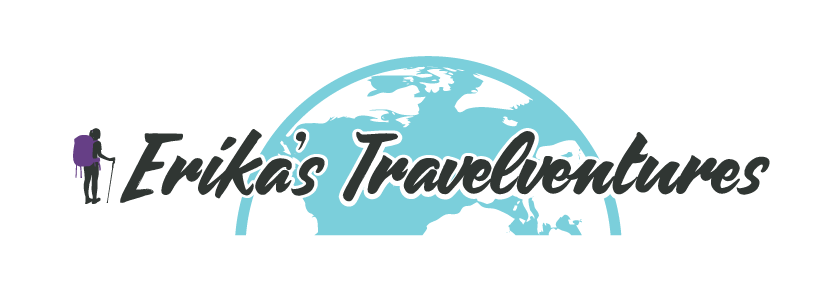
The Three Passes Trek + Everest Base Camp Without A Guide
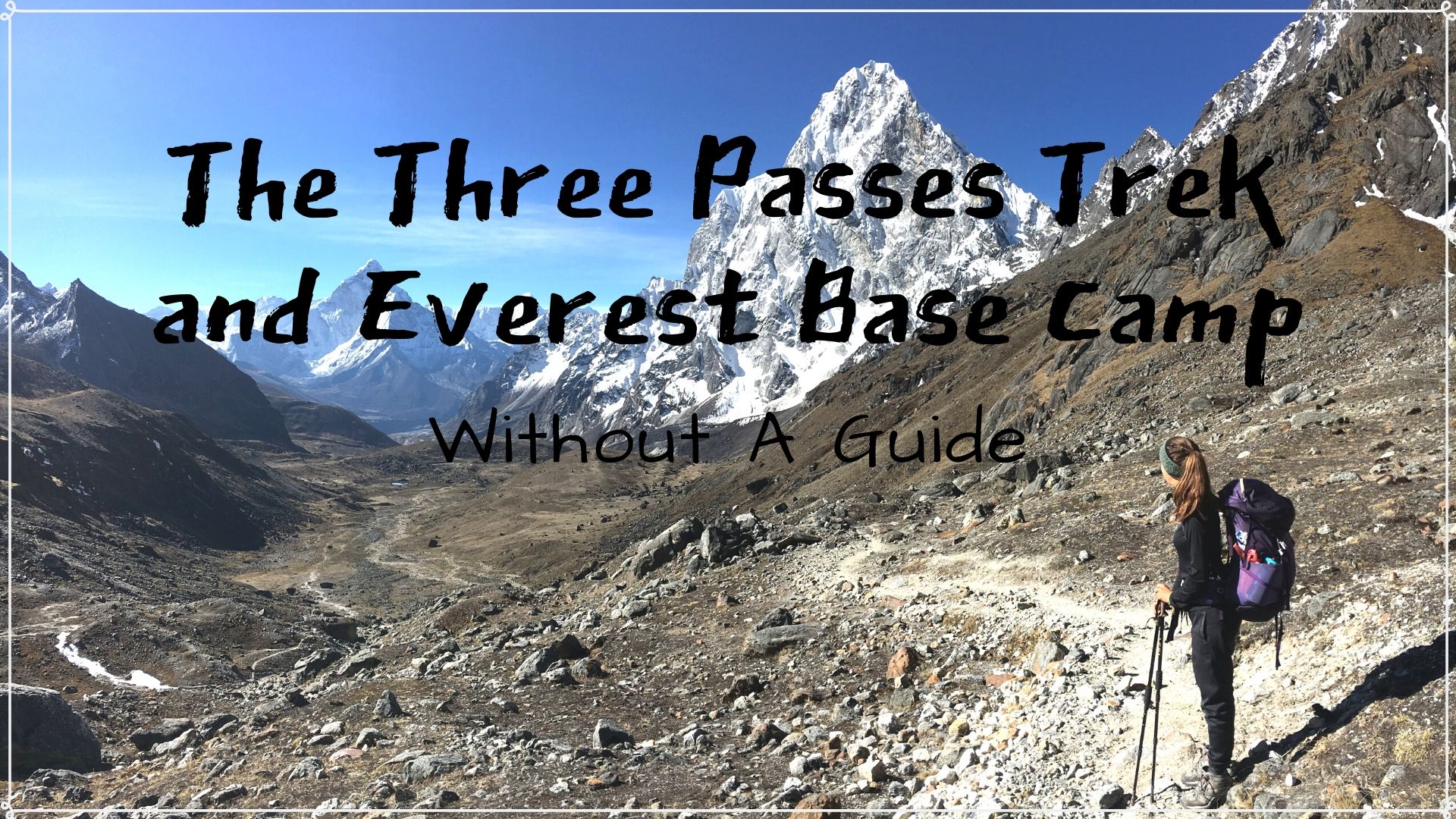
The Three Passes Trek is an opportunity for trekkers to challenge themselves in the world-famous Everest mountain region. There’s no need to train years and spend thousands of dollars to be in the presence of Mt. Everest on the Three Passes Trek.
The Three Passes Trek takes you over three high mountain passes, to an elevation of 5550m , AND to the popular Everest Base Camp .
Some people are content with hiking only to Everest Base Camp to tick off this bucket list item, but I recommend taking your experience to the next level. Push yourself harder, walk a little further, and climb a little higher. This trek is worth it, and my Three Passes Trek Guide will help you plan your trek, without a guide!
Safety Note:
The three high passes on the Three Passes Trek are all above 5400m in elevation . They should not be attempted by those without at least a medium fitness level and without previous trekking/hiking experience.
Everyone should expect to experience some signs of altitude sickness on the Three Passes Trek . Symptoms include shortness of breath, loss of appetite, blurry vision, headaches, nausea, trouble sleeping, and fatigue. It is critical to listen to your body and know when to take a rest day or drop down to lower elevation. Taking it slow is the best way to allow your body to adjust to the altitude.
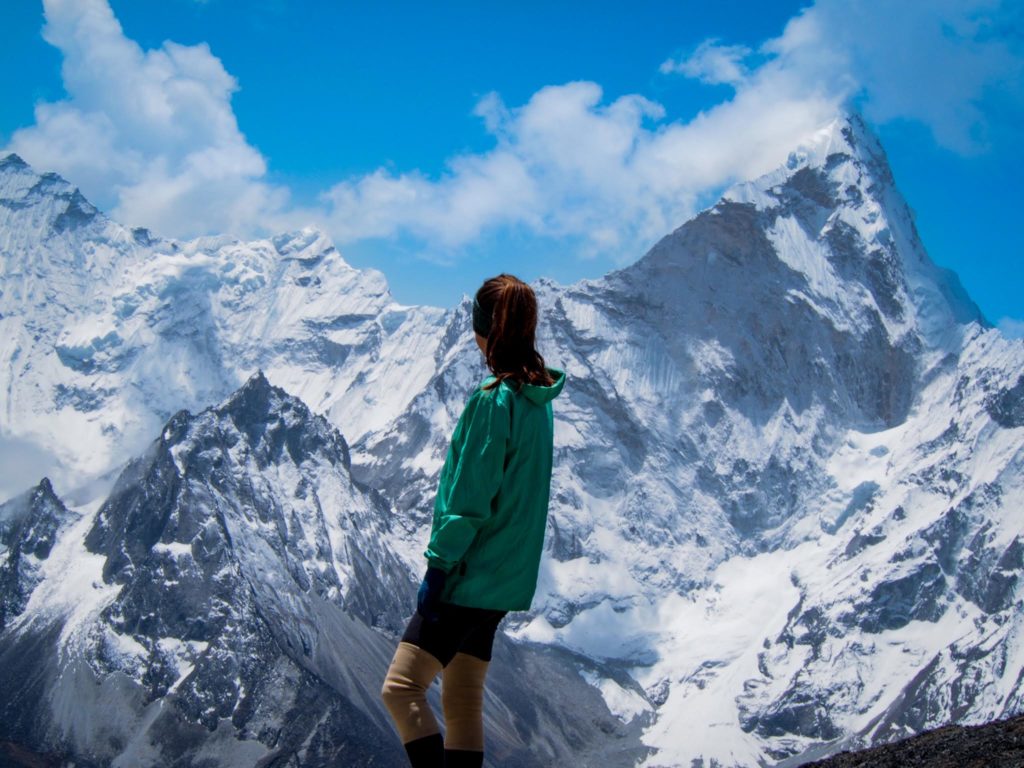
Skip to Section
Overview getting to the trek duration sample itinerary insurance permits accommodation foooood budget atm access packing list safety tips.
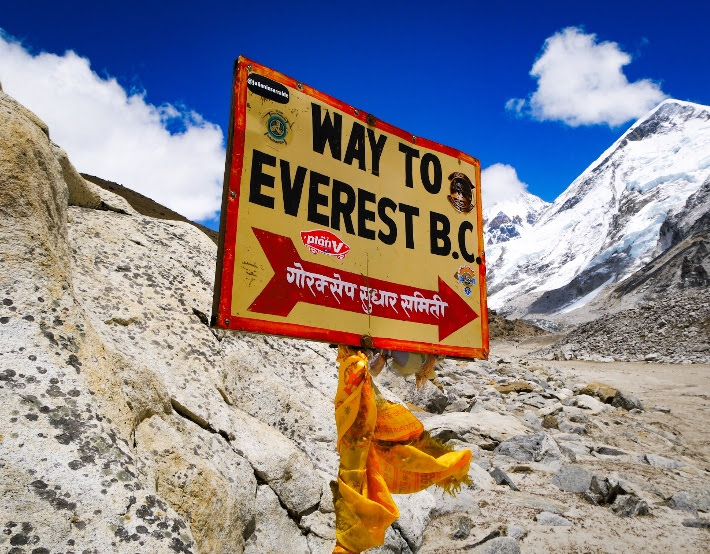
Overview of the Three Passes Trek Without A Guide
Duration : 14-26 days (depending on starting point & rest days) for the Three Passes Trek plus Everest Base Camp side trek
Starting Altitudes: Jiri – 1995m Salleri – 2390m Lukla – 2840m
Highest Altitudes: Kala Patthar (side trek) – 5550m Kongma La – 5535m Cho La – 5420m Renjo La – 5360m
Distance per day: 5km to 15km
Best season: April-May, September-November
Budget: $28 USD per day: At low altitude, $10/day. At high altitude, $35/day
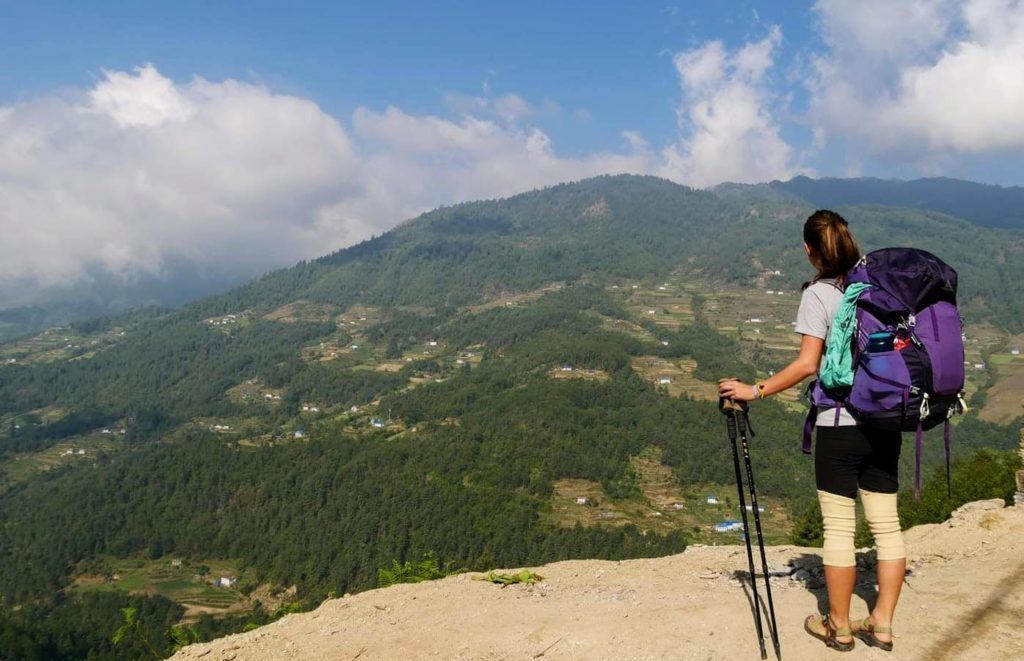
Intrepid Road and I completed the Three Passes Trek without a guide, going counter-clockwise. We met several people who were hiking the Three Passes Trek clockwise as well. The counter-clockwise direction takes you over the most difficult pass first, Kongma La, and the least difficult pass last, Renjo La.
Each high pass you go over counter-clockwise will start with a long, gradual uphill, then a steep downhill on the other side, before reaching the villages.
Likewise, trekking clockwise means there is a steep uphill before a gradual downhill.
Check out Intrepid Road’s Ultimate Three Passes Experience Video!
Getting to the three passes trek.
There are three different starting points for starting the Three Passes Trek unguided: Jiri, Salleri, and Lukla .
Jiri and Salleri are the cheapest to get to. The bus to Jiri from Kathmandu costs about 1500 rupees (~$15) and the jeep to Salleri from Kathmandu costs around 2000 rupees (~$20). Both options can be booked via tour or transport agencies in Kathmandu. Since these options are more popular with locals traveling to villages in the area, it may be difficult to book or find information about them outside of Kathmandu.
Lukla is the most popular entry point to the Everest Base Camp region. To get to Lukla, you need to catch a $170 flight (one-way) from Kathmandu.
When I hiked the Three Passes Trek without a guide, I chose to jeep from Kathmandu to Salleri, which took about 10 hours.
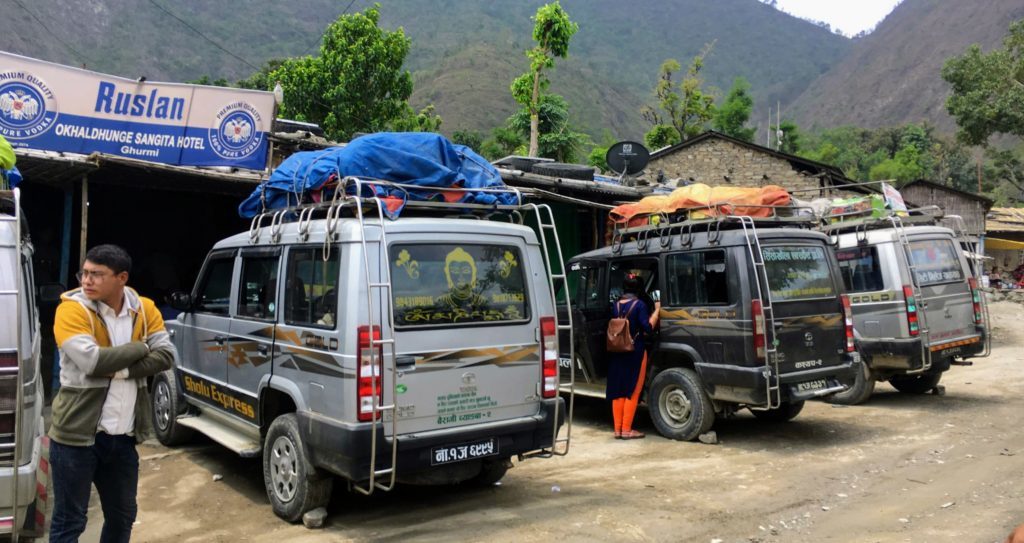
Duration of the Three Passes Trek Unguided
The number of days you spend on the Three Passes Trek totally depends on your trekking style: how fast you trek, the number of rest days you take, and especially where you start the trek.
From Jiri it will take you an extra 6-7 days on foot to reach Namche Bazaar, and from Salleri it will take you an extra 3 days .
If you fly into Lukla to start the Three Passes Trek, it will take you only one day to reach Namche Bazaar . (If your flight lands in the morning, you may even make it in the same day!)
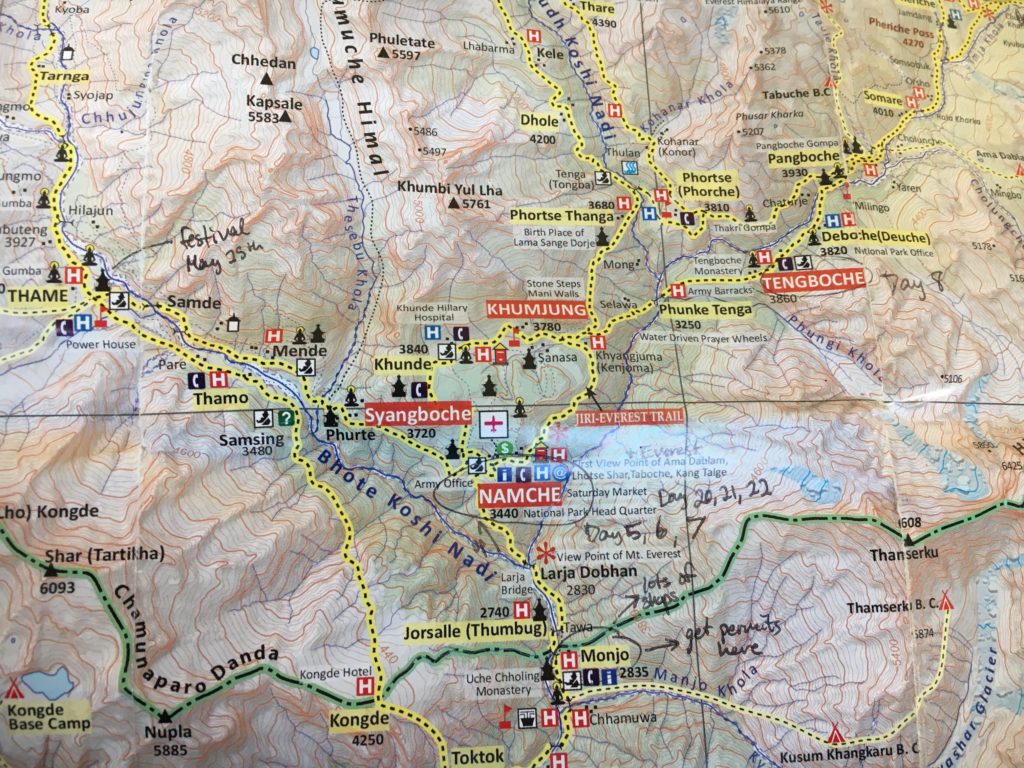
From Namche Bazaar, the Three Passes Trek can take a minimum of 10 days as you go over the three high mountain passes. This includes a side trek to Everest Base Camp and Kala Patthar , then looping back to Namche Bazaar. Going this fast should only be attempted by the super fit and those confident at high altitude!
Most people take rest days in Namche Bazaar, Chhukhung or Gorak Shep, and Gokyo, making it a 12-day loop. When I went, I took two rest days in Namche, one in Gorak Shep, and three in Gokyo, taking a total of 15 days to get back to Namche.
Check out my 10 things to do in Namche Bazaar to consider for your rest day!
Sample Itinerary
This is a sample itinerary for my Three Passes Trek Guide. It’s the path that I took when I completed the Three Passes Trek and Everest Base Camp without a guide:
- Day 1: Kathmandu -> Salleri (jeep)
- Day 2: Nunthala
- Day 3: Bupsa
- Day 4: Ghat (we passed Lukla on this day)
- Day 5, 6, 7: Namche Bazaar
- Day 8: Tengboche
- Day 9: Dingboche
- Day 10: Chhukhung (some people take a rest day here)
- Day 11: Lobuche
- Day 12, 13: Gorak Shep
- Day 14: Dzongla
- Day 15: Dragnag (some make it to Gokyo on this day)
- Day 16, 17, 18: Gokyo
- Day 19: Marulung
- Day 20, 21, 22: Namche Bazaar
- Day 23: Phakding
- Day 24: Paiya
- Day 25: Adheri -> Salleri (jeep)
- Day 26: Salleri -> Kathmandu
If you start the Three Passes Trek in Jiri, your first four days might look like this before Nunthala:
- Day 1: Kathmandu -> Jiri (bus)
- Day 2: Bhandar
- Day 3: Dakachu
- Day 4: Junbesi
- Day 5: Nunthala
If you fly in to Lukla to start the Three Passes Trek without a guide, your Days 4-23 might look the same as mine.
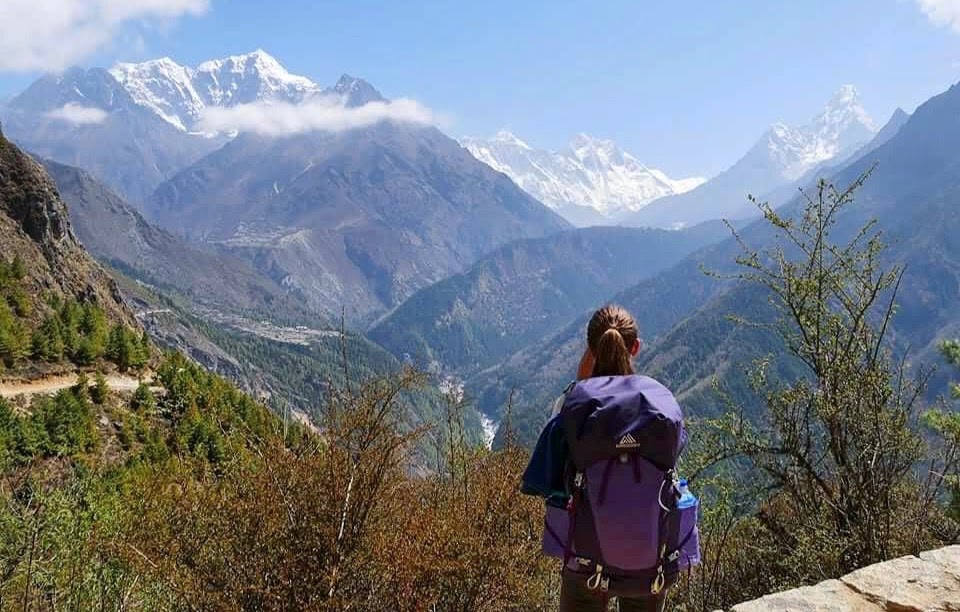
Insurance - SUPER Important!
Just in case you encounter serious problems while trekking, make sure you have traveler’s insurance . Safety is your FIRST priority while hiking the Three Passes Trek and Everest Base Camp.
It’s important to check if your insurance will cover up to 5550m in elevation ! Many will have an altitude limit that’s below 4000 or 5000m. World Nomads allows you to purchase insurance abroad and covers you for medical evacuations at high altitude.
Do NOT hesitate to go back down to lower elevation when you feel dizzy or sick! This could save your life!
Travel insurance. simple & flexible., which countries or regions are you traveling to, what's your country of residence, what is your province, what is your state, enter traveler's age.
When I was in Gorak Shep, we heard there was a man in Lobuche who died from severe altitude sickness. He didn’t have insurance for a helicopter to take him down, and the second best option available was to have a donkey carry him down. Unfortunately this wasn’t fast enough and he lost consciousness, and even being put in a zip-up oxygen bag couldn’t revive him.
Permits for the Three Passes Trek and Everest Base Camp
Hikers need two permits to hike the Three Passes Trek and Everest Base Camp. You also need to keep the permits on you for the entire hike. Although there are fewer checkpoints here than on the Annapurna Circuit , it’s still important that you keep the permits on you. In order to purchase the permits, you need 5400 rupees and your passport.
- The Sagarmartha National Park permit can be purchased in Kathmandu or en-route to Namche Bazaar. You can buy this permit in Lukla, as well as in Monjo, right outside of the entrance to the national park.
- The Khumbu Pasang Municipality permit can only be purchased on the trek. You buy it at a checkpoint right outside of Namche Bazaar . Here you will have to show your passport again.
The officer will ask you for the approximate number of days you will be trekking, and which trek you will be undertaking. It’s ok to let him know you are trekking the Three Passes Trek and Everest Base Camp without a guide.
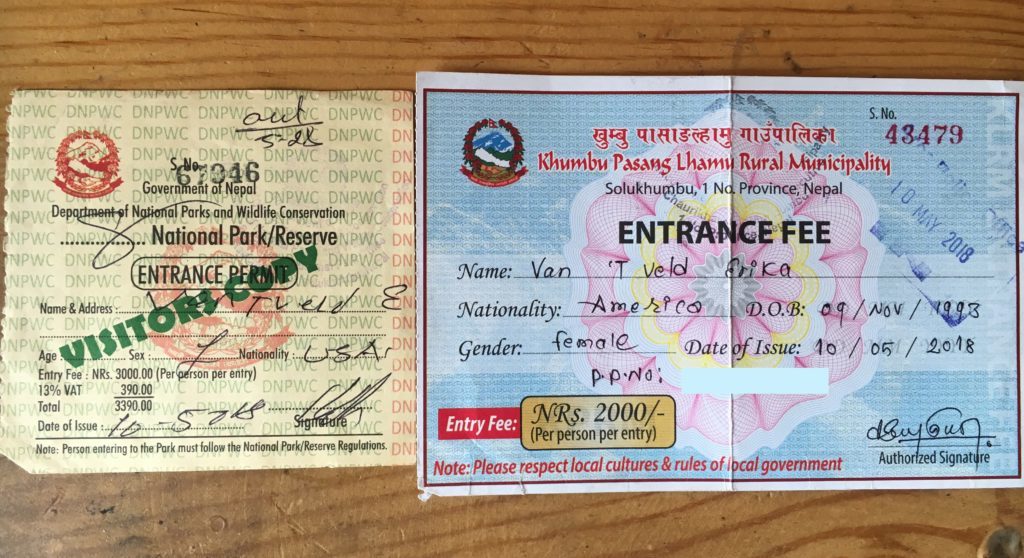
The National Parks pass costs 3390 rupees, and the trekking permit costs 2000 rupees.
Although they don’t ask for any insurance information, they do look at your passport to write down your information. Make sure you bring your passport with you on the trek AND a hefty 5390 rupees just for the permits!
Accommodation on the Three Passes Trek
Trekking the Three Passes Trek without a guide means finding your own accommodation. Don’t worry, there are plenty of options along the trek. Upon arriving at a village, ask around at any guesthouses if they have rooms available.
Although traditionally trekkers are able to stay for free in exchange for eating food at the teahouses/guesthouses, this is not the case anymore on the Everest trail.
2019 Update: Guesthouses after Namche Bazaar are now all charging at least 500 rupees to stay the night
When you arrive in town and are looking for guesthouses to stay in, usually the larger hotel-looking lodges will charge you more for the rooms. They likely have higher overhead costs of operating a larger kitchen and have more staff. These larger guesthouses usually bring out meals quickly, and have warmer rooms and more bathrooms.
The family-run, smaller guesthouses usually charge less or nothing at all. You may miss out on some luxuries of a fancier guesthouse, but in exchange you’ll probably get a more personal experience with the Nepali guesthouse owners.
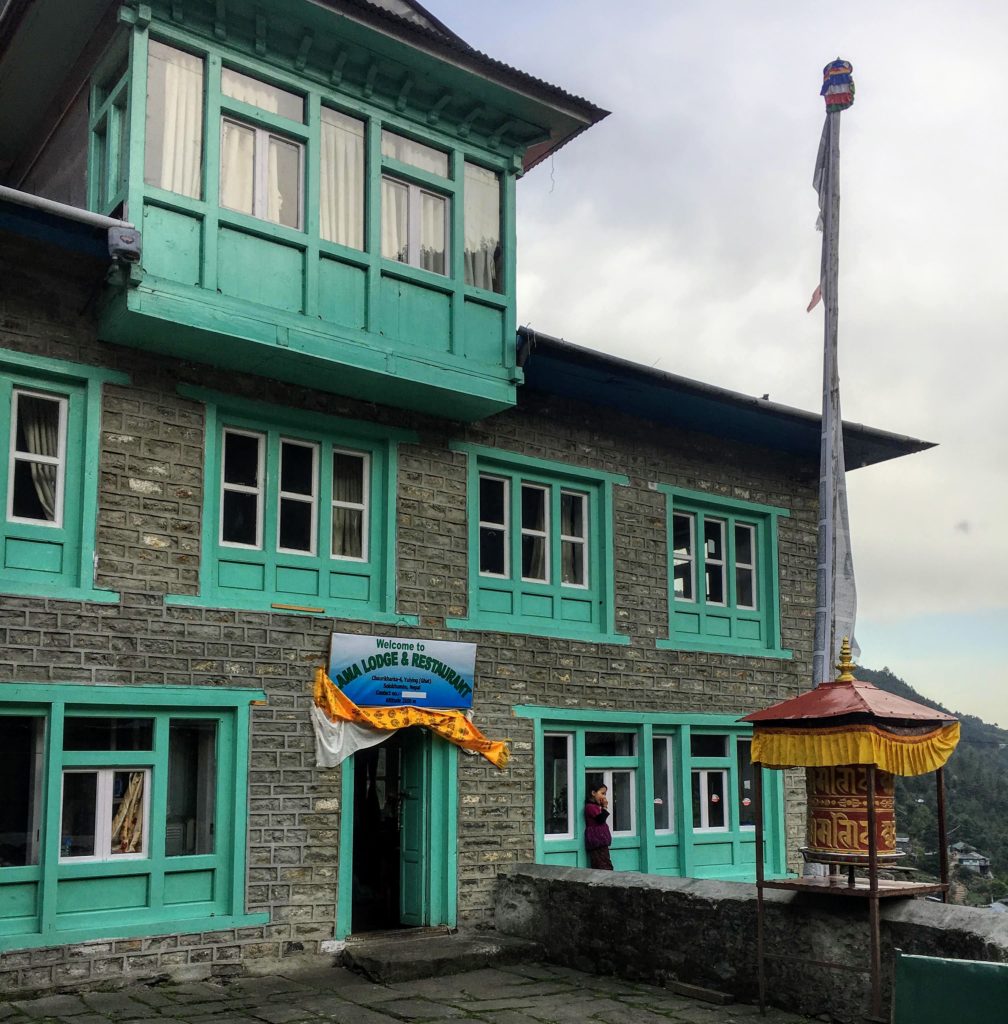
When trekking the Three Passes Trek without a guide, you can easily order food at every guesthouse you stay in.
Below is a sample menu from a guesthouse at Phakding, a town located between Lukla and Namche Bazaar. This is the medium- to low-end of prices for food items along the Three Passes Trek. The food and drink variety stays fairly constant from village to village.
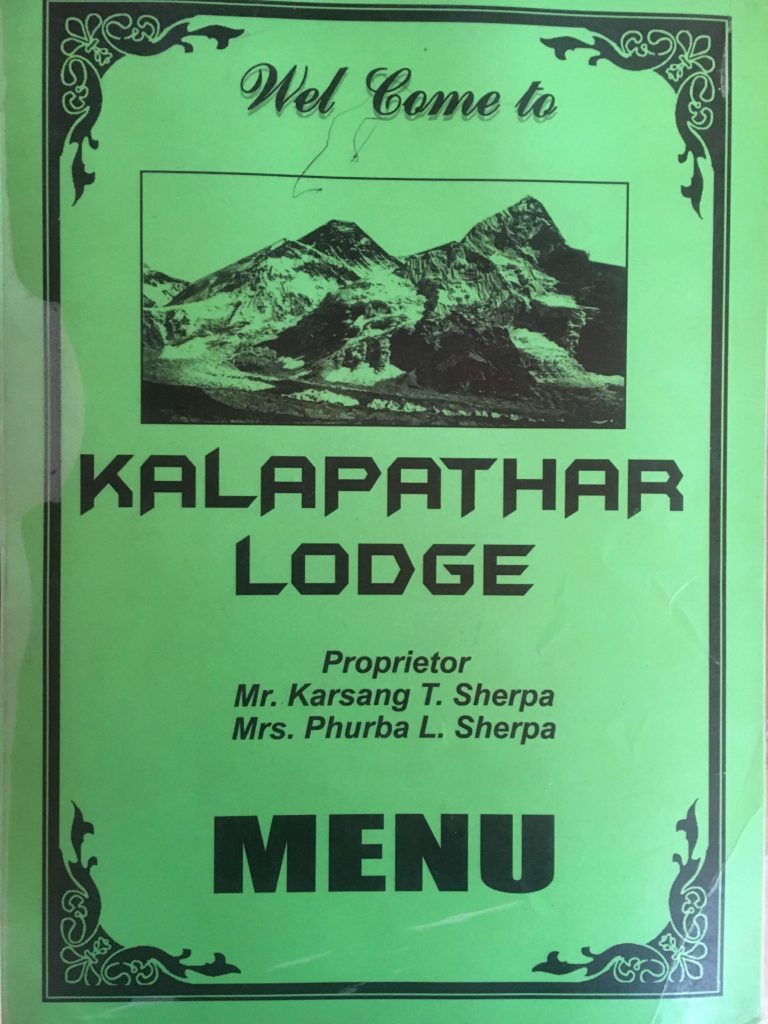
The cost for food changes exponentially along the Three Passes and Everest Base Camp trek.
I was surprised prematurely in Salleri when the cost for a Dahl Baht was 300 rupees (or $3. I was used to 150 rupees in Kathmandu). You’ll see up to 850 rupees ($8.50) at Gorak Shep for the same meal. Veg fried noodles which I liked to get for lunch or dinner, went from 200 rupees to 700 at higher elevation. My favorite breakfast, hash browns with vegetables and an egg went for 900 rupees at Gorak Shep.
The amount of money you’ll spend on food on the Three Passes Trek will vary depending on snacking, sickness, and mostly altitude. At low altitude, you can budget $10/day for food, and at high altitude (after Namche) you can expect to pay closer to $30/day.
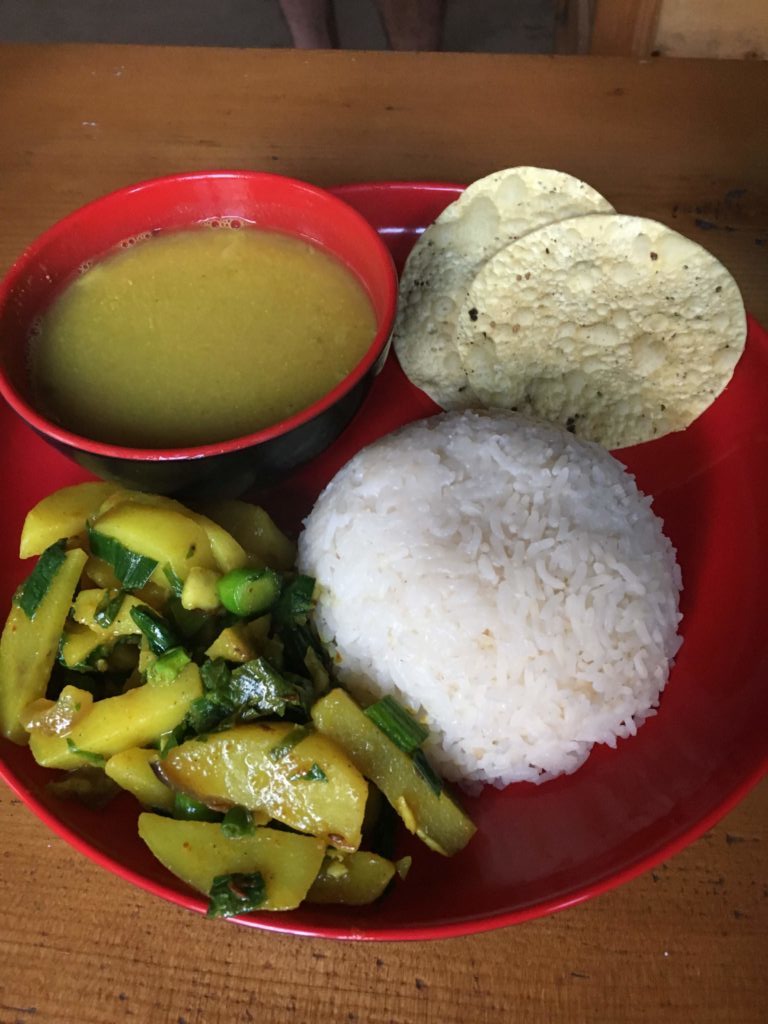
Budget for the Three Passes Trek and Everest Base Camp Without a Guide
I’ve tried to make a comprehensive budget for my Three Passes Trek Guide , but some things have changed since I did the trek in 2018. Most importantly, almost all guesthouses past Namche Bazaar will charge you 500 rupees per night. Guesthouse owners were tired of people staying for free! (Which is completely understandable).
All prices are listed in USD.
Accommodation
500 rupees per night at high elevation
Transportation
Transport costs will vary greatly depending on where you decide to start the Three Passes Trek without a guide. I recommend flying into Lukla if you’re short on time (keep in mind that its common for flights to be delayed or cancelled if there’s low visibility). This will set you back $170 x 2 = $340.
Trekking from Jiri or Salleri saves on flight costs, but you’ll pay for overland transportation from Kathmandu , $15-$20, and for the extra days you’re spending in the mountains, $10-$15 per day.
If you haven’t purchased any permits before leaving Kathmandu like I did, add an extra 5390 rupees ($54) to take with you to buy the permits on the trek!
Above, I mentioned a budget for $10 per day for food before Namche, and $30 per day after Namche. I thought I could cut down on this cost, but when every meal at high altitude cost $7-9, cups of tea are $2-3, and bottles of water are $3-4, it adds up quickly.
Charging Electronics
Charging electronics and free wifi are basically nonexistent on this trail unlike in the Annapurna region. Definitely invest in a portable battery charger .
Be sure to charge all of your electronics before you leave Namche Bazaar too. Some of the restaurants, bars, and bakeries there will let you charge for free while you spend time at their business. As you get to higher altitude, you’ll be spending 200-300 rupees an hour to charge phones and even more for battery packs because guesthouses run on solar power.
WiFi (Everest Link)
Since I had an NCell SIM card, in Namche I had 4G and in Tengboche I had 3G service. Everywhere else, to stay connected you need to purchase the Everest Link internet cards. These are 600 rupees ($6) for 200 MB of internet usage, which is ridiculous but there’s no other option.
Make sure you turn off auto-updates, and keep in mind that each code can only be used for one device. I only bought this once during the trek, after I had been offline for a week people at home had started to worry.
Personal Hygiene
Showers at high altitude cost from 200 rupees for a cold bucket of water, to 700 rupees for a gas shower. Some go the entire trek without showering, but I showered a number of times in 25 days just to retain some level of cleanliness.
Since I had some space in my bag, I invested in some extra toilet paper rolls to bring from Namche also. At shops in Namche toilet paper costs 200 rupees, but in the mountains you’ll be paying 400-500 per roll. Since I was sick and blowing my nose every 10 seconds, these came in very handy!
Coming from hot and humid India I didn’t have any winter clothing aside from a hat, leggings, sweatpants, and a NorthFace GoreTex jacket I picked up from a hostel in Cambodia. Luckily, you can find any trekking gear you can dream of in Thamel.
Check out my trekking in Nepal packing list !
I chose to buy gear instead of renting it because I trekked both the Annapurna Circuit AND the Three Passes Trek . I bought hiking boots ($40), sleeping bag ($25), trekking poles ($5), a fleece sweater ($5), trekking poles ($5), light windbreaker ($10), and microspikes ($10) = $100.
Total Budget for the Three Passes Trek Unguided
I personally spent about $700 USD on the Three Passes Trek over the course of 25 days (excluding the cost of gear I listed above).
I was sick for a while and buying pots of tea ($10) and throat lozenges ($4) everywhere, and I splurged on beers ($7) and apple pies ($4) in Namche. Real budget travelers can expect to spend around $600 trekking the Three Passes Trek unguided.
It’s a good idea to bring this entire sum of money with you when you start the trek.
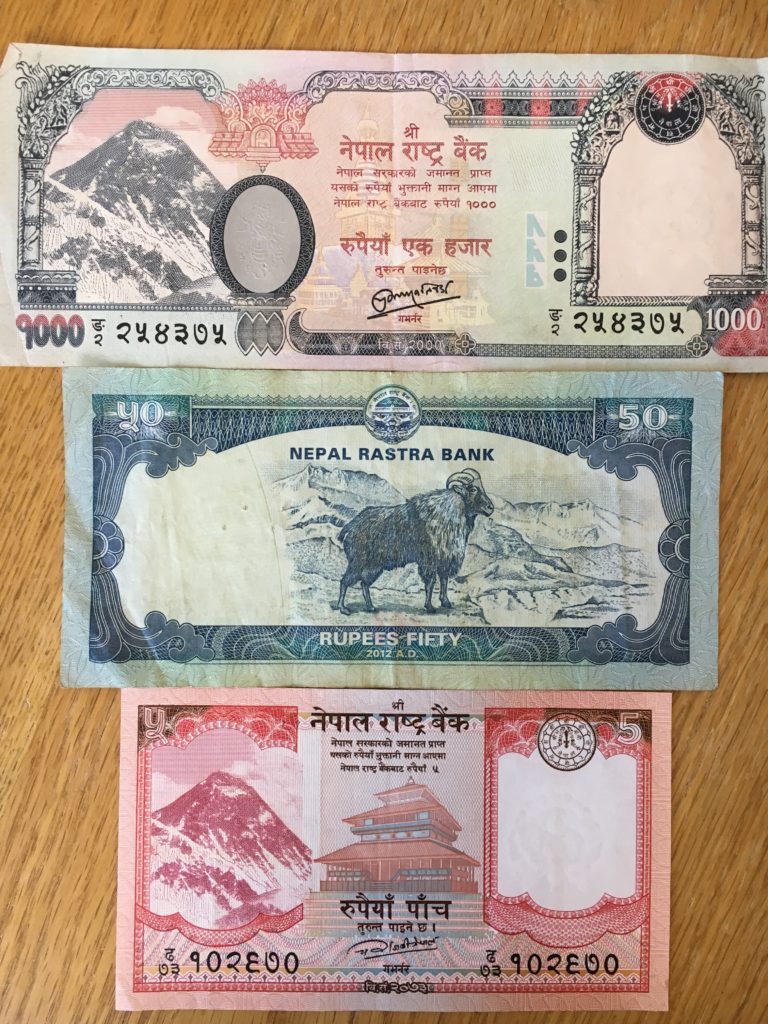
Bring all $600-$700 USD to spend on the Three Passes Trek with you, when you leave Kathmandu!
Namche Bazaar has several ATMs where you can stock up on rupees, but there’s a chance that they’re empty or not working. ATMs all turn off during frequent power outages. The ATM I used there had a 10,000 rupee ($100) withdrawal maximum, with a 500 rupee ($5) withdrawal charge.
Some sources say there is an ATM in Lukla, but when we asked around, we were told there isn’t one, only a bank for local account holders.
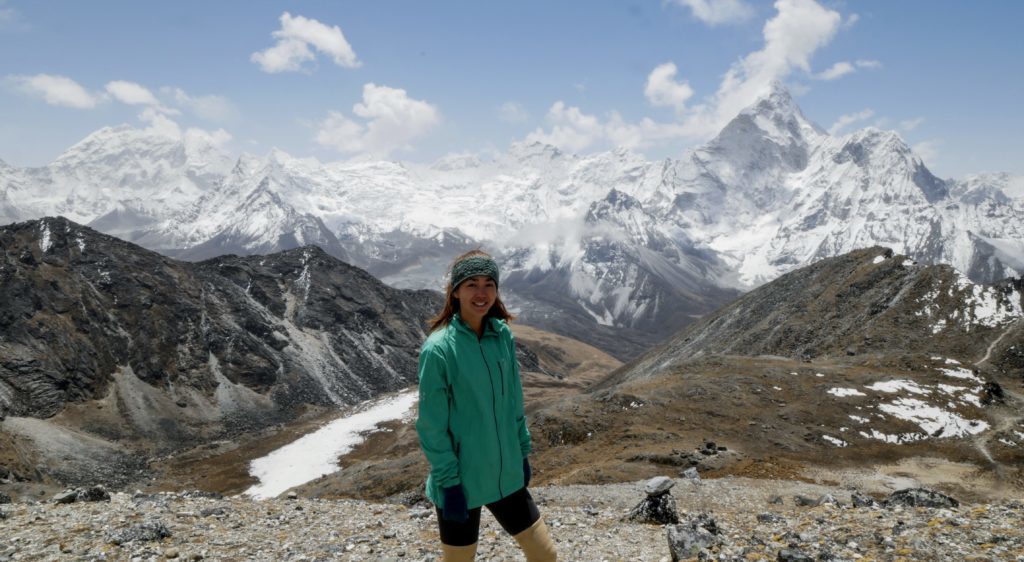
Packing List for the Three Passes Trek and Everest Base Camp
Check out my full packing list in my perfect trekking in nepal packing list post .
I’ve divided this section into four different parts: pharmacy, clothing, gear, and other.
One of many things that I hope you take away from this Three Passes Trek Guide: the goal is to bring as little as possible with you on the trek because you’ll be carrying it all!
Feminine products 16x Cough drops (wish I had brought more!) 10x Band-Aids 5x Rehydration Salts (Awful taste but really important) 1x Diamox strip (I didn’t use these but many people do) 1x Paracetamol strip 50x Water purification tablets (I used about 40 of these) Sunscreen Deodorant Toothbrush/toothpaste Packet of baby wipes Lotion Razor Hair ties Toilet Paper
1x long-sleeved under armour 1x long-sleeved heat-tech shirt 1x long heat-tech leggings 1x thick under armor sweatpants 1x T-shirt 6x underwear 2x bras 3x thick trekking socks 1x normal socks 1x fleece 1x Goretex thick North Face jacket 1x thin windbreaker 1x thin gloves 1x thick gloves 1x hat 1x neck wrap
1x 55-65L backpack 1 pair of mid hiking boots 1 pair of Chacos/ trekking sandals 1 pair of trekking poles 1 pair of microspikes
Reusable water bottle
Quick-dry towel
Sleeping bag
Battery pack ! Phone + charger GoPro + charger Kindle Flashlight or Headlamp
Optional to bring:
Small day bag Knee braces (450 rupees from a pharmacy in Kathmandu – these saved my life!) Flip flops Dry shampoo Honey Snickers bars Sunglasses Ear plugs
Many hostels in Kathmandu will let you keep you luggage at their hostel for a small daily fee, or even for free (I left three bags in Kathmandu’s Shantipur Hostel ) There may be some guesthouses in Namche Bazaar that have this service for a fee as well. It’s important to take advantage of this, or else you’ll have a hell of a time hiking at 5500m with a 15kg bag.
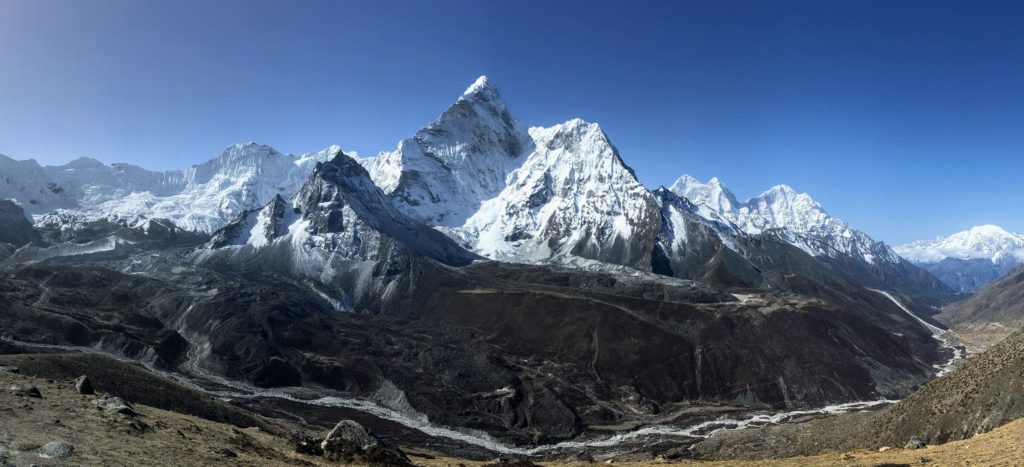
Safety Tips for Trekking the Three Passes Trek Unguided
This might be the most important section of this Three Passes Trekking Guide. The Three Passes and Everest Base Camp trek is a dangerous trek that people have died on! It should not be underestimated, especially when hiking without a guide.
- Always be attentive of the weather when you’re about to set out on a long trekking day. Better to postpone hiking a day than to be stuck in a snowstorm.
- Start your pass days early , and expect it to take from 8-12 hours guesthouse to guesthouse including breaks.
- Use maps.me for a pretty accurate trail map to follow.
- When you’re going over the glaciers, especially the Khumbu glacier after Kongma La, STAY ON THE TRAIL .
- Keep an eye out for rock cairns ahead of you.
- Listen to your body when you’re gaining altitude.
In Conclusion
Enjoy a month in the beautiful Himalaya mountain range and make the most out of your trip to Nepal by hiking the Three Passes Trek and Everest Base Camp without a guide.
The physical difficulty combined with amazing views will make this trip one of the most rewarding and amazing experiences of your life. If this Three Passes Trekking Guide was useful, or if you have any other tips or questions, leave them in the comments below!
Pin this TPT guide for later:
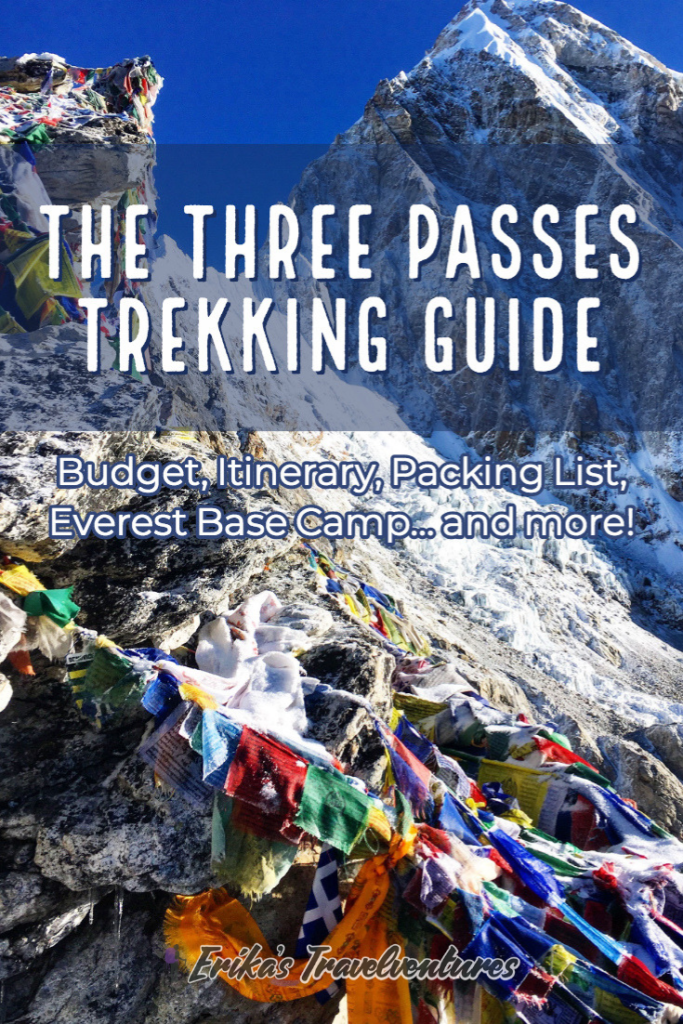
You might also like:
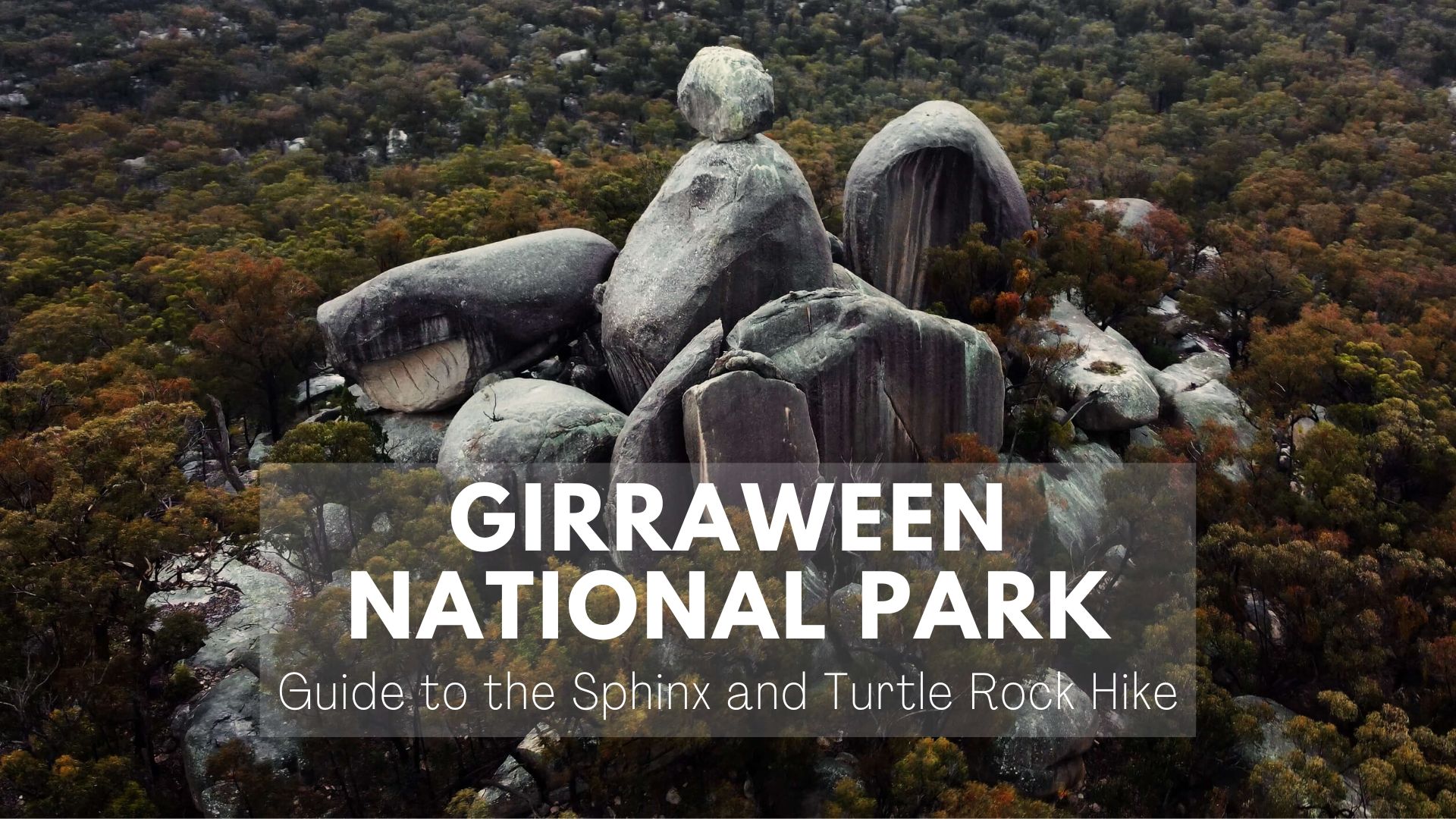
Turtle Rock and The Sphinx Hike at Girraween National Park
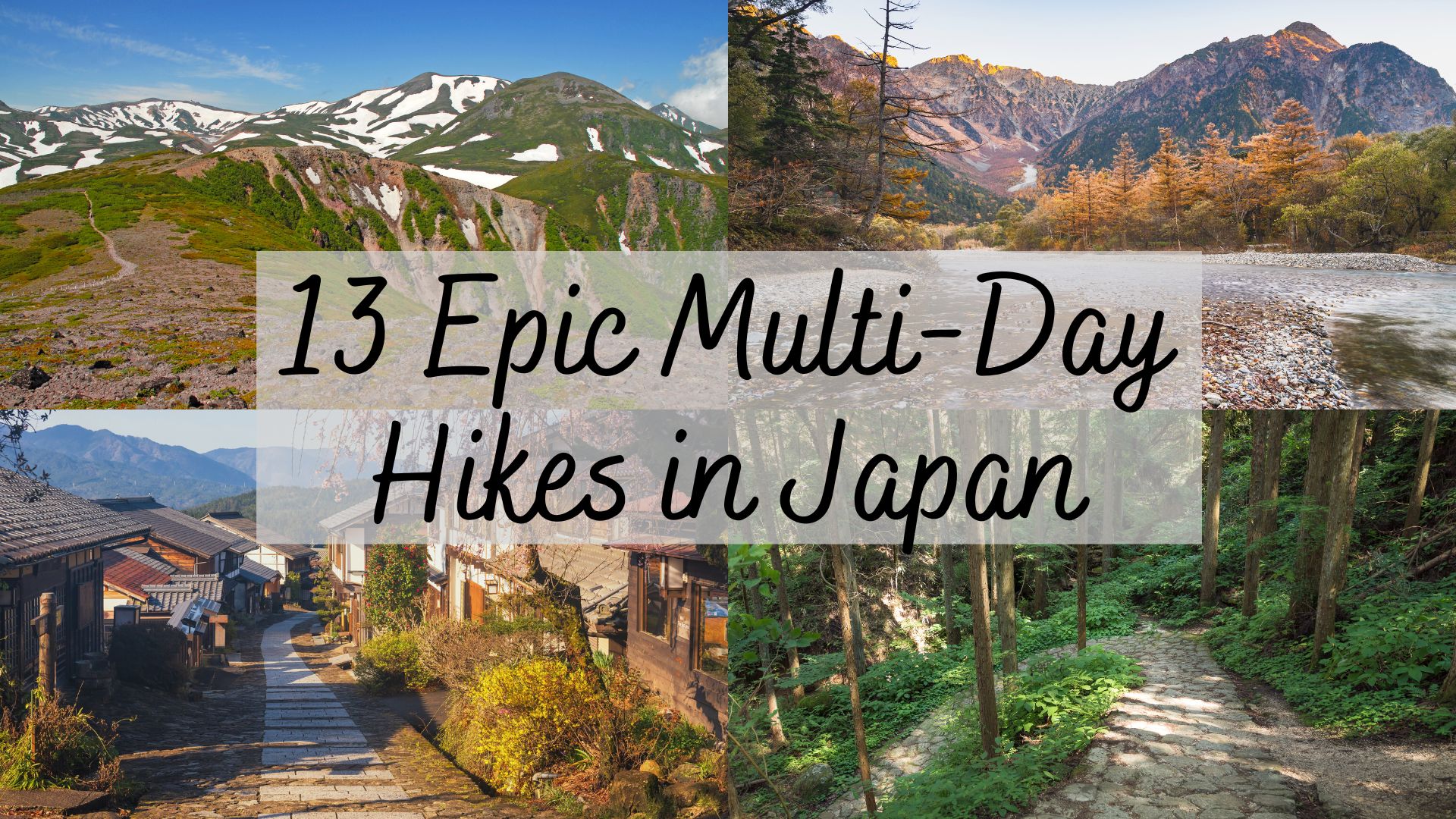
13 Best Multi-Day Hikes in Japan
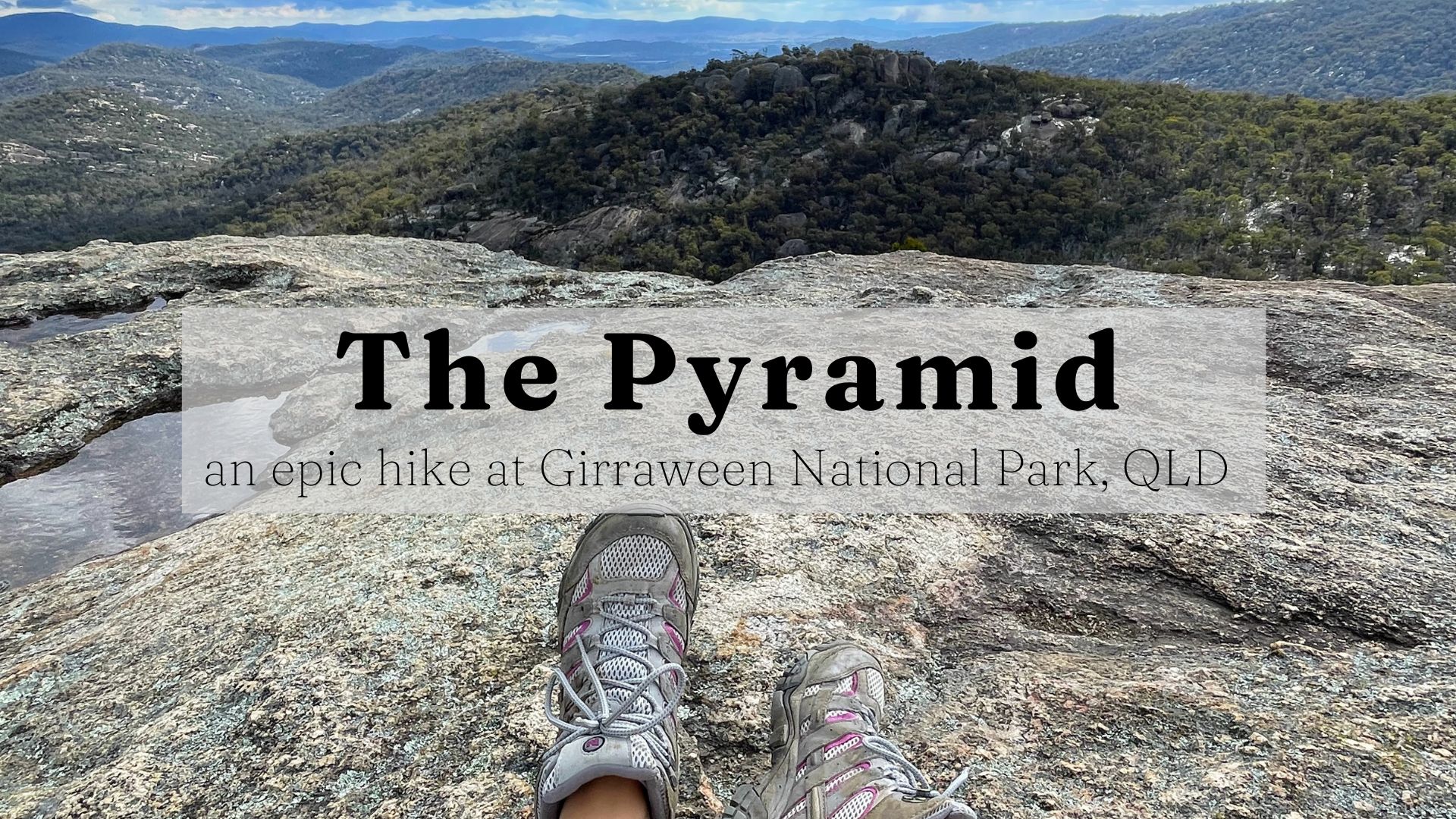
Guide to Hiking the Pyramid at Girraween National Park
16 thoughts on “ the three passes trek + everest base camp without a guide ”.
Very informative travel blog!
Wow, such a detailed post that would be so helpful to plan a great hike to Everest Base Camp. Loving the pictures so much.
This is a very complete guide for everyone who wants to trek to Everest base camp. It sounds like a tough trek but so rewarding when you get to the top.
Such an awesome post and very detail article. Wonderful tips and very good guide on how we can make thru this challenge. By doing your itinerary I may say this is very much possible to accomplish.
This is such a detailed pist. Thank you for sharing this. This will definitely help me when I go trekking. Love it.
I think it would be so neat to do a big hike like this. Maybe one day! I never knew about the insurance and permits thing either. That is good to know!
I would love to do this. I love the mountains
Its a great informative post! I was not aware of most of these things. Thanks for sharing.
It’s a great informative post. Thank you for sharing this. It sounds like a tough trek but so rewarding when you get to the top.
A great thanks really. I was thinking of doing EBC and this post is a boon to me. Downloading it really <3
I’m glad it’s helpful 🙂 Good luck!
Such a detailed post and you have beautiful pictures. this must have been incredible. Thanks for sharing 🙂
This is such a detailed guide!! I learned so much and anyone about to attempt this trek should read this.
Excellent post! You covered everything! I want to go back to the Himalayas someday, but I’m a bit discouraged for now – I picked up Salmonella and some nasty parasites during my trip :(.
Really impressive information about Everest Base Camp trek, Yes maps. me always provide right directions.
Thank you! I was happy to have maps.me with me on the trek for sure.
Leave a Reply Cancel reply
Your email address will not be published. Required fields are marked *

Everest Three Pass Trek
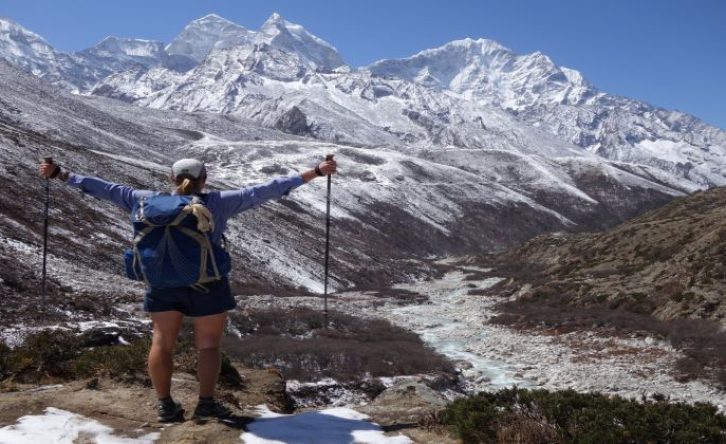
Group Discount Price
Number of Travellers
Trip Itinerary
Cost include / exclude.
Everest three Pass Trek is one of the most challenging trails in the Everest region of the Himalayas taking trekkers to three of the highest passes here. The Base Camp of the top of the world Mount Everest (8848 m) is fantastic on its own. Adding the likes of Kongma La Pass (5535m) , Cho La Pass (5368m), and, Renjo La Pass (5360m) , Gokyo Lakes (4750m) , and Kalapathar (5545m) makes the experience complete for every level of traveler in Nepal.
Flaunting the views of the highest peaks in the Earth and a picturesque landscape imitating a piece of Shangri-La itself, the three-pass trek surpasses your adventure hunger in this country. Witnessing the Sherpa culture and the natural scenery of the high Nepalese Himalayas in a single trek is fascinating.
This 18 Days Everest 3 pass Trek Starting from Kathmandu, a short domestic flight will take you to the airstrip of dreams in Lukla. Following the primary trail of Everest, we will be on Dingboche in the first week of the walk. From here our path splits towards the first of the three passes in Kongma La (5535m).
Considered as the most challenging of the three you can push for an exciting trek doing this pass. Going over the pass we will join the main trail and head towards the inspiring Everest Base Camp . Next comes the beautiful Cho La pass (5368m) on our itinerary. On the other side of this difficult pass lies the magical Gokyo Valley. The pristine Lakes energizes us for the final Pass. Renjo la Pass (5360m) connects us to the original trail and back to Lukla. In this way, we will complete over three different treks of Everest in a single go here.
Highlights of Everest Three pass Trek
- One of the most challenging trails in Everest which is perfect for trekking loving Individuals in the Himalayas.
- It is the complete trekking experience of the Everest region covering every primary destination here.
- Magnificent Views of Mount Everest, Mount Makalu, Mount Cho Oyu, Mount Lhotse, and other beautiful peaks of the Mahalangur Range.
- Kongma la Pass (5535 m), Cho La Pass (5368 m), and Renjo La (5360m) all offer unique adventure and thrill to trekkers here.
- An ideal upgrade if you’ve done the EBC trail before as it has multiple sections to enjoy as an adventure-loving individual.
- Witness the traditional Sherpa culture in the home of the Sherpas. Explore the lifestyle, art, and tradition here.
- Picturesque and diverse landscape views and sceneries to enjoy in different segments of the three-pass trail.
Everest 3 Pass Trek Equipment Checklist
Everest Base Camp Three Pass Trek is a long and challenging trek with more than a week of trekking in high weather with rough terrain. Making sure you have the appropriate gear necessary for the trek completes the first stage of your preparation for it. Here is a checklist for you as a reference to successfully complete the Everest Three Passes Trek.
- Long-sleeve thermal wear
- Comfortable trekking shirts
- Down Jacket
- Beanie and woolen scarfs
- Headlight with spare batteries
- Sunglasses and Hat
- Trekking pants a pair and thermal leggings
- Trekking/hiking boots and socks
- Hiking pole and bag
- Sleeping bags and linen
- Basic medicinal pills and a small first-aid kit
- Map, Water bottle, & Purification tablets
You might also require additional equipment if you are doing this trek in the off-season period. These generally add raincoats, gaiters, crampons, and other small stuff. Most of the items here can either be bought or rented in the Thamel Market in Kathmandu.
EBC and Three Pass Trek Difficulties
The Everest Base Camp Three Pass Trek is a challenging trail that can be difficult for beginners. We suggest you attempt this trek with good preparation and a licensed guide during the trekking season for best results. Similarly, don’t hesitate to take porters with you if it is necessary. For intermediate/amateur level trekkers we do recommend you to do a guided trek to the three passes. There are multiple tricky sections that will be easier with a knowledgeable guide. We will also recommend you to do some short hikes before just to make your body fit better with walking.
As for experienced trekkers, you can compare the Everest BC three-pass trek with some peak climbing trips in the Alps, Saint Elias, or Alaska ranges. If you don’t want guides, make sure you have thoroughly prepared for high-altitude trekking in Nepal. Similarly, if possible we will suggest you tag along with other solo trekkers doing the trail.
Options to do the trek reverse (Anticlockwise)
Yes. You can do the EBC three-pass trek from both ways as it is a small circuit starting and ending at Lukla. However, the anticlockwise trail is comparatively difficult to the general one. The pass-days at Renjo La and Cho La pass going uphill are especially challenging. Similarly, you can find fellow trekkers doing it normally. Prepare more and make sure it is what you want and give the trekking team some planning time as well, to complete this trek from the anticlockwise direction.
Altitude Sickness During the EBC Three Passes Trek
Altitude Sickness is common for trekkers over the 3500 meters mark. You will be well over that altitude during most walking segments of the three pass trek. However, you can expect mild symptoms of altitude sickness that include:-
- Headache and Nausea
- Dizziness and Vomiting
- Lack of appetite and tiredness
- Breathlessness
General tips to prevent Altitude sickness
- Drink plenty of water (4l+ per day)
- Rest and walk gradually
- Get plenty of sleep and avoid alcohol
- Try eating a balanced diet.
- Take pills for sickness if necessary.
Everest 3 Pass Trek Travel Insurance
Travel and medical insurance can save you financially and with confusion during the trek. We recommend trekkers doing this journey of over three weeks over high-elevation locations to get proper insurance too. It is better if the policy covers emergency evacuation, postponements, or cancellations during the flight. Similarly, it is also smart to make sure it includes any possible medical expenses you might have in Nepal. Also, we recommend you have a travel and medical insurance before traveling to any destination.
Finally, Everest Three Pass is majestic and a dream destination for trekkers around the world. Trekkers taking on the Everest three-high pass trek can also cover one of the best challenging trails anywhere on the planet. Experience every shade of Everest and the Himalayas in its entirety with this trek.
Early morning flight to Lukla (2810m), trek to Phakding (2600 m) 3 hours
We will receive you from the hotel for a domestic flight to Lukla. Your trekking team will board a scenic domestic flight to the Tenzing Hillary airport at 2800m. The views are impressive in the morning period. After landing we will start today’s walk towards Phakding. The walk is short but it will be a perfect introduction to the Khumbu region.
Trek to Namche Bazar (3440m) 6 hours
After breakfast, we will begin our proper trek entering the lower Khumbu region. After having our permits checked at the Monjo post we will be traveling inside the Sagarmatha National Park. Passing by other trekkers, locals, Mules, and Yaks over high suspension bridges and forests we will reach Namche Bazar in the late afternoon. Freshen up and experience Sherpa culture strolling around in the evening.
Acclimatization day, Khumjung exploration
Namche Bazar is the biggest Sherpa settlement of the Khumbu region and a major stop for trekkers traveling to Everest. We will take our acclimatization break day here. Climbers, Base Camp trekkers as well as Gokyo Lake travelers also stop at Namche for a day. After breakfast, we will hike towards the Khumjung Village. After witnessing the traditional lifestyle and the historic Khumjung Monastery, we will return to Namche and rest for the day.
Trek to Tengboche Monastery (3860m) 5 hour
The view from Namche is perfect during breakfast and will energize us to start the hike to Tengboche. After breakfast, follow the trail above Namche and continue on it. Our Lunch today will be in the small and scenic village of Phunki Tenga. Your trail then rises significantly till we’ve reached Tengboche. After arriving here, visit the iconic Tengboche Monastery. Witness the prayers of the monks in the evening and rest for the day in a teahouse here.
Trek to Dingboche (4410m) 6 hours
You have a standard trek to Dingboche from Tengboche today. With a clear sunrise view of the surrounding snow-covered peaks, we will continue the trek towards Debuche. We’ll take a short break here and visit the nunnery before beginning the steep ascending trail towards Pangboche. Besides the Imja Khola, enjoy a close view of Ama Dablam mountain as you get near Dingboche. Rest for the day in a teahouse after reaching there.
Trek to Chhukung (4730m , 4 hours)
We have a short trek today. The climb towards Chhukung starts after breakfast. The views of Lhotse, Nuptse, and Ama Dablam peaks are fantastic from today’s section. Similarly, the scenic Imja Valley is also iconic in its own rights. Taking short breaks in between we will reach Chhukhung in the afternoon. Chukkung is picturesque and you can enjoy a magnificent sunset from the village. Rest for the day at the teahouse here after your arrival.
Acclimatization day, Imja valley exploration
Chhukhung lies in the beautiful Imja Valley. In recent years it has been a favorite for anyone taking an extra acclimatization day at Dingboche. You have options to hike to Island peak Base Camp or even Chhukung Ri peak for today’s break. The pristine view of the Imja lake is outstanding. Similarly, you can also enjoy an unobstructed view of Ama Dablam, Amphu Lapcha, Lhotse, and Island Peaks during the hike. Rest for the day and hit the bed early as tomorrow is the first of the three passes.
Cross Kogma la Pass (5535m) to Lobuche (4910m) 9 hours
The trail from Chhukung to go over the Kogma La is one of the most challenging parts of the Everest base camp three pass trek. We will start early in the morning, well before sunrise, and get on the trail. Getting on the east side of the Niyang Khola we will have a steep path beside some frozen lakes. There are multiple snow-covered and rocky sections ahead that display the Kogma La pass in the distance. In about 5 hours from Chhukung, we will reach the top of the pass. The views of the surrounding landscape and mountains are fantastic from the Pass. Be prepared for the downhill over the tricky bits over the Khumbu Glacier to reach Lobuche. Overnight at a teahouse in Lobuche.
Trek to Gorak Shep (5180m) and hike to Everest Base camp (5364m) 6 hours
From Lobuche, we will continue on the primary trail to Everest BC and stop at Gorak Shep. Leaving our bags at a teahouse in Gorak Shep, we will start the walk towards the base camp. The views of the Everest, Lhotse and Cholatse peaks are majestic as we head near the Base Camp. Giant rock with some prayer flags will indicate that you have reached Everest BC. Enjoy the moment and return back to Gorak Shep to rest for the day.
Hike to Kalapathar (5545m), Trek back to Lobuche 7 hours
We will start our early morning hike to enjoy a sunrise view from the top of Kalapathar Ri. It is considered by travelers as one of the best places to take in the southern face of the Everest Massif. Enjoy a panoramic view of Mount Everest, Mount Lhotse, and Mount Nuptse among many others while you are here. Returning from Kalapathar, we will have lunch at Gorak Shep. We will then drop back to Lobuche to complete today’s walk. Overnight at a teahouse in Lobuche.
Trek to Dzongla (4830m) 4 hours
We have another short day of the walk to prepare better for the second pass of the trek. From Lobuche enjoy a gradually rising and relaxed hike towards Dzongla. The views of Ama Dablam, Kantenga, Thamserku, and Twache peaks are sublime and so is the Pheriche Village and Cho La Lakes. Our trail gets wider and approaching Dzongla, we have a steep uphill as the last segment of today’s walk. Rest for the day in the small teahouse settlement and summer yak herding region of Dzongla.
Trek the Cho La pass (5368m) to Thangnak 8 hours
Our second pass day also starts very early in the morning from Dzongla. We will begin the steep ascend towards Cho La pass. Be very aware and careful as this section of the trail is mostly covered by slippery ice and snow. The views of Ama Dablam peak, now closer than ever, will lead you beside the Cho La lake. Pushing further we can take a sigh of relief upon reaching the Pass marked by prayer flags. We will reach the top of the pass in about 5 hours. There is a possibility of rough winds in these regions, so we will only be here for a moment before continuing down to Thangnak. Beside a rocky ridge, we will arrive at Thagnak and rest for the day there.

Trek to Gokyo (4790m) 3 hours
We have another short day of walking to reach Gokyo Valley from Thagnak today. However, we can have plenty of rest and start the walk after lunch today. A pretty relaxed walk beside the Ngozumpa Glacier will soon let us view the Gokyo Lakes. We will stay beside the Gokyo Cho or Dudh Pokhari Lake after arriving in the valley today.
Rest Day, Explore the Gokyo valley
Gokyo Valley is one of the most underrated destinations in the Everest region. Home to the Gokyo Lake complex, it has some amazing trails for trekkers to enjoy. On our acclimatization day today, we will attempt to reach the top of Gokyo Ri Peak. You can complete the hike in around 3.5 hours. From the top, you can admire the view of the Gokyo Valley, Gokyo Lakes, Mount Everest, Mount Lhotse, Mount Cho Oyu, and Mount Makalu among others. Rest for the day in your teahouse after completing the hike.
Last to the three passes Renjo La Pass (5360m) to Marlung 8 Hours
Last o the three passes Renjo La Pass (5360m) to Marlung 8 Hours From Gokyo, we will continue on the trail towards the Last Himalayan Pass of the trek as Renjo La Pass. We will follow the trail on the edge of Gokyo Ri and leave the lakes behind. After joining the trail to the pass we will have a gradual uphill followed by some tricky segments to reach the Renjo La pass. In about 4 hours after leaving Gokyo, we will be at the top of Renjo La pass. The views of the Mountain peaks over the sea of clouds are mesmerizing from the pass. On the way down we can also enjoy clear views of the Relama Tsho and Renjo Lakes. Passing by Lumden on the way we will continue for another hour to reach Marlung. Overnight at a teahouse in Marlung.
Marlung to Namche Bazzar- 6 hours
The trail from Marlung to Namche Bazar is one of the most traveled routes traditionally by the locals. We will cross the Bhotekoshi River and drop to Taranga. Our lunch stop will be at the picturesque village of Samde. From here we will pass by the villages of Thamo and Phurte to finally reach Namche Bazar. Go for some souvenir shopping in the evening after arriving here. Overnight at a teahouse in Namche Bazar.
Trek back to Lukla 6 hours
For the last segment of the trek, we will head to Lukla from Namche Bazar. Retrace your steps and enjoy the hilly lifestyle of the Khumbu region while trekking today as well. Crossing several small and big sherpa villages on the way we will reach Namche in the afternoon. Overnight at a teahouse in Lukla.
Morning fly back to Kathmandu
From Lukla, you will fly back to Kathmandu in the morning today. We will pick you up from the airport and transfer you to the hotel. Explore more of Kathmandu and visit the nearby attractions in your spare time today. In the evening join the AGH team for a farewell dinner. Share your experiences and give us feedback for improvement in the future. Overnight at a hotel in Kathmandu.
Include/Exclude
What’s include.
- Domestic Airport/ Hotel/Airport transfer
- Meals: 3 Meals A day During The Trek (19 Breakfast,17 Lunch and 17 Dinner)
- All Trekking permit and necessary company paper work.
- Domestic Flight Ticket ( Kathmandu to Lukla / Kathmandu/ domestic airport Tax., (The baggage limit is only 10 kg and hand carry 5 kg.)
- A ccommodation in Trekking ; All accommodations in lodges/tea houses during the treks.
- Trekking Guide : An experienced, helpful and Government license Holder English Speaking Trekking Guide.
- Trekking Porter Carry your luggage. A Strong Sherpa (One porter for every 2 Members) Limit weight is 25 Kg
- Trekking equipment sleeping bag, Down Jacket, walking Poles, Crampons ( refundable after the trek)
- Oxe -Meter- To Check your oxygen saturation and heart rating
- Adventure Certificate and Trekking map.
- Company Duffel bag and T-shirt
- Arrangement of Emergency Helicopter service which will be paid by your Travel insurance company.
- All government taxes.
- Service charge.
What’s excluded
- Nepal entry visa fee (you may easily issue the visa upon your arrival at Tribhuwan International Airport – Kathmandu).
- International air fair and personal Travel insurance.
- personal expenses. Like Phone call, laundry service, extra porter, battery recharge etc.
- Hot and All bottle of drinks,hot shower etc.
- Tips for the guide, porter

Write a Review
Enquiry form.
Note: Please ensure names must be exactly the same as your passport (for ticketing/security purposes). You could incur extra costs or even miss your flight if the names are not correct.
Interested Program: *
Full Name: *
Email Address: *
Contact Number: *
Afghanistan Albania Algeria Andorra Angola Antigua and Barbuda Argentina Armenia Australia Austria Azerbaijan Bahamas Bahrain Bangladesh Barbados Belarus Belgium Belize Benin Bhutan Bolivia Bosnia and Herzegovina Botswana Brazil Brunei Bulgaria Burkina Faso Burundi Cabo Verde Cambodia Cameroon Canada Central African Republic (CAR) Chad Chile China Colombia Comoros Democratic Republic of the Congo Republic of the Congo Costa Rica Cote d'Ivoire Croatia Cuba Cyprus Czech Republic Denmark Djibouti Dominica Dominican Republic Ecuador Egypt El Salvador Equatorial Guinea Eritrea Estonia Ethiopia Fiji Finland France Gabon Gambia Georgia Germany Ghana Greece Grenada Guatemala Guinea Guinea-Bissau Guyana Haiti Honduras Hungary Iceland India Indonesia Iran Iraq Ireland Israel Italy Jamaica Japan Jordan Kazakhstan Kenya Kiribati Kosovo Kuwait Kyrgyzstan Laos Latvia Lebanon Lesotho Liberia Libya Liechtenstein Lithuania Luxembourg Macedonia Madagascar Malawi Malaysia Maldives Mali Malta Marshall Islands Mauritania Mauritius Mexico Micronesia Moldova Monaco Mongolia Montenegro Morocco Mozambique Myanmar (Burma) Namibia Nauru Nepal Netherlands New Zealand Nicaragua Niger Nigeria North Korea Norway Oman Pakistan Palau Palestine Panama Papua New Guinea Paraguay Peru Philippines Poland Portugal Qatar Romania Russia Rwanda Saint Kitts and Nevis Saint Lucia Saint Vincent and the Grenadines Samoa San Marino Sao Tome and Principe Saudi Arabia Senegal Serbia Seychelles Sierra Leone Singapore Slovakia Slovenia Solomon Islands Somalia South Africa South Korea South Sudan Spain Sri Lanka Sudan Suriname Swaziland Sweden Switzerland Syria Taiwan Tajikistan Tanzania Thailand Timor-Leste Togo Tonga Trinidad and Tobago Tunisia Turkey Turkmenistan Tuvalu Uganda Ukraine United Arab Emirates (UAE) United Kingdom (UK) United States of America (USA) Uruguay Uzbekistan Vanuatu Vatican City (Holy See) Venezuela Vietnam Yemen Zambia Zimbabwe
Number of People: *
SHARE THIS TRIP
Customer's reviews.
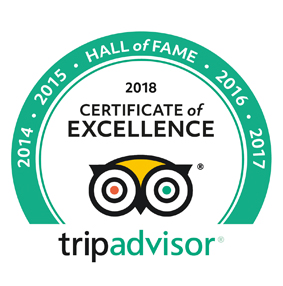
Adventure Great Himalaya Pvt. Ltd. (Private day tours)
Why booking with us ?
- Fully Locally Owned Company
- Quality Of Service and Competitive price
- Highly Professional Staff
- Flexible and customization trip itinerary
- 100% Customer satisfaction
24 hour customer service
You are using an outdated browser. Please upgrade your browser to improve your experience.

Everest base camp 3 passes trek itinerary and price
Everest base camp 3 passes trek itinerary and price -.
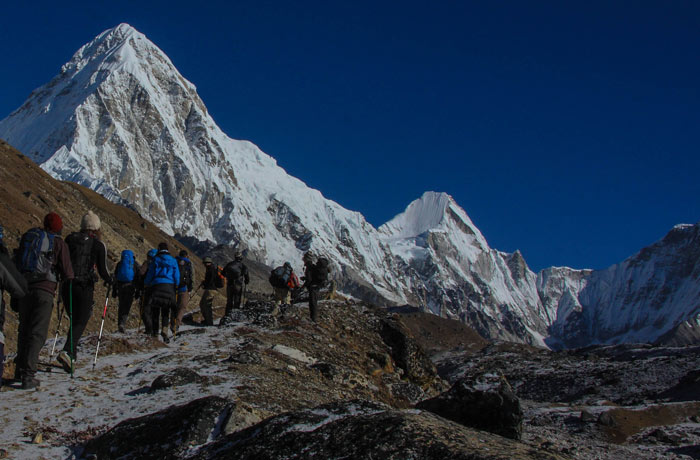
- Trip Overview
The Everest Base Camp 3 Passes Trek is a challenging and rewarding adventure that combines the classic Everest Base Camp trek with the exploration of three high mountain passes: Kongma La Pass, Cho La Pass, and Renjo La Pass. This trek takes you through the stunning landscapes of the Everest region, allowing you to witness breathtaking mountain vistas, remote valleys, glaciers , and traditional Sherpa villages. Here’s a general overview of the trek:
Duration 3 Pass trek from Everest Base Camp: The duration of the Everest Base Camp 3 Passes Trek is typically around 18 to 20 days, including arrival and departure days. This provides ample time for acclimatization, exploring the passes, and reaching Everest Base Camp.
Difficulty Three Pass Trek: The trek is considered challenging due to the high altitudes, steep ascents and descents, and the crossing of three mountain passes. It requires a good level of physical fitness, previous trekking experience, and the ability to acclimatize to high altitudes.
What you will see from the 3 Pass Trek: Everest Base Camp: Reach the iconic Everest Base Camp (5,364m) and marvel at the close-up views of Mt. Everest and surrounding peaks. Three High Mountain Passes: Kongma La Pass (5,535m): Cross this pass, which offers panoramic views of Ama Dablam, Lhotse, and other Himalayan peaks. Cho La Pass (5,420m) : Traverse this pass, surrounded by impressive glaciers, and enter the Gokyo Valley. Renjo La Pass (5,360m): Cross this pass with breathtaking views of Mt. Everest, Mt. Makalu, and other peaks . Gokyo Lakes: Visit the pristine turquoise Gokyo Lakes and hike up Gokyo Ri (5,357m) for stunning panoramic views of the
Sherpa Culture and Villages in Three Pass Trek: Experience the unique Sherpa culture, visit monasteries, and explore traditional Sherpa villages like Namche Bazaar and Thame. Scenic Landscapes: Trek through beautiful landscapes, including lush forests, glacial moraines, rugged terrains, and remote valleys. It’s important to note that the Everest Base Camp 3 Passes Trek requires proper acclimatization and careful preparation. Hiring an experienced guide, ensuring proper gear and equipment, and following a well-planned itinerary are essential for a safe and enjoyable trekking experience.
Trekking costs for 3 pass Trek from Everest Base Camp : The cost of the Everest Base Camp 3 Passes Trek can vary depending on factors such as the trekking agency you choose, the level of services provided, group size, and the inclusion of additional services. Generally, the price range for this trek can range from USD,1,786 to 3,000, USD, or more per person.
Everest Base camp Three pass Trek cost includes: The price typically includes services such as airport transfers, domestic flights to/from Lukla, trekking permits, experienced guide, and porter services, accommodation in teahouses, meals during the trek, and basic medical assistance. However, it’s essential to inquire with different trekking agencies to get specific details about what is included in their package and any additional costs that may apply.
Choose our agency Service: It’s advisable to choose a reputable trekking agency with experienced guides, good reviews, and clear communication to ensure a safe and enjoyable trekking experience.
Necessary Trekking Permits for the Three Pass Trek: To trek in the Everest region, you will need two permits: the Sagarmatha National Park entry permit the Khumbu Rural Municipality entry permit, and the TIMS card.
The best time to do the 3 Pass trek is during the pre-monsoon (spring) season (March to May) and post-monsoon (autumn) season (September to November) when the weather is generally stable and offers clear mountain views. However, it’s important to check weather conditions and be prepared for changes in high-altitude environments.
Accommodation along the trekking route is available in teahouses or lodges. These provide basic facilities such as a bed, blanket, and meals. The availability of amenities can vary, but most teahouses offer hot meals, showers (for a fee), and charging facilities for electronic devices.
Toilet and Bathroom Service Three Pass Trek: On the Everest region trek, shared toilet facilities are more common than en-suite bathrooms. They may be located in the main building or in an outhouse.
Where we eat our dinner during the 3 Pass Trek: Meals are always served in the dining room, so you can meet other trekkers there. In higher accommodations, the dining room usually has a fire around dinnertime. During the Gokyo, Everest base camp 3 Passe trek
Lodge Service During the Trekking Route: Over the first few days, you’ll find hot showers, but chances diminish as you climb up the mountain. As a fuel for cooking and heating, the gas must be transported by mules. but there might be very little pressure under the spray in a cold room. When you reach more than 3,000 meters high you get cold. But hotel people will charge little money for the hitter charge. Drinking water during the Everest base camp 3 Passe trek
Drinking water for during the Trek: You can take boiled water from the lodge which costs 100 -400 Nepali rupees. It is better to use water purification drops and tablets which you can either bring from your country or can buy in Kathmandu.
Food Items in Three Pass Trek: During the tea house lodge trekking, you will find typical foods such as Noodles, Rice, Pasta, Potato dishes, fresh vegetables, eggs, and Chicken items for dinner and Lunch. Breakfast items Tibetan bread, Pancake, muesli, Porridge, and toast with peanut butter. Honey and jam.
Charging Batteries Service during the 3 Pass Trek : In most of the trekking regions, there is electricity whereby you will be able to charge your iPod and Camera batteries but they charge you extra money 100 to 400 Nepali rupees per hour.
If you need communication service during the Trek: In Kathmandu, you can buy Ncell SIM cards almost anywhere. These cards are very helpful when trekking to Everest base camp and Gokyo Valley. In most places, Ncell’s network coverage is excellent, with the exception of the Everest region trekking area.
If wether is bad we do heli service from Kathmandu Lukla to Kathmandu: Our agency will directly do the Everest region trek via helicopter flight from Kathmandu- to Lukla instead of flying Ramechhap-Lukla.
Detailed Itinerary
- Cost Inc / Exc
- Useful Info
Everest Basecamp 3 passe trek cost 1786 $ Per Person Cost Includes
- All ground transports in a private vehicle.
- Full board meals Lunch-dinner Such as Nepali, Indian. Chinese and Italian, much
- more European food. With tea or coffee during the trek.
- Twin sharing lodge to accommodation during the trek.
- One highly experienced helpful and friendly English spiking guide, porters (1
- porter for 2 people) and their food, accommodation, salary.
- Round trip flight Kathmandu-Lukla-Kathmandu.
- Sagarmatha National Park Permits fee.
- Government taxes and office service charges.
- 3 Night hotel in Kathmandu with breakfast Service.
- Pasang Lhamu VCD Entranse fees
Everest base camp 3 passe trek cost Excludes
- Lunch and Dinner in Kathmandu.
- Soft and hard drinks such as Beer, Coke Fanta, Mineral water.
- Your personal insurance policy if the accident and high altitude sickness, rescue and Medication.
- You personal Trekking Equipment.
- Nepal Entry visa fee 15 Days 30 US$ and for the 30 Days 50 US$, you can obtain your visa in Kathmandu airport if you have not taken from your Country.
- Tips for Guide and porter.
- Please don’t forget to bring 2 passport size of pictures with you.
September to 10 November and March to May
Day time normal and during Night 5-15 degree.
Khumbu high pass trekking cost (US$ 1840) per person + Kathmandu, Lukla to Kathmandu Flight ticket cost 360 US$ P/P
Sagarmatha National park & Pasang Lhamu VDC permit.
Yes, If you take a Guide and porter then very safe trip all the trekking in Nepal. It is better to book your trip with an agency if something happens then easy to solve any problem and full responsibility from Trekking agency.
There is every village has a clean lodge with dining and toilet also the wife.
Chinese, Nepali, Tibetans, Indian and Italian dish.
5/8 hours walking pear day.
Yes, you can see Thamserku (6,608m), Kusumkangaru (6,367m), Amadablam (6,856m), Island peak (6,189m), Labuche peak (6,119m), Lhotse (8,414m), Everest (8,848m), Pumori (7,861m), and many other mountain views.
Normally, you need to bring with you flowing equipment. +, walking boot If possible Gore tax boot is better. + Warm socks and Gaiters in case of rain or snow. + Day carry bag and Down Jacket. + Sleeping bag and others which are not mansions here.
Feels like hangover & Feeling not good/ Headache/ Shortness of Breath/ Loss of appetite/ Sleep not good/ vomiting/ fevers etc.
Yes, if a woman travels alone to Nepal no problem but you take a guide or porter from a registered trekking agency because the trekking company is fully responsible for trekking and Mountain climbing. Our agency staff always take care of you, and they will provide you a single room single tent during the tea house trek and during the climbing trek. But if you contact freelance Guide then you get many problems they try to make chit for a single woman. Therefore if you book guide porter with un agency then it is good safe your Holyday travel to Nepal.
Altitude Chart
- About Nepal
- Embassies and Consulates
- Nepal peak climbing Permits Costs per Person
- NMA Peak Climbing Rules
- Trekking permit fee Nepal
- Trekking information nepal
- What is trekking in Nepal?
- Nepali Local tradition
- Information about Nepal
- Equipment list for Nepal Trekking & Climbing
- Kathmandu with the heritage site
- Entry Procedure
- Passport & Visa Information
Nepal Alsace Treks & Expedition
- Weekend +91 87 6262 3333
- Himalayan +91 9886 444 809
- International +91 84968 85968
- [email protected]
- One Day Treks
- Two Day Treks
- Himalayan Treks
- International Treks
- Private Treks
- Group Adventures
![Everest Base Camp Three Passes Trek [Premium] - Tour Everest Base Camp Three Passes Trek [Premium] - Tour](https://vl-prod-static.b-cdn.net/system/images/000/704/572/7ae2eff04ac3f734e569e9624dbd5926/x600gt/IMG_4773.JPG?1706587840)
- Everest Base Camp Three Passes Trek [Premium]
- Secure & Easy Booking
- Best Price Guaranteed
- 1000+ Happy Customers
Secure your registration with just a 20% deposit today and pay the remainder 30 days before the departure date. Your journey awaits! ✈️
Everest Base Camp Three Pass Trek: A Journey of Peaks and Passes
The Everest Base Camp Three Pass Trek is an awe-inspiring journey that takes trekkers through some of the most spectacular and challenging landscapes of the Everest region. This unique trek combines the classic Everest Base Camp route with the adventure of crossing three high mountain passes Kongma La, Cho La, and Renjo La . As you traverse these rugged passes, you'll be treated to unparalleled views of towering Himalayan peaks, including Everest itself. The trek not only offers an up-close encounter with the world's highest mountain but also immerses trekkers in the rich Sherpa culture, quaint villages, and diverse ecosystems that make this region truly remarkable.
Flora and Fauna Along the Route: A Living Canvas of Biodiversity
The Everest Base Camp Three Pass Trek is not only a feast for the eyes but also a haven for biodiversity enthusiasts. The trail winds through various ecological zones, from lush forests of rhododendron, pine, and fir in the lower regions to alpine meadows and barren landscapes at higher altitudes. Along the way, lucky trekkers might spot Himalayan wildlife such as the elusive snow leopard, Himalayan thar, and red panda. The skies above are often filled with the graceful flight of colourful pheasants, while the mountainsides echo with the calls of birds like the Himalayan monal.
Why Choose the Everest Base Camp Three Pass Trek?
The Everest Base Camp Three Pass Trek is a dream come true for adventure seekers and nature enthusiasts. This trek offers the perfect blend of physical challenge, cultural immersion, and unparalleled natural beauty. By completing three high mountain passes, trekkers experience a sense of accomplishment and personal growth while being rewarded with breathtaking panoramas at every turn. Along with three passes you also get to do 3 summits above 5,000m - Chhukung Ri, Kalapatthar and Gokyo Ri. The journey through traditional Sherpa villages provides a deep insight into the local way of life, and interactions with warm and welcoming villagers enrich the trekking experience. If you're seeking a trek that goes beyond the ordinary, pushes your limits and rewards you with memories to last a lifetime, the Everest Base Camp Three Pass Trek is the ultimate choice.
Ideal Trekkers for this Epic Three Passes Trek
The Everest Base Camp Three Pass Trek is suitable for trekkers with a moderate to high level of fitness and a sense of adventure. Prior trekking experience at altitude is recommended due to the challenging nature of the high passes. Trekkers should be prepared for changing weather conditions and be equipped with proper gear. This trek is a perfect match for those who seek a more comprehensive and challenging Everest experience, away from the crowds of the standard routes. If you're passionate about mountains, biodiversity, culture, and pushing your boundaries, this trek promises an unforgettable journey through the heart of the Everest region.
- Scenic flight to the mountain village of Lukla
- 3 high-altitude mountain passes Kongma La, Cho La, and Renjo La
- 3 high-altitude mountain peaks Chhukung Ri, Kalapatthar and Gokyo Ri
- 5 Night stay in Kathmandu at a 3-star hotel with breakfast
- Rest easy at comfortable eco-lodges/guest houses/tea houses during the trek
- All meals, beverages and mineral water included
- Hike through small Sherpa villages and experience their exciting culture
- Get up close and personal with the very famous Khumbu Glacier
- Visit the popular Tengboche Monastery
- Stand face to face with Mount Everest, “Goddess Mother of the Earth,” from the attainable high-point of Kala Patthar and marvel at the stunning views
You need more information?
Ebc trek itinerary in brief:.
- Day 1: Arrive at Kathmandu
- Day 2: Meet and greet / Gear Check. Travel from Kathmandu to Ramachep. Stay at Ramechhap.
- Day 3: Fly from Ramachep to Lukla, Trek to Phakding
- Day 4: Trek from Phakding to Namche Bazaar
- Day 5: Acclimatisation Day at Namche Bazaar
- Day 6: Trek from Namche Bazar to Tengboche
- Day 7: Trek from Tengboche to Dingboche
- Day 8: Trek From Dingboche To Chhukung (4750 M)
- Day 9: Acclimatisation Hike to Chhukung Ri
- Day 10: Trek From Chhukung And Cross Kongma La (5535 M) To Lobuche (4940 M) (6-7 Hours)
- Day 11: Trek from Lobuche to Gorak Shep and then trek to Everest Base Camp
- Day 12: Sunrise trek to Kalapatthar Back To Dzongla (4830 M) 7-8 hours
- Day 13: Trek From Dzongla To Cho La Pass (5368 M) To Thangnak (4680 M) To Gokyo (4800 M) 7- 8 Hours Trek
- Day 14: Rest Day In Gokyo (hike Up To Gokyo Ri 5357 M)
- Day 15: Trek From Gokyo To Renjo La (5360 M) To Marlung (4210 M) 7-8 Hours Trek
- Day 16: Trek From Marlung To Namche Bazaar (5-6 Hours Trek)
- Day 17: Trek from Namche Bazaar to Lukla
- Day 18: Fly from Lukla to Ramachep. Travel from Ramachep to Kathmandu.
- Day 19: Sightseeing at Kathmandu / Buffer day
- Day 20: Departure from Kathmandu
Everest Base Camp Trek Detailed Itinerary:
Day 1: Arrive at Kathmandu
Altitude: 1,400 meters
Activities: Arrival in Kathmandu, check-in to accommodation, rest, and explore local surroundings.
Welcome to the vibrant city of Kathmandu! As you step off the plane, you'll feel the buzz of this culturally rich capital city. Check into your accommodation and take in the local sights, sounds, and flavors. Explore the bustling streets of Thamel, known for its shops and eateries offering a variety of trekking gear and local delicacies.
Day 2: Meet and Greet / Gear Check. Travel from Kathmandu to Ramachhap. Stay at Ramechhap.
Activities: Briefing on the upcoming trek, gear check, final preparations, and last-minute shopping if needed.
Today is dedicated to preparations. Meet your trekking group and guides. Engage in a comprehensive gear check to ensure you're equipped for the adventure ahead. Kathmandu offers last-minute shopping opportunities for any essentials you might need. By noon travel to Ramechhap from Kathmandu and get a good night's sleep before you start your exciting journey.
Important Notice:
We'd like to bring to your attention a crucial update regarding your upcoming journey with TrekNomads. Due to ongoing developments and essential maintenance at Kathmandu Tribhuvan Airport, your flight to Lukla will be rerouted from Kathmandu to Ramechhap Airport. The Civil Aviation Authority of Nepal (CAAN) has mandated that flights to and from Lukla operate through Ramechhap since the 2019 post-monsoon season. This arrangement, initially temporary, has been extended, and CAAN is considering a permanent shift for all Lukla flights from Ramechhap. While some flights will certainly still go from Kathmandu, they are not always guaranteed, even when booked in advance and can be subject to unplanned and prolonged delays. If your flight departs from Ramechhap Airport, your journey will commence on day two of your itinerary. You will travel for four to five hours to the town of Ramechhap, where TrekNomads will arrange accommodation and an evening meal. While the roads may be bumpy, this journey is essential to ensure your Everest Base Camp dream becomes a reality. Day three begins with an early start to be at the airport and a flight to Lukla. TrekNomads ensures you're on one of the first flights from Ramechhap, allowing for the best available weather monitoring and a swift start to your trek.
On the return, you'll fly from Lukla to Ramechhap and embark on an adventurous drive back to Kathmandu. Please note that traffic entering Kathmandu can be significant, extending the journey to approximately six to seven hours with breaks for food and rest.
Day 3: Fly from Ramachhap to Lukla, Trek to Phakding
Altitude: Lukla (2,800 meters), Phakding (2,650 meters) Trek Distance: Approximately 8 kilometres Duration: 3-4 hours Terrain: Gentle trail, suspension bridges, Dudh Koshi river views. Highlights: Thrilling Lukla flight, start of the trek, lush landscapes, suspension bridge crossings.
Begin your journey by flying to Lukla, a gateway to the Everest region. The thrilling flight offers spectacular views of the Himalayas. Upon landing, embark on a trek to Phakding, crossing the iconic Hillary Suspension Bridge over the Dudh Koshi River. Immerse yourself in lush landscapes and the warm hospitality of the Sherpa people.
Day 4: Trek from Phakding to Namche Bazaar
Altitude: Namche Bazaar (3,440 meters) Trek Distance: About 11 kilometres Duration: 5-6 hours Terrain: Steep uphill, rhododendron forests Highlights: Entry to Sagarmatha National Park, panoramic views, bustling Namche Bazaar.
The trail takes you through Sagarmatha National Park, a UNESCO World Heritage site. As you ascend, you'll be greeted by panoramic views of Everest and neighbouring peaks. Namche Bazaar, a vibrant Himalayan town, offers a blend of Sherpa culture and modern amenities.
Day 5: Acclimatization Day at Namche Bazaar
Altitude: 3,800 meters
Activities: Short hikes for acclimatization, visit to Everest View Hotel and explore the local culture.
Spend a day acclimatizing to the higher altitude. Explore Namche Bazaar, visit the local market, and hike to the Everest View Hotel for breathtaking sunrise vistas. This aids in adapting to the altitude, enhancing your trekking experience.
Day 6: Trek from Namche Bazaar to Tengboche
Altitude: Tengboche (3,860 meters) Trek Distance: Around 10 kilometres Duration: 5-6 hours Terrain: Ascending trails, pine and rhododendron forests Highlights: Views of Everest, Ama Dablam, Tengboche Monastery's serenity.
The journey towards Tengboche Monastery, the spiritual center of the region. Along the way, catch glimpses of Ama Dablam and Everest. Witness a mesmerizing blend of cultural and natural beauty at Tengboche.
Day 7: Trek from Tengboche to Dingboche
Altitude: Dingboche (4,410 meters) Trek Distance: Approximately 12 kilometres Duration: 5-6 hours Terrain: Alpine meadows, Imja Khola (a tributary of the river Dudh Kosi), gradual ascent. Highlights: Unique mountain views, Dingboche's picturesque setting.
The trail leads you through Pangboche village, with close-up views of towering peaks. As you reach Dingboche, the altitude becomes more noticeable. Enjoy the serenity of the landscape and anticipate the challenges and rewards of higher altitudes.
Day 8: Trek from Dingboche to Chhukung
Altitude: Chhukung (4,750 meters) Trek Distance: About 7 kilometres Duration: 3-4 hours Terrain: Rocky terrain, glacial streams, alpine environment. Highlights: Nangkartshang Peak views, Chhukung's remote charm.
As you approach Chhukung, the surroundings become more rugged and awe-inspiring. Nestled beneath soaring peaks, Chhukung offers a taste of the remote Himalayan wilderness.
Day 9: Acclimatization trek to Summit Chhukung Ri
Altitude: Chhukung Ri (5,550 meters)
Activities: Summit to Chhukung Ri, stunning panoramic views.
An acclimatization trek to summit Chhukung Ri rewards you with panoramic views of Lhotse, Makalu, and surrounding giants. This prepares you for the challenging days ahead.
Day 10: Trek from Chhukung, Cross Kongma La (5,535 M) to Lobuche
Altitude: Lobuche (4,940 meters) Trek Distance: Approximately 11 kilometres Duration: 8-9 hours Terrain: Challenging ascent, glacier crossings. Highlights: Kongma La pass challenge, superb mountain vistas.
Cross the first of the three passes, Kongma La Pass, an exhilarating feat, to reach Lobuche. The pass offers mesmerizing vistas, and Lobuche's proximity to Everest Base Camp heightens the sense of adventure.
Day 11: Trek from Lobuche to Gorak Shep, then to Everest Base Camp
Altitude: Gorak Shep (5,140 meters), Everest Base Camp (5,364 meters) Trek Distance: About 15 kilometres Duration: 8-9 hours Terrain: Glacial moraine, rocky trails, Everest Base Camp. Highlights: EBC accomplishment, Khumbu Icefall, Everest's grandeur.
A remarkable day as you trek to Everest Base Camp. Traverse glacial terrain, reach the iconic destination, and soak in the historic atmosphere surrounded by Himalayan giants.
Day 12: Sunrise Trek to Kalapatthar, Back to Dzongla via Lobuche
Altitude: Kalapatthar (5,545 meters), Dzongla (4,830 meters) Trek Distance: Approximately 14 kilometres Duration: 7-8 hours Terrain: Steep ascent to Kalapatthar, descent to Dzongla. Highlights: Unparalleled sunrise views of Everest and panoramic Himalayan vistas.
Witness the sunrise from Kalapatthar's summit, offering one of the most awe-inspiring views of Everest. Descend to Dzongla, enjoying the change in landscapes.
Day 13: Trek from Dzongla to Cho La Pass, to Gokyo
Altitude: Cho La Pass (5,368 meters), Gokyo (4,800 meters) Trek Distance: About 12 kilometres Duration: 7-8 hours Terrain: Challenging trail, icy sections on Cho La, glacial lakes. Highlights: Thrilling Cho La Pass crossing, serene Gokyo lakes.
Challenge yourself with the trek over Cho La Pass which would be the second pass of the three passes, which is characterized by steep ascents and descents. Gokyo welcomes you with its tranquil lakes and panoramic vistas.
Day 14: Rest Day in Gokyo, Summit Gokyo Ri
Altitude: Gokyo Ri (5,357 meters)
Spend a day relaxing at Gokyo or summit Gokyo Ri for stunning views of the Everest region. It's a great way to catch your breath and soak in the natural beauty.
Day 15: Trek from Gokyo to Renjo La Pass, to Marlung
Altitude: Renjo La Pass (5,360 meters), Marlung (4,210 meters) Trek Distance: Approximately 15 kilometres Duration: 7-8 hours Terrain: Ascending and descending trails, rocky terrain, alpine landscapes, remote trails. Highlights: Renjo La Pass adventure, off-the-beaten-path scenery.
Trek to the third pass of the three passes Renjo La Pass, a less frequented but equally magnificent pass. Descend to Marlung, surrounded by breathtaking landscapes.
Day 16: Trek from Marlung to Namche Bazaar
Altitude: Namche Bazaar (3,440 meters) Trek Distance: About 16 kilometres Duration: 5-6 hours Terrain: Descending trails, forests, suspension bridges. Highlights: Reliving familiar paths, vibrant Namche Bazaar.
As you retrace your steps, relish the familiar yet transformed landscapes. Arrive at Namche Bazaar, a hub of cultures and a perfect place for reflection.
Day 17: Trek from Namche Bazaar to Lukla
Altitude: Lukla (2,800 meters) Trek Distance: Approximately 18 kilometres Duration: 6-7 hours Terrain: Descending trails, Sherpa villages, Dudh Koshi river. Highlights: Nostalgic return journey, celebrating achievements.
Finish your trek with a descent to Lukla. This day offers a mix of nostalgia and accomplishment, as you bid farewell to the rugged mountains.
Day 18: Fly from Lukla to Ramachep. Travel from Ramachep to Kathmandu
Altitude: Kathmandu (1400 meters)
Activities: Scenic flight, return to Kathmandu, relaxation.
Fly back to Kathmandu, reminiscing about the incredible journey you've undertaken. Return to the comforts of the city and relish a well-deserved rest.
Day 19: Sightseeing at Kathmandu Altitude: 14,00 meters
Activities: Visit UNESCO World Heritage Sites, explore Kathmandu's cultural richness
Explore Kathmandu's rich cultural heritage by visiting iconic sites such as Swayambhunath (Monkey Temple), Boudhanath Stupa, and Pashupatinath Temple. Immerse yourself in the spirituality and history of the region.
Day 20: Buffer Day - Rest or Try Activities like Bungy Jumping/River Rafting
Use this day to rest and rejuvenate, or engage in exciting activities like bungy jumping or river rafting, adding an extra layer of adventure to your journey.
Day 21: Departure from Kathmandu
As your incredible journey comes to an end, depart from Kathmandu with memories that will stay with you forever. Reflect on the challenges you conquered and the breathtaking landscapes you explored in the Everest region.
Everest Base Camp Trek Insurance
Trekking in the Himalayas comes with its own set of risks. While adventure is fun and can be extremely thrilling, nature can be unpredictable, and to help secure you during your trek, it is of utmost importance that you are covered with insurance.
We've gone a step ahead and made sure that you don't have to worry about scouting for the best insurance option out there. When you trek with us, we get you in touch with the best insurance providers who can help you cover your trek to Everest Base Camp with ease. Know more about Everest Base Camp Insurance here .
Everest Base Camp Trek Risk and Liability:
According to Everest base camp trek map, we will endeavor to make your program smooth and as pleasant as possible. However, the entire course of trekking depends on the ranges of the mighty mountains, physical health, and environmental conditions. Therefore, TrekNomads shall not be responsible for any changes in the itineraries due to unavoidable circumstances and natural disasters such as landslide, road blockage, flood, snowing, cancellation of flight and delay, any types of sickness including altitude sickness.
Everest Base Camp Trek - What to Expect:
The Everest Base Camp trek is a challenging trek that requires prior Himalayan trekking experience. During the course, we will trek 4 to 10 hours per day on moderate to steep grades, at varied elevations. Some days will be rest days with optional hikes to properly acclimatize, while on other days you will continue your journey towards EBC. Your Trek Captain will set a suitable pace to minimize the risk of altitude issues. Porters and pack animals will transport your gear. A signed medical consent form from your doctor will be required for participation. You will also be required to sign an indemnity bond before heading on the trek.
Everest Base Camp Trek Fitness Criteria:
This trek requires a good level of fitness.
To register for this trek you are required to complete any of the below-mentioned fitness criteria.
5K run in 35 minutes or Cycling 10 km in 40 mins or Swimming 1 km in 40 mins or Stair climbing 50 floors (10 floors up and down 5 times) in 30 mins.
Once you do register, please share the proof of fitness criteria with your Trek Captain anytime 30 days before departure.
If you're not already following a fitness regime, you would need to follow the regime that will be shared with you. The training routine is spread over four months and you would be expected to work out at least 4 times a week. The regime is designed to help you climb smarter even in higher altitudes. The regime consists of a good combination of exercises that work on all parts of your body including the upper Body, Core, Endurance, Lower Body, Shoulder strength and improving your breathing pattern. When followed religiously, you can be assured that you will be ready for the trek. Not only does this regime help you with the trek, but it will also help you inculcate a sense of fitness in your day-to-day life.
Trekkers who have already trekked in the same route or have trekked at a similar altitude (highest altitude of this trek) or even higher, automatically get qualified. However, they would have to get both the Medical Certificate and Indemnity Bond singed as a mandate.
Trekkers who do not qualify the fitness criteria or fail to share the fitness criteria proof have to get both the Medical Certificate and Indemnity Bond singed with the same mentioned in the documents respectively.
Trekkers will not be allowed to join the group if the duly filled, signed and sealed copies of the Medical Certificate and Indemnity Bond are not shared.
Everest Base Camp Trek Trek Gradient:
This trek is graded challenging to extreme because you will be trekking for 13 consecutive days over rough terrain, you will be exposed to increasing altitudes each day, averaging 4,000 m and up to a maximum of 5,545 m.
Your Trek Captain will brief you on the next day's trek every evening so you have ample time to prep and be ready for the climb the next morning. You are expected to wake up at the time told by the Trek Captain. This is highly important because the earlier you start the trek, the faster you can reach the next village.
Being away from home comforts and family for an extended period of time is often a challenge for Nomads although access to communications on the trail is very good overall.
Do’s and Don’ts for Everest Base Camp Trek:
- We believe in leaving the mountains in a better condition, which is why we follow a no-litter policy on our treks. Each trekker will have to bring back the waste that is created during the trek.
- Trekking is best enjoyed when you’ve worn comfortable clothes. Try and avoid wearing Jeans, bright colors and heavy apparels as much as possible.
- A lighter backpack always helps you have a better trek, try and carry just as much as needed.
- Always be in sight of your trek lead, if you feel the need to stop for any reason at all, please keep the trek lead informed.
- If you do come across any reptiles, animals or even insects during the trek, please keep your calm and let it patiently pass by. Any kind of noise and panic will scare them as well.
- Do not venture out into the forest/waterfalls on your own as it may be dangerous.
- Trekking is a good adventure, having said that, it is our primary responsibility to take good care of ourselves and be compassionate towards fellow trekkers
- If, at any point, during the trek, you feel uneasy or unwell, please inform the trek lead immediately
- Tune in to the sounds of nature while on a trek and avoid carrying speakers or playing music during the course of the trek
- To help you enjoy the trek to the fullest, we avoid smoking and consumption of alcohol, and other intoxicants during the course of the trek
What is included in the tour
- Arrival and departure transfer to the international and domestic airport in a private vehicle
- Ramachep / Lukla / Ramachep domestic airfares
- Kathmandu/ Ramachep / Kathmandu transport in a private vehicle
- 1 welcome dinner and 1 farewell dinner
- 03 Nights accommodation at Kathmandu at a 3-star category hotel with breakfast on a twin-sharing basis
- 01 night accommodation at Ramechhap at a deluxe hotel or resort
- 15 Nights of accommodation in TeaHouses during the trek on a twin-sharing basis
- Accommodation with attached bathrooms is provided wherever it is available
- Three meals a day during the trekking period (open menu to choose any one item per meal from the menu)
- Three times tea or coffee or ginger-lemon-honey during the trekking period
- 2 litres of mineral water during the trek, per person per day
- 16 days of trekking with an experienced, English-speaking and government-licensed trek guide and assistant trek guide
- 1 porter for every 2 persons’ luggage (max 10-12 kgs per head allowed)
- Insurance, meals, transportation daily salary of guide & porter
- Sagarmatha National Park Fees, Trekking Permits and TIMS (Trekkers’ Information Management System)
- Domestic airport taxes at Kathmandu and Lukla
- 3 litres oxygen cylinder with mask regulator for emergency (additional charge if used)
- Kathmandu sightseeing with a van and a guide full day for Pashupatinath – Bhaudhanath – Monkey temple – Patan Darbar Square
- All government, local taxes and service charges
- TrekNomads Fee, Trek Captain support and expertise
- 10% discount coupon on Fast&Up products
- 20% discount coupon on BMore products
- Personalized Dri-Fit T-shirt
- Expedition grade duffle bag
- TrekNomads goodies
What is NOT included in the tour
- International airfare
- Nepal Visa fee
- Lunch & Dinner at Kathmandu
- Any personal expense
- Personal Adventure Insurance
- Excess baggage charge(s)
- Insurance Fee
- Any type of soft drinks
- Boiled hot water, shower, etc, during the trek
- Extra meals apart from inclusions
- Tips to porters and guides (calculated per person on 10$ per day per person)
- Any other activity such as Bungee Jumping/River Rafting
- Helicopter fares
- Transportation to and fro Ramechhap in case of early return from the trek
- Extra days at the hotel in Kathmandu apart from the schedule
- Any other expenses incurred apart from inclusions
- All personal, medical, evacuation and emergency expenses like extra day stay out of itinerary, helicopter services and vehicle charges due to delays, landslides, evacuation
- Expenses incurred for guide or porter during extra days stay, transport, flight, helicopter service, etc (divided amongst the group which utilises the services of guides/porters on extra days)
Altitude Map:
- Lukla: 9,313 ft (2,840 m)
- Phakding: 8,562 ft (2,610 m)
- Namche Bazaar: 11,286 ft (3,440 m)
- Tengboche: 12,700 ft (3,870 m)
- Dingboche: 14,470 ft (4,410 m)
- Chukung: 15,584 ft (4,750 m)
- Chukung Ri: 18,209 ft (5,550 m)
- Kongma La: 18,159 ft (5,535 m)
- Lobuche: 16,210 ft (4,940 m)
- Gorakshep: 16,942 ft (5,164 m)
- Everest Base Camp: 17,595 ft (5,363 m)
- Kala Patthar Peak: 18,192 ft (5,545 m)
- Dzongla: 15,846 ft (4,830 m)
- Cho La: 17,612 ft (5,368 m)
- Gokyo: 15,748 ft (4,800 m)
- Gokyo Ri: 17,575 ft (5,357 m)
- Renjo La: 17,585 ft (5,360 m)
- Marlung: 13,812 ft (4,210 m)
Other Details:
- Trek Gradient: Difficult
- Trek Distance: 180+ Km
- Assembling Point: Kathmandu
- Trek Duration: 95+ hours
- Average Temperature: 20°C to -10°C
- Best Months to trek: April, May, September, October, November
Everest Base Camp FAQs
What is everest base camp what route should i take on the everest base camp trek.
The Everest Base Camp is either one of two base camps on either side of Mount Everest. South Base Camp is located in Nepal at an altitude of 5,364m and North Base Camp is at 5,5150m in Tibet. These camps are primarily used by mountaineers to ascend and descend the World's highest mountain.
The classic and most popular route to Everest Base Camp starts at Lukla and continues through Phakding, Namche Bazaar, Tengboche, Dingboche, Lobuche, Gorak Shep and Everest Base Camp. This Everest Base Camp route is extremely popular and almost 95% of the trekkers and Everest summiteers take this route.
The other route is to Everest Base Camp via Gokyo Ri and Chola Pass . This route is slightly more difficult and longer. This route offers spectacular views of the Gokyo Lakes and the opportunity to summit Gokyo Ri (17,575 Feet / 5,357 M) and cross Chola Pass (17,782 Feet / 5,420 m).
Does this trek require any kind of training? If yes, what is the fitness regimen to be followed?
Yes. This trek necessitates a good level of fitness. If you don't already have a fitness regimen, we suggest you start as soon as possible. You should work out at least four times a week. Training well in advance will help you climb better and more efficiently.
Your workout regimen should consist of a good combination of exercises that work on all body parts, such as your upper body, core, endurance, lower body, and shoulder strength. Working out will help streamline your breathing pattern as well. If you train consistently, you can be confident that you will finish the trek safely.
We suggest that you indulge more in cardiovascular exercises and focus on building your leg muscles by jogging, running and stair climbing. Practice running/jogging on different terrains. This can be done by going on a hike on a nearby hill. Practising walking uphill and downhill is extremely important. More detailed tips are shared in this blog .
Are your staff equipped/trained & insured?
Yes! Our guides and porters are fully trained, equipped and provided for. Our Trek Captain comes with the experience of doing the EBC trek priorly. Every member in a trekking group work as a team and take care of each other's responsibility.
Is there an age limit to do the Everest Base Camp Trek?
No, there is no age limit for Everest Base Camp trekking but, you need to be in good physical shape with a positive attitude. We also suggest you to prior to the trek though we suggest you to please see your doctor and obtain necessary permission and advice, as well as medications for traveling in extreme altitude prior to the trek.
Are there any fitness criteria for this trek? If yes, what are those and how to achieve them?
Yes, we have kept very simple easily achievable fitness criteria. In order to qualify our fitness criteria you should either complete a 5K run in 35 minutes or Cycling 10kms in 40 mins or Swimming 1 km in 40 mins or Stair climb 50 floors (10 floors up and down 5 times) in 30 mins. Any fitness app proof would suffice to qualify. We will also assist you with a fitness training program for free and guide you in getting fit to complete this trek.
Our fitness criteria are not a blocker or to stop people from joining this trek. However, it is a conscious effort to make sure you have a comfortable and memorable experience during the trek.
NOTE: Trekkers who have already trekked in the same route or have trekked at a similar altitude (highest altitude of this trek) or even higher automatically get qualified.
Is acclimatisation essential for the Everest Base Camp trek?
Acclimatization is essential because Everest Base Camp is at an altitude of (17,595 ft / 5,363 m) where oxygen levels are low. You might get Acute Mountain Sickness if you don't acclimatise properly to the high altitude. Acute Mountain Sickness is also known as AMS in trekking parlance. Namche Bazaar and Dingboche(11,286 ft / 3,440 m) are where you will stay for an extra day for acclimatization.
You can spend the day visiting the Everest viewpoint or relaxing and exploring Namche Bazaar. It is in the main centre of the Everest (Khumbu) region and has government offices, shops, restaurants, a bakery, ATMs, cyber cafes, and a beautiful market.
At Dingboche, you will go on a hike to Nangkartshang Peak (5,615 M) It takes about 2-3 hours hike from Dingboche to reach the top of Nangkartshang Peak. You will get the best view of Imja Valley including the three highest mountains in the world Mt. Makalu (8,463m), Lhotse (8,749m), Cho Oyu (8,201m) and Island peak (6,189m), Amadablam (6,812m), Kangtega (6,782m), Thamserku (6,623m), Taboche (6,542m), Cholatse (6,440m), etc.
Physical fitness can help prevent AMS to some level but does not rule it out completely.
Read about AMS here .
What if I get Acute Mountain Sickness on the Everest Base Camp trek? Are there any medicines to cure AMS?
The best way to avoid AMS is to follow simple tips before and during the trek.
Avoid over-exerting yourself at the beginning of the trek. Climb slow, and enjoy the views. Trekking is not a race.
Drink plenty of water. Try to drink at least 3-4 litres of water during the trek. Follow the 2-sip rule - after every few hundred metres, take 2-3 sips of water.
NO Alcohol, Cigarettes and intoxicants before and during the trek. (These are things to avoid after the trek as well.) This increases your risk of getting AMS multifold.
Eat lite and easy-to-digest foods - fruits, vegetables, and carbohydrates (rice, daal). Avoid fried foods, bread, noodles, and non-vegetarian items during the trek. These can cause stomach upset - which can cause dehydration and AMS. Also avoid any yak milk products during the trek if you haven’t tried them before.
Get enough sleep - Sleep for at least 8-9 hours during the night.
Check medicines with your doctor before taking them. Avoid over the counter drugs. Avoid medicines suggested by fellow trekkers, online blogs or google - unless you are very sure about it. You may never know how medicines may react to your body at high altitudes.
Make sure you are physically and mentally fit to take any trek. Exercise regularly at least 5-6 months in advance, reduce stress levels and be healthy.
Some of the symptoms you can experience when you have AMS are:
Disturbed sleep
Loss of appetite/nausea
Shortness of breath
Palpitation
Swelling of the hands and face
AMS does not discriminate between new and experienced trekkers; if you notice any of the above symptoms, please inform your trek leader immediately.
Our trek leaders and guides have received basic first-aid training and can effectively monitor you. However, if the situation gets worse, you might have to visit a doctor.
Do I need to carry a medical kit on the Everest Base camp trek?
We advise you to consult your doctor regarding the medicines you will need to carry. However, while our trek leaders do have a first aid kit along with a portable oxygen cylinder, we suggest you bring regular medicines as advised by your doctor.
Are toilets/washrooms available on the Everest base camp trek?
Most of the teahouses on the Everest Base Camp trail have western-style toilets. It is strongly advised to bring your toilet paper and other sanitary essentials. Depending on the package you choose, you may get a private (in the room) or shared toilet in the tea house. Please note that the water in the toilets may be freezing cold.
How do I get the Nepal Visa for the Everest Base Camp trek?
Indians do not require a visa to enter Nepal. Citizens of countries other than India will be required to purchase a Visa. The Visa fee can range between USD 30 and USD 50, depending on the days you must stay in Nepal. We always recommend getting a 30-day visa because there is a chance of unprecedented delays and setbacks during the trek.
Are ATMs on the Everest Base Camp trek?
ATMs are only available in Namche Bazaar and Lukla. However, the services may stop working or even run out of cash. So, we suggest you bring some extra cash on the trek for food, snacks, and other necessities.
What is the perfect time to trek to EBC?
You can trek to Everest Base Camp during two seasons. The first period runs from April to May (Spring), and the second from October to November (Autumn). The latter is considered a post-monsoon period, with fewer chances of rain along the trail. During the autumn, the Sagarmatha region is in full bloom, providing beautiful picturesque views for you to enjoy. During the spring season, many indigenous flowers also put on a colourful sight.
Read more about the best time to do the EBC trek here !
What is the Everest base camp trek cost? How can I book the Everest base camp trek package?
Mount Everest base camp trek cost from Kathmandu with TrekNomads is ₹88,799 per person. To get more details about our mount Everest base camp package , you can reach out to us on [email protected].
Loading the map...
- RAZORPAY EMI PAYMENT METHOD
- CONNECT WITH US
- TREKNICAL DETAILS

Recognitions

OTHER POPULAR TOURS
![Valley of Flowers Trek and Hemkund Sahib [Premium] - Tour Valley of Flowers Trek and Hemkund Sahib [Premium] - Tour](https://vl-prod-static.b-cdn.net/system/images/000/326/464/f004eeac1383bb5aea2b18eb9400c343/x400gt/VOF_Banner.png?1684915067)
Valley of Flowers Trek and Hemkund Sahib [Premium]
![Everest Base Camp Trek [Premium] - Tour Everest Base Camp Trek [Premium] - Tour](https://vl-prod-static.b-cdn.net/system/images/000/352/493/2f06596a5543585d0f67bc5c9eabe2dd/x400gt/Everest_Base_Camp.png?1684317973)
Everest Base Camp Trek [Premium]
![Kashmir Great Lakes Trek [Premium] - Tour Kashmir Great Lakes Trek [Premium] - Tour](https://vl-prod-static.b-cdn.net/system/images/000/414/735/bed5a46f080cd0e89659ed19c0c6d7aa/x400gt/TrekNomads_Website_Banner__13_.png?1684931452)
Kashmir Great Lakes Trek [Premium]
OTHER ACTIVITIES

- Testimonials
- Customized Private Treks
- Corporate Outings
- Cancellation Policy
Online booking system by Vacation Labs | © 2024 TrekNomads
- 0 Shopping Cart ₹ 0.00 -->

EBC THREE PASSES
5600 meters | nepal, 23 october ’23, easy – moderate, april – may, sept – oct.

The Everest Base Camp three passes trek is a challenging and exciting journey that takes trekkers through three high mountain passes in the Khumbu region of Nepal. This route offers a complete journey through the Everest region, combining highlights of mountain views and local Sherpa culture. It is considered one of the toughest treks in the Everest Region, and trekkers cross three high passes, Kongma La, Cho La, and Renjo La, hence the name Three Passes Trek.
Throughout this trek, trekkers will experience changing sceneries, from lush montane forests to snow-covered lands, offering varied visual experiences. Moreover, trekkers will witness some of the most enormous and beautiful mountains such as Cho Oyu, Lhotse, Nuptse, Makalu, Ama Dablam, and many more nameless peaks located in the Khumbu region. This region is known for being the most intensive mountain region, where more than 200 peaks are higher than 6000m.
The Everest Base Camp three passes trek requires a high level of fitness, endurance, and some previous trekking experience. Trekkers need to be prepared to face harsh weather conditions, including extreme cold, strong winds, and snowstorms.
Once the team member reaches the base camp, they are rewarded with climbing dry fit t-shirts, and upon reaching the summit of Nangkarshang or Kalapatthar, they receive a buff. Moreover, on return, they receive a summit certificate and medal. The rewards of completing this trek are immense, offering a once-in-a-lifetime opportunity to witness some of the most spectacular natural landscapes on earth and experience the unique culture and traditions of the Sherpa people.
NOTE: The pricing mentioned above is applicable exclusively for Indian passport holders. For individuals holding non-Indian passports, there is an additional charge of INR 15,000.
Day 1: Arrival in Kathmandu (1345m), city tour, sightseeing, shopping & final preparations.
Day 2: Fly to Lukla (2840m) & trek to Phakding (2610m) / Ghat (2695m)
Day 3: Trek from Ghat/Phakding to Namche (3440m)
Day 4: Trek to Everest View Hotel & Everest Museum
Day 5: Trek from Namche to Deboche (3860m)
Day 6: Trek from Deboche to Dingboche (4430m)
Day 7: Acclimatization hike to Nangakarshang (5066m) and back to Dingboche.
Day 8: Trek from Dingboche to Chukhung (4730m)
Day 9: Trek from Chukhung to Lobuche (4910m)
Day 10: Trek to EBC (5364m) & Gorakshep (5140m)
Day 11: Trek from Gorakshep to Kalapatthar (5550m) & dzongla (4830m)
Day 12: Trek from Dzongla to Draknak
Day 13: Trek from Draknak to Gokyo (5000m)
Day 14: Trek from Gokyo rest day
Day 15: Trek from Gokyo to Renjo pass (5360m) to Lumden (4370m)
Day 16: Trek from Lumden to Namche
Day 17: Trek from Namche to Lukla
Day 18: Lukla to Kathmandu
Day 19: Sightseeing around Kathmandu
Day 20: Fly back to home from Kathmandu
Day 21: Buffer day
- All necessary airport arrival departures
- 4 nights hotel in Kathmandu with bed and breakfast plan
- Flight fare from Kathmandu – Lukla – Kathmandu for members
- Flight fare from Kathmandu – Lukla – Kathmandu for guides, porter
- Domestic airport departure taxes
- Best available tea house accommodation & food. Per person, one item from the menu is allowed during all meals of the day (breakfast, lunch & dinner). Order more at your own cost.
- Drinking water
- English speaking trekking guide and his salary
- Porter to carry luggage during trekking
- All necessary permits required for trekking
- City tour transport, tour guide, entry permit in Kathmandu as per itinerary
- Insurance for Nepalese staff
- Participants will get an exclusive discount on all Fast&Up products
- Lunch and dinner in Kathmandu (except farewell dinner)
- Boiled water, Beverages & alcoholic drinks
- Emergency medical evacuation
- Tips for staffs
- Personal expenses and extra services beyond itinerary
- Personal gear including sleeping bag.
- (Sleeping bag & down jacket can be hired)
- Personal Insurance
- Any expenses not mentioned in the inclusions
- INR 3000 extra will be charged if the flight takes off from Ramechhap instead of Kathmandu.
FREQUENTLY ASKED QUESTIONS
Q1) Why does the EBC itinerary have a buffer day?
The one extra day in the itinerary is there to cater for weather/health-related eventualities. If not used during the trek, people prefer spending an extra day either in Namche or Kathmandu to relax and do local sightseeing.
Q2) What extra preparation do I need for the EBC + Gokyo Lake?
In terms of days, trek to Gokyo and back is 3 days extra over the EBC only itinerary. You cross a 5000 + meter pass on way to Gokyo. Overall, for both EBC and EBC + Gokyo, we recommend to maintain good fitness levels which prepares you to walk for 6–7-hour long days throughout.
Q3) Do we need sleeping bags? What kind of accommodation do we get during the trek?
Throughout the EBC & EBC + Gokyo trek, you will be staying in proper guest houses with beds and attached bathrooms. You will be provided with warm blankets / sleeping bags. However, if you prefer not using the blanket / sleeping bag which may be used by other fellow travelers and prefer your own, you may carry your personal sleeping bag.
Q4) What kind of gear is mandatory?
Check our itinerary pages that have links to the brochure. The file lists the mandatory gear in detail. That is all that you will need. Personal preferences may be extra
Q5) Can I buy clothing & other gear from Kathmandu?
You may only get half a day in Kathmandu before flying out to Lukla. Time to shop and explore will be short. Also, stock of the items / sizes you are looking for may not be available. Hence, we always recommend landing in Kathmandu fully prepared with your gear.
Q6) How long will each day be during the trek?
Most days going UP towards the Everest Base Camp, the duration will be 6-7 hours when walking in a group.
Q7) What are the chances of the Lukla flight getting cancelled, do we keep more buffer days?
In our experience, this is really unpredictable. Be ready for any and all kinds of delays in getting to Lukla. On occasions, we have also faced 2-3 day-long delays in getting to Lukla. Irrespective of the delay you face, our plan will always be to go as per schedule keeping in mind our return flights.
Q8) How cold will it be during the trek?
April & May will be cold at altitudes above 4000 meters. Be prepared to face heavy snow, and blizzards which can take temperatures as low as Minus 15-20 C. On good weather days, during the trek, it will be pleasant and you can comfortably walk in 2 layers – A full sleeves T-shirt & light outer layer.
Q9) How much cash should I carry for the trek?
Depending on your needs and wants, extra spending other than what’s covered in the trek cost can range from 5,000-10,000 ₹ to ten times these amounts or even more. 1 Indian ₹ is equivalent to 1.6 Nepalese ₹. Items like charging the phone/camera batteries are charged @ 200 ₹ per hour. Laundry can be as high as ₹ 400 per piece, in places close to the base camp.
Q10) What kind of things are chargeable during the trek that are not included in the cost?
These are items are not included in the trek cost – Laundry, mineral water bottles, electronic equipment charging, additional food purchases during the stay (packet food), and additional gear purchases in Kathmandu & Namche.
Q11) Should we buy or rent hiking poles?
Trek poles should be bought, these are not expensive. Renting for 15-18 days will cost you more.
Q12) What are the water arrangements during the trek?
All members are required to carry a filter water bottle (Panny, lifestraw, Eureka). This will solve the purpose and cut out the need for buying expensive plastic bottles.
Q13) Do we get to take a bath during EBC?
We don’t recommend this.
Q14) Do we stay in tents during the EBC?
No. The stay will be arranged in proper tea houses in buildings
Q15) What kind of insulation / down jacket do I need?
Carry a down jacket that can keep you warm in Minus 20-25 C temperatures.
Q16) What kind of trekking shoes should I wear? How many do I need?
Mid – high ankle length, water proof trekking boots are required for the EBC. One pair is enough if conditions of the shoes are good.
Q17) Do we get cellphone network on the route?
We recommended that you take NCELL SIM card once you land at Kathmandu airport and get it charged. This will work in MOST of the places on the route.
Q18) Is WIFI available during the EBC trek?
WIFI is there at ALL places of stay during the EBC, and its extra chargeable.
Q19) Do we get laundry service during the trek?
You can get your clothes washed at – Namche & Dingboche.
Q20) Which sunscreen do you recommend?
Minimum SPF 50 will be needed for the EBC.
PREPARATION GUIDE
- Have some previous trekking / mountaineering Experience.
- Weight train the body. Walk uphill or stairs steps with a weighted back pack.
- Strength training for the lower body and core. Do planks, crunches and cycling.
- Trekking to EBC requires a fit body and a conscious mind. One needs to be exercising regularly for the past 3-4 months.
- Any high altitude trek requires you to build a good amount of cardiovascular endurance. Jogging is the best exercise to increase your stamina.
- You need strong legs to success fully finish a high altitude trek. Squats are the best way to build leg strength quickly. Especially your thighs, glutes and knees.
- For detailed advice and coordination, we’ll have a WhatsApp group.
YOU MAY ALSO LIKE
Annapurna Base Camp

Mt Kilimanjaro

Gurez (Patalwan)

SHARE THIS PLAN
B&C specializes in providing premium-quality & safe mountaineering experiences around the world. We are committed to protecting & conserving the natural environment in which we operate . Our highly experienced support team & certified guides make for a hassle-free journey throughout.
Important Links
Book a Trek/Expedition Gift A Trek Terms & Conditions Cancellation Policy Sitemap Privacy Policy
Get In Touch
+91 9000 603 444

Nepal Trek Booking Open for 2024/25 (Note: From March, the Lukla flights will be from Ramechhap)
0 RESULTS FOUND!
Everest Three Passes Trek - 17 Days
- Photos/videos
- Cost & Dates
Group Discount Available
**Discounts apply to groups you bring, not those arranged by us.
- Team of highly experienced Experts
- No Booking or Credit Card Fee
- Hassle-Free Booking
- Your Happiness Guaranteed
- Best Price Guarantee
Everest 3 Passes Trek Insights
Everest Three High Passes Trek is the ultimate trek for thrill-seekers and adventurers in the Everest region. In this trek, you will not only reach the Everest Base Camp but also cross the three highest passes in the Khumbu region – Kongma La Pass (5,535/18,159ft), Cho La Pass (5420m/17,782ft), and Renjo La Pass (5,340m/17,520ft).
Highlights of Everest 3 High Passes Trek
- A scenic flight to Lukla
- Spellbinding view of mountains from the three high passes (Kongma La, Cho La & Renjo La)
- Famous Sherpa town in the Everest region - Namche Bazaar
- Nepal's highest airport Syangboche
- Stunning views from Gokyo Ri
- One of the world's highest hotels - Everest Hotel
- Gokyo Lakes
- Ancient monastery in Tengboche
- UNESCO World Heritage Sites
- Prayer wheels, colorful flags, Mani stones, high suspension bridges
- The wide range of flora and fauna
- Wildlife like musk deer, colorful pheasants, snow leopard, and Himalayan Thar
- Highest glacier on Earth- Khumbu Glacier (4900m)
- Amazing panoramic view from Kala Patthar (5,555m)
Benefits of Everest 3 High Passes Trek with DWT
- Free airport pick-up to the hotel on arrival and vice versa on departure in a private vehicle
- Online trip briefing after booking confirmation
- Frequent blood oxygen saturation monitoring using pulse oximeters in high altitudes to recognize early signs of altitude sickness.
- Medical kits as a precaution.
- Easy booking and reservation system
- Multi-channel communication (Email, WhatsApp, Facebook, WeChat, Viber, Skype, Zoom)
- 24/7 phone communication at +977- 9840055491
- Easy payment system.
- Arrangement of sleeping bags and down jackets if you do not have your own
- Free excess luggage storing service during the trekking period
- Duffle bag for porters
Online Trip Briefing
The online briefing will clear all your doubts about the trek, including things to bring (equipment checklist) for the hike, the itinerary details, and what you can expect on the trails. As soon as you complete the booking, we will email you the available date and time for the trek briefing. Please note that we conduct trip briefing only once either online or in person.
Lukla Flight Information
There might be slight alterations to the trek itinerary, mainly during peak trek seasons (March, April, May, October, and November), as the flight to Lukla will be from Ramechhap/Manthali instead of Kathmandu due to traffic congestion. At other times, the flight will be from Kathmandu. To catch a flight from Ramechhap, we must leave Kathmandu and head to Manthali around 12:30 a.m. on the scheduled departure date. The drive will take around five hours.
Everest Three High Passes Trek Description
Your 17-day Everest Three Passes Trek begins with a breathtaking 45-minute flight from Kathmandu to Lukla (2,840m). After crossing several suspension bridges over the fast-flowing white rivers, you will reach Namche Bazaar (3,440m) the next day. You will stay one more day at Namche Bazaar for acclimatization .
While in Namche Bazaar visit shops, restaurants, and internet cafes. You can also visit nearby monasteries, the chief being Khumjung Monastery. If you want to get views of Mt. Everest , you can hike to Everest View Hotel.
After a rest day at Namche, you will continue the Three High Passes Trek by heading to Thame (3,750m). This is where your path separates from the classic Everest Base Camp Trek as you follow the Bhote Koshi River to reach Thame. You can see a small hydroelectric plant just before arriving at Thame.
The next day, you will wake up at Thame and brace for a long trek towards Lungden (4,500m). The paths are quite challenging, and you must trek for about six hours to reach Lungden.
Then, you will leave Lungden behind and head for the Gokyo Lakes region. Somewhere in between Lungden and Gokyo lies Renjo La Pass (54,35m), the first among the three major passes you will cross.
From Renjo La Pass, you can see amazing views of the Gokyo Lake system and many Himalayan Peaks - including Everest (8,848m), Lhotse (8516m), Makalu (8,481m), Cho Oyu (8,201m), and Ama Dablam (6,812m). You will stay at Gokyo for the night and spend the following day acclimatizing.
As you acclimatize in Gokyo, we will take you to Gokyo Ri (5,483m), from where you can see four of the six highest mountains in the world - Everest (8,848m), Lhotse (8,516m), Makalu (8,485m), and Cho Oyu (8,188m). The scenes from the Gokyo Ri are probably the best in the Everest Region.
Next, you will continue the journey from Gokyo to Thagnak (4,700m), crossing Ngozumpa Glacier. From the trails, you will see yak pastures or lucky yaks grazing on them.
The next day's destination is Dzongla (4,855m), and Cho La Pass (5,420m) lies on the way. You will cross the Chola Pass, the second major pass in this trek. This pass connects the Gokyo and Everest regions.
By crossing Cho La Pass, you have entered the Everest region, and you will reach Everest Base Camp, but you will have to stop in two places - Lobuche (4,910m) and Gorak Shep (5,185m).
The eleventh day of the trek is going to be extraordinary. You will wake up at Lobuche (4,930m) and head to Gorak Shep (5,185m). After reaching Gorak Shep, you will leave your belongings and head to the Everest Base Camp (5,364m). Stepping on Everest is a huge achievement, as reaching Everest requires conquering the harsh terrain, high altitude, and challenging climate.
After spending time on EBC, we will descend to Gorak Shep and spend the night there. The following morning, you will wake up at Gorak Shep and trek to Kala Patthar (5,555m), from where you can catch the heavenly sights of dawn-breaking Mt. Everest. You will soak in the incredible scenery from Kala Patthar, get back to Gorak Shep, and finally descend to Lobuche to spend the night.
The following morning, we will wake you up at Lobuche and trek to Chhukung (4,730m), and in between lies Kongma La Pass (5,535m) - the last of our three major passes. It is also the highest pass among the three passes and is challenging. However, remember that the more challenging a trek is, the more rewards you will reap.
On the fourteenth day of the Everest 3-pass trek, you will leave Chhukung and to Tengboche (3,855m) and pass Dingboche and Pangboche on the way. The path allows you to see some of the spectacular scenes of Amadablam (6856m), Everest (8848 m), Nuptse (7861m), and Lhotse (8501m). We will not forget to visit the famous Tengboche monastery as well.
The next day's trek will take you back to Namche Bazaar. The way is uneven and passes through dense forest, and if you are lucky, you can get glimpses of Himalayan pheasants, musk deer, mountain goats, or even snow leopards.
On the last day of the Everest Three High Passes Trek trails, you will head from Namche to Lukla. We return to Dudh Koshi Valley, cross Hillary Suspension Bridge, and trek for about seven hours to reach Lukla. You will be staying in Lukla for the night. Your Everest Three Passes Trek in the Everest region is almost over, and you are just a night away from returning to Kathmandu.
On your seventeenth day, in the morning, you will board a plane back to Kathmandu. You will leave the Everest region behind with fresh memories, new experiences, and perhaps a new way of thinking. For a complete Three-pass trek itinerary, please see the section below.
Why Everest Three Passes Trek?
The Everest 3 High Passes Trek (or 3 pass trek) is one of the most adventurous treks in the world that takes you deep into the Everest region. You get to see what lies around Everest and how the geography elevates to give rise to the world's highest mountain. The trek is challenging and provides a more detailed picture of the harsh terrain, cold climate, and constant human struggle in high altitudes. All in all, the Three Passes Trek distance is 103 miles (166km).
DWT recommends all our valuable clients arrive at Kathmandu as early as possible, at least one day before the trek departure date, for last-minute preparations. If in case you missed the online trip briefing, it will allow us time to conduct an in-person briefing. The flight from Kathmandu to Lukla and Lukla to Kathmandu may get delayed due to the weather. In such cases, we reschedule these flights to the next available flight. So, we suggest our clients add at least 2 extra days as a cushion to the trip to avoid international flight delays back to their home country.
Everest High Passes Trek Experience
Everest three high 3 passes trek itinerary, flight from kathmandu/manthali to lukla (2,850m / 9,350ft) trek to phakding (2,650m / 8,562ft).
Your Everest 3 Passes Trek begins with a flight to Lukla. In the busy trekking seasons (March, April, May, September, October, and November), flights from Kathmandu to Lukla might be redirected through Manthali Airport. To catch the early morning Lukla flight from Manthali, we'll pick you up from your hotel around 12:30 am and take you on a 5-hour drive to Manthali Airport. From Manthali, you will fly for about twenty minutes before stepping on Lukla.
You can hire a helicopter from Kathmandu to Lukla to skip the Kathmandu-Manthali-Lukla route. The cost is around 550 USD per person, provided the helicopter expenses are split among five passengers.
During, December, January, February, June, July, or August, you will directly fly from Kathmandu to Lukla. After breakfast, we'll take you to Tribhuvan International Airport (TIA) for a 40-minute flight to Tenzing Hillary Airport in Lukla.
After arriving at Lukla, you descend to the Thado Koshi River and cross a few suspension bridges before reaching Phakding. The trek will be short and enjoyable as you will also be acclimatizing. In Phakding, we will take you for a visit to the local Rimishung Monastery.
- Overnight stay at Khumbu Travel Lodge, room with attached bathroom
- Included standard meals (Breakfast + Lunch + Dinner)
Trek from Phakding (2,650m /8,562ft ) to Namche Bazaar (3,440m / 11,285ft)
We will begin early in the morning at Phakding and move north along the banks of Dudh Koshi River, passing many suspension bridges -including Hillary Suspension Bridge.
Our path also takes us through Monjo Village , deep forests, and rocky trails to Sagarmatha National Park Check Post, where we will register our permits and climb up into the forest. From this forest, you will see Mt. Everest for the first time. However, we will continue the trek until we reach Namche Bazaar - the destination for the day.
- Overnight stay at Sakura Guest House, room with attached bathroom
Rest day to acclimatize at Namche Bazaar
Today will be an acclimatization day at Namche. We recommend you to explore Namche Bazaar. This town contains numerous Wi-Fi-linked cafes, restaurants, souvenirs, and gear shops. There are other options - visit the Sagarmatha National Park visitor center, traditional Sherpa settlements , Hillary School, Khumjung monastery, Dingboche Airport, and Everest Hotel.
Trek from Namche Bazaar (3,440m / 11,285ft) to Thame (3750m / 12,303ft)
We leave Namche Bazaar and head to Thame following Bhote Koshi and past the pine and rhododendron forests. On the way, you will also get to see the mud-plastered stupa at Phurte. As you move ahead you will come to Thamo and Thamo Gompa, and from here the path drops steeply to Khumbu Hydroelectric Plant, ultimately leading to the Thame, which lies at the end of Khumbu Valley.
Thame is home to many famous Sherpa mountaineers, including Apa Sherpa, who holds the world record for summiting Everest 21 times. It is also a childhood home of Tenzing Norgay Sherpa , one of the first men to climb Mt Everest. The other person is Edmund Hillary.
- Overnight stay at Thame View Guest House
Trek from Thame (3,750m / 12,303ft) to Lungden (4,500m / 14,764ft)
This day you will be walking around the villages while enjoying the views of the landscape, vegetation, and mountains. During sparkling mornings light-painted rocks, lichens, yaks, and snow-capped peaks look surreally vivid. The last village in the valley is Taranga, but we continue the hike through Marulung (4200m) village and finally to Lungden, the destination for this day. In our spare time, we can visit Nakpa Valley that used to be the old trade route to Tibet. Additionally, we can hike to Cho Relmo Lake as well.
- Overnight stay at the best possible lodge/hotel
Trek from Lungden (4,500m / 14,764ft) to Gokyo Lake (4,750m / 15,583ft) via Renjola Pass (5,446m / 17,867ft))
It will be one of the most exciting days for you as you will be walking through the first pass in the route - Renjola Pass. We leave Lungden behind to continue our journey forward to the Gokyo Lakes region, depending on the season, you will be able to observe different human activities like yak herding.
Once you reach the Renjo La Pass, you will be able to see the majestic views of high peaks like Mt. Everest (8848 m), Mt. Lhotse (8516m), Mt. Makalu (8463m), and Mt. Cho Oyu (8201m). You will also see the third major Gokyo Lake (among five) - Dudh Pokhari , and the Gokyo village lies alongside this lake. The path then descends and lets you enter the Gokyo Valley, but you need to be careful because the trail might be icy.
- Overnight stay at Thanka Inn
Rest day to acclimatize at Gokyo. Early morning at Gokyo Ri (5,400m / 17,814ft ) Viewpoint
Acclimatization provides us time to climb the Gokyo Ri Viewpoint from where you can see the mesmerizing views of the Everest region - including Thonak Tsho Lake and the Ngozuma Tsho Lake.
Three kilometers north of Gokyo lies Ngozumpa Tsho glacier (5,000m), and within five minutes walk lies Scoundrel's Viewpoint. From here, you get fantastic views of Cho Oyu, Everest, Lhotse, Nuptse , and Makalu .
On the north of the fifth Gokyo Lake, you can see astonishing views of the Cho Oyu Base Camp and the Ngozumpa Glacier - the longest glacier in the Himalayas.
Trek from Gokyo (4,790m / 15,584ft) to Thangnak (4,700m / 15,400ft)
We will be back on our trek on this day, walking past the Ngozumpa Glacier, but the trail is rocky and passes through several ups and downs. We will be walking down the valley on the eastern glacial moraine as the scenery becomes stunning and inspiring for you to move forward. Eventually, we arrive at the collection of lodges known as Thangnak. This place lies in a serene setting optimally placed for Cho-La high pass crossing.
- Overnight stay at Hotel Khumbi-la
Trek from Thangnak (4,700m / 15,400ft) to Dzongla (4,855m / 15,930ft) via Cho La Pass (5420m /17,783ft)
There are some more challenging treks to cover today as we will be trekking on rocky trails and the glacial moraines - eventually reaching Dzongla. However, the exciting part is - you will be crossing Cho La Pass (5420m / 17,783ft) that connects Dzongla and Thagnak. This pass provides spectacular views of Everest and the other Himalayas. After enjoying the views from there, you will be descending to Dzongla for the night.
- Overnight stay at Maison Sherpa Hotel
Trek from Dzongla (4,855m / 15,930ft) to Lobuche (4,910m / 16,175ft)
After spending the night at Dzongla, we will wake up the following day and continue our trek. Today's destination will be Lobuche. At Lobuche, we will rejoin the classical Everest Base Camp Trek. But first, we start the day by following the moraine and descending alongside Chola Lake. As we proceed, we will be seeing memorial statues of the climbers who passed away in this region. The hike to Lobuche should be very enjoyable. We will just follow the trails of Imja Khola Valley to reach Lobuche.
- Overnight stay at Mother Earth House
Trek from Lobuche (4,930m / 16,175ft) to Everest Base Camp and back (5,364m / 17,598ft) to Gorak Shep (5,185m / 17,010ft)
Finally, on your eleventh day, you will reach Everest Base Camp . The trek begins by trekking through the lateral moraine of Khumbu Glacier until we arrive at Gorak Shep.
We will leave our belongings at Gorak Shep and climb up north to Everest Base Camp. The camp itself forms the base for mountaineers ascending or descending the Everest mountain. Reaching Everest Base Camp (EBC) is not easy, and by reaching EBC, you have shown how determined you are. In a way, it is a victory over yourself - a triumph of determination, a positive attitude, and perseverance. We will stay on EBC for some time soaking in the magnificent views that only a few on earth ever will. After clicking several pictures, we will descend to Gorak Shep, where we will stay for the night.
- Overnight stay at Buddha Lodge
Hike to Kala Patthar Viewpoint (5,555m / 18,208ft), trek to Lobuche (4,910m / 16,175ft)
You were at Everest Base Camp the previous day, but despite reaching EBC, you couldn't really see Mt. Everest. So this day provides you the chance to see Mt. Everest up-close and in all glory.
To catch the dawn breaking at Everest, we wake up early in the morning and hike to Kala Patthar (5,555m) - the famous Everest View Point. We will stay at Kala Patthar for some time, enjoy the sunrise over Mt. Everest and then descend to Gorak Shep for breakfast. After having breakfast, we will hike back to Lobuche, the destination for this day.
Trek from Lobuche (4,930m / 16,175ft) to Chhukung (4,730m / 15,580ft) via Kongma La Pass (5,535m / 18,159ft)
Today, you will be crossing the final among the three passes that lie on your trail. This pass is considered the most difficult among these three passes. The trek starts from Lobuche. The ascend to Kongma La Pass is easy with the path dotted with frozen lakes, and a mummy-wrapped crane marks this pass. From the pass, you can see Lhotse, Lhotse Shar, Makalu, Baruntse, and Ana Dablam.
We descend from the Kongma La pass to the eastern side of Nigyang Khola Valley and into the Chukhung Village . Sherpas use this area as a yak pasture, but there is no permanent habitation. Recently, this region has gained popularity as a trekking peak, and the trekkers often use Chhukhung for acclimatization purposes.
Trek from Chhukung (4,730m / 15,580ft) to Tengboche (3,855m / 12,850ft)
We descend the Imja Khola valley, trek through the village of Dingboche, famous for its stone-walled potatoes fields, alpine pastures, and continue forward. On the way, you will also see Kharkas (highland sheds) at Tsura, Orsho, and Shomare.
As we continue our hike, we will reach Pangboche Village - the place for year-round settlement in the valley, and then to Tengboche. From the Tengboche viewpoint, you can see awe-inspiring views of distinctive peaks like Amadablam (6856m), Everest (8848 m), Nuptse (7861m), Lhotse (8501m). We will also be visiting Tengboche Gompa - the oldest monastery in the Khumbu region.
- Overnight stay at Paradise lodge
Trek from Tengboche (3,855m / 12,850ft) to Namche Bazaar (3,440m / 11,285ft)
The trail to Namche Bazaar takes us through forests inhabited by highland wildlife like pheasants, musk deer, mountain goats, or even snow leopards . We will be climbing on the steep slopes around which lie chortens and prayer flags. From the path, you can enjoy the view of the tip of Everest and the backside of Lhotse.
Trek from Namche Bazaar (3,440m / 11,285ft) to Lukla (2,850m / 9,350ft)
Our final day of trekking will lead us back to Lukla . After breakfast , we will be hiking down a steep trail that descends to the Hillary Suspension Bridge. However, we continue walking through several local villages in the Dudh Koshi River Valley until we reach Lukla. It is your sixteenth day of trekking, and your trekking is almost over. We hope you enjoyed the whole trek thoroughly.
- Overnight stay at Comfort Inn, room with attached bathroom
Fly to Kathmandu/Manthali from Lukla (2,850m / 9,350ft)
If everything goes according to the schedule, you will return to Kathmandu on this day. You will fly to Manthali or Kathmandu, depending on the trekking season. It's likely that if your trek is in March, April, May, September, October, or November, you'll board a flight to Manthali, and we will then drive you to Kathmandu. During other months (December, January, February, June, July, and August), from Lukla, you will directly fly to Kathmandu.
To avoid the Lukla-Manthali-Kathmandu route, you can partner with four other individuals to book a helicopter. This will cost you approximately 550 USD extra per person.
We hope your trek will be a relaxing one, and you will probably be looking back at the time spent in the Everest region. We will organize a farewell dinner on this day.
- Included standard meal (Breakfast)
What is Included?
- Domestic flights (Kathmandu – Lukla – Kathmandu) tickets and airport departure taxes
- Total 16 nights (Five nights at Lukla, Phakding and Namche(3N), rooms with a private attached bathroom, Eleven nights standard rooms at Thame, Lungden, Gokyo (2 N), Dzongla, Lobuche (2 N), Chhukung, Gorak Shep, Thangnak, Pheriche.
- All standard meals (17 lunches, 16 dinners, and 17 breakfasts) during the trek.
- Government licensed, English Speaking, experienced Discovery World Trekking trek leader (12 or above trekkers: 1 assistant guide)
- Porters for trekkers luggage. One porter for two trekkers. 18kg maximum weight limit for a porter. One trekker luggage limit - 9kg.
- Guides and porters coverage - meals, insurance, salary, lodging, transportation, flight, and necessary equipment
- Water purification tablets for safe drinking water
- Sagarmatha National Park entry permit fee
- Khumbu Pashang Lhamu Rural Municipality fees
- Snacks (cookies) and seasonal fresh fruits every day
- All government, local taxes, and official Expenses
- Souvenirs - Discovery World Trekking t-shirt & cap
- Discovery World Trekking certificate of appreciation after a successful trek
- Farewell dinner at the end of the trek
What is Excluded?
- International flight airfare
- Nepal Entry Visa Fees for multiple entries on arrival at Tribhuvan International Airport- (15 days - $25-30, 30 days- $40-50 and 90 days- $100-110)
- Excess baggage charges (Limit is 9kg per Person)
- All accommodation and meals in Kathmandu, before and after the journey
- Extra night accommodation in Kathmandu due to early arrival or late departure, early return from the trek.
- Personal expense (shopping, snacks, boil bottle water, hot (tea, coffee) and cold drinks, hot shower, alcohol, Wi-Fi, telephone call, battery re-charge fee), extra porters, etc
- Personal clothing and gear
- Travel insurance that covers emergency high-altitude rescue and evacuation (compulsory)
- Tips for guide and porters
- Additional costs due to delays caused by things beyond the company's control like landslides, weather conditions, itinerary modification due to safety concerns, illness, change of government policies, strikes, etc.
- All the costs and expenses which are not listed in "What is included?"
Official Everest 3 Passes Trek Map
Equipment list for everest 3 high passes trek.
Here is the complete list of items you will require during the trek. We advise you to carry the essentials as your luggage limit is capped at 9 kg. We provide one porter for every two trekkers. Hence, we encourage you to find a fellow trek partner and pack both things in a duffle bag of over sixty liters. You can store excess luggage at our store for free.
- Sun hat or scarf
- Winter hat or insulating hat or Wide-brimmed hat
- Headlight with extra batteries
- Sunglass with UV protection
- Face/body wipes
- Light weight gloves
- Heavy weight winter gloves
- Hiking shirts
- Long sleeved shirt
- Hooded rain jacket
- Fleece jacket
- Light weight cotton pants
- T- Shirt (bring Light weight wool)
- Polypropylene underwear
- Down jacket (available in rent in Kathmandu)
- Water proof jacket and pants
- Hiking Boots
- Thick wool socks (Take an extra pair of thick light socks)
Essential gear
- Backpack or daypack (Size depends on whether you take porter or not).
- Thermal bottle
- Water purification
- Trekking pole
- Sleeping bag (-15 bag is best in the high altitude trekking)
- Medium size drying towel
- Tooth brush
- Tooth paste
- Deodorant floss
- Bio degradable bar soap
- Nail clippers
- Small mirror
Personal accessories
Extra items.
- First aid kit
- Extra passport photos and photocopies of passport
- Notebook and pen
Everest Three High Passes Trek Cost, Difficulty, Accomodation, Insurance & Best Time
Arrival (free airport pickup).
We provide free airport transfer from the airport to a hotel during arrival and vice-versa during departure for our clients taking part in Everest 3 Passes Trek.
Our representative will be at Tribhuvan International Airport, holding a pamphlet with your name.
As a welcome gesture, they will either present you with a Khada or a marigold garland. Then, they will take you to your hotel in a private vehicle. We provide this service so you will not feel alone in a foreign country.
You will arrive in Kathmandu at Tribhuvan International Airport and stay at your hotel. Accommodations and meals in Kathmandu are excluded from the package.
Early in the morning, on your trip departure date, you will take a domestic flight from Kathmandu to Lukla. This trip package covers Kathmandu to Lukla and Lukla to Kathmandu flights.
Accommodation
The Everest Three Pass Trek is a 17-day-long hike with 16-night stays at the best possible lodges in the Everest region.
You will be staying five nights at Lukla, Phakding, and Namche (3N) in rooms with a private attached bathroom and eleven nights in standard rooms at Thame, Lungden, Gokyo (2 N), Dzongla, Lobuche (2 N), Chhukung, Gorak Shep, Thangnak, Pheriche (twin sharing ). You can enjoy hot showers in these lodges by paying a small fee.
You may require a two-night hotel stay before and after the trek, but it is not included in the package. Kathmandu has a wide range of hotels for all budgets and tastes.
Meals
Everest 3 High Passes Trek takes place at high elevations, and your body needs enough nutrition. We ensure that you get enough nutritious food throughout the trek.
We will provide 17 breakfasts, 17 lunches, and 16 dinners during the trek.
We hand-select the lodges for fresh, hygienic, tasty, and nutritious food. The menu consists of traditional, Asian, and Western cuisine, but as we climb up, the menu becomes shorter.
Make sure to try Nepali foods - Dal (lentil), Bhat (rice), Tarkari (curry), Momos (dumplings), and Chowmein (noodles).
We highly recommend you take lots of liquids - green tea, lemon tea, hot lemon, ginger tea, and garlic soup(must). Similarly, we advise you to eat fresh vegetables.
Though plenty of non-veg items are available in the trek regions, we do not recommend them because the meat may not be hygienic. We also encourage you to avoid dairy items, alcoholic drinks, caffeinated items, and hot chocolates.
All personal bills (alcoholic drinks, hot (tea, coffee), and cold drinks) in tea houses/ lodges or cafes, except standard meals (breakfast, lunch, and dinner with seasonal fruits) are excluded from the package.
The luggage weight limit is 9 kg per trekker. One porter will carry two trekkers' luggage. We do not allow our porters to carry more than 18 kg. If you want to bring more luggage, we can arrange a porter for you.
We expect you to carry a regular backpack for valuables and essential documents. You can store excess luggage at the Discovery World Trekking store for free.
Typical day
Almost daily, you will experience trekking on the fantastic trails, exploring new places, enjoying the sceneries, taking pictures, and seeing traditional settlements.
Throughout your trek, our experienced and friendly Sherpa guides will accompany you. They will share information and historical facts about the places you visit. The porters will carry your luggage.
The day starts with an early breakfast. Then we will pack our bags and set off on that day’s trek from around 7 AM to 8 AM, depending on trek duration and nature. After trekking for three to four hours, you will have lunch, rest for about an hour, and continue the trek.
The afternoon walk is generally shorter - about two to three hours. Once we reach our overnight lodge/tea house/tent, we snack on the extra dietary food, then explore nearby places.
You will have dinner between 6 PM to 7 PM. After dinner, you can indulge in friendly conversations with your team members. Your expedition leader/guide will brief you about the next day’s plan.
After this briefing, and before going to bed, you have time to enjoy onboard games like Monopoly and cards or watch available mountaineering documentaries. Most foreigners choose to learn some common Nepali words.
Electricity and water
Throughout the Everest region lodges, electricity is available and you can recharge your camera and mobile. However, you need to pay for the service.
You can buy packed mineral water from local lodges and en-route shops or fill your bottle with boiled water at an extra cost. DWT provides water purification pills if you need them.
You shouldn't drink water from the rivers, taps, or wells in trek regions because water might not be drinkable.
Communication
On the Everest 3 High Pass Trek, you can use the internet in the lodges you will be staying in for a small charge. However, at high altitudes, we use phones for safety purposes.
Discovery World Trekking remains in contact with all the trekking teams through trek leaders at least once daily via mobile.
Depending on the network, you might get phone signals, but they may not be strong enough. You can buy a local SIM card in Kathmandu.
Tipping is at travelers' discretion and should reflect on the service quality, trek length, and trek cost. Nepali culture accepts tips as a way to show gratitude. We recommend you tip at the end of the trip and collectively as a group.
On the last day at the trek region, early morning, we will take you to the Lukla Airport for a flight back to Kathmandu.
The flight will take around forty minutes. After arriving in Kathmandu, you are free to spend your time as you like. Later in the evening, we will host a farewell dinner.
After completing the Everest 3 High Passes Trek, Discovery World Trekking will organize a farewell dinner. After dinner, we will present you with a trek completion certificate, and you will also get a chance to give us feedback.
Useful Info
There is a slight chance that the flights to Lukla or from Lukla get postponed due to bad weather. Hence, we advise you to add two extra days for this trip. This ensures that you will not miss your international flight back home.
If you want, you can reserve a helicopter but it will cost you around 500 to 1000 USD. In rare cases, due to circumstances beyond our control, such as bad weather, or landslides, we might need to alter the itinerary. If the itinerary needs adjustment, we try our best to diminish the effects.
Trip extension
After completing your trek, you may want to stay a couple of days extra in Nepal. You can use your free time exploring Kathmandu and nearby places. There are other options, such as Chitwan jungle safari, paragliding, rafting, and canoeing.
We hope you enjoyed your stay in Nepal. On the departure date, we will pick you up from your hotel and transfer you to Tribhuvan International Airport. We hope you enjoyed your trek in Nepal and will be back for more exciting adventures.
Trek season
The weather is the most decisive factor for a successful Everest Base Camp trek through three high passes. Though you can get a live forecast of the Everest Region here, we cannot be sure.
However, locals and adventurers trek to Everest Base Camp throughout the year, but trekking is easy in certain seasons - mainly spring and autumn when the skies are clear, and there is no rain.
The magic of the clear azure sky allows you to enjoy the most spectacular vistas without fighting the cold during Spring and Autumn.
The trek gets challenging during winter and monsoon, but some trekkers are attracted to these challenges. Discovery World Trekking conducts 3 high passes treks throughout the year.
- January to February It is the coldest season - especially from early January to February, with heavy snowfall and cold temperatures, mainly at night. If you are allergic to colds, we advise you not to trek during these months.
Temperature: 15°C to -15°C
- March to April This is one of the best seasons for Everest 3 High Passes Trek. During this time, you can see stunning views of Himalayan ranges and glaciers. The Spring Season begins in March, the weather warms up, and suddenly the dormant flora and fauna become active. It is a busy trekking season.
Temperature: 18 °C to -12 °C
- May to June This is also the perfect time for trekking right before the rainfall. Rainfall in Nepal starts at the end of June till mid-August. The season of spring and summer makes the trek much more enjoyable.
Temperature: 25°C to -5 °C
- July to August The rainfall hits its peak during this time at altitudes below 3500 meters. There are chances that the flights from and to Lukla may get canceled during this time. However, during this period, you will still find trekkers on the trails, and the rainfall provides spectacular views of the waterfall. The Everest 3 High Passes Trek gets a bit difficult but not impossible. DWT conducts treks this season too.
Temperature: 27°C to 5°C
- September to October This is also one of the perfect seasons for Everest 3 High Passes Trek. As the monsoon slowly ends, clear skies appear, and a favorable trekking climate sets in. The temperature rises to 20 degrees in the daytime and falls to 5 degrees at night. If you are looking for an easy Everest 3 high passes trek, this is the season for you. During these months, Hindus celebrate their most important festivals, which allows you to immerse yourself in the festive environment.
Temperature: 20°C to 5°C
- November to December As winter slowly sets in, snowfalls begin in the Himalayas region, and it eventually gets tough to trek. Nights get very cold. But still, November is a busy season as trekkers take advantage of clear skies and sparkling days that allow amazing views of humongous mountains. From December, the temperature dips, and heavy snowfall starts.
Temperature: 18°C to -10°C
The weather in the Himalayas is unpredictable, and the temperature may change quickly.
Trek difficulty
The Everest Three High Passes Trek is challenging but rewarding. If you have experience or enjoy trekking, this may be an advantage but not required.
The hiking will last around 5 to 7 hours a day, depending upon the destination, and you will be taking regular breaks to admire the mountain views.
The trek routes involve long climbs, steep descents, and a steep forward trail in the rocky paths and forests. So, the fitter you are, the more comfortable and enjoyable the journey will be.
We do not recommend this trek to those who suffer from serious medical conditions like heart, blood, or lung diseases.
Trek safety
Everest 3 Passes Trek is one of the most adventurous treks in the world, making it one of the most self-gratifying. This trek is very famous among thrill-seekers, mountaineers, and rock climbers.
The trails are challenging, but Discovery World Trekking ensures the trek is safe, secure, and comfortable. We carry standard gear and equipment. Our team will monitor blood oxygen saturation levels in high altitudes.
Altitude sickness is common to trekkers who try to rush their way to the Everest Base Camp. Therefore, we will be acclimatizing in two places - Namche and Gokyo.
Your health and safety are important to us, and we will take care of you like a family member. Altitude sickness may require immediate treatment.
If you are seriously affected, the only remedy is to descend immediately. In such cases, your group leader decides whether to continue to trek forward or descend immediately. We will also deploy a helicopter (funded by insurance) during emergencies.
During your Everest 3 Passes Trek, our well-experienced guides/Sherpas will be by your side, ensuring your journey is comfortable and enjoyable. All of our guides are well-trained and licensed, and they have spent years trekking/climbing peaks.
Our crew members are local people born and raised in the high Himalayas, and their physical endurance is phenomenal.
Each staff member is valuable to us, and we care for them. It includes providing them with good pay, adequate insurance, gear, equipment, accommodation, and food. They also receive medical care if ill or injured.
We ensure each team member is happy as we believe that only a happy person can make others happy.
Our team members have:
- Intensive Wilderness First Aid Training
- Government-Authorized Trekking Guide Training Certificate
- Fluency in English and a major language
- Conservation and Biodiversity Training
- Rock climbing Training
All foreigners, except Indians, require a visa to enter Nepal . You can get an on-arrival Visa at the Tribhuvan International Airport.
The visa application will require a passport valid for at least six months and a passport-size photo. The current visa fee is USD 50 for 30 days, which you should pay on arrival at Tribhuvan International Airport.
Chinese and SAARC citizens will receive a free visa.
Citizens from some countries - including Nigeria, Ghana, Zimbabwe, Swaziland, Cameroon, Somalia, Liberia, Ethiopia, Iraq, Palestine, and Afghanistan, may not receive an arrival visa. So citizens from these countries will have to contact their local Nepalese embassy.
You can find more information about visas at https://www.immigration.gov.np/ .
Trek booking
Discovery World Trekking is a Nepal government-registered, bonded trek and tour operating company. We are also members of the Trekking Agency Association of Nepal (TAAN) and the Nepal Mountaineering Association (NMA). Hence, you can book trek packages with us confidently.
We require a 10% payment in advance while booking. After booking, you need to send us other necessary documentation, such as a passport copy, passport-size photos, travel insurance policy, and arrival and departure flight details within a week from the booking date.
You can pay the 10% booking advance by bank transfer, Western Union, or online payment directly from our website. You can pay the remaining trip cost in cash or by bank transfer or credit card after you arrive in Nepal. Furthermore, we also forward payment details in your email.
You can book this EBC trek here .
Currency exchange
Nepali Rupees (NPR/Rs) is the local currency. (1 USD = ~ Rs.130 NPR)
You can exchange most major foreign currencies through local banks and legitimate money exchanges in Kathmandu and all over Thamel. Legal money exchanges display their ongoing exchange rate visibly for the public.
Discovery World Trekking recommends cash exchange to avoid hassles like a lengthy process and a high rate of commission at the banks. You can withdraw cash (in Rupees only) from ATMs in Kathmandu and all over Thamel.
Many ATMs are open around the clock. The maximum withdrawal amount is 35,000 Rupees for a 500 Rupee processing fee if you use your foreign card. If you use banks or financial institutions for money exchange, they will charge a service fee of about 4% or more.
The trekking regions have no banks, and money exchange services, so you should exchange your money in Kathmandu -depending on how much personal expense you require. In the Himalayan regions, people only accept Nepalese currency.
Most established banks in Asia do not accept old, torn, or faded foreign currency notes. Please ensure that you have new, clean notes.
Extra personal expenses
Meals and accommodations in Kathmandu are up to our clients themselves. Kathmandu has all kinds of hotels/lodges (both luxury & budget) that you can book easily online.
All our valuable clients will have to bring personal spending money to cover meals and accommodation costs in Kathmandu, visa fees, and travel insurance policy purchases. While on the trek, you will require money for beverages, snacks, hot (tea, coffee) and cold drinks, souvenirs, and tipping crew.
We recommend bringing cash (dollars), which you can change to Rupees in Kathmandu. The trekking regions only honor Nepali Rupees.
Travel Insurance
Three Passes Everest Trek in Nepal is quite challenging as it entails the risk of high altitude trekking, potential altitude sickness, and other unforeseen events - including sudden climate changes.
Travel insurance forms a part of our booking condition for The Everest 3 High Pass Trek. All trekkers must provide a copy of their comprehensive travel insurance policy to Discovery World Trekking.
The policy must cover medical and emergency repatriation - including helicopter rescue and evacuation expenses at high altitudes (up to 5,500m).
We can recommend insurance companies to help you based on our previous clients' experiences, but we do not sell insurance policies.
We request our clients to send their detailed insurance information once they book the trekking. In emergencies, we will use the insurance policy and informational documents you sent us.
It will help us arrange a quick and effective rescue operation, transfer for emergency medical help, etc. Please ensure that your insurance policy includes the cost incurred for mountain rescue services at the highest elevation of the trekking.
Before buying travel insurance, make sure you call them and recheck if they have helicopter rescue and evacuation up to 5,550m. Do not just believe what insurance companies have on their website.
Last-minute booking
It is best to book in advance, but for those unable, Discovery World Trekking provides a last-minute booking facility. For this, you need to pay 100% of the trip cost 24 hours before the trek departure.
We do our best to operate a trek at any time, but in case of last-minute booking, we cannot be responsible for delays due to events beyond our control, such as the weather, or availability of lodging. For more information, call us at 977- 9840055491 (Paul) or email us at [email protected] .
Group & private trek
We organize groups as well as private treks. Group discounts are available based on your team size. The bigger your team is, the more discount you will get. Please view our price list for details. Just click on the - We offer group discount -on your right.
However, if Discovery World Trekking assembles the group, you will not be eligible for discounts. We can handle all group sizes. Your group will consist of a group leader, a porter for every two trekkers, and an assistant guide for a group of 12 or more.
Responsible travel
We are aware of the consequences of traveling in remote regions. Hence, we ensure that our actions do not hurt the environment needlessly. We have been partnering with the Kathmandu Environmental Education Project (KEEP) to organize eco-friendly trips so that it is in the best interest of both the travelers and the locals.
Though the Everest Three Passes trek has fixed departure dates from Kathmandu, please review your dates, and if they do not suit you, let us know. We can adjust these dates for you.
We look forward to guiding you to Everest Base Camp.
Trip Departure Dates
Note to solo travelers:.
If you are a solo traveler, please contact us via Call/WhatsApp/Viber at +977-9840055491 or email [email protected] before booking the trip to confirm the departure date. You can also use our Free Trip Planner to plan your trip.
Book this trip with us. Here are the upcoming dates. Feel free to share this trip with your friends and family. For custom trips or general inquiries contact us .
Travelers' Review
Mt Everest Trek Experience - Discovery World Trekking
If you put a gun to my head, I would live in Nepal at this point in time - Discovery World Trekking
Oh, Mt Everest is right there - Discovery World Trekking
Conquering EBC(5,364m)
Stories of Triumph from Throng La Pass & EBC
Joys of Reaching EBC
Some Treasured Moments from ABC Trek
Tales of Adventure from Larky Pass at Manaslu
Moments of pure joy at the ABC
Best of Everest Base camp(5,364m)
Trek Experiences
Tales of Success form AC & EBC Trek
Memorable Moments at the Everest Three passe Trek
EBC & ABC with Discovery World Trekking
Flute Music at Everest Base Camp
Tales from the Annapurna circuit trails
Journey to the Roof of the World: Exploring Everest 3 Passes trek
Chasing Trek Drams at Thorang la Pass in Annapurnaeve Circuit
Personal Experiences from EBC & ABC
inspiring words from EBC & ABC
Annapurna Circuit & Three Passes trek
Poon Hill trek
The Joys of Reaching ABC With DWT
The Ultimate Trek-Stepping on EBC on Christmas.
Summit Smiles: The Joy of Conquering EBC.
Trekking to ABC
Unforgettable Moments from EBC
Jouerny to Gokyo Ri with DWT
Trekking to EBC with DWT
Unforgettable Trek Experiences
Manaslu Circuit Trek Experience!
DWT Guests share their EBC Experience!
Trek to ABC, Annapurna Circuit.
Trek the Annapurna Regin
Hidden Gem of Nepal: Lakra La Pass Manaslu circuit
Mardi Himal Trek
Autumn 2023 trek experiences
Fun in the trekking trails
Happines on reaching trek milestones.
Celebrating the Joys of trekking at the ABC.
Adventure of a Lifetime
High Altitude Adventures
Discovering the Magic of Poon Hill
Joyful Adventure with DWT
Unforgettable Adventures During the ABC Trek
Voices of joy reaching the Kyanjin ri.
Words of Jay from the EBC
Trek To EBC & Kang-La- Pass
Discovery World Trekking Refreshment Break 2023
Trekking Nepal's Annapurna Circuit & EBC
Unforgettable ABC Trek
Enchanting Journeys: Trekking in the Majestic Nepali Himalayas
A Majestic Journey in the Himalayas
Conquering the Everest three Passes during
An Adventure to the ABC.
Epic Trekking Adventure at Larkya La Pass
Unforgettable Moments & Triumphs at the Everest Base Camp
Excitement and sense of achievement at the Everest Base Camp
Unforgettable Experiences: EBC & J=Gokyo Ri Trek
Birthday Celebration at the Mount Everest Base Camp
A Trekker's Dream Adventure
Unforgettable Journey to EBC
Unforgettable Journey to ABC
Experience of a Lifetime.
Trekking Experience
Scaling New Heights-EBC Trek
Trekking the Manaslu Circuit
Discovering the Beauty of Everest Base Camp
Adventure of Lifetime: Trekking to EBC
An Epic Trekking Adventure
Gokyo Ri Trek
Trek Experience to the Everest base camp
Journey to the world: Everest Base Camp Trek
A virtual tour of the Everest Region
Exploring the Beauty of the Himalayas
EBC Trek
ABC Trek
Throng la Pass. Khopra Danda, Everest Base Camp
Experiencing Annapurna, Langtang & Everest
Fresh Voices from the Himalayan Trek
Langtang & EBC
Voices from Himalaya
Voices from EBC Trek
Everest Base Camp (EBC)
Everest Base Camp
Trekking in Nepal
Larkya la pass and Manaslu Circuit trek
Annapurna Circuit Trek Via Tilcho Lake
the voice from the Thorong La Pass(5,416m)
Everest Base Camp Trek Experience
My Dream have come true
Adventure of lifetime achievement
the most rewarding experience in our life
it's an Amazing Experience
Wow, Everest Base Camp - Discovery World Trekking
Trip of a lifetime - Discovery World Trekking
Incredible experience - Discovery World Trekking
life-changing experience - Discovery World Trekking
EBC Trek - on one leg with Discovery World Trekking
EBC Trek Experience - Discovery World Trekking.
We were given wonderful care, felt safe, secure & free from Covid-19 dangers.
It's Victory, Everest Base Camp Trek - Discovery World Trekking
Everest 3 Passes Trek Company Review
Based on the opinion of at least 1190 people .
Written Apr 13 , 2023
I did the Three Passes trip with Discovery World trekking and would highly recommend this trip! We walked it clockwise. It’s steep up, but gives you the opportunity to beat the crowd and experience the real Himalayas. At first I was pared with an other girl by the agency. She became sick and the company took really good care of her. She had to fly back and I continued on my own.
My guide Sujan and Porter Jogat where really friendly, took there job serius and brought a lot of joy. You can tell they love there job and are willing to do everything to provide you the best experience. They even made it possible to change the innitary during te trip, to adapt to your wishes. I would definitely recommend trekking with this company.
Written May 11 , 2023
Did the three passes trek solo with Discovery World Trekking in May and was thoroughly impressed by the professionalism and care shown by the team.
Paul took care of everything pre-arrival and answered all questions promptly, he also checked in almost every day during the trek to make sure things were going smoothly and to address any potential concerns.
My guide Ngima and Porter Moneyraj were awesome. Ngima is very knowledgeable about the region and adapted the route accordingly when we had bad weather the first few days, not to mention a great sense of humor and good advice on food & drinks so I didn’t experience any altitude sickness.
Moneyraj took extra steps to ensure my safety throughout the trek as sometimes it gets steep and slippery on the passes, even lent me crampons when mine were not fitting properly. The trek itself was beyond beautiful. Overall, definitely recommend booking any future trekking with them!
Discovery World Trekking
Jan 28 , 2024
My adventure trekking the Everest Three Passes with Discovery World Trekking, led by CEO Paul Gurung, was truly remarkable. From my first contact with them, Paul and his team offered exceptional support and guidance, ensuring I was well-prepared for the challenging journey ahead.
The trek itself was an unforgettable experience, filled with awe-inspiring views of the Himalayas and leading us through some of the most remote and stunning landscapes in the region. Our guide's expertise and leadership were invaluable. He ensured our safety and enjoyment throughout the trek.
The accommodations and meals provided were decent. It gave us comfort and nourishment after each day's trekking. Thanks to Paul, I conquered the Everest Three Passes and made memories that will last a lifetime. I highly recommend them to anyone seeking an adventurous and fulfilling trekking experience.
Dec 18 , 2023
Trekking the Everest Three Passes with Discovery World Trekking was an amazing experience. Paul and his team provided exceptional support throughout the journey. They planned and executed everything we needed for our trip.
The trek was challenging but the breathtaking views at each pass made the challenge worthwhile. Thanks to our guide whose knowledge of the region and his passion for adventure improved the trekking experience. Thanks to Paul, I overcame my fear and completed my trek. I highly recommend DWT to anyone seeking an unforgettable trekking experience.
Based on the opinion of 357 people . @discoveryworldtrekking
Feb 07 , 2023
I had the most incredible adventure with Discovery World Trekking. From the moment I arrived, their team of knowledgeable guides and friendly staff made me feel welcome and well taken care of. Throughout the trek, their expertise and guidance ensured a smooth and enjoyable experience. The stunning landscapes and breathtaking views left me in awe. I can't thank DWT enough for creating such a memorable journey!
Dec 30 , 2022
Discovery World Trekking truly lived up to its name. From the start, their team went above and beyond to provide an exhilarating and well-organized expedition. The guide especially Prem Bro was experienced and passionate, making the trek both safe and exciting.
The diverse range of landscapes and cultural encounters along the way added depth to the adventure. I am grateful to Paul for pushing me beyond my limits and helping me discover a sense of accomplishment I never thought possible.
Based on the opinion of at least 178 people in the Travel & Vacation Category.
Feb 14, 2023
Paul, I cannot say Thank you enough. You and your team made this journey the turning point of my life. I feel mentally more alive after doing this Everest three-pass trek. The warm hospitality of the local communities we encountered along the way made the journey even more memorable. Paul truly knows how to create an immersive and unforgettable adventure, and I wholeheartedly recommend them to anyone seeking a remarkable trekking experience.
Jan 10, 2023
Discovery World Trekking made my dream of reaching Mount Everest come true. The entire team including Paul, Prem, and everyone was dedicated and supportive, ensuring our group's success in every aspect of the journey. The attention to detail in organizing accommodations, and meals was commendable. Their insights about the region enrich the experience even further. DWT provided a seamless and unforgettable adventure that will forever hold a special place in my heart.
Trip Downloads
Related trips, luxury everest base camp trek - 14 days, gokyo ri trek - 11 days, everest base camp trek - 14 days, ama dablam base camp - 13 days, our history in service excellence, we are associated with:.
Discovery World Trekking is the trademark name of Discovery World Trekking Pvt. Ltd. Our name, logo, and slogan are registered in Nepal. Our Nepal Tourism Board trekking and travel company license number is 1495.
We’ll Plan You a Custom-Made Trip
This site uses cookies to optimize your user experience. By using this site, you are consenting to our use of these cookies. Check out our Privacy policy .

Everest Three Passes Trek Packing List
- Last Updated on Sep 24, 2023
The Three Passes Trek is one of the most difficult treks in the Everest Region . You will cross the three high passes, Renjo La (5,360 m), Cho La (5,420 m), and Kongma La (5,535m), on this challenging journey. During the trekking tour of the Everest three passes, you will come across the mani walls, prayer flags, chortens, and yak trains.
Table of Contents
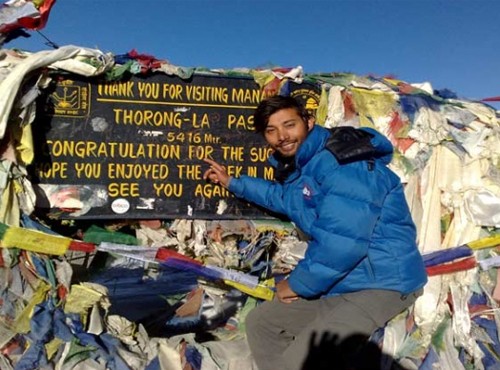
Annapurna Circuit Trek - 13 Days
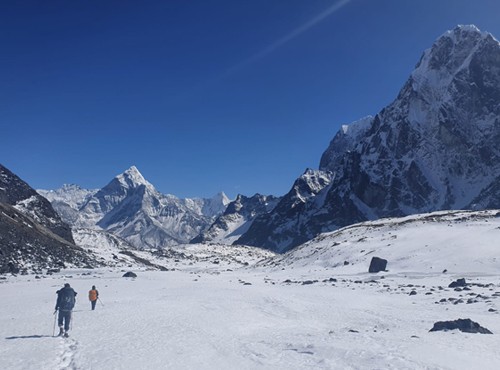
Everest Three passes Trek - 21 Days
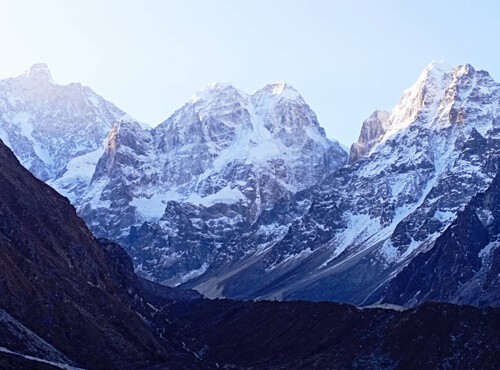
Kanchenjunga Circuit Trek - 19 Days
Are you wondering what to bring for a Three Passes trek? Here is a list of everything you will require to embark on the Three High Passes Trail.
The packing list is among the most crucial things you should consider before beginning this adventure. All required gear for the walk, including clothes, footwear, first aid kits, and other trekking supplies, should be prepared by hikers before the Everest Three Passes Trek . Moreover, the trekking season also has an impact on the packing list. You should only bring what is required.
If the Three Passes trek is your first great Himalayan trek, I'm sure this helpful packing list guidance operates as the core for your equipment setup. To learn more about the Three Passes Trek packing list and details related, continue reading.
Essential Packing Lists for Everest Three Passes Trek:
1) clothing.
The high-altitude trekking requires appropriate clothing. The clothes for trekking should be cozy, warm, and moisture-absorbing.
Also, you should pack smartly, so that you can adjust your layering based on the weather. The packing list for the hike is affected by the season.
- Upper Body
You need warm, breathable clothing for your upper body while trekking. Remember to get lightweight stuff. The required attire is listed in the section below. You either decrease or increase the number of items based on your needs.
- 2 full sleeves and 1 half-sleeve shirt
- Thermal tops. The Everest region may experience very low temperatures. Also, wearing many thermal tops will keep you warm.
- A windproof jacket is essential.
- A pullover.
- Don't forget to bring a down jacket.
- Waterproof jacket
- Lower Body
You will quickly become chilled in your lower body. Be careful not to bring anything that can make your skin uncomfortable.
- Undergarments
- Thick Hiking pants
- Thin hiking pants
- Hiking trousers
- Thermal Set
- one pair of wool trousers
- Waterproof shell pants
- Leggings
You should always keep your head warm. You wouldn't want to get a temperature or a headache that may hamper your trekking plan.
- Pack a headscarf. A bandana might also be a great option. Dusty paths are perfect for them.
- A wool hat that is warm and protects your ears.
In most situations, you must leave your hands free. You must keep them firm and heated at the same time. Here are some essential items for your hands to bring.
- Woolen gloves
- Gloves with a poly lining
- Mittens. Sometimes even the gloves are insufficient to keep your hands warm. Under such circumstances, mittens are required.
Make sure your feet stay dry. Take off your hiking boots and give them relaxation when you reach the teahouses/lodges. Always wear dry socks and check your socks.
- 3 pairs of light, thin wool socks
- 2 pairs of thick woolen socks
- 1 pair of hiking boots with thick soles (waterproof and good ankle support)
- 1 pair of running shoes (optional)
- 1 pair of crocs
- Toiletries
Basic supplies like toiletries are necessary for day-to-day hikes which include the following:
- Toilet paper, nail clippers, and antibacterial hand wash
- An average-sized towel
2) Trekking Gear and Equipment
The following complete hiking supplies and gear are required for the Everest Three Passes Trek:
- Daypack or Backpack for Hiking
To keep all of your trekking equipment and apparel together, you must have a hiking backpack or daypack. For the sake of your belongings' security, the backpack has to be waterproof.
A backpack is ideal for trekkers and travelers who don't pack heavily. With the daypack, you may store your first aid supplies, important papers, toiletries, and other essentials.
- Hiking bag with a capacity of 50 to 70 liters
- Rain Covers for backpack
- Duffle Bags in case you are walking with porters
- Hiking poles
During the trek across the difficult, rocky terrain, trekking poles are a necessity. They offer stability and ease the strain on the hikers' knees.
- Headlamps
For walking in low light, a headlamp is appropriate. Several of the itineraries to the Three Passes Trek call for early morning treks before sunrise. As a result, headlamps enable hassle-free, safe hiking. When you reach the location after dark, these headlights are extremely helpful.
- Raincoats
Wearing a raincoat will help you stay dry when hiking in the rain and snow. A backpack rain cover is also necessary to shield your stuff.
- Electronic Devices to Take on the Three Passes Trek
You may communicate and make memories while on the walk with the help of electronic devices. You should bring the following electronic devices:
- Camera, charger, and additional batteries
- A backup charger and a power bank
- Battery charger external
- Headphones
- Using a smartphone with a Nepali SIM card
- Every adapter, outlet plug, and charging cable
Important Advice for the 3 Passes Trek Gear List
- Get yourself either a daypack or a big backpack.
- Should pack according to the seasons of the travel
- Layer your clothing when traveling.
- Pack only what is essential.
- Female hikers walk with feminine care items.
- Before the hike, you should stretch in your shoes. You should also bring quick-drying and absorbent clothing.
- Avoid unnecessary stuff.
- You can hire gear like sleeping bags and down jackets that you just intend to use on your hike.
- Remember to include a disposable plastic bag to store your trash items as you are packing.
Three Passes Hike Considerations and Packing List
Trekking season.
The packing list for the 3 Passes Trek should be dependent on the seasons of the journey. Autumn and spring are when trekking is most popular. The best part of the walk during these seasons is the consistent weather and clear skies. In addition, the area experiences moderate daytime temperatures and much less rainfall. So, you should bring the necessities only when you pack.
If you trek during the winter or monsoon, you bring warm clothing, rain coverings, and extra equipment. Additionally, the monsoon season brings the most precipitation and heat. In the high-altitude routes, the winters are pretty cold. Hence, during these seasons, raincoats, umbrellas, and additional down jackets are necessary.
Where to buy Trekking Gear and Essentials?
Not every trekker plans to visit Nepal only. You may go to the country near the sea or live in a place where it is quite hot all around the year, so you may not need the hiking equipment over there.
You can purchase or hire reasonably priced trekking supplies and equipment for the Everest Three Passes Trek at Thamel, Lukla, or Namche Bazaar.
What should be the weight of the luggage for Three Passes Trek?
Your luggage weight shouldn't be more than 10 kg for the backpack and 5 kg for the hand carry for taking on Lukla Flight. A porter can handle about 15-25 kg of the backpack. As a result, weight is another element to consider while packing for the Three Passes Trek.
- Altitude Sickness
- Trekking Tips
- Himalaya Trails
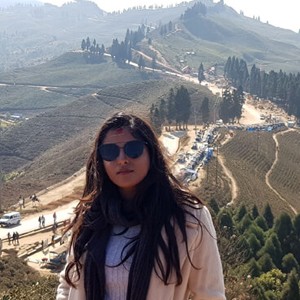
Benjila Dhital
Benjila has been an integral part of the Nepal Nirvana Trails as she writes passionately and learns about new spots, people, cultures, and languages. With a Bachelor's Degree from the reputed college NATHM in Bachelors of Tourism and Travel Management lately, she has been engaging in authoring web content and familiarizing new locations with the tourist out there.
Drop a message
Recent posts.
- Can you trek to Everest Base Camp in April?
- Trekking in Nepal in March 2024
- Unveiling the Hidden Gems of Kanchenjunga: Trekking Guide for Adventure Enthusiasts
- Best Time For Manaslu Circuit Trek
- Family-Friendly Trekking in the Annapurna Region: Creating Lasting Memories with Loved Ones
- Langtang Valley Trek: A Serene Himalayan Escape for Nature Lovers
Related Posts
Travel guides.
- Annapurna Region Trek Guide
- Everest Three Passes Trek Guide
- Kanchenjunga Trek Guide
- Langtang Region Trek Guide
- Manaslu Region Trek Guide
- Nepal Travel Info
- Things to Do
- Travel Blog

Are you looking for the Nepal holiday? or need help to plan a trip, please do not hesitate to get in touch with us.
We use cookies to ensure that we give you the best experience on our website.

Destinations
Trekking type.
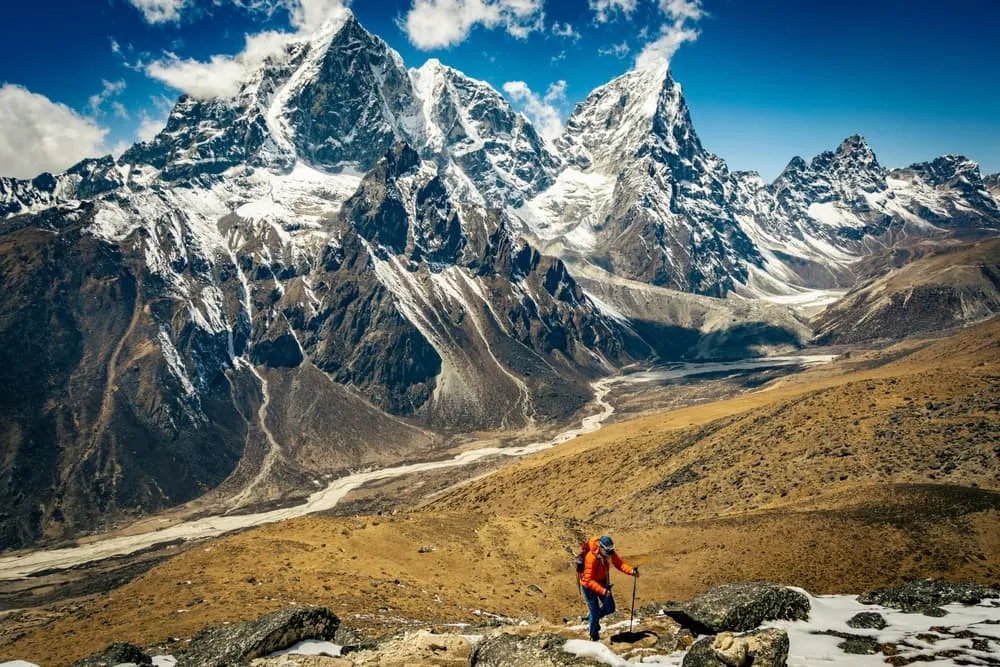
Everest Base Camp - Three High Passes
- What's Included
> Visit of historical monastery of Tengboche > Mesmerizing views of Khumbu Ice Fall > Incredible sunrise view with Everest > Unique culture of the Sherpa people
Join us for a once in a lifetime experience! Our guides and porters will assist you to make this amazing trek safe, happy and as informative as you want. Follow the footsteps of Edmund Hillary and Tenzing Norgay, while you get as close as possible to Mount Everest.
The scenery along this trail is stunning, with many towering mountains like Everest, Lhotse, Nuptse, Ama Dablam and many others. We will cross the Cho-La Pass and relax at the beautiful Gokyo Lake. Himalayan people, their culture and tradition will amaze you during these 16 days in which you will also pass fascinating Sherpa villages and Tibetan monasteries.
Sagarmatha National Park, established in 1976, with the objective to protect the diverse floras and faunas of Himalayan, has been successful in achievement of its goals. You will be able to see different exotic species on your trek like Musk deer, Mountain Goat, Snow leopard, Pheasants, Lophophorus, Snow duck, Mountain hawk among others. It is believed that the giant mystical creature, Yeti is found in Khumbu Region! You’ll be able to see many bridges, monasteries, Chhotre laden with colorful Buddhist flags, and scribbles of prayers, which gives life to the rough terrain of the mountains.
We will hike through stunning Namche, Tengboche, Dingaboche and we will see other beautiful places. We will come across captivating valleys such as Khumbu Valley, Imja Valley, Dusa Valley. Khumjung-Khunde Valley, Gokyo Valley, and Thame Valley which will allow you to see the enchanting mountains from different angles. Mount Everest (8848m), fourth highest Lhotse (8516m), fifth highest Makalu (8485m), sixth highest Cho-Oyu (8210m) and other just as stunning mountains that will feast your eyes. Amazing right?
Fly to Lukla , trek to Phakding
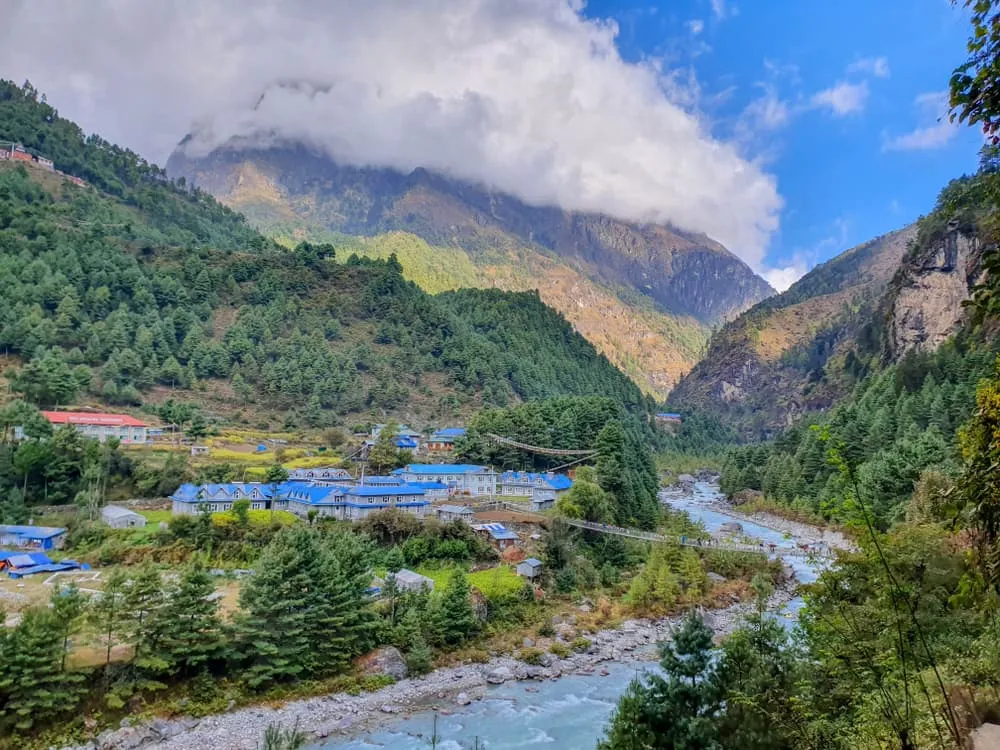
Trek to Namche Bazaar
Namche bazaar.
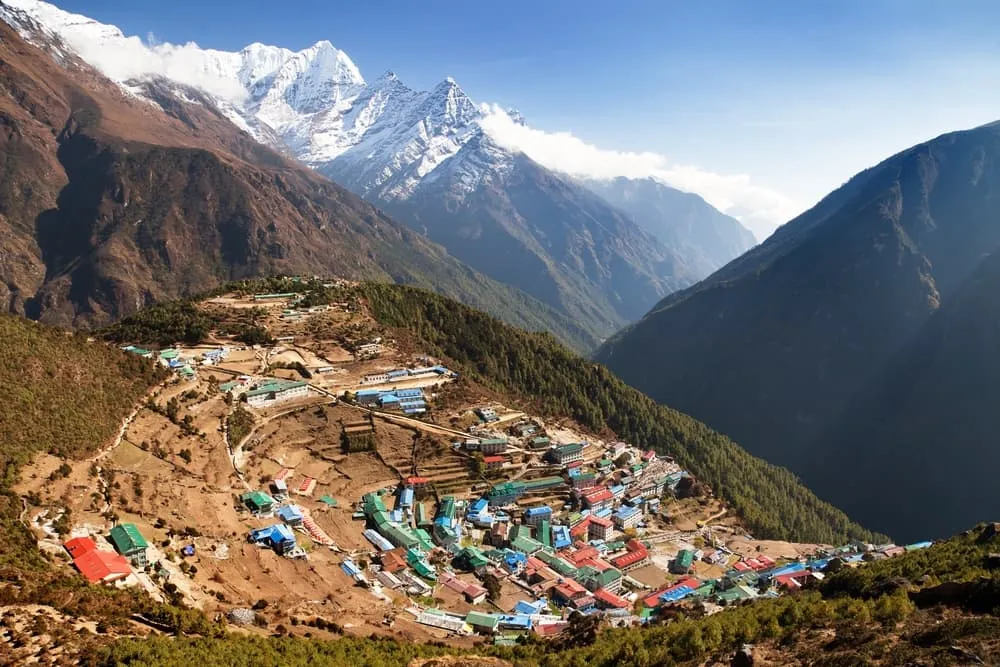
Acclimatize at Namche Bazaar
Pick up and transfer to and from airport.
If needed, your transfers from and to the airport are included.
All necessary transfers (bus, taxi, flights, etc.) as described in the programme are included.
Staying in Lodge or Guest House during the trek
During the trek, we stay in lodges or teahouses. These are simple in nature, but fully equipped. Do not expect too much luxury.
English speaking guide and a porter
One porter per two trekkers. This way you don’t have to carry your complete equipment yourself. The guide speaks English.
Salary, food, insurance, and accommodation for guide and porter
The total amount covers not only your own basics, but also those of your guide and porter. No unpleasant surprises.
Breakfast, Lunch, and Dinner
Breakfast, lunch, and dinner are prepared during the trek. The meals are basic, but will give you enough energy for your appetite. Fruit is also available after each meal.
Coffee and Tea
Coffee and tea are also organized by the trekking company. Every morning fresh coffee and tea are made. There are scheduled breaks to enjoy this.
Permit and TIMS
The total amount includes costs for the permits needed for the Everest Base Camp Trek. This also applies to the TIMS Card, to the Trekkers Information Management System.
Down Jacket and Sleeping Bags
In order to pull in the Himalayas as prepared as possible, it is important to bring a good down jacket and sleeping bag. These are provided by your trekking company.
T-Shirt & Route Map
We also have a t-shirt and a route map for you. Not only are they ideal for trekking, but they are also beautiful souvenirs.
Assistant Guide for a Group of over 6 People
If your group is larger than 6 people, we will take an extra assistant guide with you to support you.
Altitude Sickness & First Aid Kit
The guides carry an altitude sickness kit to monitor your pulse rate, oxygen saturation, and heart rate twice a day (very useful for monitoring the symptoms of altitude sickness (AMS) at altitude).
Return flights Kathmandu / Ramechhap – Lukla
The trekking begins and ends with an exciting flight. The cost of flights to and from Lukla is included in the price and will be booked with your trekking company. From March-May and September-November flights are operated from Ramechhap, a 4-hour drive east of Kathmandu.
Visa for Nepal
Your trekking company will not take responsibility for the travel visa for Nepal. This should be organized by yourself. Contact your local Nepalese embassy for the latest visa information.
Flights to and from Nepal
The total amount is also exclusive of flights to and from Nepal. To get an idea of which airlines are flying on Kathmandu Tribhuvan International Airport (KTM), have a look at the website.
Accommodation in Kathmandu including breakfast
Before and after the trek you have to take care of your own accommodation.
Personal expenses
All personal expenses such as drinks at the bar, washing and other similar expenses are for your own account.
Travel Insurance Including Repatriation
Your international travel insurance is your own responsibility. It is important that your travel insurance also covers adventures at a high altitude. Discuss your itinerary with the insurance company before you travel to Nepal.
Tips for guides and porters are exclusive. 10% of the total amount is an excellent target price, but the final amount is up to you.
Desserts, Hot Shower, Hot Water, Mineral Water and Wi-Fi
Certain luxuries such as desserts, a hot shower, hot running water, bottles of mineral water and Wi-Fi should be missed during a typical trek in the Himalayas. The water we encounter along the way is drinkable and is heated or boiled by us.
The Best Time to Trek to Everest Base Camp
Everest base camp trek difficulty, how to book, availability, cancellation policy.

Just for You
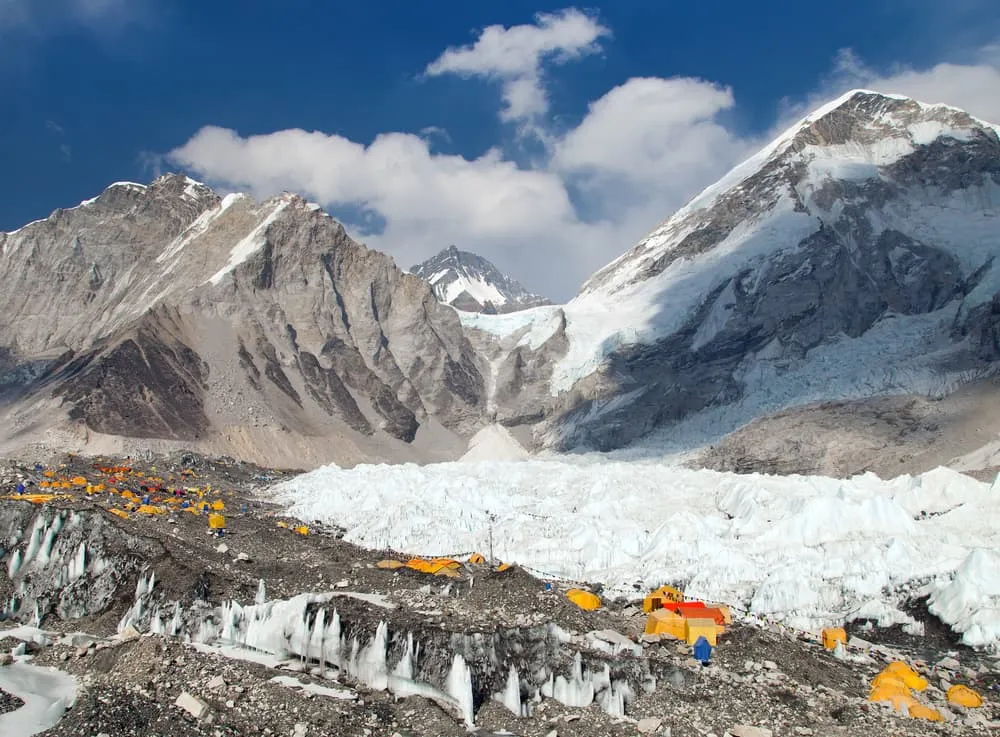
Everest Base Camp Classic Trek
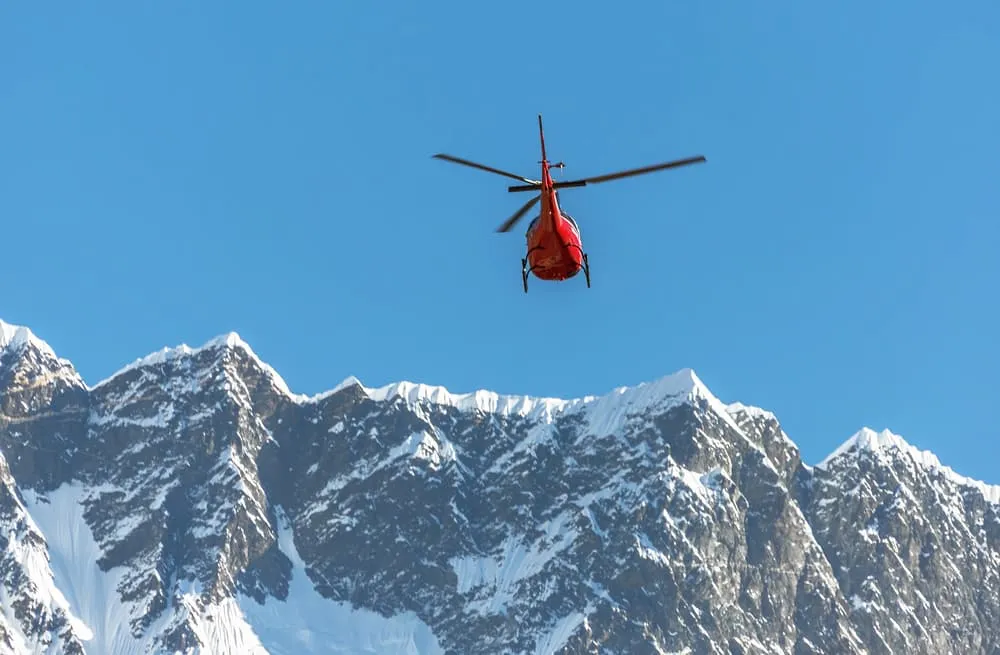
Everest Base Camp Trek with Helicopter Return
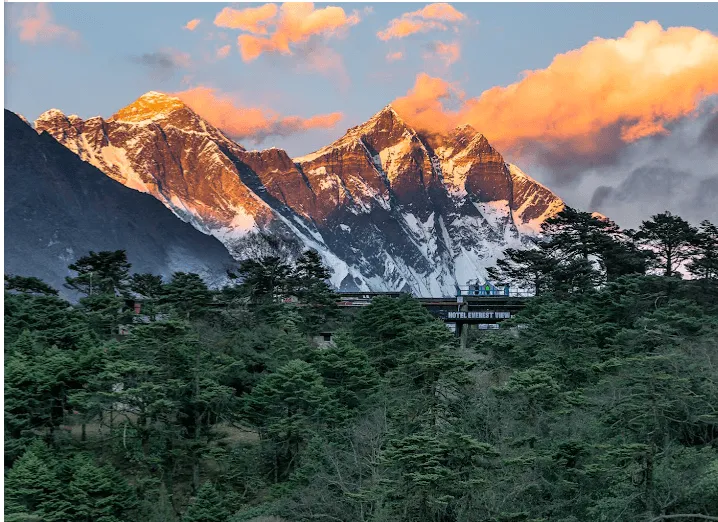
Everest Base Camp Deluxe
Get weekly inspiration with the best treks.


Base Camp Adventure

- Email: [email protected]
Everest Base Camp, Three Passes, Gokyo Lakes Trek

In this article, we are going to discuss Everest Base Camp Three Passes Gokyo Lakes Trek.
Three passes trek and Everest Base Camp trek are quite an exciting adventure in the Himalayas. This trek lets you cross the three high passes of the region while reaching the base of the world’s highest mountain.
This is one of the best alternative routes to visit the Everest Base Camp. You will be exploring the wonderful Sherpa villages while learning their culture and tradition. You get to experience the lifestyle of these people.
Overall this trek is full of wonderful vista and lasts about 20 days in the Everest region. You won’t be once bored on this trek. So, pack your bags and get ready to be stunned on this journey.
Highlights of Everest Base Camp Three Passes Gokyo Lakes Trek
- Walkthrough Sagarmatha National Park
- Reach the Base of Mount Everest
- Beautiful sunrise view from Kala Patthar
- Reach the three high passes of the Everest region
- Explore Gokyo lakes
- Marvelous view of various peaks and landscapes
- Trek through lush green forests
Best Time to Visit

Autumn and Spring seasons are the best time to visit the Everest Base Camp Three Passes Gokyo Lakes Trek. These are the peak seasons when travelers from all around the world visit Nepal to walk on these trails.
During these seasons, the weather and temperature are at their best. The skies are clear, the days are sunny and bright while the nights are a bit chilly. The view of scenarios is breathtaking during these times.
The month of March to May and September to November falls under these seasons. During these months, the routes are crowded with travelers making it noisy. So, if you love walking in silence you might be a bit disappointed.
- Full Name *
- Contact Number
- Your Message/Inquiry *
Similar articles you may like:
- Annapurna v/s Everest Base Camp Trek
- Namche Bazaar to Gokyo Trek
- Everest Three Pass Trek Difficulty
Everest Base Camp Three Passes Gokyo Lakes Trek Itinerary

Day 1: Arrival in Kathmandu
Today you will be arriving in Kathmandu , the capital city of Nepal. This beautiful city is the first place you will be visiting after your arrival. Our respective representative will be waiting for you at the terminal with garlands of flowers.
Then after a short welcoming, they pick you up from the airport and drop you off at your hotel. After helping you check-in to your rooms, they leave for the day. The rest of the day is unplanned so you are free to roam around or visit places.
You must be tired after a long flight so you can sleep in fast tonight.
Day 2: Sightseeing around Kathmandu Valley
Today you will be sightseeing around the beautiful Kathmandu valley. And visiting the various UNESCO heritage sites this city has to offer. There are a total of 6 heritage sites inside the valley. Among them, 4 are located in the capital, 1 in Bhaktapur, and 1 in Lalitpur.
Waking up early, you have your breakfast and wait for the guide. After picking you up, they will take you to Pashupatinath, a holy shrine for lord shiva. Then Boudhanath and Swayambhunath, a holy ground for Buddhists.
From there, they will take you to Basantapur Durbar Square and Patan Durbar Square. These squares were once home to the royal kings and queens. But nowadays, they have become the center of attraction.
After returning from the tour, you visit Thamel for its exciting nightlife. Most of the clubs and pubs are situated in this part of the town. It is better to sleep early as you have a journey to begin the next day.
Day 3: Fly to Lukla from Kathmandu then trek to Phakding
Flight Duration : 25 to 30 minutes
Maximum Altitude (Lukla) : 2800 m above sea level
Trek Duration: 2 to 3 hours
Maximum Altitude (Phakding): 2640 m above sea level
On the third day of Everest Base Camp Three Passes Gokyo Lakes Trek Itinerary, your journey in the Himalaya begins. Waking up early, you pack your bags and get ready for the trip.
Picking you from the hotel, they drop you off at the airport. From there, you catch a flight to Lukla. Boarding the flight you soar into the sky. Viewing epic scenes of mountains, valleys, and landscapes from above.
After about half an hour flight, you reach Lukla, popular for its narrow runway. Then after having a healthy breakfast, you now trek towards Phakding. Heading out of the town, you make a descend in the trials.
Then crossing a suspension bridge over the Dudh Koshi river you walk on its bank. Following the trail, you walk past several small Sherpa settlements. Walking for about a few hours viewing prayer flags, mani walls, you reach Phakding.
Stay the night in one of the tea houses.
Day 4: Trek to Namche Bazaar

Trek Duration: 5 to 6 hours
Maximum Altitude: 3430 m above sea level
Today you will be heading towards Namche Bazaar from Phakding. Heading out of the town, you cross a suspension bridge over the Dudh Koshi river. Then following the left side trails reach Tok Tok then crossing a lovely waterfall arrive at Benkar. This place gives a marvelous view of Mt. Thamserku.
Then following the upward trail, you reach Chhamuwa village. Then making a gradual climb, you reach Monjo village. Walking further ahead, you can enter the gate of Sagarmatha National Park .
From here, you descend the trails till Jorsale then ascend till you arrive at Namche Bazaar. The view of mountain peaks in the backdrop looks very mesmerizing from this Sherpa town.
You stay in one of the tea houses for the night.
Day 5: Acclimatize in Namche
On the fifth day of this trek, your first acclimatization is here in Namche Bazaar. This is your free day so you can rest for the day or roam around the beautiful Sherpa village.
You can hike up to Khumjung village and visit the mountaineering museum, Hillary school, Khunde hospital, etc. Then from there, you can head towards the Everest View Hotel, the world’s highest hotel.
After a tiring day, you return back to Namche and stay here for the night. On this day you will have seen many beautiful scenarios and experienced their culture and tradition.
Day 6: Trek to Tengboche
Maximum Altitude: 3867 m above sea level
Today you head towards Tengboche from Namche. After having your breakfast, you head out of the town and make an ascend in the trail. Then enter a dense forest of rhododendron till Kenjoma then Sansa.
From here, the trail drops till you arrive at Phunki Thanga. You have your lunch here. Following the forest trail, you see the breathtaking view of mountains and landscapes.
Walking for about a few hours, you arrive at Tengboche. This beautiful village lies on top of the ridge and is popular for its ancient monastery and panoramic mountain views.
Day 7: Trek to Dingboche
Trek Duration: 6 to 7 hours
Maximum Altitude: 4410 m above sea level
Waking up early, you visit the monastery and participate in the morning prayers. Then having your breakfast, you head towards Dingboche from Tengboche this day.
Descending the trails through forests of pines and rhododendron you reach Deboche. Then walking further ahead you arrive at a small settlement above the Imja Khola.
From here, you ascend the trails and cross a bridge over the river and reach Pangboche village. Then heading upward you get to Imja village then Somare and Orsho.
After having your lunch here, you continue your walk and reach Dingboche. You stay here for the night.
Day 8: Acclimatize in Dingboche
Your second acclimatization is held here in Dingboche. You can roam around the beautiful village or hike up to Nangkartshang peak. This place gives a stunning view of Mt. Lhotse, Mt. Makalu, Ama Dablam, etc. You can also see the beautiful Imja valley and Dingboche village.
Day 9: Trek to Chukkung
Trek Duration: 2 to 2.5 hours
Maximum Altitude: 4730 m above sea level
Today you will be heading towards Chukkung from Dingboche. This day’s walk is quite short to let your body adjust with high elevation. You will be traveling to a high elevation so it can be hard for some trekkers.
After arriving at Chukkung the rest of the day is free. So you can stay in your rooms or ascend to Chhukung Ri or Island Base Camp. This place gives a marvelous view of various peaks. Like Lhotse, Makalu, Nuptse, Thamserku, Island Peak, etc.
During the evening, you will prepare to climb for your first high pass the next day. Stay here for the night.
Day 10: Trek to Lobuche via Kongma La Pass
Trek Duration: 8 to 9 hours
Maximum Altitude (Kongma La): 5535 m above sea level
Maximum Altitude (Lobuche): 4930 m above sea level
Today is quite an adventurous day for you. As of today, you will be heading towards Lobuche via Kongma La. This day you will be crossing the first high pass of the Everest region.
After having your breakfast, you follow the rocky trail and ascend towards Kongma La. The walks will be quite hard compared to other days. Following the routes, you reach Pokalden Base camp.
Then walking through steep hills you reach Kongma La. This pass gives a breathtaking view of peaks and glacier lakes. Viewing these scenarios, you descend the trails and cross the Khumbu glacier reaching Lobuche.
Day 11: Trek to Gorakshep then Hike to Everest Base Camp and return
Trek Duration (Gorakshep): 3 to 4 hours
Trek Duration (EBC): 2 hours
Maximum Altitude (Gorakshep): 5140 m above sea level
Maximum Altitude (EBC): 5360 m above sea level
This day’s trek is quite exciting as you will be heading towards the major highlight of this trek. From Lobuche, you trek till Gorakshep then hike to Everest Base Camp.
Continuing the trail, you make a steep climb following the rocky trails. After several ups and downs, you reach Gorakshep. Then having your lunch, you now head towards Everest Base Camp.
Following the glacier ridge and making ascend in the trails you arrive at Everest Base Camp. This place gives a marvelous view of Nuptse, Lhotse, and many more.
After spending time and clicking pictures, you head back to Gorakshep retracing your steps. Stay the night in one of the tea houses.
Day 12: Hike to Kala Patthar then descend to Dzongla

Trek Duration (Kala Patthar): 3 hours
Trek Duration (Dzongla): 5 hours
Maximum Altitude (Kala Patthar): 5550 m above sea level
Maximum Altitude ( Dzongla): 4830 m above sea level
Waking up early, you hike to Kala Patthar this morning. This place gives the best view of the sunrise in the Everest region. Mount Everest also looks stunningly beautiful from this point.
After viewing the beautiful scenarios, you descend the trails till Gorakshep. Then head towards Dzongla crossing Lobuche. Stay the night in one of the lodges.
Day 13: Trek to Thangnak via Cho La Pass
Maximum Altitude (Cho La): 5420 m above sea level
Maximum Altitude (Thangnak): 4700 m above sea level
After having your breakfast, you begin the trek by ascending the trails to Cho La Pass. This day you will be visiting another high pass of the Everest region. Then head to Thangnak from there.
Walking through steep rock boulders, zigzag trails, and making gentle ascents, you reach Cho La Pass . From here you descend the trails and head towards Thangnak where you stay the night.
Day 14: Trek to Gokyo
Maximum Altitude: 4790 m above sea level
Today you head towards Gokyo from Thangnak. Following the trail through the Nagjumpa Glacier, you make an ascend and reach the Gokyo trek route . After walking for about a few hours, you reach Gokyo.
Stay the night in one of the lodges.
Day 15: Acclimatize in Gokyo
This is your last acclimatization of the trek. Today you will roam around the beautiful Gokyo Valley. You will be exploring the Gokyo peak and visiting the fifth lake.
Day 16: Trek to Marulung via Renjo La Pass
Trek Duration: 7 to 8 hours
Maximum Altitude (Renjo La Pass): 5360 m above sea level
Maximum Altitude (Marulung): 4150 m above sea level
Today is quite a big day as you will be crossing the last high pass of the Everest region. After a delicious breakfast, you climb the trails and following it reaches Renjo La Pass.
Viewing the panoramic view of peaks, glaciers, and landscapes, you head down the trails to Marulung. And stay the night in one of the lodges.
Day 17: Trek to Thame
Trek Duration: 4 to 5 hours
Maximum Altitude: 3800 m above sea level
Today you head towards Thame from Marulung. Descending the trails you reach Nangpa valley. And following the old trade route, you head towards Thame. This village is well known for its ancient monastery.
Day 18: Trek to Manjo
Trek Duration: 5 to 6 hour
Maximum Altitude: 2835 m above sea level
Today you head towards Manjo from Thame. After a healthy breakfast, you continue your Everest Base Camp Three Passes Gokyo Lakes Trek journey. Trekking downwards, you follow the trails beside the Bhote Koshi river.
Then entering lush green forests walk through isolated sherpa villages. Then retracing your steps descends down to Manjo. Stay the night in one of the lodges.
Day 19: Trek to Lukla

Maximum Altitude: 2800 m above sea level
Today you head towards Lukla from Manjo. This day’s trek is quite short as you will be retracing your steps back. Descending and ascending the trails and crossing several suspension bridges, you arrive at Lukla.
Day 20: Fly Back to Lukla
This is your final day of Everest Base Camp Three Passes Gokyo Lakes Trek. Today you will be flying back to Kathmandu. We hope you had an exciting time on this wonderful journey.
- 4+3=? * Solve above and submit button will appear!!!
You may also like:
- Manaslu Circuit Trek
- Langtang Valley Trek
- Everest Base Camp Trek Map
You may also like...

Annapurna Base Camp Trek Distance

Hire Guide For Manaslu Circuit Trek

Manaslu Tsum Valley Trek Map
- Nepal Tours
- Everest Region Tours
Everest Base Camp - 3 Passes trek
Everest base camp 3 passes trek 2024/2025.
The Everest Base Camp - 3 Passes Trek is the ultimate trek in the Everest region. The trek takes you across three high mountain passes of Kongma La (5,540 m), Cho La (5,335 m) and Renjo La (5,400 m). The EBC - 3 Passes trek offers a fortnight of sheer mountain bliss only reserved for the truly adventurous.
- Nepal Travel Guide
Everest Base Camp - 3 Passes trek - 19 Trips with 128 Reviews

- Starts Kathmandu, Nepal
- Ends Kathmandu, Nepal
- Free cancellation
- Trip customizable
- Tour Type Private Tour
- Activities Trekking and Hiking
- Accommodation Hotel & Guest House
- Transport Flight & Private Vehicle
- Age Range 10-79 yrs
- Operated in English, Nepali
- View More Jan 1, 2019 Jan 2, 2019 Jan 3, 2019

20 Days EBC 3 High Passes Trek
- Transport Private Vehicle & Flight
- Age Range 8-80 yrs
- Operated in English, Hindi, Nepalese

Island Peak Climbing + Everest 3 High Passes Trek
- Activities Trekking and Hiking & Climbing
- Accommodation Camping, Hotel, Tent & Guest House
- Transport Flight
- Age Range 18-79 yrs
- Operated in English

Everest Base Camp - 3 High Passes Trek
- Accommodation Guest House & Hotel
- Age Range 6-79 yrs

Everest Three High Passes Trekking

Everest 3 Pass Trek - 16 days
- Age Range 15-68 yrs

- Activities Trekking and Hiking & Adventure
- Accommodation Hotel, Camping & Guest House
- Age Range 15-79 yrs

Everest Base Camp - 3 Passes Adventure Trek
- Age Range 16-79 yrs

Everest High Passes in Comfort
- Best price guaranteed
- No booking fees
- Tour Type Small Group Tour
- Accommodation Camping, Eco Lodge, Hotel & Guest House
- Transport Flight & Bus
- Age Range 18-99 yrs
- Sep 15 10+ seats left
- Sep 19 10+ seats left

Island Peak Climb With Three Passes Trek
- Activities Climbing & Trekking and Hiking Climbing , Trekking and Hiking & Mountains 'data-more-tripid='23058'>+1 more
- Accommodation Hotel, Guest House & Camping

Everest Three High Passes Trek
- Age Range 15-55 yrs

Everest Base Camp - 3 Passes Trek
- Age Range 18-60 yrs

Everest Base Camp and Three Passes Trek
- Age Range 5-79 yrs
- Operated in English, Nepalese

Everest High Passes Trek
- Activities Trekking and Hiking & Mountains
Traveling to Nepal? Chat with a local travel specialist in Nepal who can help organize your trip.

Everest Base Camp - 3 Passes trek Reviews
- Jacques Gouallou
Traveller Photos for the Everest Base Camp - 3 Passes trek

Everest Base Camp 3 Passes Trek - Overview
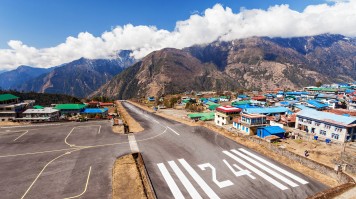
The trek follows the lower Khumbu trail towards Everest Base Camp crossing over the three passes making this a comprehensive circuit of the Everest region. Though strenuous trekking at times, you are rewarded with remarkable Himalayan scenery including four of the world's eight highest peaks; Cho Oyu (8,201 m), Makalu (8,463 m), Lhotse (8,516 m), Everest (8,850 m). You also get to see the beautiful village of Gokyo and its emerald lakes.
This is all complemented by inviting Sherpa villages, homes and monasteries offering an insight into the quiet and culturally vibrant Sherpa way of life. You have the opportunity to visit ‘off the tourist trail’ tracks if you choose, and you can experience more remote villages and mountainous areas.
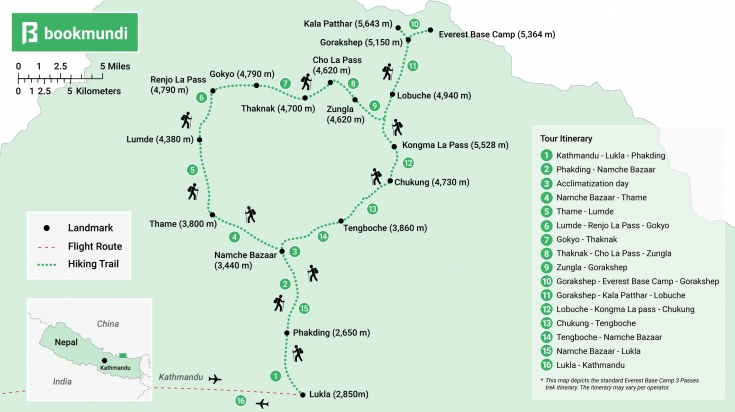
Everest Base Camp - 3 Passes Trek - Itinerary

The following is a standard itinerary for EBC - 3 Passes trek . It may vary slightly depending on the final trekking agency you choose to go with:
- Day 01: Fly to Lukla and Trek to Phakding (2,652 m)
- Day 02: Trek to Namche Bazaar (3440 m)
- Day 03: Acclimatization day
- Day 04: Trek to Thame (3,800 m)
- Day 05: Trek to Lumde (4,380 m)
- Day 06: Trek to Gokyo via Renjo la (4,790 m)
- Day 07: Trek to Thaknak (4,700 m)
- Day 08: Trek to Zungla via Cho La pass (4,620 m)
- Day 09: Trek to Gorakshep (5,140 m)
- Day 10: Visit Everest Base Camp (5,364 m)
- Day 11: Hike to Kala Patthar and Trek to Lobuche (4,910 m)
- Day 12: Trek to Chukung (4,730 m)
- Day 13: Trek to Tengboche (3,860 m)
- Day 14: Trek to Namche Bazaar (3440 m)
- Day 15: Trek to Lukla (2,840 m)
- Day 16: Fly to Kathmandu from Lukla
Alternative treks:
There are other trekking options in the Everest region, beside the 15-day EBC – 3 Passes trek:
- The standard Everest Base Camp trek is similar to this trek but it can be completed in 12 days
- If you have less time on your hands then you may want to opt for the Everest Panorama trek , which is a 7-day trek that shows you the beauty of the Everest region within a week.
- Gokyo and Everest Base Camp trek is another trek in the Everest region. It explores the Base Camp area as well as the Gokyo valley with its spectacular lakes. This trek can be completed in 14 days.

Everest Base Camp - 3 Passes - Safety considerations
All trekking agencies available at Bookmundi.com take safety seriously and are assessed on their safety standards after every trek, via trekkers’ feedback. They will therefore go through safety procedures with you during your pre-trek meeting. However, please note the following particulars for the Everest Base Camp – 3 Passes trek:
- This is a high altitude trek and therefore careful acclimatization is needed. Ensure acclimatization days are taken during the trek to avoid altitude sickness.
- Please make sure that you are well prepared for the climate for that part of the season. Near EBC, temperatures can drop to as low as -20°C / -4°F during late autumn and early spring. The temperature dip even further down during winters.
Popular Activities
- Trekking and Hiking tours
Upcoming Departures
- Spring 2024/2025
- Summer 2024/2025
- Winter 2024/2025
- August 2024
- September 2024
- October 2024
- November 2024
- December 2024
- January 2025
- February 2025
- August 2025
- September 2025
- October 2025
Everest Base Camp - 3 Passes trek Durations
- 16-days Everest Base Camp - 3 Passes Trek
Best price guaranteed - No booking fees
Sign-in to unlock instant trip discounts. Create wish lists and save up to USD 1,500.

From Lukla to Everest Base Camp: A Guide to the Best Routes and Trails
Quick links, how long is the trek from lukla to everest base camp, where can hikers stay while traveling from lukla to everest base camp, can any level hiker travel from lukla to everest base camp is it safe.
Located in the Himalayas lies the world-renowned trek from Lukla to Everest Base Camp, a journey that draws adventurers from across the globe. This 130 km (77 miles) round trip trek is a challenging but rewarding experience, showcasing the natural beauty of the region and offering a glimpse into the daily lives of the local Sherpa people.
The trek from Lukla to Everest Base Camp typically takes 13 days, starting from Kathmandu. Before embarking on this journey, hikers must train to prepare for the rigorous terrain and high altitude. This is especially important given the risks associated with being at such high altitudes for an extended period.
The trek from Lukla to Everest Base Camp is an unforgettable journey that offers a glimpse into one of the world's most breathtaking regions. With proper training and a sense of adventure, anyone can tackle this challenging but rewarding trek and come away with memories to last a lifetime.
- Lukla to Everest Base Camp is 38.5 miles.
- This entire hike should take people between 11 and 14 days in total.
- Many hikers between these two spots spend 8–9 hours walking daily.
For people wanting to take on Everest Base Camp from Lukla, this will be the journey of a lifetime. This trek between the two spots is approximately 38.5 miles, usually taking hikers 11–14 days. One thing to note, this trek is 38.5 miles either way: totaling 77 miles. According to past hikers, people will begin their eight-day hike from Lukla to the Everest Base Camp and then four days to trek back to Lukla. Some may want to hang out at Everest Base Camp for a couple of days, so that will add time to the entire voyage.
Luckily, the scenery between these notable hiking locations offers unparalleled views of the surrounding landscape, giving adventurers insight into the Sherpa people. Another detail to remember when traveling between Lukla and Everest Base Camp is that most people recommend hiking for 8–9 hours daily to keep the schedule at 11–14 days.
Some people even skydive from Mount Everest : so the adventure doesn't need to stop at the ground.
Related: 10 Stunning Himalayan Hiking Trails That Are Not Everest (Or Even Close)
The Best Trekking Route To Everest Base Camp
When it comes to the best route for those trekking to Everest Base Camp, people want to take The Classic Everest Base Camp trek. This path is the most direct route from Lukla to the 18,192-foot peak of Kalapatar. Hikers will also get the best view of Mount Everest from here, so that's perfect for those wanting to snap a few photos.
However, here are some alternative routes and timelines that one could take to get to the Classic Everest Base Camp Trek:
- Jiri to Everest Base Camp (19–21 days trekking)
- Tumlingtar to Everest Base Camp (21–23 days trekking)
- Gokyo Over Cho La Pass (17–18 days trekking)
- Lukla to Tengboche (around 7 days trekking).
The trek from Lukla to Everest Base Camp is 38.5 miles each way, totaling 77 miles for hikers. Therefore, to finish this trek in 11–14 days, hikers must spend 8–9 hours daily on the move.
- Hikers can stay between Lukla and Everest Base Camp in teahouses, lodges, and campsites.
- Phakding lies between Lukla and Namche Bazaar, making it a great stop along the way.
Trekking from Lukla to Everest Base Camp will have a few lodging opportunities between the two destinations. Generally, past hikers recommend stopping in Phakding, which takes roughly 3 to 4 hours to walk from Lukla. Along this trail, people can stay in lodges or teahouses, which will be primitive and won't be a "typical" experience. The road to Everest may be daunting, so preparing for this journey is crucial .
To explain these teahouses/lodges , they are houses with usually more than two floors but sometimes only one, with dozens of rooms. This could be a fun way to meet other adventure seekers along the way to Everest Base Camp (and back), so don't be afraid to start a conversation.
The trail between Lukla and Everest Base Camp is globally visited, so there will be people from all different cultures and countries to enjoy this with. These ten Everest Base Camp facts may be fun to know before the journey.
Related: Mt Everest: The History & Story Behind The World's Tallest Mountain
In general, if someone is healthy and regularly hikes, they should be able to handle the walk from Lukla to Everest Base Camp. One thing to keep in mind, however, is that this trek isn't easy but isn't nearly as challenging as taking on Mount Everest. The entire region is known for its high elevation and chilly weather, which may be difficult for some hikers.
There are many things to see and experience at the base of Mount Everest , so people don't need to take on the summit to have a memorable experience.
According to trek guides , the Everest Base Camp area is far easier for hikers than other areas, especially when compared to Everest: often considered one of the more dangerous journeys on Earth. It may be helpful to train before heading to Lukla and then to Everest Base Camp, taking on hikes near where someone lives. For example, if there are mountains nearby, that could be a great way to train for this Nepal adventure.
Going to the gym and using machinery at an incline may also help prepare someone for this, although nothing beats getting outdoors. If there is any hesitation with taking on a trek from Lukla to Everest Base Camp, it might be worth consulting a doctor and ensuring people's health is good enough to head to the mountains.
These are ten essential tips for anyone traveling to Everest Base Camp that are worth reading.

- Go to slide 3
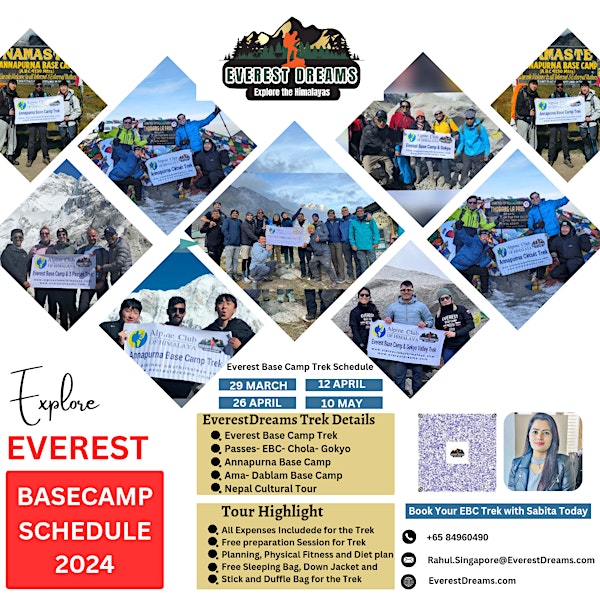
EverestDreams.com Everest Base Camp Trek-24-May-2024 !! Book Now !
Embark on the adventure of a lifetime and trek to the legendary Everest Base Camp on 24-May-2024 - Book your spot now at EverestDreams.com!
Date and time
About this event.
Join us on the adventure of a lifetime!
Are you ready to conquer the Everest Base Camp Trek ? Pack your bags and get ready to embark on this epic journey on 24-May-2024 in Kathmandu . Experience breathtaking views, challenge yourself, and create memories that will last a lifetime. Don't miss out on this incredible opportunity, book now to secure your spot!
Whether you're an experienced trekker or a first-timer, this trek is suitable for all levels. Explore the beauty of the Himalayas and immerse yourself in the rich culture of Nepal. Get ready to fulfill your EverestDreams.com and make this trek a reality. See you at the base camp!
Frequently asked questions
For Booking Visit our website and submit your contact information
Organized by

IMAGES
VIDEO
COMMENTS
Tours, Tickets, Trips & More. Book Now - Selling Fast. Free Cancellation Policy.
The trek is more challenging than the classic Everest Base Camp Trek and its other variations as it involves traversing the three high passes that lend the trek its name - Renjo La, Cho La and Kongma La - each over 5,000m. The trek begins in the popular starting point of Lukla before heading north along the classic trek to Namche Bazaar.
Everest Base Camp Three passes trek, also known as Everest Three High Pass trek, is one of the best alternatives to the casual Everest Base Camp Trek. This journey takes you to all the major places of the Everest region including the Everest Base Camp (5364m), Kala Patthar (5545m), and the three major passes; Cho La (5420m), Renjo La (5360m ...
The Three Passes trek is the ultimate Everest experience. This route takes in all the highlights—both in terms of mountain views and local Sherpa culture—and combines them into a complete journey through the Everest region. Keep in mind, this trek is one of the most challenging teahouse treks in Nepal. N. Nick H. United Kingdom.
Kongma La is a challenging mountain pass that's actually higher in elevation than Everest Base Camp. It's also the easternmost and highest of the three passes that make up the EBC and Three Passes trek. With all that in mind, today is a very good day for concentration, crampons and trekking poles, as much of the route is rocky and uneven.
EVEREST THREE PASSES TREK ITINERARY. We have outlined below what we feel is an ideal itinerary for the Everest Three Passes trekking route. This is a 19 day itinerary which includes flying to and from Lukla. We have noted the trekking distance and an approximate trekking time for each day (excluding lunch stops, breaks, etc), as well as stats ...
This means that you do not need to have a guide for the Everest Three Passes trek, or for the treks to Everest Base Camp and Gokyo Lakes. We have included copies of the official press release from April 2nd 2023 and an info card from September 2023 stating that a guide is not mandatory in the Khumbu region.
This is a sample itinerary for my Three Passes Trek Guide. It's the path that I took when I completed the Three Passes Trek and Everest Base Camp without a guide: Day 1: Kathmandu -> Salleri (jeep) Day 2: Nunthala. Day 3: Bupsa. Day 4: Ghat (we passed Lukla on this day) Day 5, 6, 7: Namche Bazaar. Day 8: Tengboche.
Home › Nepal › Everest Three Passes Trek. Nepal's Three Passes Trek is perhaps the greatest trekking adventure you can have in the Khumbu (Everest) region of Nepal. Also known as the Three High Passes, this loop trek wraps around Sagarmatha National Park, leading trekkers over the Khumbu passes of Kongma La at 5,550 m (18,209 ft), Cho La at 5,420 m (17,782 ft), and Renjo La at 5,360 m ...
Overview. Everest Base Camp and 3 Pass Trek is one of the most challenging trails in the Everest region of the Himalayas taking trekkers to three of the highest passes here. The Base Camp of the top of the world Mount Everest (8848 m) is fantastic on its own. Adding the likes of Kongma La Pass (5535m), Cho La Pass (5368m), and, Renjo La Pass (5360m), Gokyo Lakes (4750m), and Kalapathar (5545m ...
Trekking costs for 3 pass Trek from Everest Base Camp: The cost of the Everest Base Camp 3 Passes Trek can vary depending on factors such as the trekking agency you choose, the level of services provided, group size, and the inclusion of additional services. Generally, the price range for this trek can range from USD,1,786 to 3,000, USD, or ...
Flight Duration: 30 to 35 minutes. Maximum Altitude (Lukla): 2860 m. Trek Duration: 3 hours. Highest Point (Phakding): 2610 m. Today is the day when your Everest Base Camp, Gokyo Lake, and Three passes Trek begins. First of all, waking up early and you will re-check your things for the journey.
Everest Three Passes Trek is the ultimate trekking experience to conquer Mount Everest. It's the only three-pass trekking option on the world's highest peak and the only way to visit Everest Base Camp (5,364m) and Kalapatthar Summit (5,545m). The trek offers two stunning routes: Clockwise and anti-clockwise.
The Everest Base Camp Three Pass Trek is an awe-inspiring journey that takes trekkers through some of the most spectacular and challenging landscapes of the Everest region. This unique trek combines the classic Everest Base Camp route with the adventure of crossing three high mountain passes Kongma La, Cho La, and Renjo La .
The Everest Base Camp three passes trek is a challenging and exciting journey that takes trekkers through three high mountain passes in the Khumbu region of Nepal. This route offers a complete journey through the Everest region, combining highlights of mountain views and local Sherpa culture. It is considered one of the toughest treks in the ...
Everest Three High Passes Trek is the ultimate trek for thrill-seekers and adventurers in the Everest region. In this trek, you will not only reach the Everest Base Camp but also cross the three highest passes in the Khumbu region - Kongma La Pass (5,535/18,159ft), Cho La Pass (5420m/17,782ft), and Renjo La Pass (5,340m/17,520ft).
For a complete cent-by-cent cost breakdown of our trek to Everest Base Camp in 2020. Cost of trekking to EBC in different ways in a nutshell: Package tour EBC trek with international agency $1700. Package tour EBC trek with local agency $1600. Independent EBC trek with a guide and porter $1370.
Last Updated on Sep 24, 2023. The Three Passes Trek is one of the most difficult treks in the Everest Region. You will cross the three high passes, Renjo La (5,360 m), Cho La (5,420 m), and Kongma La (5,535m), on this challenging journey. During the trekking tour of the Everest three passes, you will come across the mani walls, prayer flags ...
This extraordinary trek entails traversing three breathtaking high passes: Kongma La Pass (5,535/18,159ft), Cho La Pass (5,420m/17,782ft), and Renjo La Pass (5,340m/17,520ft). Additionally, you will have the opportunity to visit iconic landmarks such as Everest Base Camp, Kala Patthar, Gokyo Ri, and the mesmerizing Gokyo Lakes.
Fly to Lukla , trek to Phakding. Duration: 02:30 h. Distance: 7.3 km / 4.5 mi. Ascent: 160 m / 525 ft. Descent: 370 m / 1214 ft. We'll board a flight to Lukla (2810m). You will be able to enjoy the beauty of splendid hills, rivers and mountains during the 30 minute flight. On reaching Lukla airport, you'll be introduced to your porter, and ...
Trekking is more difficult in the trail of Three Passes than Everest Base Camp, with a larger walking through innermost reaches without human settlement. Rising up an altitude of 5,535 meters, Three Passes Trek is relatively more difficult than Everest Base Camp. Trekkers can quickly run out of breath on the trail of Three Passes as it's more ...
Flight Duration: 25 to 30 minutes. Maximum Altitude (Lukla): 2800 m above sea level. Trek Duration: 2 to 3 hours. Maximum Altitude (Phakding): 2640 m above sea level. On the third day of Everest Base Camp Three Passes Gokyo Lakes Trek Itinerary, your journey in the Himalaya begins. Waking up early, you pack your bags and get ready for the trip.
The Everest Base Camp - 3 Passes Trek is the ultimate trek in the Everest region. The trek takes you across three high mountain passes of Kongma La (5,540 m), Cho La (5,335 m) and Renjo La (5,400 m). The EBC - 3 Passes trek offers a fortnight of sheer mountain bliss only reserved for the truly adventurous. Everest Base Camp - 3 Passes trek - 19 ...
It combines four very popular and challenging treks of the Everest region into one: Everest 3 Passes Trek, Island Peak Climbing, Everest Base Camp Trek, and Gokyo Valley Trek with Renjo La Pass. If you want to trek all of them separately, it will take more than 40 to 50 days, but if you opt for this combo package, you can complete it in 21 days ...
The trek from Lukla to Everest Base Camp is 38.5 miles each way, totaling 77 miles for hikers. Therefore, to finish this trek in 11-14 days, hikers must spend 8-9 hours daily on the move.
G Adventures is an adventure travel company offering the widest selection of affordable small group tours, safaris, and expeditions to more than 100 countries across seven continents. Our small group tours help you share yourself with the world. Yes, you. Because if you're looking to travel, you're the kind of person who's open to seeing new places, trying new things, and learning about ...
Eventbrite - EverestDreams.com presents Everest Base Camp Trek - Last Trek of 2024 !!!! Book Now - Saturday, May 4, 2024 | Friday, May 24, 2024 - Find event and ticket information.
Are you ready to conquer the Everest Base Camp Trek? Pack your bags and get ready to embark on this epic journey on 24-May-2024 in Kathmandu. Experience breathtaking views, challenge yourself, and create memories that will last a lifetime. Don't miss out on this incredible opportunity, book now to secure your spot!
16 likes, 0 comments - miracletreks on April 28, 2024: "Day 3 of our everest base camp trek Acclimatization Day in Namche Bazaar Today we hike to everest view hotel and explore the beauty o...". Miracle Treks and Expeditions | Day 3 of our everest base camp trek Acclimatization Day in Namche Bazaar Today we hike to everest view hotel and ...
36 likes, 0 comments - puneetbhardwaj_vlogs on April 29, 2024: " George Everest Peak, Mussoorie ⛰️ Entry fees: ₹200 per person Parking base camp fees: ₹200 ...
You will spend some time in Namche before ascending to the Everest View Hotel at 3,880m. Here ...". Everest Base Camp trek 2023 for Meningitis | Trek Day 4 - Today is acclimatisation day!